Trip Report:
Falkland Islands
Birds and Wildlife
Trip Report
2016
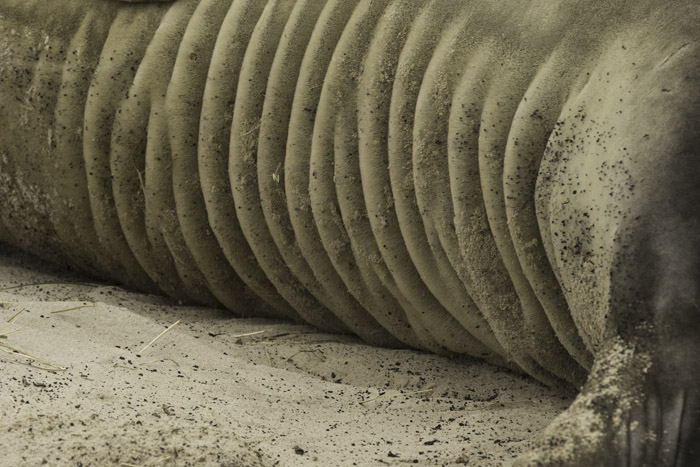 The folds of a skin on an Elephant Seal hauled out on the beach at Sea Lion Island.
The folds of a skin on an Elephant Seal hauled out on the beach at Sea Lion Island.
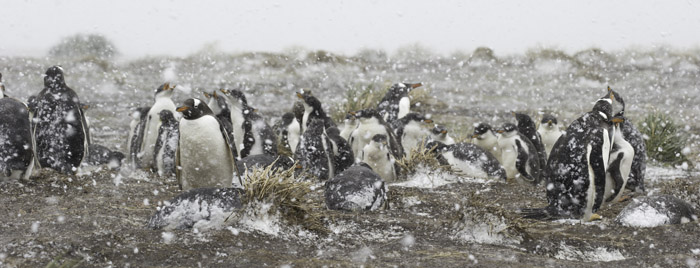 A rare summer snowstorm at Sea Lion Island at a Gentoo Penguin colony.
A rare summer snowstorm at Sea Lion Island at a Gentoo Penguin colony.
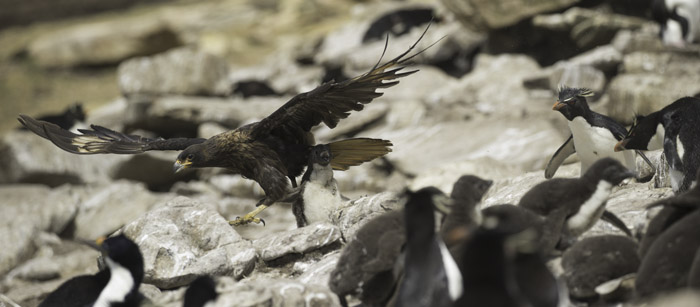 The moment of impact when a Striated Caracara grabbed a Rockhopper Penguin chick at the Neck at Saunders Island. Scroll down to read the details and to see more images.
The moment of impact when a Striated Caracara grabbed a Rockhopper Penguin chick at the Neck at Saunders Island. Scroll down to read the details and to see more images.
The Falkland Islands has always been one of our favorite wildlife photography destinations, and has often been called the Galapagos of the South Atlantic. And for good reason, but the Falklands actually offers even better photography than that iconic destination. In the Falklands, you are not pressured to keep some tour deadline, or limited to particular viewing areas or locations. Most of the islands are privately owned and quite often, at the best shooting spots, you (and your group) are the only ones there at the time. Consequently, you can devote as much time as you wish on a particular subject, allowing you to capture incredible images and record striking behavior.
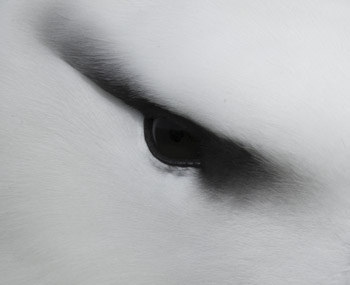 This was our second trip to the Falklands since the digital age, when we visited the Falklands in December-January of 2013-2014. Prior to that, back in the film days, we would spend as much as six weeks here, but after three or four years of annual trips, with our film library stuffed with images, we moved on to other destinations, and visited the Falklands only when we were doing an Antarctic trip where the Falklands was a brief stopover on the itinerary. Those visits, although satisfying, never did the islands justice, and we knew we had to return. Now, the Falklands is a trip we do every other year, and we're already planning our next trip for 2017, and we can't wait to get back.
This was our second trip to the Falklands since the digital age, when we visited the Falklands in December-January of 2013-2014. Prior to that, back in the film days, we would spend as much as six weeks here, but after three or four years of annual trips, with our film library stuffed with images, we moved on to other destinations, and visited the Falklands only when we were doing an Antarctic trip where the Falklands was a brief stopover on the itinerary. Those visits, although satisfying, never did the islands justice, and we knew we had to return. Now, the Falklands is a trip we do every other year, and we're already planning our next trip for 2017, and we can't wait to get back.
This year, we experienced the whole gamut of seasons -- summer and winter -- in a two weeks span, enjoying balmy, sunny days at the beginning of the trip and record low temperatures, with snow and hail and near hurricane force winds, at the end of the trip. While our productivity would undoubtedly been even higher had we had clement weather every day, we did extraordinarily well, as you'll see from this report.
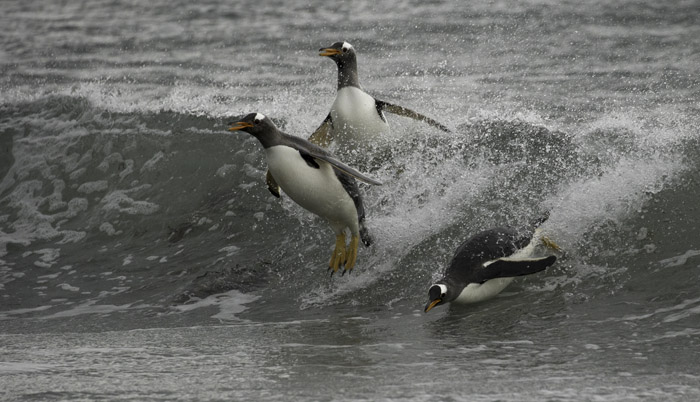 Gentoo Penguins surfing in to the beach on their way to one of several large breeding colonies -- this one on Sea Lion Island.
Gentoo Penguins surfing in to the beach on their way to one of several large breeding colonies -- this one on Sea Lion Island.
We will be offering a FREE Ebook shooting guide on tips to photographing the birds and wildlife in the Falklands. It will be available to everyone on our Constant Contact mailing list and also our personal email contacts via our office. If you'd like a copy, get on our list and we'll send you the ebook (or the download link) as soon as we have this completed.
Port Howard, Gladstone
.jpg) Day 1 of being in the field. I’m writing this at Port Howard, West Falklands, after our first afternoon in the field, and after a rather eventful journey to arrive here. We had arrived in Puenta Arenas, the southernmost major city in Chile, on Dec. 31st, giving us some ‘grace period’ if flights were delayed or cancelled for our flight to the Falklands. Miss that flight and you won’t have another until the following Saturday, so it isn’t a flight you want to miss. New Year’s Eve, for us, was a non-event, but the following day was a challenge in finding a restaurant that was open on the New Year’s Day holiday. The following day, Jan. 2, we arrived at the airport early for the one-day-a-week flight to the Falklands, only to learn that the flight was cancelled due to high winds on the islands. The following hours were rather hectic and frustrating, as we spent most of the day at the airport, waiting for word on lodging and transportation into town. LAN Chile’s representative did a great job getting rooms for the 100 plus passengers, something we didn’t feel a US carrier would have done since the flight cancellation was due to weather and not because of mechanical issues, and therefore would be an act of God in the US excuse book.
Day 1 of being in the field. I’m writing this at Port Howard, West Falklands, after our first afternoon in the field, and after a rather eventful journey to arrive here. We had arrived in Puenta Arenas, the southernmost major city in Chile, on Dec. 31st, giving us some ‘grace period’ if flights were delayed or cancelled for our flight to the Falklands. Miss that flight and you won’t have another until the following Saturday, so it isn’t a flight you want to miss. New Year’s Eve, for us, was a non-event, but the following day was a challenge in finding a restaurant that was open on the New Year’s Day holiday. The following day, Jan. 2, we arrived at the airport early for the one-day-a-week flight to the Falklands, only to learn that the flight was cancelled due to high winds on the islands. The following hours were rather hectic and frustrating, as we spent most of the day at the airport, waiting for word on lodging and transportation into town. LAN Chile’s representative did a great job getting rooms for the 100 plus passengers, something we didn’t feel a US carrier would have done since the flight cancellation was due to weather and not because of mechanical issues, and therefore would be an act of God in the US excuse book.
The following day we successfully flew to the Falklands, arriving around noon, where we again waited at the Mt. Pleasant airport for our flight to a new destination for us, Port Howard, on the West Falkland mainland. We hadn’t had lunch, and walked to the commissary for a snack while we waited for our FIGAS flight, only to find that the store was closed on Sundays. Although we had 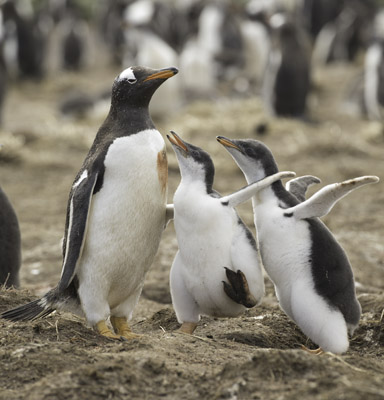 sufficient time at the airport we were rushed in separating what we had planned to leave in Stanley and what we’d take on the FIGAS planes (where you pay for extra luggage), and everyone kept things they’d have packed. The rush was due to our transportation company who was waiting for our gear, while another photo group was waiting for that driver to finish with us in order to get to Stanley, for their day trip to Volunteer Point and the King Penguins there.
sufficient time at the airport we were rushed in separating what we had planned to leave in Stanley and what we’d take on the FIGAS planes (where you pay for extra luggage), and everyone kept things they’d have packed. The rush was due to our transportation company who was waiting for our gear, while another photo group was waiting for that driver to finish with us in order to get to Stanley, for their day trip to Volunteer Point and the King Penguins there.
Although the store was close, Mary and I had left-overs from a Chinese meal the night before so we had something to eat, but still, all of us were hungry by the time we boarded a FIGAS plane for the 35 minute trip to Port Howard. En route, I used my Amazon Fire to shoot some aerials of the stone rivers that are a distinctive feature of the islands, regretting that I forgot that that device had a camera feature, and when we flew over the Andes I had incredible views of Mt. Fitroy but I didn’t take any photos.
Port Howard is one of the larger ‘camp’ settlements outside of the Falkland’s only major town, Stanley, and we were excited about visiting this new location. Our hosts, Sue and Wayne, who now own the tourist lodge (Sue started there as a maid!), were wonderful and very accommodating, and after a snack and sandwiches, we drove nearly an hour to a beautiful Gentoo Penguin rookery, set on a plateau and framed by distant hills – mountains down here, giving the location a completely different look from our other locations where we normally film Gentoos. We drove right up to the colony, where I spent the remainder of the afternoon, concentrating on mothers with chicks, incubating the chicks or feeding them. It was a warm day and there were a surprising number of flies in the air. One bird had scores of flies scrambling over its feathers, and we wondered if there was a dead chick beneath it. At one point, when there was little wind and I was fairly close to the birds, I could hear them breathing, a sighing-groaning sound that I’ve never
.jpg)
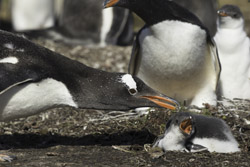
heard before. Mary, Don and Judy, and Eric hiked down to the bay to catch Gentoos as they emerged from the bay, and had some luck with birds porpoising and skipping out of the sea. Additionally, various gulls, geese, caracaras, and ducks were always in view along the bay, making for a visually diverse afternoon.
At dinner, we were a bit surprised. We were served a beautiful cut of tooth fish, extremely mild, and although quite tasty we thought it was the main course, and the portion wasn’t nearly enough to satisfy a hunger after a day afield. I asked if there were seconds – there was none, and I put my mind into figuring I’d lose weight when Sue walked in to the dining area with the main course, a heaping plate of great tasting lamb, potatoes, broccoli, and cabbage, followed by an apple crumb and cream dessert – leaving us stuffed, not famished, for our first day in the Falklands.
Day 2. White Rock, Port Howard
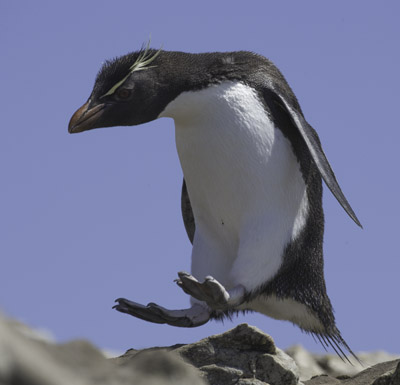 A mild sea fog partially obscured the early morning sky but by the time we headed out, around 8:15, the fog was centered in the west, and our eastern skies were sunny and clear. The Land-Rover ride to White Rock is one of the longest we’ve made in the Falklands, taking nearly three hours, passing from a government maintained road to a camp-maintained road, to dirt tracks, to tire tracks, to bush-whacking cross country, including one stint where we drove up one of these unique stone rivers or stone runs, as the locals call them, that had been graded, somewhat. That was the most interesting aspect of the drive, giving us an opportunity to truly be in the heart of one of these unique geologic feature. The rocks, and no one really knows how this happened, are piled in cascading flows from the ridges, resembling streams or glacial runs. Many are set at various angles, including some nearly plywood-thin rock slabs that nearly vertically, and most are dappled in pale lichens.
A mild sea fog partially obscured the early morning sky but by the time we headed out, around 8:15, the fog was centered in the west, and our eastern skies were sunny and clear. The Land-Rover ride to White Rock is one of the longest we’ve made in the Falklands, taking nearly three hours, passing from a government maintained road to a camp-maintained road, to dirt tracks, to tire tracks, to bush-whacking cross country, including one stint where we drove up one of these unique stone rivers or stone runs, as the locals call them, that had been graded, somewhat. That was the most interesting aspect of the drive, giving us an opportunity to truly be in the heart of one of these unique geologic feature. The rocks, and no one really knows how this happened, are piled in cascading flows from the ridges, resembling streams or glacial runs. Many are set at various angles, including some nearly plywood-thin rock slabs that nearly vertically, and most are dappled in pale lichens.
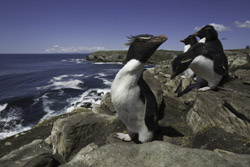
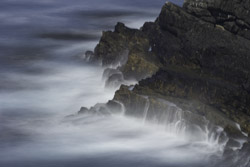
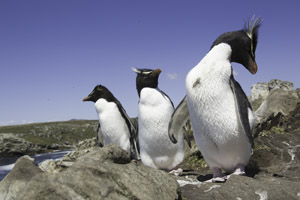
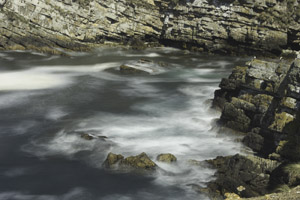
We arrived at a Rockhopper Penguin rookery by 10:30, in light that at that point in the day was marginal – too bright and too much contrast for the moment, as the birds facing us were backlighted. We were also surprised by the size of the Penguin chicks. They were nearly half-grown, and most were collected in creches. A few King Cormorants nested on elevated mud platforms within this penguin colony, and these cormorants, or their nests, oddly enough, became the focal point for many of the young penguins. Perhaps they huddled there for protection, as King Cormorants can poke fiercely when disturbed, and thus the chicks might have some shelter from Skuas and Striated Caracaras.
Turkey Vultures sailed back and forth along the cliff face, with many stopping and feeding on penguin chick carcasses, their normally reddish heads now bright red with, I assume, gore. A Variable Hawk, formerly known as a Red-backed Hawk, took flight from a nearby rock, screaming in protest, and landed on a sea stack across a small ravine. I looked for a nest but I found nothing. A bleating lamb did catch my attention, the lamb standing near its mother who was on her side and facing uphill, kicking frantically with her legs. I’ve heard, but didn’t know whether to believe it, that a sheep lying down with its legs pointed uphill could be trapped in this position and die. This ewe was in that dilemma, so I hiked up, grabbed her legs, and spun her so that she was out of the small depression she had been in, and now with her legs pointed downhill. She scrambled frantically to get away, but could not get to her feet, and instead she just flopped along, her legs spinning, obviously in distress. Neal, one of our drivers, later told me that sheep will flounder like this in depressions, wallows, or hills, and sometimes can be saved if they are turned and their bellies are massaged. This one, with eyes either rolled up in her head, perhaps suffering from pink eye, would certainly not make it.
All of us spent a little time simply getting familiar with the landscape and the shooting possibilities, and eventually I settled in on a steep slope where I had a 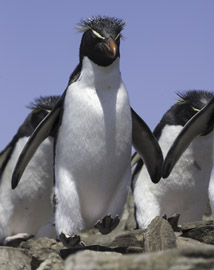 good view of the cliff top, and some passageways for the penguins. I was sitting in a location when a group of Rockhoppers hopped and walked nearby, and for the next hour or so I was shooting wide-angle views of the Penguins, just feet away. Judy crawled up to join me, and the birds were unconcerned, as more small groups arrived, passed by, and were replaced by others. It was magical.
good view of the cliff top, and some passageways for the penguins. I was sitting in a location when a group of Rockhoppers hopped and walked nearby, and for the next hour or so I was shooting wide-angle views of the Penguins, just feet away. Judy crawled up to join me, and the birds were unconcerned, as more small groups arrived, passed by, and were replaced by others. It was magical.
At 2PM we switched rookeries, visiting another nearby colony where King Cormorants were the dominant nester, although Rockhoppers were scattered about. Quite oddly, one lone King Penguin was 3/4s of the way up the sloping rock chute the Rockhoppers use to commute to the nesting area. Brown Skuas periodically darted and feinted to the edge of the Cormorant colony trying to dislodge an adult from the nest and snag a chick. At the very end of the day, when I had packed up my gear, a pair of Skuas did exactly that, pulling out a tiny black Cormorant chick and tearing it apart. A Striated Caracara later stole the chick, and was dive-bombed repeatedly by the annoyed Skua.
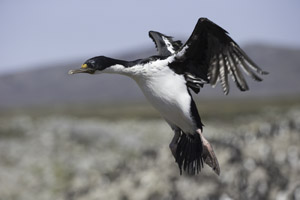
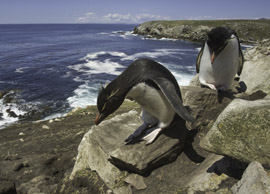
Mary had some great luck with the dark phase of the Variable Hawk (the male) flying by while she sat along the colony’s edge, and also with Turkey Vultures. I spent the last part of my afternoon trying to make friends with a Striated Caracara, hoping to get close-ups with a wide-angle that would include the sea and the cliffs behind. I was fairly successful, as was Mary earlier in the day.
At 4:30 we headed back to camp, a two hour ride that covered 24 miles, often with an average speed of only 8mph. We arrived by 6:30, exhausted from a long shoot and a very bouncing, rocking drive. However, Mary felt that today’s location was in the top 10 of the shoots we’ve done in the Falklands – it was good!
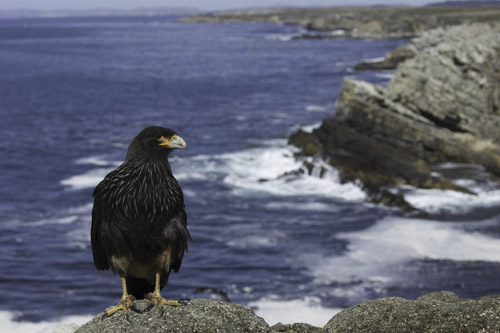
Day 3. Carcass Island
We were lucky to get an early morning FIGAS flight to Carcass Island, leaving at 8:45 for the 30 minute flight. We were met by our friend and the best host in the Falkland Islands, Rob McGill, who had a waiting automatic transmission SUV ready for me to drive back to the settlement. Although we had the option of driving to the King Cormorant colony that is located on the opposite side of the island from the settlement, we opted to stay around the lodge. What could have been a leisurely afternoon certainly wasn’t, as the shooting throughout the day was intense.
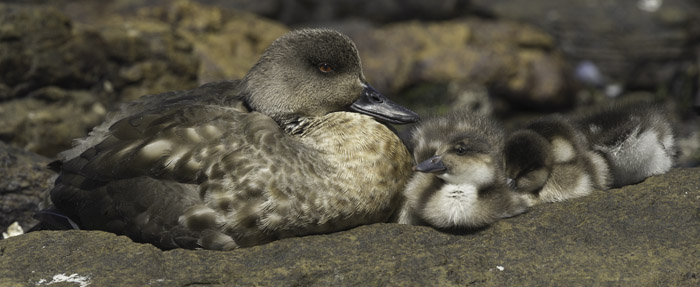
Before our 12:30 lunch we had headed down to the beach, which was seeing a low tide, where I worked on a family of Patagonian Crested Ducks. A hen and drake sat on either side of a flat rock with five or six fuzzy chicks resting in between, cute little ducklings and the smallest I’ve had a chance to photograph. Mary worked on feeding Magellanic Oystercatchers. We were quite close to both subjects. After lunch, I headed back to where I’d seen a Grass Wren earlier, and found three 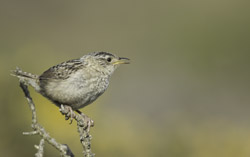 yellow-beaked fledglings and at least one adult who came in to feed. At one point, when I was attempting to take off my jacket on this very warm and sunny afternoon, and with both of my arms effectively pinned back by the jacket behind my back, the Wren hopped out, quite close, and straddled two grass stems in the classic Grass Wren pose. I wiggled and scrambled to get free of the jacket in time but I was not successful. However, as the afternoon progressed both Mary and I had numerous other opportunities, and ended up doing quite well with the birds.
yellow-beaked fledglings and at least one adult who came in to feed. At one point, when I was attempting to take off my jacket on this very warm and sunny afternoon, and with both of my arms effectively pinned back by the jacket behind my back, the Wren hopped out, quite close, and straddled two grass stems in the classic Grass Wren pose. I wiggled and scrambled to get free of the jacket in time but I was not successful. However, as the afternoon progressed both Mary and I had numerous other opportunities, and ended up doing quite well with the birds.
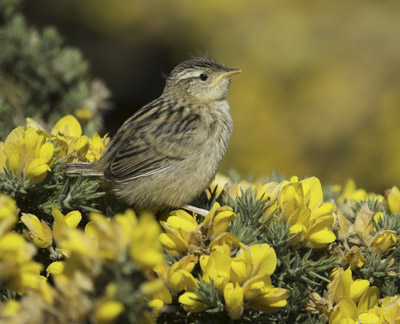
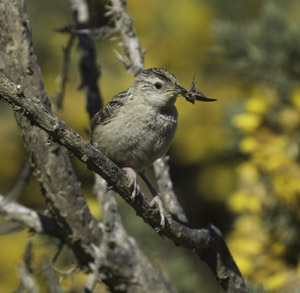
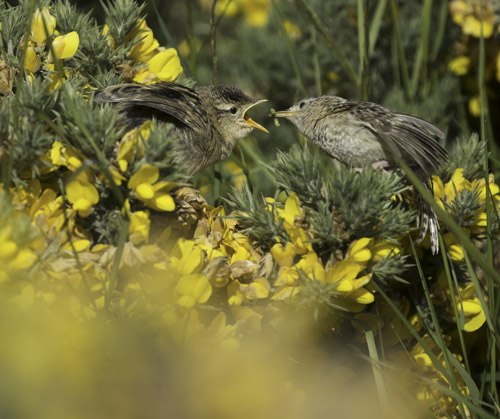
Grass Wren. The fledgling looks a little like a House Sparrow because of the yellowish bill, while the adult's bill is dark. These are shy birds and most easily seen at Carcass Island, one of the few cat-free islands.
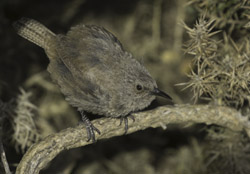 We also had great luck with Cobb’s Wren, the House Wren that is endemic to the Falklands, as well as great opportunities with Flightless Steamer Ducks, Kelp Geese, and Magellanic Oystercatchers. The Oystercatchers had a small, well-camouflaged chick in the low diddle-dee groundcover, and peeping a distinctive call they’d approach the chick and feed it the chrysalis or pupae of moths. Right after lunch, both Mary and I donned light weight, and very inexpensive, chest waders so that we could sit or kneel in the rising tidal water, and from that position we photographed Crested Ducks, Black Oystercatchers, and more Steamer Ducks. At one point, a Crested Duck female defended her chicks from a Kelp Goose male that grazed too close to her, and later, both male and female Flightless Steamer Ducks charged across the water to chase off a drake Crested Duck that had approached the Steamer Duck’s two large chicks. The Ducks churned across the water, running and flapping, and both of us were ready as the two raced by.
We also had great luck with Cobb’s Wren, the House Wren that is endemic to the Falklands, as well as great opportunities with Flightless Steamer Ducks, Kelp Geese, and Magellanic Oystercatchers. The Oystercatchers had a small, well-camouflaged chick in the low diddle-dee groundcover, and peeping a distinctive call they’d approach the chick and feed it the chrysalis or pupae of moths. Right after lunch, both Mary and I donned light weight, and very inexpensive, chest waders so that we could sit or kneel in the rising tidal water, and from that position we photographed Crested Ducks, Black Oystercatchers, and more Steamer Ducks. At one point, a Crested Duck female defended her chicks from a Kelp Goose male that grazed too close to her, and later, both male and female Flightless Steamer Ducks charged across the water to chase off a drake Crested Duck that had approached the Steamer Duck’s two large chicks. The Ducks churned across the water, running and flapping, and both of us were ready as the two raced by. 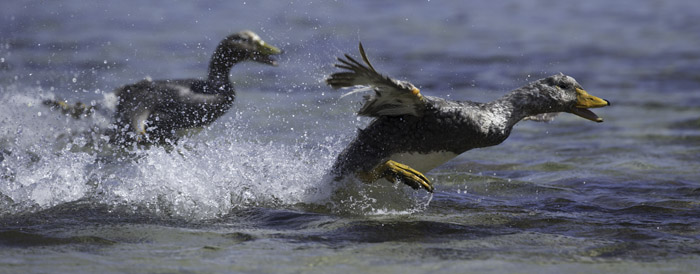 A pair of Flightless Steamer Ducks about to chase off an intruding Crested Duck.
A pair of Flightless Steamer Ducks about to chase off an intruding Crested Duck.
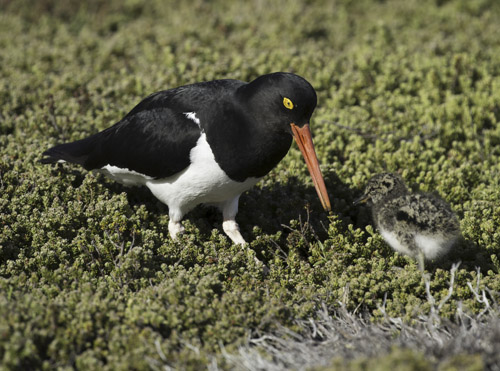
Magellanic Oystercatcher and chick
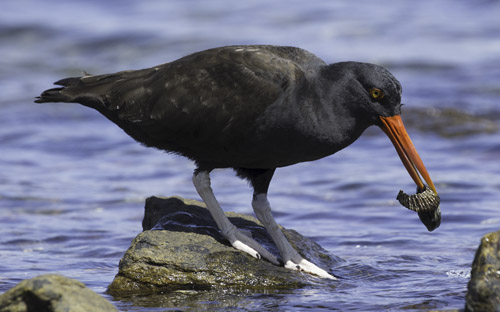
Blackish Oystercatcher and barnacle lichen prey
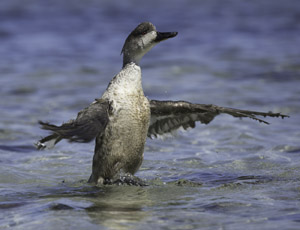
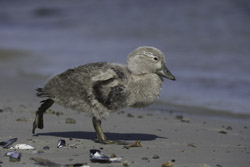
Crested Duck stretching and Flightless Steamer Duck chick
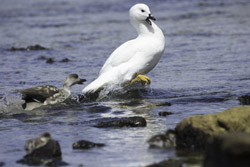
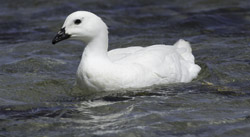
Kelp Goose male being chased by hen Crested Duck
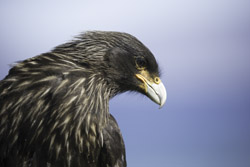 In all, Mary shot 1,300 images and I shot 1,750 through the day – a great shooting day, and actually somewhat leisurely, with everyone staying within a few hundred yards of the lodge for all of our photography.
In all, Mary shot 1,300 images and I shot 1,750 through the day – a great shooting day, and actually somewhat leisurely, with everyone staying within a few hundred yards of the lodge for all of our photography.
Day 4. Carcass to West Point and back
We planned to sail to West Point for Rockhoppers and Black-browed Albatross, with a 9:15 departure for the hour or so boat trip. At breakfast a rain squall splattered the windows of the lodge, and we were afraid that we might have a very bleak day but fortunately the rain only lasted a few minutes, and blue sky soon appeared in the direction we were headed. When we boarded the boat and began our trip the skies cleared, with a clear blue sky ahead that lasted most of the day.
Our boat captain, Mike and his first mate and wife, Jeanette, gave us a lift to the 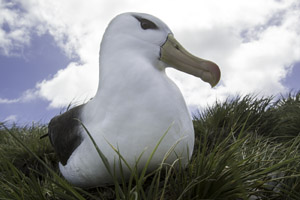
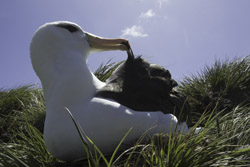
top of the ridge, to Devil’s Nose, the site of the colony. Most of the Black-browed Albatrosses and Rockhopper Penguins nest on the talus slope located between two high ridges, but birds nest right up into the tussock grass, where a trail takes one right to the very edge and almost into the colony. From that position one can photograph Albatrosses with a wide-angle, at frame-filling distances. Most of the baby Albatrosses were about 10 inches high and were a fuzzy grayish white, and if they were alone they would snap their beaks in annoyance whenever anyone was near. Those chicks that were under their mothers were content and did not snap their bills. Some of the adults looked as if they did not have chicks but they did, with the young birds hiding under the adult’s feathers and sitting on top of the parent’s wide, pale webbed feet. I had a great view of those feet when one bird left its nest and walked towards me, first nearly touching my leg with its beak, then stepping by, pausing for a moment and giving me time to do a tight shot of the feet. The bird, its head wagging from side to side in its sauntering stroll, continued on, walking up the trail I had just traveled.
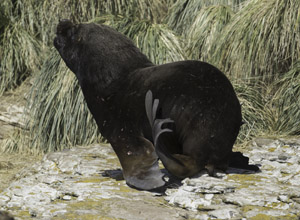 Other highlights – on the boat ride in to West Point, we spent ten minutes or so at a rock face where Southern Sealions had hauled out. The huge bull galloped across the rocks several times as he chased off smaller males, causing some to dive off the rocks and into the surf. At one point he moved into his harem, all slender, tan-colored females that seemed tiny next to him, but he soon lost interest and chased after more rivals. It was one of the best shooting opportunities we had with Sealions, but we didn’t know then what we’d later have during the trip.
Other highlights – on the boat ride in to West Point, we spent ten minutes or so at a rock face where Southern Sealions had hauled out. The huge bull galloped across the rocks several times as he chased off smaller males, causing some to dive off the rocks and into the surf. At one point he moved into his harem, all slender, tan-colored females that seemed tiny next to him, but he soon lost interest and chased after more rivals. It was one of the best shooting opportunities we had with Sealions, but we didn’t know then what we’d later have during the trip.
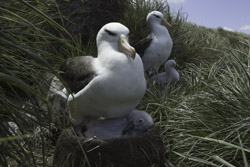 Penguins, mainly Rockhoppers, porpoised along with our boat, but we did not see any Dolphins today, nor were any dolphins spotted yesterday. Mary hiked to the far end of the colony where she laid down on her belly and photographed parades of Rockhoppers leaving the upper reaches of the nesting area to continue their long trek to the sea far below. Although the day started with clear skies the weather did change throught the day, going to variable clouds, and finally to an overcast that set in, heavily and darkly, when we were about to quit. The seas had calmed considerably on the return trip, which took exactly one hour and made for an easy crossing.
Penguins, mainly Rockhoppers, porpoised along with our boat, but we did not see any Dolphins today, nor were any dolphins spotted yesterday. Mary hiked to the far end of the colony where she laid down on her belly and photographed parades of Rockhoppers leaving the upper reaches of the nesting area to continue their long trek to the sea far below. Although the day started with clear skies the weather did change throught the day, going to variable clouds, and finally to an overcast that set in, heavily and darkly, when we were about to quit. The seas had calmed considerably on the return trip, which took exactly one hour and made for an easy crossing.
Day 5. Carcass to Saunders Island
We had the first FIGAS flight from Carcass, leaving around 10AM for a 10 minute hop to our next destination, Saunders. We were greeted by two of our oldest friends in the Falklands, the owners of Saunders, David and Suzan Pole-Evans. I’ve known David since my very first scouting trip to the Falklands about 23 years ago, and always enjoy my time with David and his family.
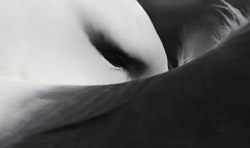 After lunch, I had a special treat, having the opportunity to drive one of the Land-Rovers and to follow David to one of the porta-cabins, actually a nice, small guest house, located at a Rockhopper Penguin and King Cormorant Colony. David asked me if I’d be comfortable keeping the vehicle and driving back by myself, assuring me that I wouldn’t get lost. To help in this, I used a brand new app, called My Tracks, that my friend, Mark Thomas – who co-led our Antarctica trip with Joe Van Os, told me about. The app proved invaluable, as I could literally just follow the same route back. Twice I deviated off trail, but it was clear that I was off the main route, and it was easy to regroup and get on to the correct trail.
After lunch, I had a special treat, having the opportunity to drive one of the Land-Rovers and to follow David to one of the porta-cabins, actually a nice, small guest house, located at a Rockhopper Penguin and King Cormorant Colony. David asked me if I’d be comfortable keeping the vehicle and driving back by myself, assuring me that I wouldn’t get lost. To help in this, I used a brand new app, called My Tracks, that my friend, Mark Thomas – who co-led our Antarctica trip with Joe Van Os, told me about. The app proved invaluable, as I could literally just follow the same route back. Twice I deviated off trail, but it was clear that I was off the main route, and it was easy to regroup and get on to the correct trail.
Because of an unexpected cancellation at the guest house at the rookery, we had the option for some of us to stay there. The cabin could sleep four, and Eric, who lamented on not being able to stay at the Neck this year (another great Saunders location), now had the chance for the dawn and sunset light he coveted. Don and Judy decided to stay over, too, so David drove Don and Judy, and Eric joined me, for the drive to the guest house. After dropping us off, I drove the remaining mile with the group to the Rockhopper colony, negotiating some rather hair-raising sections where our jeep track took us down very steep hills, seemingly right to the cliff edge and the sea far below.
There are three Rockhopper colonies here, all within one hundred yards of each other, one above the other on a hillside. King Cormorants nest here as well. David was telling us that the birds at the Neck were suffering terrible predation at the
first of the two large Rockhopper colonies, as Striated Caracaras, also known as Johnny Rooks, were killing between 20 and 100 chicks a day. Sometimes they would eat the head, but they were also killing for the fun of doing so. At that rate, they were told by their recent guests, there’d be no chicks left within a few weeks. We’ll see for ourselves in two day’s time.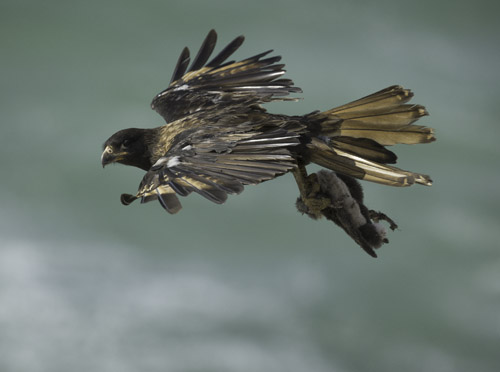
Knowing these facts, I was keen to see what was happening at this colony. I did see several corpses, some headless, and perhaps, just perhaps, more than what we’d normally expect to see. Many portions of the colony were vacant, but that could be because the young Rockhoppers are now forming juvenile creches and are not on nests. At the Neck, we were told fuzzy babies were going down to the sea edge, starving, and then dying, and here, at this colony, I saw one fuzzy chick repeated approaching an adult, and being pecked and grabbed for doing so. While this was happening, an entire group of fuzzy chicks hopped and tripped and walked down the rocks, looking as if they were going to leave the colony. The adult that was harassing the chick, and then a few other adults that joined him, pecked at the chicks, and the chicks reversed themselves and headed back into the center of the colony. I wondered if the one aggressive adult was simply that, aggressive and nasty, or if that bird was instinctively guarding the boundary, and driving the chicks back. That would imply that that bird was a baby-sitter, and had a duty, and that would imply that there was some sort of division of labor, which I’d find unlikely. Still, the aggressiveness of the bird did prevent the chicks from wandering from the colony, and did move them back towards the safer center.
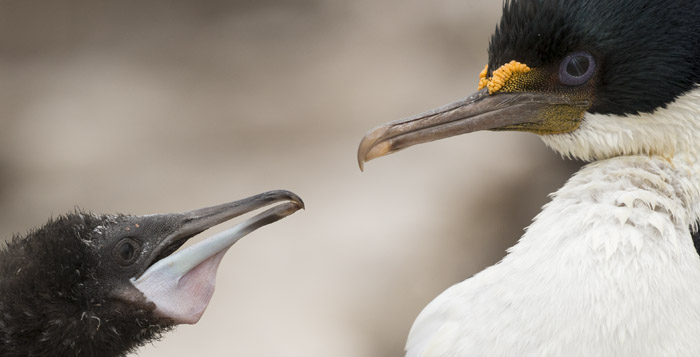
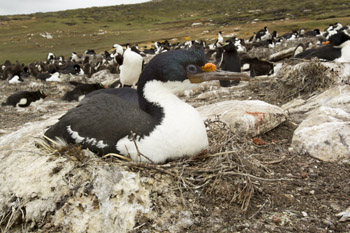
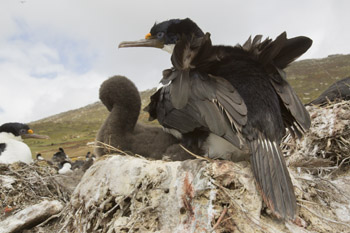
Turkey Vultures fed on some chicks along the colony edge, and there is supposed to be one pair of Caracaras hunting this colony, but not with the damaging intensity as those at the Neck are doing. Cormorants had eggs and chicks, and I saw some chicks that were nearly half-grown, with the beginning of adult feathers, while I saw other nests with ‘snake’ babies, tiny, featherless chicks that do remind one of writhing snakes (think of Medusa, her hair a nest of snakes) and a few nests still with eggs. I watched one nest where a one baby tried to solicit food from the adult, unsuccessfully, until its mate flew in. The two Cormorants remained at the nest for a few minutes, with the original bird stepping off the nest and gathering dried sprigs of seaweed from another nest – either abandoned or where the chicks were killed. Eventually the first bird flew off, and the new adult stepped in close.
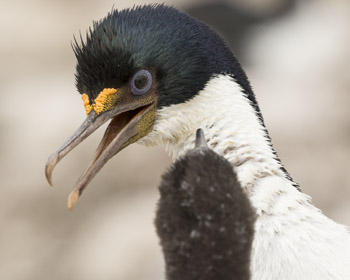
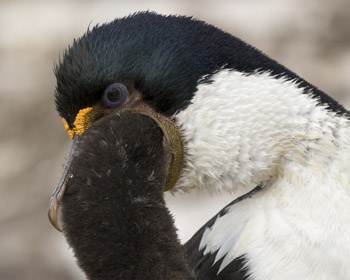
The baby, half-grown, weaved back and forth, uttering a mewing cry, all the while pecking or touching either the adult’s beak or its gular patch at the bill’s base, and after targeting that spot several times the adult would regurgitate, with the chick’s head stuck down its throat. I stayed for three incredibly fast feedings, and when I left Don and Judy took my place, and saw the chick being fed two more times.
I had moved to the cliff edge, where I tried, somewhat unsuccessfully, to catch Rockhoppers mid-jump, framed by the sea below. I missed most opportunities.
At 5 I drove the three to the guest house and headed back to camp following My Tracks on my phone. I had told David that he should come looking for me if I wasn’t back by 6 but when I saw David later, he expected I’d arrive late, and, joking, said he had no intention of looking for me either. At 7, Mary, Marshall, and I walked over to their house for a delightful dinner. Their daughter, Carol, had made lasagna – done the way we love it, with plenty of meat and cheese, and several other dishes as well. We ate family style, and visited for nearly three hours – truly one of the highlights of our trip to the Falklands this year. We always enjoy these visits, but having time to eat, drink, and chat – it was precious. We just hoped that Don, Judy, and Eric were having even half the fun we had this evening.
Day 6. Saunders Island
Eric, Judy, and Don had a full evening while Mary, Marshall, and I had our wonderful dinner with David and Suzan. They hiked down to the Gentoo Penguin and Magallenic Penguin colonies, enduring spats of rain and hail, and did so the following morning as well. Eric got up very early to shoot birds in the low light, but periodic hail and rain squalls made the photography challenging. Mary worked on business with the internet connection, while Marshall and I talked politics and economics as the morning progressed, accompanied by hail, rain, sun, and continuous high winds.
At 11 we set out for the rookery, carrying lunch for the three who overnighted at the cabin. The Pole-Evans were rounding up sheep, and we would have missed Judy and Eric out in a distant Gentoo colony had not Louise, one of their daughters, commented on the two being out there. We turned around and retrieved the two, and met Don at the cabin for a late lunch. Afterwards, we drove to the rookery, or rather I did, with Mary as co-pilot, white knuckled and scared to death as I drove the slanted, steep hillside where, should a Land-Rover tip, it would roll downhill and over a cliff and into the sea. Obviously, that didn’t happen, and we arrived, after some slips and bumps, at the colony. Mary and I headed right to the cliff 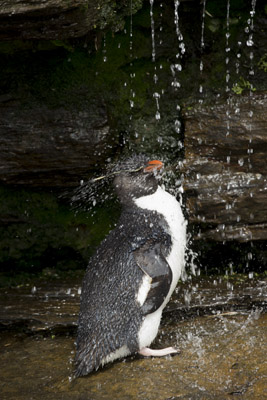
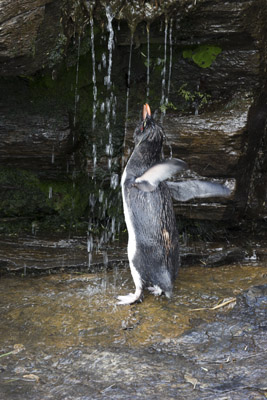
edge, which we hadn’t visited in a few years, where the famous ‘shower’ is located. Here Rockhoppers come to quite literally shower at a small waterfall that drips over an overhanging rock. Negotiating several horizontal slaps of stone, and across a few extremely slick spots where mud flow, water, and penguin poop accumulated, I found the shower. Birds were bathing, and through the day the light just got better. Several Black-browed Albatrosses also nested nearby, with 1/3rd grown 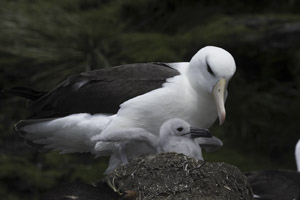
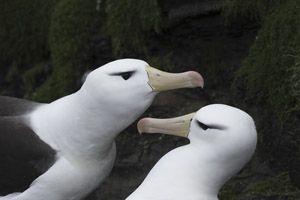
chicks, and these provided incredible shooting opportunities, as we were actually shooting at a slight angle, upward, to the birds.
Rockhoppers were constantly filing passed, and from our position we could see birds both entering and leaving the surf. The latter is the most impressive, as 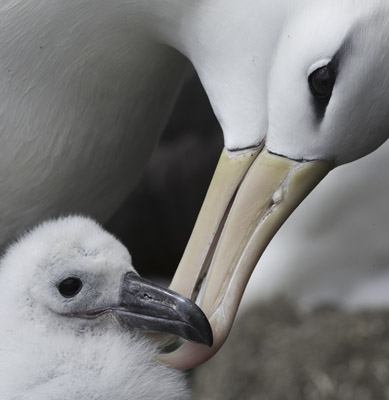
waves toss these slightly larger than football-sized birds around like footballs, and 6it is amazing that any birds survive the pounding. At one point during the afternoon I found a spot where I could look down on birds attempting a challenging climb up a cliff ledge. When I arrived, some birds had successfully made the climb, but as I watched, and videoed and filmed, no other bird successfully climbed up the ledge. I wondered if I had actually seen one do so, but after I stopped watching, birds continued to move up the cliff, obviously from that obstacle.
Towards the very end of our shoot Mary unexpectedly spotted a rare, errant
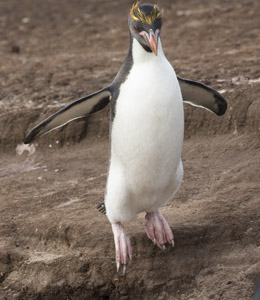
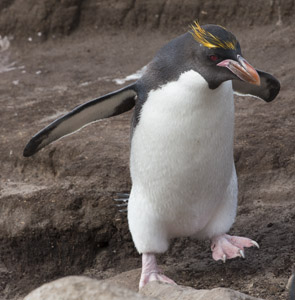
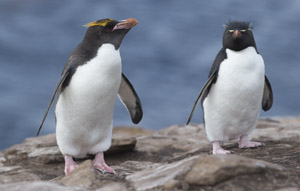
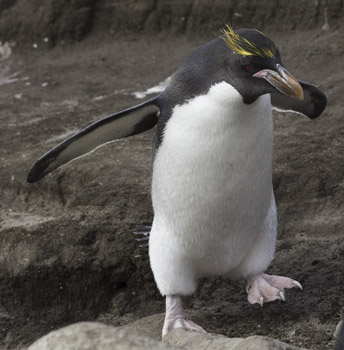 Macaroni Penguin hopping by. She wasn’t in position to shoot, but I was, and I had my lens ready. Over the next five or ten minutes I scrambled up the cliff ahead of the bird, photographing it as the bird approached and passed me, then I’d grab my gear and run or climb on to the next set of ledges. I captured several good shots. I left the Macaroni when it neared the colony to help Mary and Judy at the cliff, so I lost track of the bird, although later we were told that the bird usually hangs out in the center of one of the colonies. We looked, but never saw it again, and with rain beginning, we started back for home.
Macaroni Penguin hopping by. She wasn’t in position to shoot, but I was, and I had my lens ready. Over the next five or ten minutes I scrambled up the cliff ahead of the bird, photographing it as the bird approached and passed me, then I’d grab my gear and run or climb on to the next set of ledges. I captured several good shots. I left the Macaroni when it neared the colony to help Mary and Judy at the cliff, so I lost track of the bird, although later we were told that the bird usually hangs out in the center of one of the colonies. We looked, but never saw it again, and with rain beginning, we started back for home.
For some reason, my My Tracks app stopped – perhaps because it was on without movement for a few hours and simply stopped tracking at that point, so we had to rely on memory, both mine and Mary’s, to find our way home. We did OK until the settlement was within sight, when I took what looked like the most traveled track only to find that it was probably no longer in use because the tire tracks went too deep, threatening to high center the Land-Rover. We started down, with the bottom of the vehicle skimming along the trail’s center ridge, and I was quite worried we’d be stuck. I stopped and put the vehicle in reverse and in four-wheel-low, and was lucky enough to backup on a 20 degree pitch until we could reach an alternate track. Thankfully, I wasn’t stuck, which would have amused Dave Pole-Evans immensely, and which I’d have suffered comments for many years to come. We arrived home safely, and Suzan cooked a spectacular lamp roast, with broccoli and potatoes and apple pie and wine – a great end to a great day.
Day 8. The Neck at Saunders Island
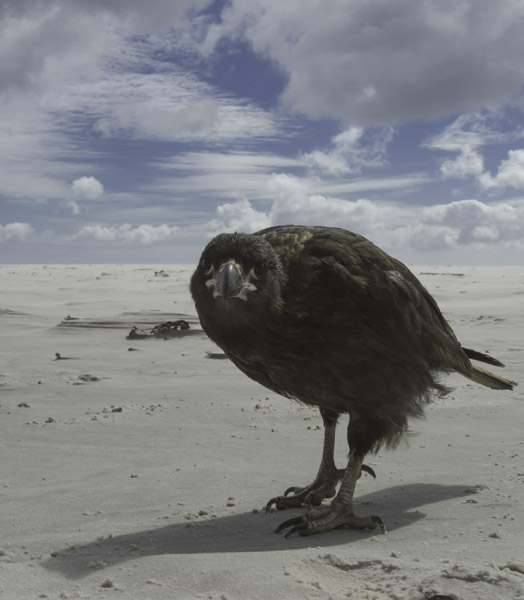
At 9 we made the hour plus drive across much of Saunders Island, arriving at The Neck shortly after 10AM. The sky was reasonably clear, and as the day progressed the skies cleared so that, most of the day, it was virtually cloudless. I was curious 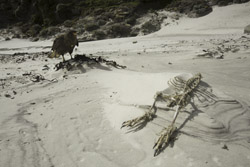 about the Rookery and the Caracara predation, and after hiking down to the beach where the Rockhoppers swim in, I climbed up the cliff towards the colony. I crossed a draw, and set up for the Black-browed Albatrosses and while waiting for some action the Striated Caracaras struck, with a bird flying in with a third-grown Rockhopper chick, stunned and near death, but still alive. I started filming, and videoing, and while doing so, my attention was drawn to two other Caracaras that were a bit further up the hill, in the process of killing a half-grown chick still struggling against the two raptors. It was gruesome, as the birds
about the Rookery and the Caracara predation, and after hiking down to the beach where the Rockhoppers swim in, I climbed up the cliff towards the colony. I crossed a draw, and set up for the Black-browed Albatrosses and while waiting for some action the Striated Caracaras struck, with a bird flying in with a third-grown Rockhopper chick, stunned and near death, but still alive. I started filming, and videoing, and while doing so, my attention was drawn to two other Caracaras that were a bit further up the hill, in the process of killing a half-grown chick still struggling against the two raptors. It was gruesome, as the birds 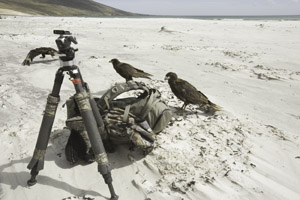 easily subdued the chick, then proceeded, mainly, to work at its head, basically opening the face and skull up without actually killing the bird. Eventually, mercifully, the chick died, and the birds, for the most part, only ate the head. The first Caracara that I had seen was surrounded by four other dead chicks, and sadly virtually all only had their front end or their heads missing.
easily subdued the chick, then proceeded, mainly, to work at its head, basically opening the face and skull up without actually killing the bird. Eventually, mercifully, the chick died, and the birds, for the most part, only ate the head. The first Caracara that I had seen was surrounded by four other dead chicks, and sadly virtually all only had their front end or their heads missing.
While watching the Caracaras, I noticed two groups of Penguins coming towards shore, riding the waves and presenting a wonderful, aerial view. I moved to a new position, and after doing some shooting decided to check what a polarizing filter would do, and I’m glad I did because it really cut through the water. After shooting some stills, and some awful video, I ended up putting my vest over my head, providing enough shade for me to see my LCD screen, and in this way I did a very good video that lasted over thirty seconds, with incredible action throughout.
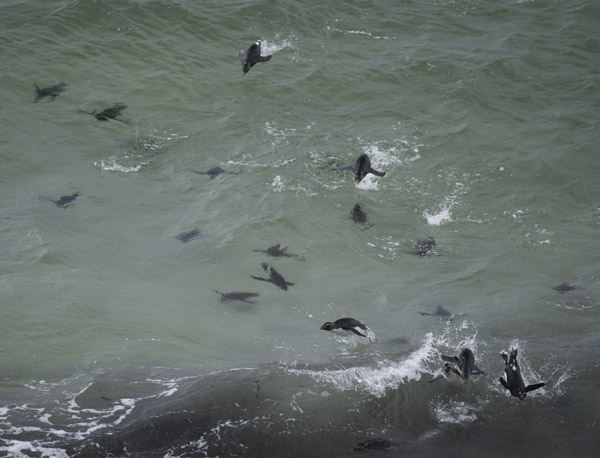
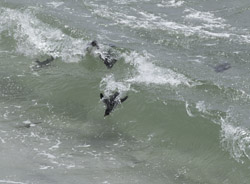
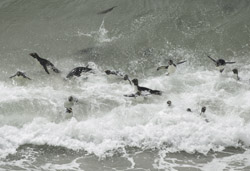
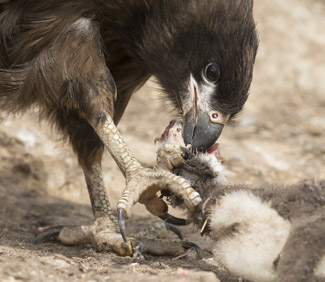
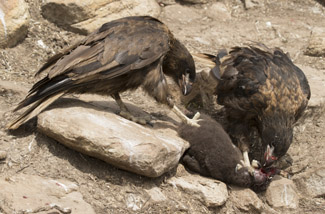
Afterwards I hiked back to the vehicle the Pole-Evans had left behind for us for shelter, knowing that Don and Judy would like to photograph/video this Rockhopper activity. The group returned, and they did well with these swimming Penguins.
I moved uphill where Caracaras were again hammering the penguin chicks. In the course of the afternoon I saw numerous predatory events. One Caracara killed two chicks in less than two minutes, and then took a third chick that may or may not have been dead when the Caracara carried it off. At one point, I saw a chick drop from the sky, dropping a hundred yards or more. When I looked up, whoever dropped it (probably a Caracara) was already out of sight. I moved up the cliff to be in a better position in case predation more occurred, and I recorded two
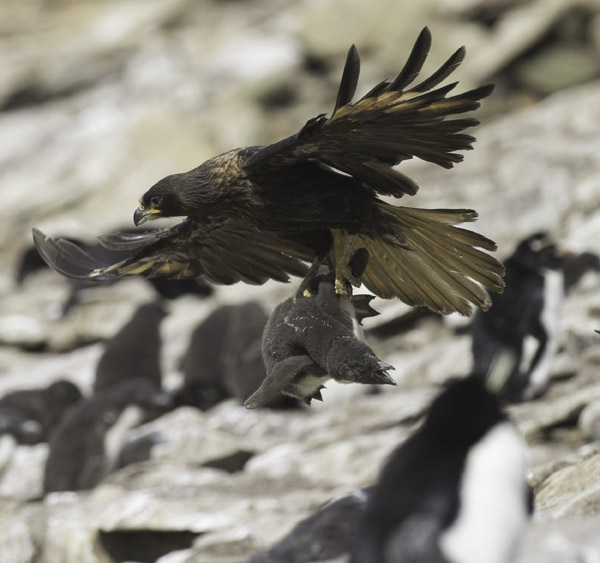
Seconds after snatching the chick the Caracara flew passed, then dropped
the chick and went after another one.
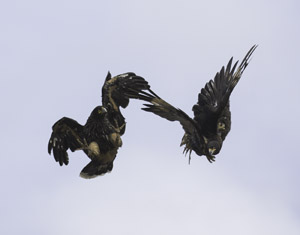
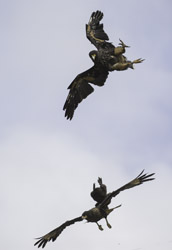
After another kill, an immature Caracara tried snatching a penguin chick from another adult.
In the shot on the right, the adult has dropped the chick and is actually above the bird
(note the empty feet on the lower bird).
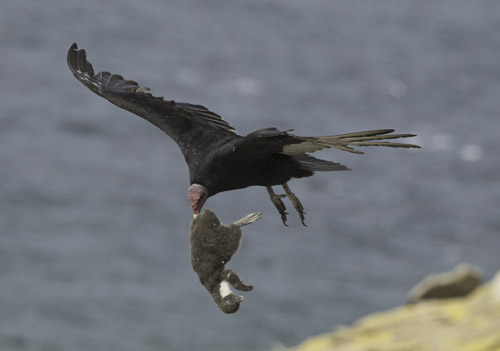
I've never seen a Turkey Vulture with prey in its beak. Islanders told me that they have seen Turkey Vultures killing adult Upland Geese. Another said that vultures also kill sheep lambs -- again, this is not recorded behavior. So who knows? I've never seen anything like the above image before either.
Caracaras doing aerial combat over a penguin, another carrying a chick off. Most remarkably, I also photographed a Turkey Vulture that was carrying a chick in its beak. Dolphin Gulls, Brown Skuas, more Turkey Vultures, and King Cormorants returning to their nests rounded out the afternoon shoot, and at 6 I headed back to the vehicle where Don, Judy, and Eric waited. We left soon after, as a storm front arrived, dropping the light to zero and bringing rain, and so we didn’t miss the coveted late evening, gold light that makes the Neck so popular.
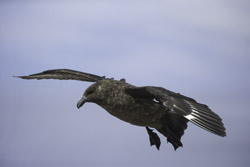
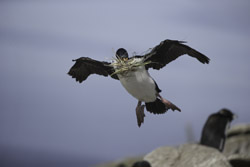
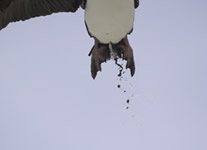
Day 9. Saunders to Sea Lion Island
We were lucky to get the first FIGAS flight to Sea Lion Island, often (perhaps erroneously) considered THE island to visit in the Falklands. We left Saunders in nearly gale-force winds and arrived in minimal visibility at Sea Lion Island. The weather was very poor, and we decided to wait until after lunch to head out to brave the elements.
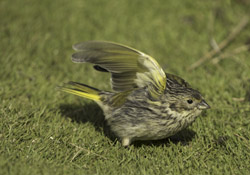 After lunch, with the weather slightly improving, we headed to the Elephant Seal beach. Nothing was happening except for some sleeping subadult male Elephant Seals, wandering Kelp Geese, and Black-chinned Finches flitting ahead of our path. We continued through the red grasses, passing Ruddy-headed Geese, Brown Skuas, and Steamer Ducks on the way to the Gentoo beach. The weather still was unfavorable and rainy and we did very little shooting, but after dinner the weather broke and for the next two hours, in mostly sunny conditions that continued until nearly sunset, we photographed Gentoo Penguins surfing in to the beach.
After lunch, with the weather slightly improving, we headed to the Elephant Seal beach. Nothing was happening except for some sleeping subadult male Elephant Seals, wandering Kelp Geese, and Black-chinned Finches flitting ahead of our path. We continued through the red grasses, passing Ruddy-headed Geese, Brown Skuas, and Steamer Ducks on the way to the Gentoo beach. The weather still was unfavorable and rainy and we did very little shooting, but after dinner the weather broke and for the next two hours, in mostly sunny conditions that continued until nearly sunset, we photographed Gentoo Penguins surfing in to the beach.
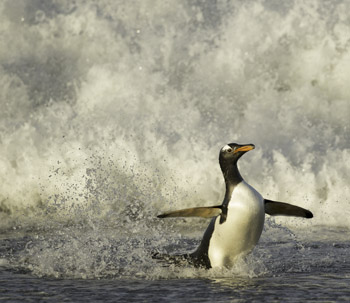
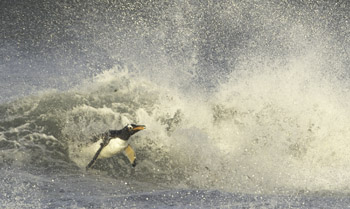
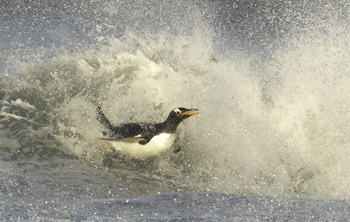
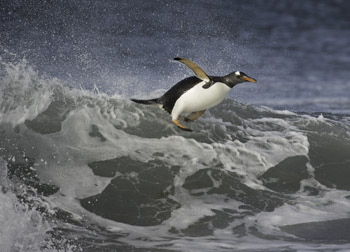
Day 10. Sea Lion Island
We had planned on being out at dawn, but the weather was murky with poor light, and so we passed, and in doing so missed the four Orcas that cruised along the Elephant Seal beach at 7AM. The shots were just of their backs and fins, so we didn’t miss a spectacular shot, but it’s always nice to see whales.
After breakfast, under cloudy skies, we did a circuit similar to yesterday, photographing Skuas, Ruddy-headed Geese, and a large subadult Elephant Seal that presented interesting patterns with the skin folds it created as it wiggled about in the sand. A significant cold front was supposed to arrive, according to the weather satellite forecast, but we still planned on visiting the Gentoo beach at 3PM to catch the birds returning from the sea. Judy, Don, and Eric got out promptly at 3, but I was delayed, and by the time I stepped out, around 3:30, a dark wall of clouds was blowing in from the south. This was supposed to be the cold front, and as the rain began, Don and Eric returned to the lodge. I walked down to the beach to see if Judy needed help with her gear but she decided to stay and try for penguins, and by the time I returned to the lodge the rain had nearly stopped. The skies actually cleared, and Mary and I returned to the beach at 5 (we should have left earlier – my fault) for an hour of shooting. The sky clouded up again but we left for the beach anyway, and shot Gentoos until nearly 9, and although we used progressively higher ISOs, we did manage some nice shots. Eric and Mary joined me, while Judy, after having a very rewarding mostly sunny afternoon at the beach, stayed behind with Don and Marshall. Tomorrow might be interesting … originally the weather forecast was ‘winter’ conditions, with snow, hail, and generally miserable weather predicted.
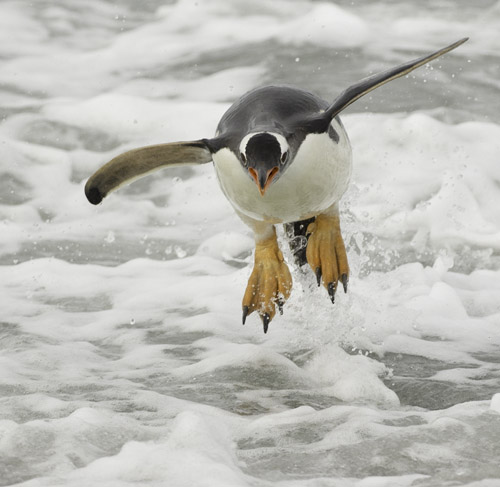

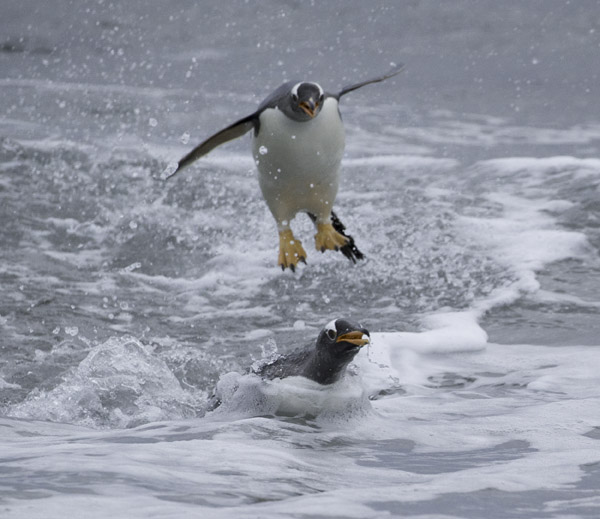
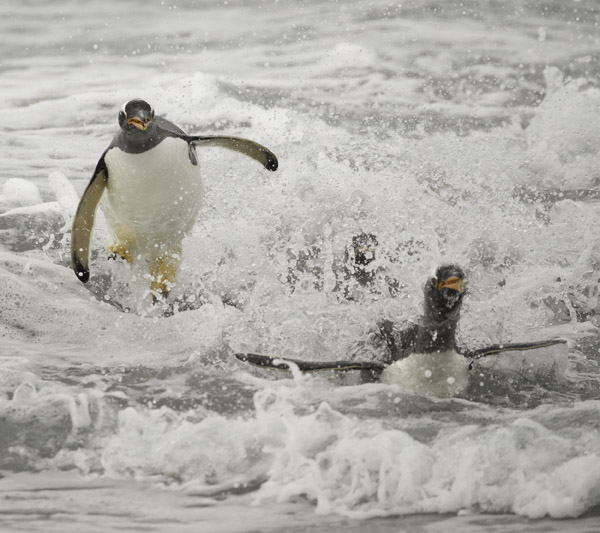
Day 11. Sea Lion Island
The weather prediction was correct. Winter hit the Falklands today. Throughout the night hail pelleted our windows, as did rain, but by dawn the skies were clear. We didn’t go out before breakfast, although one of the workers here did, and saw the Orcas far up on the north beach, further along the beach than we’d have though to look. Our plan for the day was to be driven to the Rockhopper Penguin and King Cormorant Colony at the southeast end of the island, and to be left off there for two hours before being picked up before lunch. We did have our drive to the colony, passing by Silvery Grebes that hugged the shoreline and reeds for shelter because of the high winds, and we continued on to the war memorial and the colonies. The Rockhopper colony here is famous for its incredibly steep and treacherous cliff that the birds must negotiate to climb up to the colonies. Today, however, the winds were so strong from the south that the surf smashed high against the cliffs, sending salt breeze out on the breeze, directly to us and coating us in a salty wetness. Between the incredibly high winds and the continuous salt spray, shooting here was impossible, and we quickly abandoned that idea and drove back to the lodge. This year, although the Cormorant colony is on top of the cliff, an easy 75 feet above the sea, the colony was washed away by waves. Looking down at the turbulent water below, it just seemed inconceivable that a wave could be so high, but this happens every year.

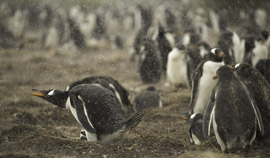
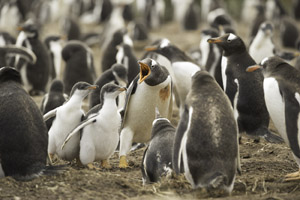
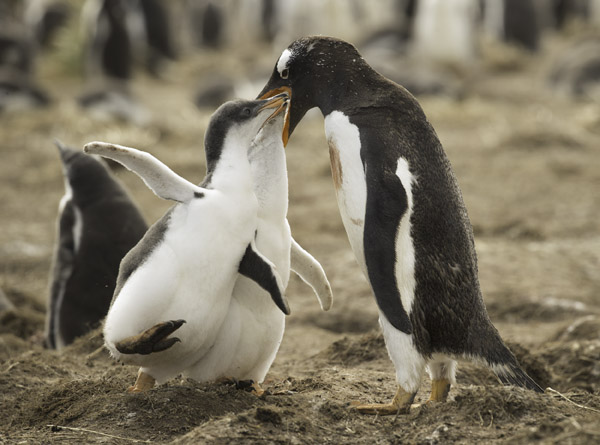
We returned to the lodge, and waited for a turn in the weather which seemed only to get worse. We had had some snow on our drive earlier in the day, and we hoped that another snow front would pass through, giving us a chance to film the Gentoo Penguins in snow that nest close to the lodge. We were lucky, snow fronts arrived twice, coating the birds in white with the hail and the ice. Ironically, only about three weeks ago Mary and I were in Antarctica, and there we had NO opportunities to photograph penguins in a snowstorm!
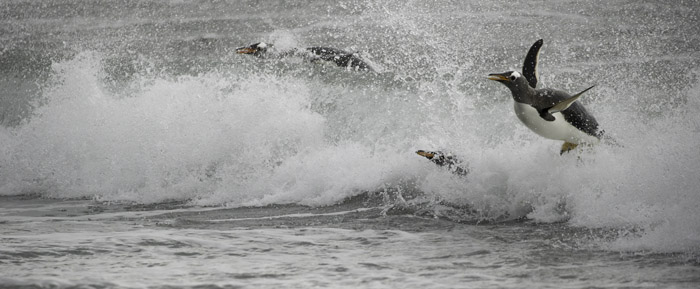
We worked inside through the early part of the afternoon, and headed back to the Gentoo beach at 4. Mary, Eric, and I opted for a packed lunch/dinner, so that we could stay out past dinner time to shoot birds in great evening light. From 6:15 onward the birds were coming in fast and furious, and we were doing some very productive shooting but it was cold, and we’d been shooting for over two hours in a steady, biting wind, when, behind us, another front advanced. The sky was black, and we knew that for a while at least we’d suffer through more rain, hail, sleet, or snow and have no light, and so, at 7PM we packed up and headed back to the lodge in a driving hail storm. We arrived only about 20 minutes late for the ‘formal’ dinner, and joined Marshal, Don, and Judy at dinner as they finished up. While we ate our packed dinner bags, just as the two snow storms had earlier in the day, this storm also passed, and with it the skies cleared, and the beach was bright with sunshine. It appeared as if we’d have about an hour of good light (and we would have, had we remained on the beach and endured the squall), but we passed on trying to shoot again. Within an hour clouds blocked the good light once more, and an hour later more rain and hail was smacking against our windows. We were done for the day.
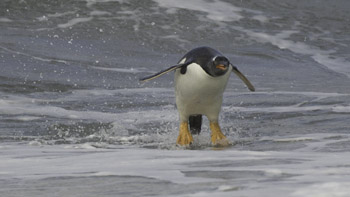
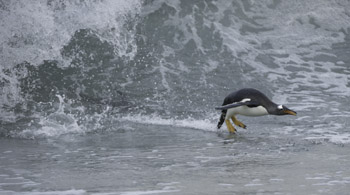
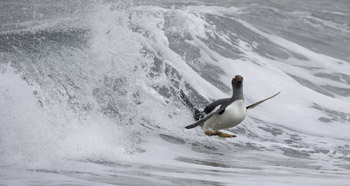
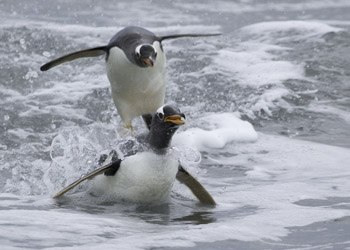
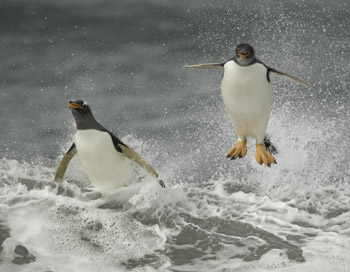
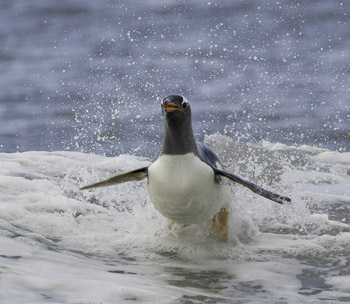
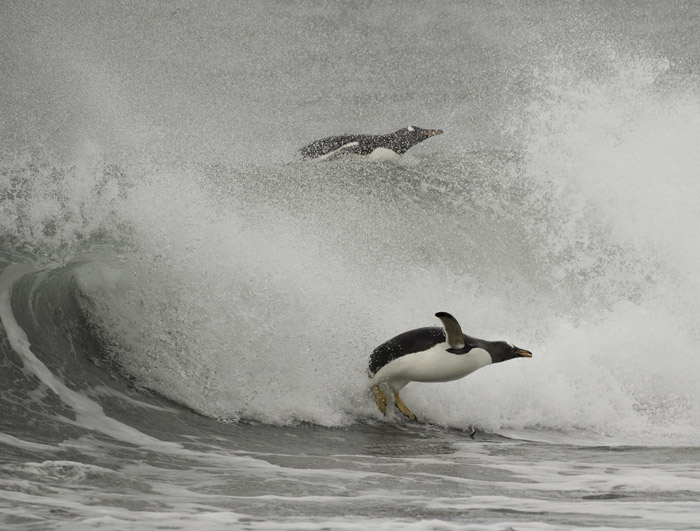
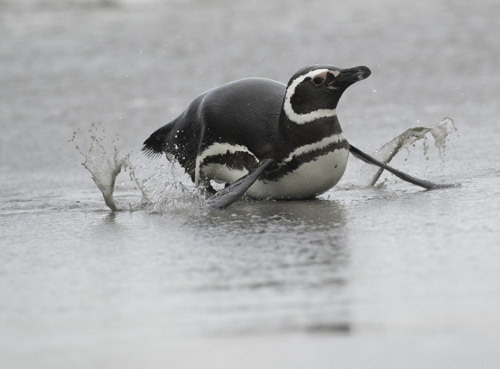
Day 12. Sea Lion Island to Stanley
The morning dawned cold and windy once again, and with two scheduled departures – Mary, Judy, Don and I for a 11:40 flight while Eric and Marshall had a 3:30PM flight. This change was due to the smaller plane FIGAS was using. We arrived at Stanley and the Malvinas Hotel for lunch, and had the rest of the day free, which we used to either catch up on email and business (Mary) or to edit or sleep (me!). Everyone met up for dinner, a ‘full board menu’ which was surprisingly good – no expense spared, really, with a lamb dish at 18 pounds. With the cold and the wind Eric and Marshall remained inside at Sea Lion, so everyone had some rest for the next day’s excursion.
Day 13. East Falklands
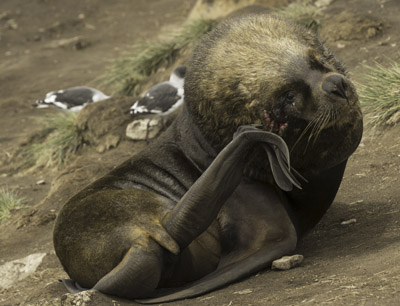 We left at 8AM for a special excursion to a Rockhopper Penguin and King Cormorant colony, and a haul out area for Southern Sealions. On our last trip here, in 2014, the weather was perfect, and the Rockhoppers performed wonderfully. This year, the colony of Penguins had only a few adults present, but we did have plenty of half-grown, and very sodden, wet chicks clustered in creches. There was virtually no wind, so the seas were calm and the Cormorants, although they do not need wind for flight, were rather sedate and few were flying. It was raining heavily when we arrived, so I left my camera behind and with Mary and Judy did a recon to check on the colonies, and afterwards I hiked out to one of the headlands to look for Peregrine Falcons.
We left at 8AM for a special excursion to a Rockhopper Penguin and King Cormorant colony, and a haul out area for Southern Sealions. On our last trip here, in 2014, the weather was perfect, and the Rockhoppers performed wonderfully. This year, the colony of Penguins had only a few adults present, but we did have plenty of half-grown, and very sodden, wet chicks clustered in creches. There was virtually no wind, so the seas were calm and the Cormorants, although they do not need wind for flight, were rather sedate and few were flying. It was raining heavily when we arrived, so I left my camera behind and with Mary and Judy did a recon to check on the colonies, and afterwards I hiked out to one of the headlands to look for Peregrine Falcons.
I saw no falcons, and in a light rain I decided to sit on slope leading to the 100 foot cliff and enjoy a Turkey Vulture that was perched nearby. While I watched that bird another vulture flew in, perching quite close to me. This bird’s head was truly a vivid red, and I wished I’d have had my camera along as the rain had stopped and the birds were close. Far below me from my perch on the cliff I spotted a seal in the surf that appeared to be playing, circling a rooted stand of algae, ducking beneath the swaying plant, turning on its back and lazily swimming about. As I watched, I realized I was watching a completely new seal, a Leopard Seal, that are rarely seen here. The view was very clear, with the dorsal surface of the seal a darker gray and the belly a light gray, clearly defining the dorsal/ventral surfaces of a Leopard Seal. I didn’t have binoculars so I couldn’t see spots, but even at this distance the brick-shaped head seemed evident. When I returned to the Port-a-Cabin where we were sheltered from the rain I asked our two drivers, Tony and Carrot, what colors various seals had, asking about the colors and patterns of Sealion males and females, and cow Elephant Seals. None of those colors or patterns matched what I had seen, of course, and when I described what I saw, they too agreed that it was a Leopard Seal. Carrot, now a white-haired fifty-year old who received his nickname from the bright red hair of his youth, said he’d thought he’d seen a Leopard Seal before Christmas in this area, confirming my id, if that indeed was needed.
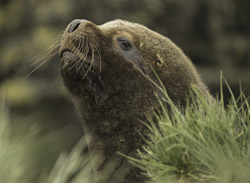
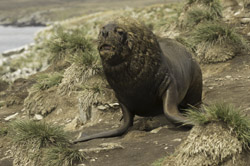
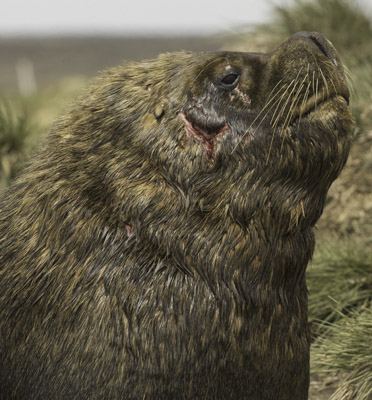
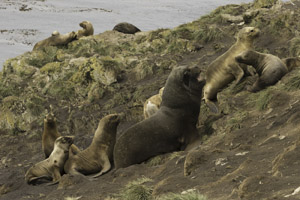 The rain finally stopped, and Mary and Judy climbed down the rocks to a tidal pool where Rockhoppers often swam and where we did a lot of our shooting last year. Activity was slow and I didn’t stay long. They remained, and they did see a Killer Whale and calf out beyond the algae beds, but otherwise the shooting was minimal. Eric joined me in a long, careful stalk towards the hauled-out Sealions that were resting on top of the cliffs. When we first arrived at this location earlier in the day the large males were scattered far inland amongst the tussock grasses, but the herd soon moved off and settled closer to the cliff and the slopes leading to the sea. It was this group that we approached. We crawled on hands and knees, or side-slid, bringing our feet forward, picking up our tripods and moving them forward an arm’s length, then lifting hips and butts to advance another half foot or so. Advancing in this way, we kept a low profile, and the Sealions were unconcerned. Our first objective was the nearest male, who was at the edge of the tussock grass and then humped his way down to the clear shale bank that was fairly close to us. Another bull chased him, and he moved up so near to us that we were within fifteen feet, or less of this young bull, and we raised our profiles higher to make our presence known, which stopped the Sealion from advancing further. Several times, obviously curious about us, the Sealion would raise his head above the tussock and peer at us, and in doing so provided some true frame-filling shots.
The rain finally stopped, and Mary and Judy climbed down the rocks to a tidal pool where Rockhoppers often swam and where we did a lot of our shooting last year. Activity was slow and I didn’t stay long. They remained, and they did see a Killer Whale and calf out beyond the algae beds, but otherwise the shooting was minimal. Eric joined me in a long, careful stalk towards the hauled-out Sealions that were resting on top of the cliffs. When we first arrived at this location earlier in the day the large males were scattered far inland amongst the tussock grasses, but the herd soon moved off and settled closer to the cliff and the slopes leading to the sea. It was this group that we approached. We crawled on hands and knees, or side-slid, bringing our feet forward, picking up our tripods and moving them forward an arm’s length, then lifting hips and butts to advance another half foot or so. Advancing in this way, we kept a low profile, and the Sealions were unconcerned. Our first objective was the nearest male, who was at the edge of the tussock grass and then humped his way down to the clear shale bank that was fairly close to us. Another bull chased him, and he moved up so near to us that we were within fifteen feet, or less of this young bull, and we raised our profiles higher to make our presence known, which stopped the Sealion from advancing further. Several times, obviously curious about us, the Sealion would raise his head above the tussock and peer at us, and in doing so provided some true frame-filling shots. 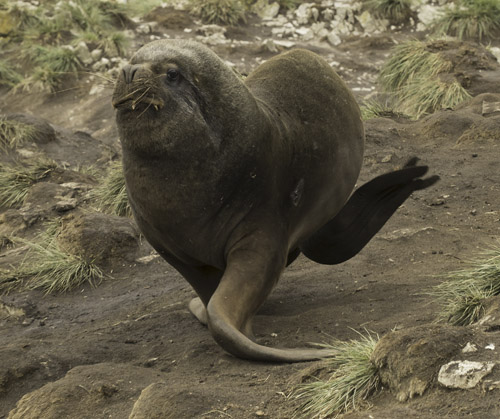
Fortunately the Sealion bull was below us, and any aggressive act on his part would have required the Sealion to climb uphill, giving us a little bit of time to get away. I warned Eric that these animals are extremely dangerous, and are capable of galloping along faster than most people can run. The reason for that might be that they just slide or smash across rocks or tussocks, whereas the pursued human has to run around the obstacles or carefully tread through them to avoid tripping. I told Eric I wasn’t worried, since I could run faster than him. Actually, the curious bull posed no threat, but three other bulls nearby were another matter. One seemed to be the harem master on the beach, and eventually drove our friendly bull further down the cliff slope and out of our camera range. Another bull was really torn up from fights, with a huge gash on either side of its cheeks just below the eyes. I was a bit worried that this one, perhaps a sore loser from recent fights, might be more aggressive but he was not. Instead, even when fairly close, he directed all of his attention either to the cows nearby or the other bulls. Mary eventually joined us, and got some nice shots of the bull scratching and a bull chasing another, but soon the entire herd settled down to sleep and Mary and Eric headed out. I remained, while Mary returned with some snacks for me, announcing she was going to look for the Leopard Seal. With no further activity, I crawled back out of the Sealions view, and I joined her in the search, but the seal was gone. Instead, we spent the final half hour of our day huddled behind a cut bank to avoid a hail storm that blew in. Meanwhile, Judy visited the Sealions, and they awoke once more, and she caught a sequence of two of the males fighting, before one looked like it was about to charge her and she retreated in a driving rain. We loaded the vehicles in the rain, but by the time we neared Stanley, after passing through several squalls, the weather improved and the skies had cleared.
Day 14. Volunteer Point , East Falklands
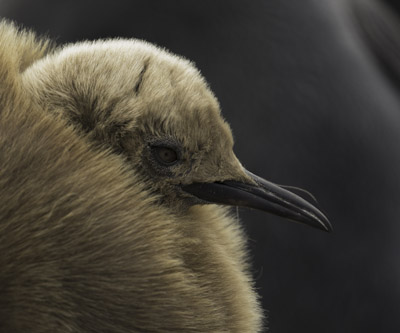 Mercifully, the skies cleared today but a fearsome wind continued, and remained throughout the day. We had two new drivers who added new perspectives to our views of the Falklands, and who took a bumpy, winding route across the diddle-dee and grasses on the way to the colony. When we arrived at the King Penguin colony the wind was gusting, and continued to do so all day, sometimes perhaps reaching 45mph. We trudged head-down across the flats, fighting the wind and the airborne grit, and I settled on the side of the colony where the wind only hit my back. Judy and Don were
Mercifully, the skies cleared today but a fearsome wind continued, and remained throughout the day. We had two new drivers who added new perspectives to our views of the Falklands, and who took a bumpy, winding route across the diddle-dee and grasses on the way to the colony. When we arrived at the King Penguin colony the wind was gusting, and continued to do so all day, sometimes perhaps reaching 45mph. We trudged head-down across the flats, fighting the wind and the airborne grit, and I settled on the side of the colony where the wind only hit my back. Judy and Don were 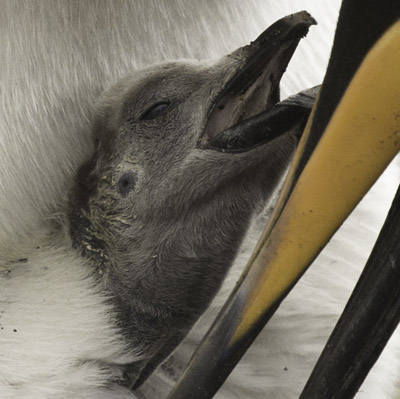 further down along the colony and they were in the wind, but they were rewarded by a King chick that was visible, huddled below its parent. I wasn’t seeing much at my position but I decided to stay and see what would happen, but when nothing did I moved a bit further along the colony edge where I glimpsed an egg as the adult pulled back the thick fold of belly skin that hid, and warmed, the egg.
further down along the colony and they were in the wind, but they were rewarded by a King chick that was visible, huddled below its parent. I wasn’t seeing much at my position but I decided to stay and see what would happen, but when nothing did I moved a bit further along the colony edge where I glimpsed an egg as the adult pulled back the thick fold of belly skin that hid, and warmed, the egg.
There were several adults on eggs rather close to the colony edge so I started another vigil, and eventually I noticed one adult with a fold that looked somewhat different, as if the feathers had been pushed out further. Eventually the adult unfurled the fold, lifting the 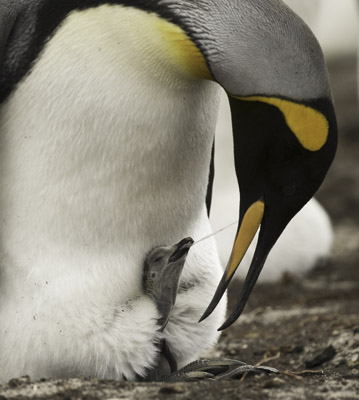 flap and revealing a little chick resting on its feet. The chick started peeping, and the adult began to work its beak around the chick, who responded by elevating its head/beak and soliciting a meal. The adult bent down to feed the chick, but nearly every time it did so another penguin, behind it, pecked the adult’s back, and the bird, instead of feeding, would rear back, turn its head, and parry with its bill at this annoying neighbor. This happened repeatedly, enough that I went from some wry amusement at this teasing to a growing sense of annoyance, as the adult was repeated prevented from feeding the chick. Sometimes the adult would be in the process of regurgitating some food, and in recoiling, the bird had to lift its head and swallow, trying to retain valuable food from spilling.
flap and revealing a little chick resting on its feet. The chick started peeping, and the adult began to work its beak around the chick, who responded by elevating its head/beak and soliciting a meal. The adult bent down to feed the chick, but nearly every time it did so another penguin, behind it, pecked the adult’s back, and the bird, instead of feeding, would rear back, turn its head, and parry with its bill at this annoying neighbor. This happened repeatedly, enough that I went from some wry amusement at this teasing to a growing sense of annoyance, as the adult was repeated prevented from feeding the chick. Sometimes the adult would be in the process of regurgitating some food, and in recoiling, the bird had to lift its head and swallow, trying to retain valuable food from spilling. 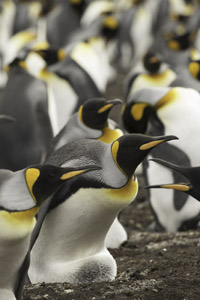 There were enough lapses in the harassment that the adult did manage to feed the chick several times, who was finally full and eventually stayed hidden inside the skin fold despite the adult’s probing beak seeking it out.
There were enough lapses in the harassment that the adult did manage to feed the chick several times, who was finally full and eventually stayed hidden inside the skin fold despite the adult’s probing beak seeking it out.
The actual feeding consisted of the adult lowering its head (I use it because I couldn’t determine sex) and touching the chick’s beak. The skin fold would rise sufficiently for the chick to stick out its beak, and then the chick’s entire head and neck, while the adult would open its beak. The chick would stick its open beak inside, and food would be transferred, at least when the pesty neighbor didn’t interfere and cause the adult to fight back. The actual feeding took only five or six seconds, with sometimes a minute or more before another feeding would be attempted.
Eventually my chick was full and the colony settled down. I was looking for an adult incubating an egg that would be visible to photograph, but the eggs stayed covered and the action appeared to be over.
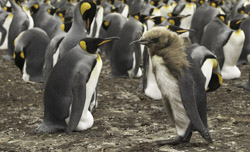
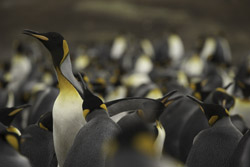
I moved on, finally grabbing a late lunch inside the Land-Rover to escape the wind. Judy, Don, and a new friend from Switzerland went down to the beach and had some great shooting of birds on the beach, slapping through tide-wet sands, all the while fighting the wind and blowing sand. Julian, the Swiss guy, had camped here, and the day before, in between rains, had captured some wonderful shots of penguin flocks reflected in the sand, and, with a wide-angle, a cloudy, troubled sky above. They were very nice shots.
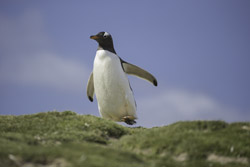 Instead, I headed to the Gentoo colonies, hoping to photograph chicks chasing adults but nothing was happening and, after a short wait, I moved on, thinking about hitting the beach as well. Along the way I entered a small ravine where I was sheltered from the wind and where three partially-eaten Gentoo chicks were lying. I positioned myself there, and soon had two Turkey Vultures fly in to feed. They didn’t stay long, but these birds were soon replaced by a small parade of Gentoos returning from the sea. By moving slightly, I had a great but very brief window of opportunity to photograph Gentoo Penguins walking right along the hill’s crest, framing the birds completely against either a blue or a cloudy sky. I stayed here until Don and Judy returned from the beach, and with all of us beaten by the wind, we headed towards home by 4PM.
Instead, I headed to the Gentoo colonies, hoping to photograph chicks chasing adults but nothing was happening and, after a short wait, I moved on, thinking about hitting the beach as well. Along the way I entered a small ravine where I was sheltered from the wind and where three partially-eaten Gentoo chicks were lying. I positioned myself there, and soon had two Turkey Vultures fly in to feed. They didn’t stay long, but these birds were soon replaced by a small parade of Gentoos returning from the sea. By moving slightly, I had a great but very brief window of opportunity to photograph Gentoo Penguins walking right along the hill’s crest, framing the birds completely against either a blue or a cloudy sky. I stayed here until Don and Judy returned from the beach, and with all of us beaten by the wind, we headed towards home by 4PM.
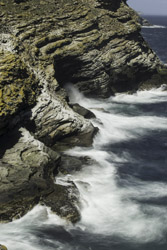
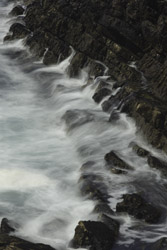
Along the way home, my driver mentioned another Rockhopper Penguin colony that was located on her farm, and after dropping off everyone at our hotel she drove me to her farm to check out the new colony. It was an hour’s ride across rough country, and after 6 hours of this cross-country riding (to and from Volunteer Point) I questioned my sanity in doing this scouting. It proved worthwhile, as there were three colonies fairly close to one another, set against a beautiful cliff with a variety of colors and textures, from green slopes of moss to rock cliffs with fuzzy, gray lichen threads, and rocks covered in an orange wash of a different lichen species. The view to the sea was spectacular, but scary, as the overlooks were often directly at the edge, with a roiling sea over 100 feet below. After a 15 minute recon we headed to home, another hour drive, and for me an arrival back at the lodge at 9PM. Mary had ordered a dinner for me and I ate in the room, dirty and exhausted, and ending our field time in the Falklands.
Day 15. Stanley to Mount Pleasant Airport
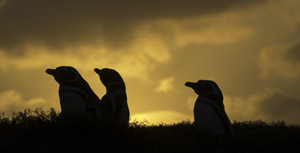 Ironically, we awoke to clear skies and no wind, the best day we’ve seen for nearly the previous eight. Our group boarded a bus for the hour long commute, arriving in time to endure the long line getting into the customs and lounge. This leg, and the security that borders on nonsensically extreme, is the most difficult part of the entire journey.
Ironically, we awoke to clear skies and no wind, the best day we’ve seen for nearly the previous eight. Our group boarded a bus for the hour long commute, arriving in time to endure the long line getting into the customs and lounge. This leg, and the security that borders on nonsensically extreme, is the most difficult part of the entire journey.
A final note. When we arrived in Puenta Arenas, on our drive from the airport in to town, I saw my first Lesser Grisson, a member of the weasel family. The Grisson resembles a cross between a Honey Badger and an Otter, or a slender Wolverine, with a bristly-looking gray-white cape that extends from its head to its rump, and a dark, blackish body, giving it a color pattern most resembling a Honey Badger. Seeing this was a thrill, and quite ironic, since we’ve spent weeks, maybe months, in Grisson habitat over the years, and never saw one, until this Grisson, on a highway on the outskirts of a town.
While this trip saw truly record cold temperatures for the Falklands in January, with terrible winds at times, stormy skies, pounding hail, and frequent soakings, we did extremely well in our shooting, and ultimately have absolutely no complaints. In fact, we’ve already booked some of the locations for our next trip, in December of 2017. Join us.
Refer to our BROCHURE to get an idea of next year's trip! The brochure has not yet been updated for our 2017 trip, but the itinerary will be similar. If you are interested, please contact us. We will be doing this in early December of 2017, so the Rockhopper Penguin and Gentoo Penguin chicks will be very small, and the Albatross chicks should just be hatching.
You do not need to have big lenses for great bird photography for this trip. We used the new Canon 100-400 for most of my shooting, and a 16-35mm wide-angle for our close-ups and scenics. A Polarizing Filter and a Variable Neutral Density Filter were the only other gear we needed. I carried a flash, but I didn't have it along on the one day, with Albatrosses, that it may have come in handy. I used an F-Stop backpack for this trip. To get to gear, you go from the back -- the out-facing part of the pack rests on the ground. We used Hoodman Cards up to 64gb, and Hoodman loupes, at times, for checking videos.
Trip Report:
Falkland Islands
Birds and Wildlife
Trip Report
2016
 The folds of a skin on an Elephant Seal hauled out on the beach at Sea Lion Island.
The folds of a skin on an Elephant Seal hauled out on the beach at Sea Lion Island.
 A rare summer snowstorm at Sea Lion Island at a Gentoo Penguin colony.
A rare summer snowstorm at Sea Lion Island at a Gentoo Penguin colony.
 The moment of impact when a Striated Caracara grabbed a Rockhopper Penguin chick at the Neck at Saunders Island. Scroll down to read the details and to see more images.
The moment of impact when a Striated Caracara grabbed a Rockhopper Penguin chick at the Neck at Saunders Island. Scroll down to read the details and to see more images.
The Falkland Islands has always been one of our favorite wildlife photography destinations, and has often been called the Galapagos of the South Atlantic. And for good reason, but the Falklands actually offers even better photography than that iconic destination. In the Falklands, you are not pressured to keep some tour deadline, or limited to particular viewing areas or locations. Most of the islands are privately owned and quite often, at the best shooting spots, you (and your group) are the only ones there at the time. Consequently, you can devote as much time as you wish on a particular subject, allowing you to capture incredible images and record striking behavior.
 This was our second trip to the Falklands since the digital age, when we visited the Falklands in December-January of 2013-2014. Prior to that, back in the film days, we would spend as much as six weeks here, but after three or four years of annual trips, with our film library stuffed with images, we moved on to other destinations, and visited the Falklands only when we were doing an Antarctic trip where the Falklands was a brief stopover on the itinerary. Those visits, although satisfying, never did the islands justice, and we knew we had to return. Now, the Falklands is a trip we do every other year, and we're already planning our next trip for 2017, and we can't wait to get back.
This was our second trip to the Falklands since the digital age, when we visited the Falklands in December-January of 2013-2014. Prior to that, back in the film days, we would spend as much as six weeks here, but after three or four years of annual trips, with our film library stuffed with images, we moved on to other destinations, and visited the Falklands only when we were doing an Antarctic trip where the Falklands was a brief stopover on the itinerary. Those visits, although satisfying, never did the islands justice, and we knew we had to return. Now, the Falklands is a trip we do every other year, and we're already planning our next trip for 2017, and we can't wait to get back.
This year, we experienced the whole gamut of seasons -- summer and winter -- in a two weeks span, enjoying balmy, sunny days at the beginning of the trip and record low temperatures, with snow and hail and near hurricane force winds, at the end of the trip. While our productivity would undoubtedly been even higher had we had clement weather every day, we did extraordinarily well, as you'll see from this report.
 Gentoo Penguins surfing in to the beach on their way to one of several large breeding colonies -- this one on Sea Lion Island.
Gentoo Penguins surfing in to the beach on their way to one of several large breeding colonies -- this one on Sea Lion Island.
We will be offering a FREE Ebook shooting guide on tips to photographing the birds and wildlife in the Falklands. It will be available to everyone on our Constant Contact mailing list and also our personal email contacts via our office. If you'd like a copy, get on our list and we'll send you the ebook (or the download link) as soon as we have this completed.
Port Howard, Gladstone
.jpg) Day 1 of being in the field. I’m writing this at Port Howard, West Falklands, after our first afternoon in the field, and after a rather eventful journey to arrive here. We had arrived in Puenta Arenas, the southernmost major city in Chile, on Dec. 31st, giving us some ‘grace period’ if flights were delayed or cancelled for our flight to the Falklands. Miss that flight and you won’t have another until the following Saturday, so it isn’t a flight you want to miss. New Year’s Eve, for us, was a non-event, but the following day was a challenge in finding a restaurant that was open on the New Year’s Day holiday. The following day, Jan. 2, we arrived at the airport early for the one-day-a-week flight to the Falklands, only to learn that the flight was cancelled due to high winds on the islands. The following hours were rather hectic and frustrating, as we spent most of the day at the airport, waiting for word on lodging and transportation into town. LAN Chile’s representative did a great job getting rooms for the 100 plus passengers, something we didn’t feel a US carrier would have done since the flight cancellation was due to weather and not because of mechanical issues, and therefore would be an act of God in the US excuse book.
Day 1 of being in the field. I’m writing this at Port Howard, West Falklands, after our first afternoon in the field, and after a rather eventful journey to arrive here. We had arrived in Puenta Arenas, the southernmost major city in Chile, on Dec. 31st, giving us some ‘grace period’ if flights were delayed or cancelled for our flight to the Falklands. Miss that flight and you won’t have another until the following Saturday, so it isn’t a flight you want to miss. New Year’s Eve, for us, was a non-event, but the following day was a challenge in finding a restaurant that was open on the New Year’s Day holiday. The following day, Jan. 2, we arrived at the airport early for the one-day-a-week flight to the Falklands, only to learn that the flight was cancelled due to high winds on the islands. The following hours were rather hectic and frustrating, as we spent most of the day at the airport, waiting for word on lodging and transportation into town. LAN Chile’s representative did a great job getting rooms for the 100 plus passengers, something we didn’t feel a US carrier would have done since the flight cancellation was due to weather and not because of mechanical issues, and therefore would be an act of God in the US excuse book.
The following day we successfully flew to the Falklands, arriving around noon, where we again waited at the Mt. Pleasant airport for our flight to a new destination for us, Port Howard, on the West Falkland mainland. We hadn’t had lunch, and walked to the commissary for a snack while we waited for our FIGAS flight, only to find that the store was closed on Sundays. Although we had  sufficient time at the airport we were rushed in separating what we had planned to leave in Stanley and what we’d take on the FIGAS planes (where you pay for extra luggage), and everyone kept things they’d have packed. The rush was due to our transportation company who was waiting for our gear, while another photo group was waiting for that driver to finish with us in order to get to Stanley, for their day trip to Volunteer Point and the King Penguins there.
sufficient time at the airport we were rushed in separating what we had planned to leave in Stanley and what we’d take on the FIGAS planes (where you pay for extra luggage), and everyone kept things they’d have packed. The rush was due to our transportation company who was waiting for our gear, while another photo group was waiting for that driver to finish with us in order to get to Stanley, for their day trip to Volunteer Point and the King Penguins there.
Although the store was close, Mary and I had left-overs from a Chinese meal the night before so we had something to eat, but still, all of us were hungry by the time we boarded a FIGAS plane for the 35 minute trip to Port Howard. En route, I used my Amazon Fire to shoot some aerials of the stone rivers that are a distinctive feature of the islands, regretting that I forgot that that device had a camera feature, and when we flew over the Andes I had incredible views of Mt. Fitroy but I didn’t take any photos.
Port Howard is one of the larger ‘camp’ settlements outside of the Falkland’s only major town, Stanley, and we were excited about visiting this new location. Our hosts, Sue and Wayne, who now own the tourist lodge (Sue started there as a maid!), were wonderful and very accommodating, and after a snack and sandwiches, we drove nearly an hour to a beautiful Gentoo Penguin rookery, set on a plateau and framed by distant hills – mountains down here, giving the location a completely different look from our other locations where we normally film Gentoos. We drove right up to the colony, where I spent the remainder of the afternoon, concentrating on mothers with chicks, incubating the chicks or feeding them. It was a warm day and there were a surprising number of flies in the air. One bird had scores of flies scrambling over its feathers, and we wondered if there was a dead chick beneath it. At one point, when there was little wind and I was fairly close to the birds, I could hear them breathing, a sighing-groaning sound that I’ve never
.jpg)

heard before. Mary, Don and Judy, and Eric hiked down to the bay to catch Gentoos as they emerged from the bay, and had some luck with birds porpoising and skipping out of the sea. Additionally, various gulls, geese, caracaras, and ducks were always in view along the bay, making for a visually diverse afternoon.
At dinner, we were a bit surprised. We were served a beautiful cut of tooth fish, extremely mild, and although quite tasty we thought it was the main course, and the portion wasn’t nearly enough to satisfy a hunger after a day afield. I asked if there were seconds – there was none, and I put my mind into figuring I’d lose weight when Sue walked in to the dining area with the main course, a heaping plate of great tasting lamb, potatoes, broccoli, and cabbage, followed by an apple crumb and cream dessert – leaving us stuffed, not famished, for our first day in the Falklands.
Day 2. White Rock, Port Howard
 A mild sea fog partially obscured the early morning sky but by the time we headed out, around 8:15, the fog was centered in the west, and our eastern skies were sunny and clear. The Land-Rover ride to White Rock is one of the longest we’ve made in the Falklands, taking nearly three hours, passing from a government maintained road to a camp-maintained road, to dirt tracks, to tire tracks, to bush-whacking cross country, including one stint where we drove up one of these unique stone rivers or stone runs, as the locals call them, that had been graded, somewhat. That was the most interesting aspect of the drive, giving us an opportunity to truly be in the heart of one of these unique geologic feature. The rocks, and no one really knows how this happened, are piled in cascading flows from the ridges, resembling streams or glacial runs. Many are set at various angles, including some nearly plywood-thin rock slabs that nearly vertically, and most are dappled in pale lichens.
A mild sea fog partially obscured the early morning sky but by the time we headed out, around 8:15, the fog was centered in the west, and our eastern skies were sunny and clear. The Land-Rover ride to White Rock is one of the longest we’ve made in the Falklands, taking nearly three hours, passing from a government maintained road to a camp-maintained road, to dirt tracks, to tire tracks, to bush-whacking cross country, including one stint where we drove up one of these unique stone rivers or stone runs, as the locals call them, that had been graded, somewhat. That was the most interesting aspect of the drive, giving us an opportunity to truly be in the heart of one of these unique geologic feature. The rocks, and no one really knows how this happened, are piled in cascading flows from the ridges, resembling streams or glacial runs. Many are set at various angles, including some nearly plywood-thin rock slabs that nearly vertically, and most are dappled in pale lichens.




We arrived at a Rockhopper Penguin rookery by 10:30, in light that at that point in the day was marginal – too bright and too much contrast for the moment, as the birds facing us were backlighted. We were also surprised by the size of the Penguin chicks. They were nearly half-grown, and most were collected in creches. A few King Cormorants nested on elevated mud platforms within this penguin colony, and these cormorants, or their nests, oddly enough, became the focal point for many of the young penguins. Perhaps they huddled there for protection, as King Cormorants can poke fiercely when disturbed, and thus the chicks might have some shelter from Skuas and Striated Caracaras.
Turkey Vultures sailed back and forth along the cliff face, with many stopping and feeding on penguin chick carcasses, their normally reddish heads now bright red with, I assume, gore. A Variable Hawk, formerly known as a Red-backed Hawk, took flight from a nearby rock, screaming in protest, and landed on a sea stack across a small ravine. I looked for a nest but I found nothing. A bleating lamb did catch my attention, the lamb standing near its mother who was on her side and facing uphill, kicking frantically with her legs. I’ve heard, but didn’t know whether to believe it, that a sheep lying down with its legs pointed uphill could be trapped in this position and die. This ewe was in that dilemma, so I hiked up, grabbed her legs, and spun her so that she was out of the small depression she had been in, and now with her legs pointed downhill. She scrambled frantically to get away, but could not get to her feet, and instead she just flopped along, her legs spinning, obviously in distress. Neal, one of our drivers, later told me that sheep will flounder like this in depressions, wallows, or hills, and sometimes can be saved if they are turned and their bellies are massaged. This one, with eyes either rolled up in her head, perhaps suffering from pink eye, would certainly not make it.
All of us spent a little time simply getting familiar with the landscape and the shooting possibilities, and eventually I settled in on a steep slope where I had a  good view of the cliff top, and some passageways for the penguins. I was sitting in a location when a group of Rockhoppers hopped and walked nearby, and for the next hour or so I was shooting wide-angle views of the Penguins, just feet away. Judy crawled up to join me, and the birds were unconcerned, as more small groups arrived, passed by, and were replaced by others. It was magical.
good view of the cliff top, and some passageways for the penguins. I was sitting in a location when a group of Rockhoppers hopped and walked nearby, and for the next hour or so I was shooting wide-angle views of the Penguins, just feet away. Judy crawled up to join me, and the birds were unconcerned, as more small groups arrived, passed by, and were replaced by others. It was magical.
At 2PM we switched rookeries, visiting another nearby colony where King Cormorants were the dominant nester, although Rockhoppers were scattered about. Quite oddly, one lone King Penguin was 3/4s of the way up the sloping rock chute the Rockhoppers use to commute to the nesting area. Brown Skuas periodically darted and feinted to the edge of the Cormorant colony trying to dislodge an adult from the nest and snag a chick. At the very end of the day, when I had packed up my gear, a pair of Skuas did exactly that, pulling out a tiny black Cormorant chick and tearing it apart. A Striated Caracara later stole the chick, and was dive-bombed repeatedly by the annoyed Skua.


Mary had some great luck with the dark phase of the Variable Hawk (the male) flying by while she sat along the colony’s edge, and also with Turkey Vultures. I spent the last part of my afternoon trying to make friends with a Striated Caracara, hoping to get close-ups with a wide-angle that would include the sea and the cliffs behind. I was fairly successful, as was Mary earlier in the day.
At 4:30 we headed back to camp, a two hour ride that covered 24 miles, often with an average speed of only 8mph. We arrived by 6:30, exhausted from a long shoot and a very bouncing, rocking drive. However, Mary felt that today’s location was in the top 10 of the shoots we’ve done in the Falklands – it was good!

Day 3. Carcass Island
We were lucky to get an early morning FIGAS flight to Carcass Island, leaving at 8:45 for the 30 minute flight. We were met by our friend and the best host in the Falkland Islands, Rob McGill, who had a waiting automatic transmission SUV ready for me to drive back to the settlement. Although we had the option of driving to the King Cormorant colony that is located on the opposite side of the island from the settlement, we opted to stay around the lodge. What could have been a leisurely afternoon certainly wasn’t, as the shooting throughout the day was intense.

Before our 12:30 lunch we had headed down to the beach, which was seeing a low tide, where I worked on a family of Patagonian Crested Ducks. A hen and drake sat on either side of a flat rock with five or six fuzzy chicks resting in between, cute little ducklings and the smallest I’ve had a chance to photograph. Mary worked on feeding Magellanic Oystercatchers. We were quite close to both subjects. After lunch, I headed back to where I’d seen a Grass Wren earlier, and found three  yellow-beaked fledglings and at least one adult who came in to feed. At one point, when I was attempting to take off my jacket on this very warm and sunny afternoon, and with both of my arms effectively pinned back by the jacket behind my back, the Wren hopped out, quite close, and straddled two grass stems in the classic Grass Wren pose. I wiggled and scrambled to get free of the jacket in time but I was not successful. However, as the afternoon progressed both Mary and I had numerous other opportunities, and ended up doing quite well with the birds.
yellow-beaked fledglings and at least one adult who came in to feed. At one point, when I was attempting to take off my jacket on this very warm and sunny afternoon, and with both of my arms effectively pinned back by the jacket behind my back, the Wren hopped out, quite close, and straddled two grass stems in the classic Grass Wren pose. I wiggled and scrambled to get free of the jacket in time but I was not successful. However, as the afternoon progressed both Mary and I had numerous other opportunities, and ended up doing quite well with the birds.



Grass Wren. The fledgling looks a little like a House Sparrow because of the yellowish bill, while the adult's bill is dark. These are shy birds and most easily seen at Carcass Island, one of the few cat-free islands.
 We also had great luck with Cobb’s Wren, the House Wren that is endemic to the Falklands, as well as great opportunities with Flightless Steamer Ducks, Kelp Geese, and Magellanic Oystercatchers. The Oystercatchers had a small, well-camouflaged chick in the low diddle-dee groundcover, and peeping a distinctive call they’d approach the chick and feed it the chrysalis or pupae of moths. Right after lunch, both Mary and I donned light weight, and very inexpensive, chest waders so that we could sit or kneel in the rising tidal water, and from that position we photographed Crested Ducks, Black Oystercatchers, and more Steamer Ducks. At one point, a Crested Duck female defended her chicks from a Kelp Goose male that grazed too close to her, and later, both male and female Flightless Steamer Ducks charged across the water to chase off a drake Crested Duck that had approached the Steamer Duck’s two large chicks. The Ducks churned across the water, running and flapping, and both of us were ready as the two raced by.
We also had great luck with Cobb’s Wren, the House Wren that is endemic to the Falklands, as well as great opportunities with Flightless Steamer Ducks, Kelp Geese, and Magellanic Oystercatchers. The Oystercatchers had a small, well-camouflaged chick in the low diddle-dee groundcover, and peeping a distinctive call they’d approach the chick and feed it the chrysalis or pupae of moths. Right after lunch, both Mary and I donned light weight, and very inexpensive, chest waders so that we could sit or kneel in the rising tidal water, and from that position we photographed Crested Ducks, Black Oystercatchers, and more Steamer Ducks. At one point, a Crested Duck female defended her chicks from a Kelp Goose male that grazed too close to her, and later, both male and female Flightless Steamer Ducks charged across the water to chase off a drake Crested Duck that had approached the Steamer Duck’s two large chicks. The Ducks churned across the water, running and flapping, and both of us were ready as the two raced by.  A pair of Flightless Steamer Ducks about to chase off an intruding Crested Duck.
A pair of Flightless Steamer Ducks about to chase off an intruding Crested Duck.

Magellanic Oystercatcher and chick

Blackish Oystercatcher and barnacle lichen prey


Crested Duck stretching and Flightless Steamer Duck chick


Kelp Goose male being chased by hen Crested Duck
 In all, Mary shot 1,300 images and I shot 1,750 through the day – a great shooting day, and actually somewhat leisurely, with everyone staying within a few hundred yards of the lodge for all of our photography.
In all, Mary shot 1,300 images and I shot 1,750 through the day – a great shooting day, and actually somewhat leisurely, with everyone staying within a few hundred yards of the lodge for all of our photography.
Day 4. Carcass to West Point and back
We planned to sail to West Point for Rockhoppers and Black-browed Albatross, with a 9:15 departure for the hour or so boat trip. At breakfast a rain squall splattered the windows of the lodge, and we were afraid that we might have a very bleak day but fortunately the rain only lasted a few minutes, and blue sky soon appeared in the direction we were headed. When we boarded the boat and began our trip the skies cleared, with a clear blue sky ahead that lasted most of the day.
Our boat captain, Mike and his first mate and wife, Jeanette, gave us a lift to the 

top of the ridge, to Devil’s Nose, the site of the colony. Most of the Black-browed Albatrosses and Rockhopper Penguins nest on the talus slope located between two high ridges, but birds nest right up into the tussock grass, where a trail takes one right to the very edge and almost into the colony. From that position one can photograph Albatrosses with a wide-angle, at frame-filling distances. Most of the baby Albatrosses were about 10 inches high and were a fuzzy grayish white, and if they were alone they would snap their beaks in annoyance whenever anyone was near. Those chicks that were under their mothers were content and did not snap their bills. Some of the adults looked as if they did not have chicks but they did, with the young birds hiding under the adult’s feathers and sitting on top of the parent’s wide, pale webbed feet. I had a great view of those feet when one bird left its nest and walked towards me, first nearly touching my leg with its beak, then stepping by, pausing for a moment and giving me time to do a tight shot of the feet. The bird, its head wagging from side to side in its sauntering stroll, continued on, walking up the trail I had just traveled.
 Other highlights – on the boat ride in to West Point, we spent ten minutes or so at a rock face where Southern Sealions had hauled out. The huge bull galloped across the rocks several times as he chased off smaller males, causing some to dive off the rocks and into the surf. At one point he moved into his harem, all slender, tan-colored females that seemed tiny next to him, but he soon lost interest and chased after more rivals. It was one of the best shooting opportunities we had with Sealions, but we didn’t know then what we’d later have during the trip.
Other highlights – on the boat ride in to West Point, we spent ten minutes or so at a rock face where Southern Sealions had hauled out. The huge bull galloped across the rocks several times as he chased off smaller males, causing some to dive off the rocks and into the surf. At one point he moved into his harem, all slender, tan-colored females that seemed tiny next to him, but he soon lost interest and chased after more rivals. It was one of the best shooting opportunities we had with Sealions, but we didn’t know then what we’d later have during the trip.
 Penguins, mainly Rockhoppers, porpoised along with our boat, but we did not see any Dolphins today, nor were any dolphins spotted yesterday. Mary hiked to the far end of the colony where she laid down on her belly and photographed parades of Rockhoppers leaving the upper reaches of the nesting area to continue their long trek to the sea far below. Although the day started with clear skies the weather did change throught the day, going to variable clouds, and finally to an overcast that set in, heavily and darkly, when we were about to quit. The seas had calmed considerably on the return trip, which took exactly one hour and made for an easy crossing.
Penguins, mainly Rockhoppers, porpoised along with our boat, but we did not see any Dolphins today, nor were any dolphins spotted yesterday. Mary hiked to the far end of the colony where she laid down on her belly and photographed parades of Rockhoppers leaving the upper reaches of the nesting area to continue their long trek to the sea far below. Although the day started with clear skies the weather did change throught the day, going to variable clouds, and finally to an overcast that set in, heavily and darkly, when we were about to quit. The seas had calmed considerably on the return trip, which took exactly one hour and made for an easy crossing.
Day 5. Carcass to Saunders Island
We had the first FIGAS flight from Carcass, leaving around 10AM for a 10 minute hop to our next destination, Saunders. We were greeted by two of our oldest friends in the Falklands, the owners of Saunders, David and Suzan Pole-Evans. I’ve known David since my very first scouting trip to the Falklands about 23 years ago, and always enjoy my time with David and his family.
 After lunch, I had a special treat, having the opportunity to drive one of the Land-Rovers and to follow David to one of the porta-cabins, actually a nice, small guest house, located at a Rockhopper Penguin and King Cormorant Colony. David asked me if I’d be comfortable keeping the vehicle and driving back by myself, assuring me that I wouldn’t get lost. To help in this, I used a brand new app, called My Tracks, that my friend, Mark Thomas – who co-led our Antarctica trip with Joe Van Os, told me about. The app proved invaluable, as I could literally just follow the same route back. Twice I deviated off trail, but it was clear that I was off the main route, and it was easy to regroup and get on to the correct trail.
After lunch, I had a special treat, having the opportunity to drive one of the Land-Rovers and to follow David to one of the porta-cabins, actually a nice, small guest house, located at a Rockhopper Penguin and King Cormorant Colony. David asked me if I’d be comfortable keeping the vehicle and driving back by myself, assuring me that I wouldn’t get lost. To help in this, I used a brand new app, called My Tracks, that my friend, Mark Thomas – who co-led our Antarctica trip with Joe Van Os, told me about. The app proved invaluable, as I could literally just follow the same route back. Twice I deviated off trail, but it was clear that I was off the main route, and it was easy to regroup and get on to the correct trail.
Because of an unexpected cancellation at the guest house at the rookery, we had the option for some of us to stay there. The cabin could sleep four, and Eric, who lamented on not being able to stay at the Neck this year (another great Saunders location), now had the chance for the dawn and sunset light he coveted. Don and Judy decided to stay over, too, so David drove Don and Judy, and Eric joined me, for the drive to the guest house. After dropping us off, I drove the remaining mile with the group to the Rockhopper colony, negotiating some rather hair-raising sections where our jeep track took us down very steep hills, seemingly right to the cliff edge and the sea far below.
There are three Rockhopper colonies here, all within one hundred yards of each other, one above the other on a hillside. King Cormorants nest here as well. David was telling us that the birds at the Neck were suffering terrible predation at the
first of the two large Rockhopper colonies, as Striated Caracaras, also known as Johnny Rooks, were killing between 20 and 100 chicks a day. Sometimes they would eat the head, but they were also killing for the fun of doing so. At that rate, they were told by their recent guests, there’d be no chicks left within a few weeks. We’ll see for ourselves in two day’s time.
Knowing these facts, I was keen to see what was happening at this colony. I did see several corpses, some headless, and perhaps, just perhaps, more than what we’d normally expect to see. Many portions of the colony were vacant, but that could be because the young Rockhoppers are now forming juvenile creches and are not on nests. At the Neck, we were told fuzzy babies were going down to the sea edge, starving, and then dying, and here, at this colony, I saw one fuzzy chick repeated approaching an adult, and being pecked and grabbed for doing so. While this was happening, an entire group of fuzzy chicks hopped and tripped and walked down the rocks, looking as if they were going to leave the colony. The adult that was harassing the chick, and then a few other adults that joined him, pecked at the chicks, and the chicks reversed themselves and headed back into the center of the colony. I wondered if the one aggressive adult was simply that, aggressive and nasty, or if that bird was instinctively guarding the boundary, and driving the chicks back. That would imply that that bird was a baby-sitter, and had a duty, and that would imply that there was some sort of division of labor, which I’d find unlikely. Still, the aggressiveness of the bird did prevent the chicks from wandering from the colony, and did move them back towards the safer center.



Turkey Vultures fed on some chicks along the colony edge, and there is supposed to be one pair of Caracaras hunting this colony, but not with the damaging intensity as those at the Neck are doing. Cormorants had eggs and chicks, and I saw some chicks that were nearly half-grown, with the beginning of adult feathers, while I saw other nests with ‘snake’ babies, tiny, featherless chicks that do remind one of writhing snakes (think of Medusa, her hair a nest of snakes) and a few nests still with eggs. I watched one nest where a one baby tried to solicit food from the adult, unsuccessfully, until its mate flew in. The two Cormorants remained at the nest for a few minutes, with the original bird stepping off the nest and gathering dried sprigs of seaweed from another nest – either abandoned or where the chicks were killed. Eventually the first bird flew off, and the new adult stepped in close.


The baby, half-grown, weaved back and forth, uttering a mewing cry, all the while pecking or touching either the adult’s beak or its gular patch at the bill’s base, and after targeting that spot several times the adult would regurgitate, with the chick’s head stuck down its throat. I stayed for three incredibly fast feedings, and when I left Don and Judy took my place, and saw the chick being fed two more times.
I had moved to the cliff edge, where I tried, somewhat unsuccessfully, to catch Rockhoppers mid-jump, framed by the sea below. I missed most opportunities.
At 5 I drove the three to the guest house and headed back to camp following My Tracks on my phone. I had told David that he should come looking for me if I wasn’t back by 6 but when I saw David later, he expected I’d arrive late, and, joking, said he had no intention of looking for me either. At 7, Mary, Marshall, and I walked over to their house for a delightful dinner. Their daughter, Carol, had made lasagna – done the way we love it, with plenty of meat and cheese, and several other dishes as well. We ate family style, and visited for nearly three hours – truly one of the highlights of our trip to the Falklands this year. We always enjoy these visits, but having time to eat, drink, and chat – it was precious. We just hoped that Don, Judy, and Eric were having even half the fun we had this evening.
Day 6. Saunders Island
Eric, Judy, and Don had a full evening while Mary, Marshall, and I had our wonderful dinner with David and Suzan. They hiked down to the Gentoo Penguin and Magallenic Penguin colonies, enduring spats of rain and hail, and did so the following morning as well. Eric got up very early to shoot birds in the low light, but periodic hail and rain squalls made the photography challenging. Mary worked on business with the internet connection, while Marshall and I talked politics and economics as the morning progressed, accompanied by hail, rain, sun, and continuous high winds.
At 11 we set out for the rookery, carrying lunch for the three who overnighted at the cabin. The Pole-Evans were rounding up sheep, and we would have missed Judy and Eric out in a distant Gentoo colony had not Louise, one of their daughters, commented on the two being out there. We turned around and retrieved the two, and met Don at the cabin for a late lunch. Afterwards, we drove to the rookery, or rather I did, with Mary as co-pilot, white knuckled and scared to death as I drove the slanted, steep hillside where, should a Land-Rover tip, it would roll downhill and over a cliff and into the sea. Obviously, that didn’t happen, and we arrived, after some slips and bumps, at the colony. Mary and I headed right to the cliff 

edge, which we hadn’t visited in a few years, where the famous ‘shower’ is located. Here Rockhoppers come to quite literally shower at a small waterfall that drips over an overhanging rock. Negotiating several horizontal slaps of stone, and across a few extremely slick spots where mud flow, water, and penguin poop accumulated, I found the shower. Birds were bathing, and through the day the light just got better. Several Black-browed Albatrosses also nested nearby, with 1/3rd grown 

chicks, and these provided incredible shooting opportunities, as we were actually shooting at a slight angle, upward, to the birds.
Rockhoppers were constantly filing passed, and from our position we could see birds both entering and leaving the surf. The latter is the most impressive, as 
waves toss these slightly larger than football-sized birds around like footballs, and 6it is amazing that any birds survive the pounding. At one point during the afternoon I found a spot where I could look down on birds attempting a challenging climb up a cliff ledge. When I arrived, some birds had successfully made the climb, but as I watched, and videoed and filmed, no other bird successfully climbed up the ledge. I wondered if I had actually seen one do so, but after I stopped watching, birds continued to move up the cliff, obviously from that obstacle.
Towards the very end of our shoot Mary unexpectedly spotted a rare, errant



 Macaroni Penguin hopping by. She wasn’t in position to shoot, but I was, and I had my lens ready. Over the next five or ten minutes I scrambled up the cliff ahead of the bird, photographing it as the bird approached and passed me, then I’d grab my gear and run or climb on to the next set of ledges. I captured several good shots. I left the Macaroni when it neared the colony to help Mary and Judy at the cliff, so I lost track of the bird, although later we were told that the bird usually hangs out in the center of one of the colonies. We looked, but never saw it again, and with rain beginning, we started back for home.
Macaroni Penguin hopping by. She wasn’t in position to shoot, but I was, and I had my lens ready. Over the next five or ten minutes I scrambled up the cliff ahead of the bird, photographing it as the bird approached and passed me, then I’d grab my gear and run or climb on to the next set of ledges. I captured several good shots. I left the Macaroni when it neared the colony to help Mary and Judy at the cliff, so I lost track of the bird, although later we were told that the bird usually hangs out in the center of one of the colonies. We looked, but never saw it again, and with rain beginning, we started back for home.
For some reason, my My Tracks app stopped – perhaps because it was on without movement for a few hours and simply stopped tracking at that point, so we had to rely on memory, both mine and Mary’s, to find our way home. We did OK until the settlement was within sight, when I took what looked like the most traveled track only to find that it was probably no longer in use because the tire tracks went too deep, threatening to high center the Land-Rover. We started down, with the bottom of the vehicle skimming along the trail’s center ridge, and I was quite worried we’d be stuck. I stopped and put the vehicle in reverse and in four-wheel-low, and was lucky enough to backup on a 20 degree pitch until we could reach an alternate track. Thankfully, I wasn’t stuck, which would have amused Dave Pole-Evans immensely, and which I’d have suffered comments for many years to come. We arrived home safely, and Suzan cooked a spectacular lamp roast, with broccoli and potatoes and apple pie and wine – a great end to a great day.
Day 8. The Neck at Saunders Island

At 9 we made the hour plus drive across much of Saunders Island, arriving at The Neck shortly after 10AM. The sky was reasonably clear, and as the day progressed the skies cleared so that, most of the day, it was virtually cloudless. I was curious  about the Rookery and the Caracara predation, and after hiking down to the beach where the Rockhoppers swim in, I climbed up the cliff towards the colony. I crossed a draw, and set up for the Black-browed Albatrosses and while waiting for some action the Striated Caracaras struck, with a bird flying in with a third-grown Rockhopper chick, stunned and near death, but still alive. I started filming, and videoing, and while doing so, my attention was drawn to two other Caracaras that were a bit further up the hill, in the process of killing a half-grown chick still struggling against the two raptors. It was gruesome, as the birds
about the Rookery and the Caracara predation, and after hiking down to the beach where the Rockhoppers swim in, I climbed up the cliff towards the colony. I crossed a draw, and set up for the Black-browed Albatrosses and while waiting for some action the Striated Caracaras struck, with a bird flying in with a third-grown Rockhopper chick, stunned and near death, but still alive. I started filming, and videoing, and while doing so, my attention was drawn to two other Caracaras that were a bit further up the hill, in the process of killing a half-grown chick still struggling against the two raptors. It was gruesome, as the birds  easily subdued the chick, then proceeded, mainly, to work at its head, basically opening the face and skull up without actually killing the bird. Eventually, mercifully, the chick died, and the birds, for the most part, only ate the head. The first Caracara that I had seen was surrounded by four other dead chicks, and sadly virtually all only had their front end or their heads missing.
easily subdued the chick, then proceeded, mainly, to work at its head, basically opening the face and skull up without actually killing the bird. Eventually, mercifully, the chick died, and the birds, for the most part, only ate the head. The first Caracara that I had seen was surrounded by four other dead chicks, and sadly virtually all only had their front end or their heads missing.
While watching the Caracaras, I noticed two groups of Penguins coming towards shore, riding the waves and presenting a wonderful, aerial view. I moved to a new position, and after doing some shooting decided to check what a polarizing filter would do, and I’m glad I did because it really cut through the water. After shooting some stills, and some awful video, I ended up putting my vest over my head, providing enough shade for me to see my LCD screen, and in this way I did a very good video that lasted over thirty seconds, with incredible action throughout.





Afterwards I hiked back to the vehicle the Pole-Evans had left behind for us for shelter, knowing that Don and Judy would like to photograph/video this Rockhopper activity. The group returned, and they did well with these swimming Penguins.
I moved uphill where Caracaras were again hammering the penguin chicks. In the course of the afternoon I saw numerous predatory events. One Caracara killed two chicks in less than two minutes, and then took a third chick that may or may not have been dead when the Caracara carried it off. At one point, I saw a chick drop from the sky, dropping a hundred yards or more. When I looked up, whoever dropped it (probably a Caracara) was already out of sight. I moved up the cliff to be in a better position in case predation more occurred, and I recorded two

Seconds after snatching the chick the Caracara flew passed, then dropped
the chick and went after another one.


After another kill, an immature Caracara tried snatching a penguin chick from another adult.
In the shot on the right, the adult has dropped the chick and is actually above the bird
(note the empty feet on the lower bird).

I've never seen a Turkey Vulture with prey in its beak. Islanders told me that they have seen Turkey Vultures killing adult Upland Geese. Another said that vultures also kill sheep lambs -- again, this is not recorded behavior. So who knows? I've never seen anything like the above image before either.
Caracaras doing aerial combat over a penguin, another carrying a chick off. Most remarkably, I also photographed a Turkey Vulture that was carrying a chick in its beak. Dolphin Gulls, Brown Skuas, more Turkey Vultures, and King Cormorants returning to their nests rounded out the afternoon shoot, and at 6 I headed back to the vehicle where Don, Judy, and Eric waited. We left soon after, as a storm front arrived, dropping the light to zero and bringing rain, and so we didn’t miss the coveted late evening, gold light that makes the Neck so popular.



Day 9. Saunders to Sea Lion Island
We were lucky to get the first FIGAS flight to Sea Lion Island, often (perhaps erroneously) considered THE island to visit in the Falklands. We left Saunders in nearly gale-force winds and arrived in minimal visibility at Sea Lion Island. The weather was very poor, and we decided to wait until after lunch to head out to brave the elements.
 After lunch, with the weather slightly improving, we headed to the Elephant Seal beach. Nothing was happening except for some sleeping subadult male Elephant Seals, wandering Kelp Geese, and Black-chinned Finches flitting ahead of our path. We continued through the red grasses, passing Ruddy-headed Geese, Brown Skuas, and Steamer Ducks on the way to the Gentoo beach. The weather still was unfavorable and rainy and we did very little shooting, but after dinner the weather broke and for the next two hours, in mostly sunny conditions that continued until nearly sunset, we photographed Gentoo Penguins surfing in to the beach.
After lunch, with the weather slightly improving, we headed to the Elephant Seal beach. Nothing was happening except for some sleeping subadult male Elephant Seals, wandering Kelp Geese, and Black-chinned Finches flitting ahead of our path. We continued through the red grasses, passing Ruddy-headed Geese, Brown Skuas, and Steamer Ducks on the way to the Gentoo beach. The weather still was unfavorable and rainy and we did very little shooting, but after dinner the weather broke and for the next two hours, in mostly sunny conditions that continued until nearly sunset, we photographed Gentoo Penguins surfing in to the beach.




Day 10. Sea Lion Island
We had planned on being out at dawn, but the weather was murky with poor light, and so we passed, and in doing so missed the four Orcas that cruised along the Elephant Seal beach at 7AM. The shots were just of their backs and fins, so we didn’t miss a spectacular shot, but it’s always nice to see whales.
After breakfast, under cloudy skies, we did a circuit similar to yesterday, photographing Skuas, Ruddy-headed Geese, and a large subadult Elephant Seal that presented interesting patterns with the skin folds it created as it wiggled about in the sand. A significant cold front was supposed to arrive, according to the weather satellite forecast, but we still planned on visiting the Gentoo beach at 3PM to catch the birds returning from the sea. Judy, Don, and Eric got out promptly at 3, but I was delayed, and by the time I stepped out, around 3:30, a dark wall of clouds was blowing in from the south. This was supposed to be the cold front, and as the rain began, Don and Eric returned to the lodge. I walked down to the beach to see if Judy needed help with her gear but she decided to stay and try for penguins, and by the time I returned to the lodge the rain had nearly stopped. The skies actually cleared, and Mary and I returned to the beach at 5 (we should have left earlier – my fault) for an hour of shooting. The sky clouded up again but we left for the beach anyway, and shot Gentoos until nearly 9, and although we used progressively higher ISOs, we did manage some nice shots. Eric and Mary joined me, while Judy, after having a very rewarding mostly sunny afternoon at the beach, stayed behind with Don and Marshall. Tomorrow might be interesting … originally the weather forecast was ‘winter’ conditions, with snow, hail, and generally miserable weather predicted.




Day 11. Sea Lion Island
The weather prediction was correct. Winter hit the Falklands today. Throughout the night hail pelleted our windows, as did rain, but by dawn the skies were clear. We didn’t go out before breakfast, although one of the workers here did, and saw the Orcas far up on the north beach, further along the beach than we’d have though to look. Our plan for the day was to be driven to the Rockhopper Penguin and King Cormorant Colony at the southeast end of the island, and to be left off there for two hours before being picked up before lunch. We did have our drive to the colony, passing by Silvery Grebes that hugged the shoreline and reeds for shelter because of the high winds, and we continued on to the war memorial and the colonies. The Rockhopper colony here is famous for its incredibly steep and treacherous cliff that the birds must negotiate to climb up to the colonies. Today, however, the winds were so strong from the south that the surf smashed high against the cliffs, sending salt breeze out on the breeze, directly to us and coating us in a salty wetness. Between the incredibly high winds and the continuous salt spray, shooting here was impossible, and we quickly abandoned that idea and drove back to the lodge. This year, although the Cormorant colony is on top of the cliff, an easy 75 feet above the sea, the colony was washed away by waves. Looking down at the turbulent water below, it just seemed inconceivable that a wave could be so high, but this happens every year.




We returned to the lodge, and waited for a turn in the weather which seemed only to get worse. We had had some snow on our drive earlier in the day, and we hoped that another snow front would pass through, giving us a chance to film the Gentoo Penguins in snow that nest close to the lodge. We were lucky, snow fronts arrived twice, coating the birds in white with the hail and the ice. Ironically, only about three weeks ago Mary and I were in Antarctica, and there we had NO opportunities to photograph penguins in a snowstorm!

We worked inside through the early part of the afternoon, and headed back to the Gentoo beach at 4. Mary, Eric, and I opted for a packed lunch/dinner, so that we could stay out past dinner time to shoot birds in great evening light. From 6:15 onward the birds were coming in fast and furious, and we were doing some very productive shooting but it was cold, and we’d been shooting for over two hours in a steady, biting wind, when, behind us, another front advanced. The sky was black, and we knew that for a while at least we’d suffer through more rain, hail, sleet, or snow and have no light, and so, at 7PM we packed up and headed back to the lodge in a driving hail storm. We arrived only about 20 minutes late for the ‘formal’ dinner, and joined Marshal, Don, and Judy at dinner as they finished up. While we ate our packed dinner bags, just as the two snow storms had earlier in the day, this storm also passed, and with it the skies cleared, and the beach was bright with sunshine. It appeared as if we’d have about an hour of good light (and we would have, had we remained on the beach and endured the squall), but we passed on trying to shoot again. Within an hour clouds blocked the good light once more, and an hour later more rain and hail was smacking against our windows. We were done for the day.








Day 12. Sea Lion Island to Stanley
The morning dawned cold and windy once again, and with two scheduled departures – Mary, Judy, Don and I for a 11:40 flight while Eric and Marshall had a 3:30PM flight. This change was due to the smaller plane FIGAS was using. We arrived at Stanley and the Malvinas Hotel for lunch, and had the rest of the day free, which we used to either catch up on email and business (Mary) or to edit or sleep (me!). Everyone met up for dinner, a ‘full board menu’ which was surprisingly good – no expense spared, really, with a lamb dish at 18 pounds. With the cold and the wind Eric and Marshall remained inside at Sea Lion, so everyone had some rest for the next day’s excursion.
Day 13. East Falklands
 We left at 8AM for a special excursion to a Rockhopper Penguin and King Cormorant colony, and a haul out area for Southern Sealions. On our last trip here, in 2014, the weather was perfect, and the Rockhoppers performed wonderfully. This year, the colony of Penguins had only a few adults present, but we did have plenty of half-grown, and very sodden, wet chicks clustered in creches. There was virtually no wind, so the seas were calm and the Cormorants, although they do not need wind for flight, were rather sedate and few were flying. It was raining heavily when we arrived, so I left my camera behind and with Mary and Judy did a recon to check on the colonies, and afterwards I hiked out to one of the headlands to look for Peregrine Falcons.
We left at 8AM for a special excursion to a Rockhopper Penguin and King Cormorant colony, and a haul out area for Southern Sealions. On our last trip here, in 2014, the weather was perfect, and the Rockhoppers performed wonderfully. This year, the colony of Penguins had only a few adults present, but we did have plenty of half-grown, and very sodden, wet chicks clustered in creches. There was virtually no wind, so the seas were calm and the Cormorants, although they do not need wind for flight, were rather sedate and few were flying. It was raining heavily when we arrived, so I left my camera behind and with Mary and Judy did a recon to check on the colonies, and afterwards I hiked out to one of the headlands to look for Peregrine Falcons.
I saw no falcons, and in a light rain I decided to sit on slope leading to the 100 foot cliff and enjoy a Turkey Vulture that was perched nearby. While I watched that bird another vulture flew in, perching quite close to me. This bird’s head was truly a vivid red, and I wished I’d have had my camera along as the rain had stopped and the birds were close. Far below me from my perch on the cliff I spotted a seal in the surf that appeared to be playing, circling a rooted stand of algae, ducking beneath the swaying plant, turning on its back and lazily swimming about. As I watched, I realized I was watching a completely new seal, a Leopard Seal, that are rarely seen here. The view was very clear, with the dorsal surface of the seal a darker gray and the belly a light gray, clearly defining the dorsal/ventral surfaces of a Leopard Seal. I didn’t have binoculars so I couldn’t see spots, but even at this distance the brick-shaped head seemed evident. When I returned to the Port-a-Cabin where we were sheltered from the rain I asked our two drivers, Tony and Carrot, what colors various seals had, asking about the colors and patterns of Sealion males and females, and cow Elephant Seals. None of those colors or patterns matched what I had seen, of course, and when I described what I saw, they too agreed that it was a Leopard Seal. Carrot, now a white-haired fifty-year old who received his nickname from the bright red hair of his youth, said he’d thought he’d seen a Leopard Seal before Christmas in this area, confirming my id, if that indeed was needed.



 The rain finally stopped, and Mary and Judy climbed down the rocks to a tidal pool where Rockhoppers often swam and where we did a lot of our shooting last year. Activity was slow and I didn’t stay long. They remained, and they did see a Killer Whale and calf out beyond the algae beds, but otherwise the shooting was minimal. Eric joined me in a long, careful stalk towards the hauled-out Sealions that were resting on top of the cliffs. When we first arrived at this location earlier in the day the large males were scattered far inland amongst the tussock grasses, but the herd soon moved off and settled closer to the cliff and the slopes leading to the sea. It was this group that we approached. We crawled on hands and knees, or side-slid, bringing our feet forward, picking up our tripods and moving them forward an arm’s length, then lifting hips and butts to advance another half foot or so. Advancing in this way, we kept a low profile, and the Sealions were unconcerned. Our first objective was the nearest male, who was at the edge of the tussock grass and then humped his way down to the clear shale bank that was fairly close to us. Another bull chased him, and he moved up so near to us that we were within fifteen feet, or less of this young bull, and we raised our profiles higher to make our presence known, which stopped the Sealion from advancing further. Several times, obviously curious about us, the Sealion would raise his head above the tussock and peer at us, and in doing so provided some true frame-filling shots.
The rain finally stopped, and Mary and Judy climbed down the rocks to a tidal pool where Rockhoppers often swam and where we did a lot of our shooting last year. Activity was slow and I didn’t stay long. They remained, and they did see a Killer Whale and calf out beyond the algae beds, but otherwise the shooting was minimal. Eric joined me in a long, careful stalk towards the hauled-out Sealions that were resting on top of the cliffs. When we first arrived at this location earlier in the day the large males were scattered far inland amongst the tussock grasses, but the herd soon moved off and settled closer to the cliff and the slopes leading to the sea. It was this group that we approached. We crawled on hands and knees, or side-slid, bringing our feet forward, picking up our tripods and moving them forward an arm’s length, then lifting hips and butts to advance another half foot or so. Advancing in this way, we kept a low profile, and the Sealions were unconcerned. Our first objective was the nearest male, who was at the edge of the tussock grass and then humped his way down to the clear shale bank that was fairly close to us. Another bull chased him, and he moved up so near to us that we were within fifteen feet, or less of this young bull, and we raised our profiles higher to make our presence known, which stopped the Sealion from advancing further. Several times, obviously curious about us, the Sealion would raise his head above the tussock and peer at us, and in doing so provided some true frame-filling shots. 
Fortunately the Sealion bull was below us, and any aggressive act on his part would have required the Sealion to climb uphill, giving us a little bit of time to get away. I warned Eric that these animals are extremely dangerous, and are capable of galloping along faster than most people can run. The reason for that might be that they just slide or smash across rocks or tussocks, whereas the pursued human has to run around the obstacles or carefully tread through them to avoid tripping. I told Eric I wasn’t worried, since I could run faster than him. Actually, the curious bull posed no threat, but three other bulls nearby were another matter. One seemed to be the harem master on the beach, and eventually drove our friendly bull further down the cliff slope and out of our camera range. Another bull was really torn up from fights, with a huge gash on either side of its cheeks just below the eyes. I was a bit worried that this one, perhaps a sore loser from recent fights, might be more aggressive but he was not. Instead, even when fairly close, he directed all of his attention either to the cows nearby or the other bulls. Mary eventually joined us, and got some nice shots of the bull scratching and a bull chasing another, but soon the entire herd settled down to sleep and Mary and Eric headed out. I remained, while Mary returned with some snacks for me, announcing she was going to look for the Leopard Seal. With no further activity, I crawled back out of the Sealions view, and I joined her in the search, but the seal was gone. Instead, we spent the final half hour of our day huddled behind a cut bank to avoid a hail storm that blew in. Meanwhile, Judy visited the Sealions, and they awoke once more, and she caught a sequence of two of the males fighting, before one looked like it was about to charge her and she retreated in a driving rain. We loaded the vehicles in the rain, but by the time we neared Stanley, after passing through several squalls, the weather improved and the skies had cleared.
Day 14. Volunteer Point , East Falklands
 Mercifully, the skies cleared today but a fearsome wind continued, and remained throughout the day. We had two new drivers who added new perspectives to our views of the Falklands, and who took a bumpy, winding route across the diddle-dee and grasses on the way to the colony. When we arrived at the King Penguin colony the wind was gusting, and continued to do so all day, sometimes perhaps reaching 45mph. We trudged head-down across the flats, fighting the wind and the airborne grit, and I settled on the side of the colony where the wind only hit my back. Judy and Don were
Mercifully, the skies cleared today but a fearsome wind continued, and remained throughout the day. We had two new drivers who added new perspectives to our views of the Falklands, and who took a bumpy, winding route across the diddle-dee and grasses on the way to the colony. When we arrived at the King Penguin colony the wind was gusting, and continued to do so all day, sometimes perhaps reaching 45mph. We trudged head-down across the flats, fighting the wind and the airborne grit, and I settled on the side of the colony where the wind only hit my back. Judy and Don were  further down along the colony and they were in the wind, but they were rewarded by a King chick that was visible, huddled below its parent. I wasn’t seeing much at my position but I decided to stay and see what would happen, but when nothing did I moved a bit further along the colony edge where I glimpsed an egg as the adult pulled back the thick fold of belly skin that hid, and warmed, the egg.
further down along the colony and they were in the wind, but they were rewarded by a King chick that was visible, huddled below its parent. I wasn’t seeing much at my position but I decided to stay and see what would happen, but when nothing did I moved a bit further along the colony edge where I glimpsed an egg as the adult pulled back the thick fold of belly skin that hid, and warmed, the egg.
There were several adults on eggs rather close to the colony edge so I started another vigil, and eventually I noticed one adult with a fold that looked somewhat different, as if the feathers had been pushed out further. Eventually the adult unfurled the fold, lifting the  flap and revealing a little chick resting on its feet. The chick started peeping, and the adult began to work its beak around the chick, who responded by elevating its head/beak and soliciting a meal. The adult bent down to feed the chick, but nearly every time it did so another penguin, behind it, pecked the adult’s back, and the bird, instead of feeding, would rear back, turn its head, and parry with its bill at this annoying neighbor. This happened repeatedly, enough that I went from some wry amusement at this teasing to a growing sense of annoyance, as the adult was repeated prevented from feeding the chick. Sometimes the adult would be in the process of regurgitating some food, and in recoiling, the bird had to lift its head and swallow, trying to retain valuable food from spilling.
flap and revealing a little chick resting on its feet. The chick started peeping, and the adult began to work its beak around the chick, who responded by elevating its head/beak and soliciting a meal. The adult bent down to feed the chick, but nearly every time it did so another penguin, behind it, pecked the adult’s back, and the bird, instead of feeding, would rear back, turn its head, and parry with its bill at this annoying neighbor. This happened repeatedly, enough that I went from some wry amusement at this teasing to a growing sense of annoyance, as the adult was repeated prevented from feeding the chick. Sometimes the adult would be in the process of regurgitating some food, and in recoiling, the bird had to lift its head and swallow, trying to retain valuable food from spilling.  There were enough lapses in the harassment that the adult did manage to feed the chick several times, who was finally full and eventually stayed hidden inside the skin fold despite the adult’s probing beak seeking it out.
There were enough lapses in the harassment that the adult did manage to feed the chick several times, who was finally full and eventually stayed hidden inside the skin fold despite the adult’s probing beak seeking it out.
The actual feeding consisted of the adult lowering its head (I use it because I couldn’t determine sex) and touching the chick’s beak. The skin fold would rise sufficiently for the chick to stick out its beak, and then the chick’s entire head and neck, while the adult would open its beak. The chick would stick its open beak inside, and food would be transferred, at least when the pesty neighbor didn’t interfere and cause the adult to fight back. The actual feeding took only five or six seconds, with sometimes a minute or more before another feeding would be attempted.
Eventually my chick was full and the colony settled down. I was looking for an adult incubating an egg that would be visible to photograph, but the eggs stayed covered and the action appeared to be over.


I moved on, finally grabbing a late lunch inside the Land-Rover to escape the wind. Judy, Don, and a new friend from Switzerland went down to the beach and had some great shooting of birds on the beach, slapping through tide-wet sands, all the while fighting the wind and blowing sand. Julian, the Swiss guy, had camped here, and the day before, in between rains, had captured some wonderful shots of penguin flocks reflected in the sand, and, with a wide-angle, a cloudy, troubled sky above. They were very nice shots.
 Instead, I headed to the Gentoo colonies, hoping to photograph chicks chasing adults but nothing was happening and, after a short wait, I moved on, thinking about hitting the beach as well. Along the way I entered a small ravine where I was sheltered from the wind and where three partially-eaten Gentoo chicks were lying. I positioned myself there, and soon had two Turkey Vultures fly in to feed. They didn’t stay long, but these birds were soon replaced by a small parade of Gentoos returning from the sea. By moving slightly, I had a great but very brief window of opportunity to photograph Gentoo Penguins walking right along the hill’s crest, framing the birds completely against either a blue or a cloudy sky. I stayed here until Don and Judy returned from the beach, and with all of us beaten by the wind, we headed towards home by 4PM.
Instead, I headed to the Gentoo colonies, hoping to photograph chicks chasing adults but nothing was happening and, after a short wait, I moved on, thinking about hitting the beach as well. Along the way I entered a small ravine where I was sheltered from the wind and where three partially-eaten Gentoo chicks were lying. I positioned myself there, and soon had two Turkey Vultures fly in to feed. They didn’t stay long, but these birds were soon replaced by a small parade of Gentoos returning from the sea. By moving slightly, I had a great but very brief window of opportunity to photograph Gentoo Penguins walking right along the hill’s crest, framing the birds completely against either a blue or a cloudy sky. I stayed here until Don and Judy returned from the beach, and with all of us beaten by the wind, we headed towards home by 4PM.


Along the way home, my driver mentioned another Rockhopper Penguin colony that was located on her farm, and after dropping off everyone at our hotel she drove me to her farm to check out the new colony. It was an hour’s ride across rough country, and after 6 hours of this cross-country riding (to and from Volunteer Point) I questioned my sanity in doing this scouting. It proved worthwhile, as there were three colonies fairly close to one another, set against a beautiful cliff with a variety of colors and textures, from green slopes of moss to rock cliffs with fuzzy, gray lichen threads, and rocks covered in an orange wash of a different lichen species. The view to the sea was spectacular, but scary, as the overlooks were often directly at the edge, with a roiling sea over 100 feet below. After a 15 minute recon we headed to home, another hour drive, and for me an arrival back at the lodge at 9PM. Mary had ordered a dinner for me and I ate in the room, dirty and exhausted, and ending our field time in the Falklands.
Day 15. Stanley to Mount Pleasant Airport
 Ironically, we awoke to clear skies and no wind, the best day we’ve seen for nearly the previous eight. Our group boarded a bus for the hour long commute, arriving in time to endure the long line getting into the customs and lounge. This leg, and the security that borders on nonsensically extreme, is the most difficult part of the entire journey.
Ironically, we awoke to clear skies and no wind, the best day we’ve seen for nearly the previous eight. Our group boarded a bus for the hour long commute, arriving in time to endure the long line getting into the customs and lounge. This leg, and the security that borders on nonsensically extreme, is the most difficult part of the entire journey.
A final note. When we arrived in Puenta Arenas, on our drive from the airport in to town, I saw my first Lesser Grisson, a member of the weasel family. The Grisson resembles a cross between a Honey Badger and an Otter, or a slender Wolverine, with a bristly-looking gray-white cape that extends from its head to its rump, and a dark, blackish body, giving it a color pattern most resembling a Honey Badger. Seeing this was a thrill, and quite ironic, since we’ve spent weeks, maybe months, in Grisson habitat over the years, and never saw one, until this Grisson, on a highway on the outskirts of a town.
While this trip saw truly record cold temperatures for the Falklands in January, with terrible winds at times, stormy skies, pounding hail, and frequent soakings, we did extremely well in our shooting, and ultimately have absolutely no complaints. In fact, we’ve already booked some of the locations for our next trip, in December of 2017. Join us.
Refer to our BROCHURE to get an idea of next year's trip! The brochure has not yet been updated for our 2017 trip, but the itinerary will be similar. If you are interested, please contact us. We will be doing this in early December of 2017, so the Rockhopper Penguin and Gentoo Penguin chicks will be very small, and the Albatross chicks should just be hatching.
You do not need to have big lenses for great bird photography for this trip. We used the new Canon 100-400 for most of my shooting, and a 16-35mm wide-angle for our close-ups and scenics. A Polarizing Filter and a Variable Neutral Density Filter were the only other gear we needed. I carried a flash, but I didn't have it along on the one day, with Albatrosses, that it may have come in handy. I used an F-Stop backpack for this trip. To get to gear, you go from the back -- the out-facing part of the pack rests on the ground. We used Hoodman Cards up to 64gb, and Hoodman loupes, at times, for checking videos.
Trip Report:
Falkland Islands
Birds and Wildlife
Trip Report
2016
 The folds of a skin on an Elephant Seal hauled out on the beach at Sea Lion Island.
The folds of a skin on an Elephant Seal hauled out on the beach at Sea Lion Island.
 A rare summer snowstorm at Sea Lion Island at a Gentoo Penguin colony.
A rare summer snowstorm at Sea Lion Island at a Gentoo Penguin colony.
 The moment of impact when a Striated Caracara grabbed a Rockhopper Penguin chick at the Neck at Saunders Island. Scroll down to read the details and to see more images.
The moment of impact when a Striated Caracara grabbed a Rockhopper Penguin chick at the Neck at Saunders Island. Scroll down to read the details and to see more images.
The Falkland Islands has always been one of our favorite wildlife photography destinations, and has often been called the Galapagos of the South Atlantic. And for good reason, but the Falklands actually offers even better photography than that iconic destination. In the Falklands, you are not pressured to keep some tour deadline, or limited to particular viewing areas or locations. Most of the islands are privately owned and quite often, at the best shooting spots, you (and your group) are the only ones there at the time. Consequently, you can devote as much time as you wish on a particular subject, allowing you to capture incredible images and record striking behavior.
 This was our second trip to the Falklands since the digital age, when we visited the Falklands in December-January of 2013-2014. Prior to that, back in the film days, we would spend as much as six weeks here, but after three or four years of annual trips, with our film library stuffed with images, we moved on to other destinations, and visited the Falklands only when we were doing an Antarctic trip where the Falklands was a brief stopover on the itinerary. Those visits, although satisfying, never did the islands justice, and we knew we had to return. Now, the Falklands is a trip we do every other year, and we're already planning our next trip for 2017, and we can't wait to get back.
This was our second trip to the Falklands since the digital age, when we visited the Falklands in December-January of 2013-2014. Prior to that, back in the film days, we would spend as much as six weeks here, but after three or four years of annual trips, with our film library stuffed with images, we moved on to other destinations, and visited the Falklands only when we were doing an Antarctic trip where the Falklands was a brief stopover on the itinerary. Those visits, although satisfying, never did the islands justice, and we knew we had to return. Now, the Falklands is a trip we do every other year, and we're already planning our next trip for 2017, and we can't wait to get back.
This year, we experienced the whole gamut of seasons -- summer and winter -- in a two weeks span, enjoying balmy, sunny days at the beginning of the trip and record low temperatures, with snow and hail and near hurricane force winds, at the end of the trip. While our productivity would undoubtedly been even higher had we had clement weather every day, we did extraordinarily well, as you'll see from this report.
 Gentoo Penguins surfing in to the beach on their way to one of several large breeding colonies -- this one on Sea Lion Island.
Gentoo Penguins surfing in to the beach on their way to one of several large breeding colonies -- this one on Sea Lion Island.
We will be offering a FREE Ebook shooting guide on tips to photographing the birds and wildlife in the Falklands. It will be available to everyone on our Constant Contact mailing list and also our personal email contacts via our office. If you'd like a copy, get on our list and we'll send you the ebook (or the download link) as soon as we have this completed.
Port Howard, Gladstone
.jpg) Day 1 of being in the field. I’m writing this at Port Howard, West Falklands, after our first afternoon in the field, and after a rather eventful journey to arrive here. We had arrived in Puenta Arenas, the southernmost major city in Chile, on Dec. 31st, giving us some ‘grace period’ if flights were delayed or cancelled for our flight to the Falklands. Miss that flight and you won’t have another until the following Saturday, so it isn’t a flight you want to miss. New Year’s Eve, for us, was a non-event, but the following day was a challenge in finding a restaurant that was open on the New Year’s Day holiday. The following day, Jan. 2, we arrived at the airport early for the one-day-a-week flight to the Falklands, only to learn that the flight was cancelled due to high winds on the islands. The following hours were rather hectic and frustrating, as we spent most of the day at the airport, waiting for word on lodging and transportation into town. LAN Chile’s representative did a great job getting rooms for the 100 plus passengers, something we didn’t feel a US carrier would have done since the flight cancellation was due to weather and not because of mechanical issues, and therefore would be an act of God in the US excuse book.
Day 1 of being in the field. I’m writing this at Port Howard, West Falklands, after our first afternoon in the field, and after a rather eventful journey to arrive here. We had arrived in Puenta Arenas, the southernmost major city in Chile, on Dec. 31st, giving us some ‘grace period’ if flights were delayed or cancelled for our flight to the Falklands. Miss that flight and you won’t have another until the following Saturday, so it isn’t a flight you want to miss. New Year’s Eve, for us, was a non-event, but the following day was a challenge in finding a restaurant that was open on the New Year’s Day holiday. The following day, Jan. 2, we arrived at the airport early for the one-day-a-week flight to the Falklands, only to learn that the flight was cancelled due to high winds on the islands. The following hours were rather hectic and frustrating, as we spent most of the day at the airport, waiting for word on lodging and transportation into town. LAN Chile’s representative did a great job getting rooms for the 100 plus passengers, something we didn’t feel a US carrier would have done since the flight cancellation was due to weather and not because of mechanical issues, and therefore would be an act of God in the US excuse book.
The following day we successfully flew to the Falklands, arriving around noon, where we again waited at the Mt. Pleasant airport for our flight to a new destination for us, Port Howard, on the West Falkland mainland. We hadn’t had lunch, and walked to the commissary for a snack while we waited for our FIGAS flight, only to find that the store was closed on Sundays. Although we had  sufficient time at the airport we were rushed in separating what we had planned to leave in Stanley and what we’d take on the FIGAS planes (where you pay for extra luggage), and everyone kept things they’d have packed. The rush was due to our transportation company who was waiting for our gear, while another photo group was waiting for that driver to finish with us in order to get to Stanley, for their day trip to Volunteer Point and the King Penguins there.
sufficient time at the airport we were rushed in separating what we had planned to leave in Stanley and what we’d take on the FIGAS planes (where you pay for extra luggage), and everyone kept things they’d have packed. The rush was due to our transportation company who was waiting for our gear, while another photo group was waiting for that driver to finish with us in order to get to Stanley, for their day trip to Volunteer Point and the King Penguins there.
Although the store was close, Mary and I had left-overs from a Chinese meal the night before so we had something to eat, but still, all of us were hungry by the time we boarded a FIGAS plane for the 35 minute trip to Port Howard. En route, I used my Amazon Fire to shoot some aerials of the stone rivers that are a distinctive feature of the islands, regretting that I forgot that that device had a camera feature, and when we flew over the Andes I had incredible views of Mt. Fitroy but I didn’t take any photos.
Port Howard is one of the larger ‘camp’ settlements outside of the Falkland’s only major town, Stanley, and we were excited about visiting this new location. Our hosts, Sue and Wayne, who now own the tourist lodge (Sue started there as a maid!), were wonderful and very accommodating, and after a snack and sandwiches, we drove nearly an hour to a beautiful Gentoo Penguin rookery, set on a plateau and framed by distant hills – mountains down here, giving the location a completely different look from our other locations where we normally film Gentoos. We drove right up to the colony, where I spent the remainder of the afternoon, concentrating on mothers with chicks, incubating the chicks or feeding them. It was a warm day and there were a surprising number of flies in the air. One bird had scores of flies scrambling over its feathers, and we wondered if there was a dead chick beneath it. At one point, when there was little wind and I was fairly close to the birds, I could hear them breathing, a sighing-groaning sound that I’ve never
.jpg)

heard before. Mary, Don and Judy, and Eric hiked down to the bay to catch Gentoos as they emerged from the bay, and had some luck with birds porpoising and skipping out of the sea. Additionally, various gulls, geese, caracaras, and ducks were always in view along the bay, making for a visually diverse afternoon.
At dinner, we were a bit surprised. We were served a beautiful cut of tooth fish, extremely mild, and although quite tasty we thought it was the main course, and the portion wasn’t nearly enough to satisfy a hunger after a day afield. I asked if there were seconds – there was none, and I put my mind into figuring I’d lose weight when Sue walked in to the dining area with the main course, a heaping plate of great tasting lamb, potatoes, broccoli, and cabbage, followed by an apple crumb and cream dessert – leaving us stuffed, not famished, for our first day in the Falklands.
Day 2. White Rock, Port Howard
 A mild sea fog partially obscured the early morning sky but by the time we headed out, around 8:15, the fog was centered in the west, and our eastern skies were sunny and clear. The Land-Rover ride to White Rock is one of the longest we’ve made in the Falklands, taking nearly three hours, passing from a government maintained road to a camp-maintained road, to dirt tracks, to tire tracks, to bush-whacking cross country, including one stint where we drove up one of these unique stone rivers or stone runs, as the locals call them, that had been graded, somewhat. That was the most interesting aspect of the drive, giving us an opportunity to truly be in the heart of one of these unique geologic feature. The rocks, and no one really knows how this happened, are piled in cascading flows from the ridges, resembling streams or glacial runs. Many are set at various angles, including some nearly plywood-thin rock slabs that nearly vertically, and most are dappled in pale lichens.
A mild sea fog partially obscured the early morning sky but by the time we headed out, around 8:15, the fog was centered in the west, and our eastern skies were sunny and clear. The Land-Rover ride to White Rock is one of the longest we’ve made in the Falklands, taking nearly three hours, passing from a government maintained road to a camp-maintained road, to dirt tracks, to tire tracks, to bush-whacking cross country, including one stint where we drove up one of these unique stone rivers or stone runs, as the locals call them, that had been graded, somewhat. That was the most interesting aspect of the drive, giving us an opportunity to truly be in the heart of one of these unique geologic feature. The rocks, and no one really knows how this happened, are piled in cascading flows from the ridges, resembling streams or glacial runs. Many are set at various angles, including some nearly plywood-thin rock slabs that nearly vertically, and most are dappled in pale lichens.




We arrived at a Rockhopper Penguin rookery by 10:30, in light that at that point in the day was marginal – too bright and too much contrast for the moment, as the birds facing us were backlighted. We were also surprised by the size of the Penguin chicks. They were nearly half-grown, and most were collected in creches. A few King Cormorants nested on elevated mud platforms within this penguin colony, and these cormorants, or their nests, oddly enough, became the focal point for many of the young penguins. Perhaps they huddled there for protection, as King Cormorants can poke fiercely when disturbed, and thus the chicks might have some shelter from Skuas and Striated Caracaras.
Turkey Vultures sailed back and forth along the cliff face, with many stopping and feeding on penguin chick carcasses, their normally reddish heads now bright red with, I assume, gore. A Variable Hawk, formerly known as a Red-backed Hawk, took flight from a nearby rock, screaming in protest, and landed on a sea stack across a small ravine. I looked for a nest but I found nothing. A bleating lamb did catch my attention, the lamb standing near its mother who was on her side and facing uphill, kicking frantically with her legs. I’ve heard, but didn’t know whether to believe it, that a sheep lying down with its legs pointed uphill could be trapped in this position and die. This ewe was in that dilemma, so I hiked up, grabbed her legs, and spun her so that she was out of the small depression she had been in, and now with her legs pointed downhill. She scrambled frantically to get away, but could not get to her feet, and instead she just flopped along, her legs spinning, obviously in distress. Neal, one of our drivers, later told me that sheep will flounder like this in depressions, wallows, or hills, and sometimes can be saved if they are turned and their bellies are massaged. This one, with eyes either rolled up in her head, perhaps suffering from pink eye, would certainly not make it.
All of us spent a little time simply getting familiar with the landscape and the shooting possibilities, and eventually I settled in on a steep slope where I had a  good view of the cliff top, and some passageways for the penguins. I was sitting in a location when a group of Rockhoppers hopped and walked nearby, and for the next hour or so I was shooting wide-angle views of the Penguins, just feet away. Judy crawled up to join me, and the birds were unconcerned, as more small groups arrived, passed by, and were replaced by others. It was magical.
good view of the cliff top, and some passageways for the penguins. I was sitting in a location when a group of Rockhoppers hopped and walked nearby, and for the next hour or so I was shooting wide-angle views of the Penguins, just feet away. Judy crawled up to join me, and the birds were unconcerned, as more small groups arrived, passed by, and were replaced by others. It was magical.
At 2PM we switched rookeries, visiting another nearby colony where King Cormorants were the dominant nester, although Rockhoppers were scattered about. Quite oddly, one lone King Penguin was 3/4s of the way up the sloping rock chute the Rockhoppers use to commute to the nesting area. Brown Skuas periodically darted and feinted to the edge of the Cormorant colony trying to dislodge an adult from the nest and snag a chick. At the very end of the day, when I had packed up my gear, a pair of Skuas did exactly that, pulling out a tiny black Cormorant chick and tearing it apart. A Striated Caracara later stole the chick, and was dive-bombed repeatedly by the annoyed Skua.


Mary had some great luck with the dark phase of the Variable Hawk (the male) flying by while she sat along the colony’s edge, and also with Turkey Vultures. I spent the last part of my afternoon trying to make friends with a Striated Caracara, hoping to get close-ups with a wide-angle that would include the sea and the cliffs behind. I was fairly successful, as was Mary earlier in the day.
At 4:30 we headed back to camp, a two hour ride that covered 24 miles, often with an average speed of only 8mph. We arrived by 6:30, exhausted from a long shoot and a very bouncing, rocking drive. However, Mary felt that today’s location was in the top 10 of the shoots we’ve done in the Falklands – it was good!

Day 3. Carcass Island
We were lucky to get an early morning FIGAS flight to Carcass Island, leaving at 8:45 for the 30 minute flight. We were met by our friend and the best host in the Falkland Islands, Rob McGill, who had a waiting automatic transmission SUV ready for me to drive back to the settlement. Although we had the option of driving to the King Cormorant colony that is located on the opposite side of the island from the settlement, we opted to stay around the lodge. What could have been a leisurely afternoon certainly wasn’t, as the shooting throughout the day was intense.

Before our 12:30 lunch we had headed down to the beach, which was seeing a low tide, where I worked on a family of Patagonian Crested Ducks. A hen and drake sat on either side of a flat rock with five or six fuzzy chicks resting in between, cute little ducklings and the smallest I’ve had a chance to photograph. Mary worked on feeding Magellanic Oystercatchers. We were quite close to both subjects. After lunch, I headed back to where I’d seen a Grass Wren earlier, and found three  yellow-beaked fledglings and at least one adult who came in to feed. At one point, when I was attempting to take off my jacket on this very warm and sunny afternoon, and with both of my arms effectively pinned back by the jacket behind my back, the Wren hopped out, quite close, and straddled two grass stems in the classic Grass Wren pose. I wiggled and scrambled to get free of the jacket in time but I was not successful. However, as the afternoon progressed both Mary and I had numerous other opportunities, and ended up doing quite well with the birds.
yellow-beaked fledglings and at least one adult who came in to feed. At one point, when I was attempting to take off my jacket on this very warm and sunny afternoon, and with both of my arms effectively pinned back by the jacket behind my back, the Wren hopped out, quite close, and straddled two grass stems in the classic Grass Wren pose. I wiggled and scrambled to get free of the jacket in time but I was not successful. However, as the afternoon progressed both Mary and I had numerous other opportunities, and ended up doing quite well with the birds.



Grass Wren. The fledgling looks a little like a House Sparrow because of the yellowish bill, while the adult's bill is dark. These are shy birds and most easily seen at Carcass Island, one of the few cat-free islands.
 We also had great luck with Cobb’s Wren, the House Wren that is endemic to the Falklands, as well as great opportunities with Flightless Steamer Ducks, Kelp Geese, and Magellanic Oystercatchers. The Oystercatchers had a small, well-camouflaged chick in the low diddle-dee groundcover, and peeping a distinctive call they’d approach the chick and feed it the chrysalis or pupae of moths. Right after lunch, both Mary and I donned light weight, and very inexpensive, chest waders so that we could sit or kneel in the rising tidal water, and from that position we photographed Crested Ducks, Black Oystercatchers, and more Steamer Ducks. At one point, a Crested Duck female defended her chicks from a Kelp Goose male that grazed too close to her, and later, both male and female Flightless Steamer Ducks charged across the water to chase off a drake Crested Duck that had approached the Steamer Duck’s two large chicks. The Ducks churned across the water, running and flapping, and both of us were ready as the two raced by.
We also had great luck with Cobb’s Wren, the House Wren that is endemic to the Falklands, as well as great opportunities with Flightless Steamer Ducks, Kelp Geese, and Magellanic Oystercatchers. The Oystercatchers had a small, well-camouflaged chick in the low diddle-dee groundcover, and peeping a distinctive call they’d approach the chick and feed it the chrysalis or pupae of moths. Right after lunch, both Mary and I donned light weight, and very inexpensive, chest waders so that we could sit or kneel in the rising tidal water, and from that position we photographed Crested Ducks, Black Oystercatchers, and more Steamer Ducks. At one point, a Crested Duck female defended her chicks from a Kelp Goose male that grazed too close to her, and later, both male and female Flightless Steamer Ducks charged across the water to chase off a drake Crested Duck that had approached the Steamer Duck’s two large chicks. The Ducks churned across the water, running and flapping, and both of us were ready as the two raced by.  A pair of Flightless Steamer Ducks about to chase off an intruding Crested Duck.
A pair of Flightless Steamer Ducks about to chase off an intruding Crested Duck.

Magellanic Oystercatcher and chick

Blackish Oystercatcher and barnacle lichen prey


Crested Duck stretching and Flightless Steamer Duck chick


Kelp Goose male being chased by hen Crested Duck
 In all, Mary shot 1,300 images and I shot 1,750 through the day – a great shooting day, and actually somewhat leisurely, with everyone staying within a few hundred yards of the lodge for all of our photography.
In all, Mary shot 1,300 images and I shot 1,750 through the day – a great shooting day, and actually somewhat leisurely, with everyone staying within a few hundred yards of the lodge for all of our photography.
Day 4. Carcass to West Point and back
We planned to sail to West Point for Rockhoppers and Black-browed Albatross, with a 9:15 departure for the hour or so boat trip. At breakfast a rain squall splattered the windows of the lodge, and we were afraid that we might have a very bleak day but fortunately the rain only lasted a few minutes, and blue sky soon appeared in the direction we were headed. When we boarded the boat and began our trip the skies cleared, with a clear blue sky ahead that lasted most of the day.
Our boat captain, Mike and his first mate and wife, Jeanette, gave us a lift to the 

top of the ridge, to Devil’s Nose, the site of the colony. Most of the Black-browed Albatrosses and Rockhopper Penguins nest on the talus slope located between two high ridges, but birds nest right up into the tussock grass, where a trail takes one right to the very edge and almost into the colony. From that position one can photograph Albatrosses with a wide-angle, at frame-filling distances. Most of the baby Albatrosses were about 10 inches high and were a fuzzy grayish white, and if they were alone they would snap their beaks in annoyance whenever anyone was near. Those chicks that were under their mothers were content and did not snap their bills. Some of the adults looked as if they did not have chicks but they did, with the young birds hiding under the adult’s feathers and sitting on top of the parent’s wide, pale webbed feet. I had a great view of those feet when one bird left its nest and walked towards me, first nearly touching my leg with its beak, then stepping by, pausing for a moment and giving me time to do a tight shot of the feet. The bird, its head wagging from side to side in its sauntering stroll, continued on, walking up the trail I had just traveled.
 Other highlights – on the boat ride in to West Point, we spent ten minutes or so at a rock face where Southern Sealions had hauled out. The huge bull galloped across the rocks several times as he chased off smaller males, causing some to dive off the rocks and into the surf. At one point he moved into his harem, all slender, tan-colored females that seemed tiny next to him, but he soon lost interest and chased after more rivals. It was one of the best shooting opportunities we had with Sealions, but we didn’t know then what we’d later have during the trip.
Other highlights – on the boat ride in to West Point, we spent ten minutes or so at a rock face where Southern Sealions had hauled out. The huge bull galloped across the rocks several times as he chased off smaller males, causing some to dive off the rocks and into the surf. At one point he moved into his harem, all slender, tan-colored females that seemed tiny next to him, but he soon lost interest and chased after more rivals. It was one of the best shooting opportunities we had with Sealions, but we didn’t know then what we’d later have during the trip.
 Penguins, mainly Rockhoppers, porpoised along with our boat, but we did not see any Dolphins today, nor were any dolphins spotted yesterday. Mary hiked to the far end of the colony where she laid down on her belly and photographed parades of Rockhoppers leaving the upper reaches of the nesting area to continue their long trek to the sea far below. Although the day started with clear skies the weather did change throught the day, going to variable clouds, and finally to an overcast that set in, heavily and darkly, when we were about to quit. The seas had calmed considerably on the return trip, which took exactly one hour and made for an easy crossing.
Penguins, mainly Rockhoppers, porpoised along with our boat, but we did not see any Dolphins today, nor were any dolphins spotted yesterday. Mary hiked to the far end of the colony where she laid down on her belly and photographed parades of Rockhoppers leaving the upper reaches of the nesting area to continue their long trek to the sea far below. Although the day started with clear skies the weather did change throught the day, going to variable clouds, and finally to an overcast that set in, heavily and darkly, when we were about to quit. The seas had calmed considerably on the return trip, which took exactly one hour and made for an easy crossing.
Day 5. Carcass to Saunders Island
We had the first FIGAS flight from Carcass, leaving around 10AM for a 10 minute hop to our next destination, Saunders. We were greeted by two of our oldest friends in the Falklands, the owners of Saunders, David and Suzan Pole-Evans. I’ve known David since my very first scouting trip to the Falklands about 23 years ago, and always enjoy my time with David and his family.
 After lunch, I had a special treat, having the opportunity to drive one of the Land-Rovers and to follow David to one of the porta-cabins, actually a nice, small guest house, located at a Rockhopper Penguin and King Cormorant Colony. David asked me if I’d be comfortable keeping the vehicle and driving back by myself, assuring me that I wouldn’t get lost. To help in this, I used a brand new app, called My Tracks, that my friend, Mark Thomas – who co-led our Antarctica trip with Joe Van Os, told me about. The app proved invaluable, as I could literally just follow the same route back. Twice I deviated off trail, but it was clear that I was off the main route, and it was easy to regroup and get on to the correct trail.
After lunch, I had a special treat, having the opportunity to drive one of the Land-Rovers and to follow David to one of the porta-cabins, actually a nice, small guest house, located at a Rockhopper Penguin and King Cormorant Colony. David asked me if I’d be comfortable keeping the vehicle and driving back by myself, assuring me that I wouldn’t get lost. To help in this, I used a brand new app, called My Tracks, that my friend, Mark Thomas – who co-led our Antarctica trip with Joe Van Os, told me about. The app proved invaluable, as I could literally just follow the same route back. Twice I deviated off trail, but it was clear that I was off the main route, and it was easy to regroup and get on to the correct trail.
Because of an unexpected cancellation at the guest house at the rookery, we had the option for some of us to stay there. The cabin could sleep four, and Eric, who lamented on not being able to stay at the Neck this year (another great Saunders location), now had the chance for the dawn and sunset light he coveted. Don and Judy decided to stay over, too, so David drove Don and Judy, and Eric joined me, for the drive to the guest house. After dropping us off, I drove the remaining mile with the group to the Rockhopper colony, negotiating some rather hair-raising sections where our jeep track took us down very steep hills, seemingly right to the cliff edge and the sea far below.
There are three Rockhopper colonies here, all within one hundred yards of each other, one above the other on a hillside. King Cormorants nest here as well. David was telling us that the birds at the Neck were suffering terrible predation at the
first of the two large Rockhopper colonies, as Striated Caracaras, also known as Johnny Rooks, were killing between 20 and 100 chicks a day. Sometimes they would eat the head, but they were also killing for the fun of doing so. At that rate, they were told by their recent guests, there’d be no chicks left within a few weeks. We’ll see for ourselves in two day’s time.
Knowing these facts, I was keen to see what was happening at this colony. I did see several corpses, some headless, and perhaps, just perhaps, more than what we’d normally expect to see. Many portions of the colony were vacant, but that could be because the young Rockhoppers are now forming juvenile creches and are not on nests. At the Neck, we were told fuzzy babies were going down to the sea edge, starving, and then dying, and here, at this colony, I saw one fuzzy chick repeated approaching an adult, and being pecked and grabbed for doing so. While this was happening, an entire group of fuzzy chicks hopped and tripped and walked down the rocks, looking as if they were going to leave the colony. The adult that was harassing the chick, and then a few other adults that joined him, pecked at the chicks, and the chicks reversed themselves and headed back into the center of the colony. I wondered if the one aggressive adult was simply that, aggressive and nasty, or if that bird was instinctively guarding the boundary, and driving the chicks back. That would imply that that bird was a baby-sitter, and had a duty, and that would imply that there was some sort of division of labor, which I’d find unlikely. Still, the aggressiveness of the bird did prevent the chicks from wandering from the colony, and did move them back towards the safer center.



Turkey Vultures fed on some chicks along the colony edge, and there is supposed to be one pair of Caracaras hunting this colony, but not with the damaging intensity as those at the Neck are doing. Cormorants had eggs and chicks, and I saw some chicks that were nearly half-grown, with the beginning of adult feathers, while I saw other nests with ‘snake’ babies, tiny, featherless chicks that do remind one of writhing snakes (think of Medusa, her hair a nest of snakes) and a few nests still with eggs. I watched one nest where a one baby tried to solicit food from the adult, unsuccessfully, until its mate flew in. The two Cormorants remained at the nest for a few minutes, with the original bird stepping off the nest and gathering dried sprigs of seaweed from another nest – either abandoned or where the chicks were killed. Eventually the first bird flew off, and the new adult stepped in close.


The baby, half-grown, weaved back and forth, uttering a mewing cry, all the while pecking or touching either the adult’s beak or its gular patch at the bill’s base, and after targeting that spot several times the adult would regurgitate, with the chick’s head stuck down its throat. I stayed for three incredibly fast feedings, and when I left Don and Judy took my place, and saw the chick being fed two more times.
I had moved to the cliff edge, where I tried, somewhat unsuccessfully, to catch Rockhoppers mid-jump, framed by the sea below. I missed most opportunities.
At 5 I drove the three to the guest house and headed back to camp following My Tracks on my phone. I had told David that he should come looking for me if I wasn’t back by 6 but when I saw David later, he expected I’d arrive late, and, joking, said he had no intention of looking for me either. At 7, Mary, Marshall, and I walked over to their house for a delightful dinner. Their daughter, Carol, had made lasagna – done the way we love it, with plenty of meat and cheese, and several other dishes as well. We ate family style, and visited for nearly three hours – truly one of the highlights of our trip to the Falklands this year. We always enjoy these visits, but having time to eat, drink, and chat – it was precious. We just hoped that Don, Judy, and Eric were having even half the fun we had this evening.
Day 6. Saunders Island
Eric, Judy, and Don had a full evening while Mary, Marshall, and I had our wonderful dinner with David and Suzan. They hiked down to the Gentoo Penguin and Magallenic Penguin colonies, enduring spats of rain and hail, and did so the following morning as well. Eric got up very early to shoot birds in the low light, but periodic hail and rain squalls made the photography challenging. Mary worked on business with the internet connection, while Marshall and I talked politics and economics as the morning progressed, accompanied by hail, rain, sun, and continuous high winds.
At 11 we set out for the rookery, carrying lunch for the three who overnighted at the cabin. The Pole-Evans were rounding up sheep, and we would have missed Judy and Eric out in a distant Gentoo colony had not Louise, one of their daughters, commented on the two being out there. We turned around and retrieved the two, and met Don at the cabin for a late lunch. Afterwards, we drove to the rookery, or rather I did, with Mary as co-pilot, white knuckled and scared to death as I drove the slanted, steep hillside where, should a Land-Rover tip, it would roll downhill and over a cliff and into the sea. Obviously, that didn’t happen, and we arrived, after some slips and bumps, at the colony. Mary and I headed right to the cliff 

edge, which we hadn’t visited in a few years, where the famous ‘shower’ is located. Here Rockhoppers come to quite literally shower at a small waterfall that drips over an overhanging rock. Negotiating several horizontal slaps of stone, and across a few extremely slick spots where mud flow, water, and penguin poop accumulated, I found the shower. Birds were bathing, and through the day the light just got better. Several Black-browed Albatrosses also nested nearby, with 1/3rd grown 

chicks, and these provided incredible shooting opportunities, as we were actually shooting at a slight angle, upward, to the birds.
Rockhoppers were constantly filing passed, and from our position we could see birds both entering and leaving the surf. The latter is the most impressive, as 
waves toss these slightly larger than football-sized birds around like footballs, and 6it is amazing that any birds survive the pounding. At one point during the afternoon I found a spot where I could look down on birds attempting a challenging climb up a cliff ledge. When I arrived, some birds had successfully made the climb, but as I watched, and videoed and filmed, no other bird successfully climbed up the ledge. I wondered if I had actually seen one do so, but after I stopped watching, birds continued to move up the cliff, obviously from that obstacle.
Towards the very end of our shoot Mary unexpectedly spotted a rare, errant



 Macaroni Penguin hopping by. She wasn’t in position to shoot, but I was, and I had my lens ready. Over the next five or ten minutes I scrambled up the cliff ahead of the bird, photographing it as the bird approached and passed me, then I’d grab my gear and run or climb on to the next set of ledges. I captured several good shots. I left the Macaroni when it neared the colony to help Mary and Judy at the cliff, so I lost track of the bird, although later we were told that the bird usually hangs out in the center of one of the colonies. We looked, but never saw it again, and with rain beginning, we started back for home.
Macaroni Penguin hopping by. She wasn’t in position to shoot, but I was, and I had my lens ready. Over the next five or ten minutes I scrambled up the cliff ahead of the bird, photographing it as the bird approached and passed me, then I’d grab my gear and run or climb on to the next set of ledges. I captured several good shots. I left the Macaroni when it neared the colony to help Mary and Judy at the cliff, so I lost track of the bird, although later we were told that the bird usually hangs out in the center of one of the colonies. We looked, but never saw it again, and with rain beginning, we started back for home.
For some reason, my My Tracks app stopped – perhaps because it was on without movement for a few hours and simply stopped tracking at that point, so we had to rely on memory, both mine and Mary’s, to find our way home. We did OK until the settlement was within sight, when I took what looked like the most traveled track only to find that it was probably no longer in use because the tire tracks went too deep, threatening to high center the Land-Rover. We started down, with the bottom of the vehicle skimming along the trail’s center ridge, and I was quite worried we’d be stuck. I stopped and put the vehicle in reverse and in four-wheel-low, and was lucky enough to backup on a 20 degree pitch until we could reach an alternate track. Thankfully, I wasn’t stuck, which would have amused Dave Pole-Evans immensely, and which I’d have suffered comments for many years to come. We arrived home safely, and Suzan cooked a spectacular lamp roast, with broccoli and potatoes and apple pie and wine – a great end to a great day.
Day 8. The Neck at Saunders Island

At 9 we made the hour plus drive across much of Saunders Island, arriving at The Neck shortly after 10AM. The sky was reasonably clear, and as the day progressed the skies cleared so that, most of the day, it was virtually cloudless. I was curious  about the Rookery and the Caracara predation, and after hiking down to the beach where the Rockhoppers swim in, I climbed up the cliff towards the colony. I crossed a draw, and set up for the Black-browed Albatrosses and while waiting for some action the Striated Caracaras struck, with a bird flying in with a third-grown Rockhopper chick, stunned and near death, but still alive. I started filming, and videoing, and while doing so, my attention was drawn to two other Caracaras that were a bit further up the hill, in the process of killing a half-grown chick still struggling against the two raptors. It was gruesome, as the birds
about the Rookery and the Caracara predation, and after hiking down to the beach where the Rockhoppers swim in, I climbed up the cliff towards the colony. I crossed a draw, and set up for the Black-browed Albatrosses and while waiting for some action the Striated Caracaras struck, with a bird flying in with a third-grown Rockhopper chick, stunned and near death, but still alive. I started filming, and videoing, and while doing so, my attention was drawn to two other Caracaras that were a bit further up the hill, in the process of killing a half-grown chick still struggling against the two raptors. It was gruesome, as the birds  easily subdued the chick, then proceeded, mainly, to work at its head, basically opening the face and skull up without actually killing the bird. Eventually, mercifully, the chick died, and the birds, for the most part, only ate the head. The first Caracara that I had seen was surrounded by four other dead chicks, and sadly virtually all only had their front end or their heads missing.
easily subdued the chick, then proceeded, mainly, to work at its head, basically opening the face and skull up without actually killing the bird. Eventually, mercifully, the chick died, and the birds, for the most part, only ate the head. The first Caracara that I had seen was surrounded by four other dead chicks, and sadly virtually all only had their front end or their heads missing.
While watching the Caracaras, I noticed two groups of Penguins coming towards shore, riding the waves and presenting a wonderful, aerial view. I moved to a new position, and after doing some shooting decided to check what a polarizing filter would do, and I’m glad I did because it really cut through the water. After shooting some stills, and some awful video, I ended up putting my vest over my head, providing enough shade for me to see my LCD screen, and in this way I did a very good video that lasted over thirty seconds, with incredible action throughout.





Afterwards I hiked back to the vehicle the Pole-Evans had left behind for us for shelter, knowing that Don and Judy would like to photograph/video this Rockhopper activity. The group returned, and they did well with these swimming Penguins.
I moved uphill where Caracaras were again hammering the penguin chicks. In the course of the afternoon I saw numerous predatory events. One Caracara killed two chicks in less than two minutes, and then took a third chick that may or may not have been dead when the Caracara carried it off. At one point, I saw a chick drop from the sky, dropping a hundred yards or more. When I looked up, whoever dropped it (probably a Caracara) was already out of sight. I moved up the cliff to be in a better position in case predation more occurred, and I recorded two

Seconds after snatching the chick the Caracara flew passed, then dropped
the chick and went after another one.


After another kill, an immature Caracara tried snatching a penguin chick from another adult.
In the shot on the right, the adult has dropped the chick and is actually above the bird
(note the empty feet on the lower bird).

I've never seen a Turkey Vulture with prey in its beak. Islanders told me that they have seen Turkey Vultures killing adult Upland Geese. Another said that vultures also kill sheep lambs -- again, this is not recorded behavior. So who knows? I've never seen anything like the above image before either.
Caracaras doing aerial combat over a penguin, another carrying a chick off. Most remarkably, I also photographed a Turkey Vulture that was carrying a chick in its beak. Dolphin Gulls, Brown Skuas, more Turkey Vultures, and King Cormorants returning to their nests rounded out the afternoon shoot, and at 6 I headed back to the vehicle where Don, Judy, and Eric waited. We left soon after, as a storm front arrived, dropping the light to zero and bringing rain, and so we didn’t miss the coveted late evening, gold light that makes the Neck so popular.



Day 9. Saunders to Sea Lion Island
We were lucky to get the first FIGAS flight to Sea Lion Island, often (perhaps erroneously) considered THE island to visit in the Falklands. We left Saunders in nearly gale-force winds and arrived in minimal visibility at Sea Lion Island. The weather was very poor, and we decided to wait until after lunch to head out to brave the elements.
 After lunch, with the weather slightly improving, we headed to the Elephant Seal beach. Nothing was happening except for some sleeping subadult male Elephant Seals, wandering Kelp Geese, and Black-chinned Finches flitting ahead of our path. We continued through the red grasses, passing Ruddy-headed Geese, Brown Skuas, and Steamer Ducks on the way to the Gentoo beach. The weather still was unfavorable and rainy and we did very little shooting, but after dinner the weather broke and for the next two hours, in mostly sunny conditions that continued until nearly sunset, we photographed Gentoo Penguins surfing in to the beach.
After lunch, with the weather slightly improving, we headed to the Elephant Seal beach. Nothing was happening except for some sleeping subadult male Elephant Seals, wandering Kelp Geese, and Black-chinned Finches flitting ahead of our path. We continued through the red grasses, passing Ruddy-headed Geese, Brown Skuas, and Steamer Ducks on the way to the Gentoo beach. The weather still was unfavorable and rainy and we did very little shooting, but after dinner the weather broke and for the next two hours, in mostly sunny conditions that continued until nearly sunset, we photographed Gentoo Penguins surfing in to the beach.




Day 10. Sea Lion Island
We had planned on being out at dawn, but the weather was murky with poor light, and so we passed, and in doing so missed the four Orcas that cruised along the Elephant Seal beach at 7AM. The shots were just of their backs and fins, so we didn’t miss a spectacular shot, but it’s always nice to see whales.
After breakfast, under cloudy skies, we did a circuit similar to yesterday, photographing Skuas, Ruddy-headed Geese, and a large subadult Elephant Seal that presented interesting patterns with the skin folds it created as it wiggled about in the sand. A significant cold front was supposed to arrive, according to the weather satellite forecast, but we still planned on visiting the Gentoo beach at 3PM to catch the birds returning from the sea. Judy, Don, and Eric got out promptly at 3, but I was delayed, and by the time I stepped out, around 3:30, a dark wall of clouds was blowing in from the south. This was supposed to be the cold front, and as the rain began, Don and Eric returned to the lodge. I walked down to the beach to see if Judy needed help with her gear but she decided to stay and try for penguins, and by the time I returned to the lodge the rain had nearly stopped. The skies actually cleared, and Mary and I returned to the beach at 5 (we should have left earlier – my fault) for an hour of shooting. The sky clouded up again but we left for the beach anyway, and shot Gentoos until nearly 9, and although we used progressively higher ISOs, we did manage some nice shots. Eric and Mary joined me, while Judy, after having a very rewarding mostly sunny afternoon at the beach, stayed behind with Don and Marshall. Tomorrow might be interesting … originally the weather forecast was ‘winter’ conditions, with snow, hail, and generally miserable weather predicted.




Day 11. Sea Lion Island
The weather prediction was correct. Winter hit the Falklands today. Throughout the night hail pelleted our windows, as did rain, but by dawn the skies were clear. We didn’t go out before breakfast, although one of the workers here did, and saw the Orcas far up on the north beach, further along the beach than we’d have though to look. Our plan for the day was to be driven to the Rockhopper Penguin and King Cormorant Colony at the southeast end of the island, and to be left off there for two hours before being picked up before lunch. We did have our drive to the colony, passing by Silvery Grebes that hugged the shoreline and reeds for shelter because of the high winds, and we continued on to the war memorial and the colonies. The Rockhopper colony here is famous for its incredibly steep and treacherous cliff that the birds must negotiate to climb up to the colonies. Today, however, the winds were so strong from the south that the surf smashed high against the cliffs, sending salt breeze out on the breeze, directly to us and coating us in a salty wetness. Between the incredibly high winds and the continuous salt spray, shooting here was impossible, and we quickly abandoned that idea and drove back to the lodge. This year, although the Cormorant colony is on top of the cliff, an easy 75 feet above the sea, the colony was washed away by waves. Looking down at the turbulent water below, it just seemed inconceivable that a wave could be so high, but this happens every year.




We returned to the lodge, and waited for a turn in the weather which seemed only to get worse. We had had some snow on our drive earlier in the day, and we hoped that another snow front would pass through, giving us a chance to film the Gentoo Penguins in snow that nest close to the lodge. We were lucky, snow fronts arrived twice, coating the birds in white with the hail and the ice. Ironically, only about three weeks ago Mary and I were in Antarctica, and there we had NO opportunities to photograph penguins in a snowstorm!

We worked inside through the early part of the afternoon, and headed back to the Gentoo beach at 4. Mary, Eric, and I opted for a packed lunch/dinner, so that we could stay out past dinner time to shoot birds in great evening light. From 6:15 onward the birds were coming in fast and furious, and we were doing some very productive shooting but it was cold, and we’d been shooting for over two hours in a steady, biting wind, when, behind us, another front advanced. The sky was black, and we knew that for a while at least we’d suffer through more rain, hail, sleet, or snow and have no light, and so, at 7PM we packed up and headed back to the lodge in a driving hail storm. We arrived only about 20 minutes late for the ‘formal’ dinner, and joined Marshal, Don, and Judy at dinner as they finished up. While we ate our packed dinner bags, just as the two snow storms had earlier in the day, this storm also passed, and with it the skies cleared, and the beach was bright with sunshine. It appeared as if we’d have about an hour of good light (and we would have, had we remained on the beach and endured the squall), but we passed on trying to shoot again. Within an hour clouds blocked the good light once more, and an hour later more rain and hail was smacking against our windows. We were done for the day.








Day 12. Sea Lion Island to Stanley
The morning dawned cold and windy once again, and with two scheduled departures – Mary, Judy, Don and I for a 11:40 flight while Eric and Marshall had a 3:30PM flight. This change was due to the smaller plane FIGAS was using. We arrived at Stanley and the Malvinas Hotel for lunch, and had the rest of the day free, which we used to either catch up on email and business (Mary) or to edit or sleep (me!). Everyone met up for dinner, a ‘full board menu’ which was surprisingly good – no expense spared, really, with a lamb dish at 18 pounds. With the cold and the wind Eric and Marshall remained inside at Sea Lion, so everyone had some rest for the next day’s excursion.
Day 13. East Falklands
 We left at 8AM for a special excursion to a Rockhopper Penguin and King Cormorant colony, and a haul out area for Southern Sealions. On our last trip here, in 2014, the weather was perfect, and the Rockhoppers performed wonderfully. This year, the colony of Penguins had only a few adults present, but we did have plenty of half-grown, and very sodden, wet chicks clustered in creches. There was virtually no wind, so the seas were calm and the Cormorants, although they do not need wind for flight, were rather sedate and few were flying. It was raining heavily when we arrived, so I left my camera behind and with Mary and Judy did a recon to check on the colonies, and afterwards I hiked out to one of the headlands to look for Peregrine Falcons.
We left at 8AM for a special excursion to a Rockhopper Penguin and King Cormorant colony, and a haul out area for Southern Sealions. On our last trip here, in 2014, the weather was perfect, and the Rockhoppers performed wonderfully. This year, the colony of Penguins had only a few adults present, but we did have plenty of half-grown, and very sodden, wet chicks clustered in creches. There was virtually no wind, so the seas were calm and the Cormorants, although they do not need wind for flight, were rather sedate and few were flying. It was raining heavily when we arrived, so I left my camera behind and with Mary and Judy did a recon to check on the colonies, and afterwards I hiked out to one of the headlands to look for Peregrine Falcons.
I saw no falcons, and in a light rain I decided to sit on slope leading to the 100 foot cliff and enjoy a Turkey Vulture that was perched nearby. While I watched that bird another vulture flew in, perching quite close to me. This bird’s head was truly a vivid red, and I wished I’d have had my camera along as the rain had stopped and the birds were close. Far below me from my perch on the cliff I spotted a seal in the surf that appeared to be playing, circling a rooted stand of algae, ducking beneath the swaying plant, turning on its back and lazily swimming about. As I watched, I realized I was watching a completely new seal, a Leopard Seal, that are rarely seen here. The view was very clear, with the dorsal surface of the seal a darker gray and the belly a light gray, clearly defining the dorsal/ventral surfaces of a Leopard Seal. I didn’t have binoculars so I couldn’t see spots, but even at this distance the brick-shaped head seemed evident. When I returned to the Port-a-Cabin where we were sheltered from the rain I asked our two drivers, Tony and Carrot, what colors various seals had, asking about the colors and patterns of Sealion males and females, and cow Elephant Seals. None of those colors or patterns matched what I had seen, of course, and when I described what I saw, they too agreed that it was a Leopard Seal. Carrot, now a white-haired fifty-year old who received his nickname from the bright red hair of his youth, said he’d thought he’d seen a Leopard Seal before Christmas in this area, confirming my id, if that indeed was needed.



 The rain finally stopped, and Mary and Judy climbed down the rocks to a tidal pool where Rockhoppers often swam and where we did a lot of our shooting last year. Activity was slow and I didn’t stay long. They remained, and they did see a Killer Whale and calf out beyond the algae beds, but otherwise the shooting was minimal. Eric joined me in a long, careful stalk towards the hauled-out Sealions that were resting on top of the cliffs. When we first arrived at this location earlier in the day the large males were scattered far inland amongst the tussock grasses, but the herd soon moved off and settled closer to the cliff and the slopes leading to the sea. It was this group that we approached. We crawled on hands and knees, or side-slid, bringing our feet forward, picking up our tripods and moving them forward an arm’s length, then lifting hips and butts to advance another half foot or so. Advancing in this way, we kept a low profile, and the Sealions were unconcerned. Our first objective was the nearest male, who was at the edge of the tussock grass and then humped his way down to the clear shale bank that was fairly close to us. Another bull chased him, and he moved up so near to us that we were within fifteen feet, or less of this young bull, and we raised our profiles higher to make our presence known, which stopped the Sealion from advancing further. Several times, obviously curious about us, the Sealion would raise his head above the tussock and peer at us, and in doing so provided some true frame-filling shots.
The rain finally stopped, and Mary and Judy climbed down the rocks to a tidal pool where Rockhoppers often swam and where we did a lot of our shooting last year. Activity was slow and I didn’t stay long. They remained, and they did see a Killer Whale and calf out beyond the algae beds, but otherwise the shooting was minimal. Eric joined me in a long, careful stalk towards the hauled-out Sealions that were resting on top of the cliffs. When we first arrived at this location earlier in the day the large males were scattered far inland amongst the tussock grasses, but the herd soon moved off and settled closer to the cliff and the slopes leading to the sea. It was this group that we approached. We crawled on hands and knees, or side-slid, bringing our feet forward, picking up our tripods and moving them forward an arm’s length, then lifting hips and butts to advance another half foot or so. Advancing in this way, we kept a low profile, and the Sealions were unconcerned. Our first objective was the nearest male, who was at the edge of the tussock grass and then humped his way down to the clear shale bank that was fairly close to us. Another bull chased him, and he moved up so near to us that we were within fifteen feet, or less of this young bull, and we raised our profiles higher to make our presence known, which stopped the Sealion from advancing further. Several times, obviously curious about us, the Sealion would raise his head above the tussock and peer at us, and in doing so provided some true frame-filling shots. 
Fortunately the Sealion bull was below us, and any aggressive act on his part would have required the Sealion to climb uphill, giving us a little bit of time to get away. I warned Eric that these animals are extremely dangerous, and are capable of galloping along faster than most people can run. The reason for that might be that they just slide or smash across rocks or tussocks, whereas the pursued human has to run around the obstacles or carefully tread through them to avoid tripping. I told Eric I wasn’t worried, since I could run faster than him. Actually, the curious bull posed no threat, but three other bulls nearby were another matter. One seemed to be the harem master on the beach, and eventually drove our friendly bull further down the cliff slope and out of our camera range. Another bull was really torn up from fights, with a huge gash on either side of its cheeks just below the eyes. I was a bit worried that this one, perhaps a sore loser from recent fights, might be more aggressive but he was not. Instead, even when fairly close, he directed all of his attention either to the cows nearby or the other bulls. Mary eventually joined us, and got some nice shots of the bull scratching and a bull chasing another, but soon the entire herd settled down to sleep and Mary and Eric headed out. I remained, while Mary returned with some snacks for me, announcing she was going to look for the Leopard Seal. With no further activity, I crawled back out of the Sealions view, and I joined her in the search, but the seal was gone. Instead, we spent the final half hour of our day huddled behind a cut bank to avoid a hail storm that blew in. Meanwhile, Judy visited the Sealions, and they awoke once more, and she caught a sequence of two of the males fighting, before one looked like it was about to charge her and she retreated in a driving rain. We loaded the vehicles in the rain, but by the time we neared Stanley, after passing through several squalls, the weather improved and the skies had cleared.
Day 14. Volunteer Point , East Falklands
 Mercifully, the skies cleared today but a fearsome wind continued, and remained throughout the day. We had two new drivers who added new perspectives to our views of the Falklands, and who took a bumpy, winding route across the diddle-dee and grasses on the way to the colony. When we arrived at the King Penguin colony the wind was gusting, and continued to do so all day, sometimes perhaps reaching 45mph. We trudged head-down across the flats, fighting the wind and the airborne grit, and I settled on the side of the colony where the wind only hit my back. Judy and Don were
Mercifully, the skies cleared today but a fearsome wind continued, and remained throughout the day. We had two new drivers who added new perspectives to our views of the Falklands, and who took a bumpy, winding route across the diddle-dee and grasses on the way to the colony. When we arrived at the King Penguin colony the wind was gusting, and continued to do so all day, sometimes perhaps reaching 45mph. We trudged head-down across the flats, fighting the wind and the airborne grit, and I settled on the side of the colony where the wind only hit my back. Judy and Don were  further down along the colony and they were in the wind, but they were rewarded by a King chick that was visible, huddled below its parent. I wasn’t seeing much at my position but I decided to stay and see what would happen, but when nothing did I moved a bit further along the colony edge where I glimpsed an egg as the adult pulled back the thick fold of belly skin that hid, and warmed, the egg.
further down along the colony and they were in the wind, but they were rewarded by a King chick that was visible, huddled below its parent. I wasn’t seeing much at my position but I decided to stay and see what would happen, but when nothing did I moved a bit further along the colony edge where I glimpsed an egg as the adult pulled back the thick fold of belly skin that hid, and warmed, the egg.
There were several adults on eggs rather close to the colony edge so I started another vigil, and eventually I noticed one adult with a fold that looked somewhat different, as if the feathers had been pushed out further. Eventually the adult unfurled the fold, lifting the  flap and revealing a little chick resting on its feet. The chick started peeping, and the adult began to work its beak around the chick, who responded by elevating its head/beak and soliciting a meal. The adult bent down to feed the chick, but nearly every time it did so another penguin, behind it, pecked the adult’s back, and the bird, instead of feeding, would rear back, turn its head, and parry with its bill at this annoying neighbor. This happened repeatedly, enough that I went from some wry amusement at this teasing to a growing sense of annoyance, as the adult was repeated prevented from feeding the chick. Sometimes the adult would be in the process of regurgitating some food, and in recoiling, the bird had to lift its head and swallow, trying to retain valuable food from spilling.
flap and revealing a little chick resting on its feet. The chick started peeping, and the adult began to work its beak around the chick, who responded by elevating its head/beak and soliciting a meal. The adult bent down to feed the chick, but nearly every time it did so another penguin, behind it, pecked the adult’s back, and the bird, instead of feeding, would rear back, turn its head, and parry with its bill at this annoying neighbor. This happened repeatedly, enough that I went from some wry amusement at this teasing to a growing sense of annoyance, as the adult was repeated prevented from feeding the chick. Sometimes the adult would be in the process of regurgitating some food, and in recoiling, the bird had to lift its head and swallow, trying to retain valuable food from spilling.  There were enough lapses in the harassment that the adult did manage to feed the chick several times, who was finally full and eventually stayed hidden inside the skin fold despite the adult’s probing beak seeking it out.
There were enough lapses in the harassment that the adult did manage to feed the chick several times, who was finally full and eventually stayed hidden inside the skin fold despite the adult’s probing beak seeking it out.
The actual feeding consisted of the adult lowering its head (I use it because I couldn’t determine sex) and touching the chick’s beak. The skin fold would rise sufficiently for the chick to stick out its beak, and then the chick’s entire head and neck, while the adult would open its beak. The chick would stick its open beak inside, and food would be transferred, at least when the pesty neighbor didn’t interfere and cause the adult to fight back. The actual feeding took only five or six seconds, with sometimes a minute or more before another feeding would be attempted.
Eventually my chick was full and the colony settled down. I was looking for an adult incubating an egg that would be visible to photograph, but the eggs stayed covered and the action appeared to be over.


I moved on, finally grabbing a late lunch inside the Land-Rover to escape the wind. Judy, Don, and a new friend from Switzerland went down to the beach and had some great shooting of birds on the beach, slapping through tide-wet sands, all the while fighting the wind and blowing sand. Julian, the Swiss guy, had camped here, and the day before, in between rains, had captured some wonderful shots of penguin flocks reflected in the sand, and, with a wide-angle, a cloudy, troubled sky above. They were very nice shots.
 Instead, I headed to the Gentoo colonies, hoping to photograph chicks chasing adults but nothing was happening and, after a short wait, I moved on, thinking about hitting the beach as well. Along the way I entered a small ravine where I was sheltered from the wind and where three partially-eaten Gentoo chicks were lying. I positioned myself there, and soon had two Turkey Vultures fly in to feed. They didn’t stay long, but these birds were soon replaced by a small parade of Gentoos returning from the sea. By moving slightly, I had a great but very brief window of opportunity to photograph Gentoo Penguins walking right along the hill’s crest, framing the birds completely against either a blue or a cloudy sky. I stayed here until Don and Judy returned from the beach, and with all of us beaten by the wind, we headed towards home by 4PM.
Instead, I headed to the Gentoo colonies, hoping to photograph chicks chasing adults but nothing was happening and, after a short wait, I moved on, thinking about hitting the beach as well. Along the way I entered a small ravine where I was sheltered from the wind and where three partially-eaten Gentoo chicks were lying. I positioned myself there, and soon had two Turkey Vultures fly in to feed. They didn’t stay long, but these birds were soon replaced by a small parade of Gentoos returning from the sea. By moving slightly, I had a great but very brief window of opportunity to photograph Gentoo Penguins walking right along the hill’s crest, framing the birds completely against either a blue or a cloudy sky. I stayed here until Don and Judy returned from the beach, and with all of us beaten by the wind, we headed towards home by 4PM.


Along the way home, my driver mentioned another Rockhopper Penguin colony that was located on her farm, and after dropping off everyone at our hotel she drove me to her farm to check out the new colony. It was an hour’s ride across rough country, and after 6 hours of this cross-country riding (to and from Volunteer Point) I questioned my sanity in doing this scouting. It proved worthwhile, as there were three colonies fairly close to one another, set against a beautiful cliff with a variety of colors and textures, from green slopes of moss to rock cliffs with fuzzy, gray lichen threads, and rocks covered in an orange wash of a different lichen species. The view to the sea was spectacular, but scary, as the overlooks were often directly at the edge, with a roiling sea over 100 feet below. After a 15 minute recon we headed to home, another hour drive, and for me an arrival back at the lodge at 9PM. Mary had ordered a dinner for me and I ate in the room, dirty and exhausted, and ending our field time in the Falklands.
Day 15. Stanley to Mount Pleasant Airport
 Ironically, we awoke to clear skies and no wind, the best day we’ve seen for nearly the previous eight. Our group boarded a bus for the hour long commute, arriving in time to endure the long line getting into the customs and lounge. This leg, and the security that borders on nonsensically extreme, is the most difficult part of the entire journey.
Ironically, we awoke to clear skies and no wind, the best day we’ve seen for nearly the previous eight. Our group boarded a bus for the hour long commute, arriving in time to endure the long line getting into the customs and lounge. This leg, and the security that borders on nonsensically extreme, is the most difficult part of the entire journey.
A final note. When we arrived in Puenta Arenas, on our drive from the airport in to town, I saw my first Lesser Grisson, a member of the weasel family. The Grisson resembles a cross between a Honey Badger and an Otter, or a slender Wolverine, with a bristly-looking gray-white cape that extends from its head to its rump, and a dark, blackish body, giving it a color pattern most resembling a Honey Badger. Seeing this was a thrill, and quite ironic, since we’ve spent weeks, maybe months, in Grisson habitat over the years, and never saw one, until this Grisson, on a highway on the outskirts of a town.
While this trip saw truly record cold temperatures for the Falklands in January, with terrible winds at times, stormy skies, pounding hail, and frequent soakings, we did extremely well in our shooting, and ultimately have absolutely no complaints. In fact, we’ve already booked some of the locations for our next trip, in December of 2017. Join us.
Refer to our BROCHURE to get an idea of next year's trip! The brochure has not yet been updated for our 2017 trip, but the itinerary will be similar. If you are interested, please contact us. We will be doing this in early December of 2017, so the Rockhopper Penguin and Gentoo Penguin chicks will be very small, and the Albatross chicks should just be hatching.
You do not need to have big lenses for great bird photography for this trip. We used the new Canon 100-400 for most of my shooting, and a 16-35mm wide-angle for our close-ups and scenics. A Polarizing Filter and a Variable Neutral Density Filter were the only other gear we needed. I carried a flash, but I didn't have it along on the one day, with Albatrosses, that it may have come in handy. I used an F-Stop backpack for this trip. To get to gear, you go from the back -- the out-facing part of the pack rests on the ground. We used Hoodman Cards up to 64gb, and Hoodman loupes, at times, for checking videos.
Trip Report:
Falkland Islands
Birds and Wildlife
Trip Report
2016
 The folds of a skin on an Elephant Seal hauled out on the beach at Sea Lion Island.
The folds of a skin on an Elephant Seal hauled out on the beach at Sea Lion Island.
 A rare summer snowstorm at Sea Lion Island at a Gentoo Penguin colony.
A rare summer snowstorm at Sea Lion Island at a Gentoo Penguin colony.
 The moment of impact when a Striated Caracara grabbed a Rockhopper Penguin chick at the Neck at Saunders Island. Scroll down to read the details and to see more images.
The moment of impact when a Striated Caracara grabbed a Rockhopper Penguin chick at the Neck at Saunders Island. Scroll down to read the details and to see more images.
The Falkland Islands has always been one of our favorite wildlife photography destinations, and has often been called the Galapagos of the South Atlantic. And for good reason, but the Falklands actually offers even better photography than that iconic destination. In the Falklands, you are not pressured to keep some tour deadline, or limited to particular viewing areas or locations. Most of the islands are privately owned and quite often, at the best shooting spots, you (and your group) are the only ones there at the time. Consequently, you can devote as much time as you wish on a particular subject, allowing you to capture incredible images and record striking behavior.
 This was our second trip to the Falklands since the digital age, when we visited the Falklands in December-January of 2013-2014. Prior to that, back in the film days, we would spend as much as six weeks here, but after three or four years of annual trips, with our film library stuffed with images, we moved on to other destinations, and visited the Falklands only when we were doing an Antarctic trip where the Falklands was a brief stopover on the itinerary. Those visits, although satisfying, never did the islands justice, and we knew we had to return. Now, the Falklands is a trip we do every other year, and we're already planning our next trip for 2017, and we can't wait to get back.
This was our second trip to the Falklands since the digital age, when we visited the Falklands in December-January of 2013-2014. Prior to that, back in the film days, we would spend as much as six weeks here, but after three or four years of annual trips, with our film library stuffed with images, we moved on to other destinations, and visited the Falklands only when we were doing an Antarctic trip where the Falklands was a brief stopover on the itinerary. Those visits, although satisfying, never did the islands justice, and we knew we had to return. Now, the Falklands is a trip we do every other year, and we're already planning our next trip for 2017, and we can't wait to get back.
This year, we experienced the whole gamut of seasons -- summer and winter -- in a two weeks span, enjoying balmy, sunny days at the beginning of the trip and record low temperatures, with snow and hail and near hurricane force winds, at the end of the trip. While our productivity would undoubtedly been even higher had we had clement weather every day, we did extraordinarily well, as you'll see from this report.
 Gentoo Penguins surfing in to the beach on their way to one of several large breeding colonies -- this one on Sea Lion Island.
Gentoo Penguins surfing in to the beach on their way to one of several large breeding colonies -- this one on Sea Lion Island.
We will be offering a FREE Ebook shooting guide on tips to photographing the birds and wildlife in the Falklands. It will be available to everyone on our Constant Contact mailing list and also our personal email contacts via our office. If you'd like a copy, get on our list and we'll send you the ebook (or the download link) as soon as we have this completed.
Port Howard, Gladstone
.jpg) Day 1 of being in the field. I’m writing this at Port Howard, West Falklands, after our first afternoon in the field, and after a rather eventful journey to arrive here. We had arrived in Puenta Arenas, the southernmost major city in Chile, on Dec. 31st, giving us some ‘grace period’ if flights were delayed or cancelled for our flight to the Falklands. Miss that flight and you won’t have another until the following Saturday, so it isn’t a flight you want to miss. New Year’s Eve, for us, was a non-event, but the following day was a challenge in finding a restaurant that was open on the New Year’s Day holiday. The following day, Jan. 2, we arrived at the airport early for the one-day-a-week flight to the Falklands, only to learn that the flight was cancelled due to high winds on the islands. The following hours were rather hectic and frustrating, as we spent most of the day at the airport, waiting for word on lodging and transportation into town. LAN Chile’s representative did a great job getting rooms for the 100 plus passengers, something we didn’t feel a US carrier would have done since the flight cancellation was due to weather and not because of mechanical issues, and therefore would be an act of God in the US excuse book.
Day 1 of being in the field. I’m writing this at Port Howard, West Falklands, after our first afternoon in the field, and after a rather eventful journey to arrive here. We had arrived in Puenta Arenas, the southernmost major city in Chile, on Dec. 31st, giving us some ‘grace period’ if flights were delayed or cancelled for our flight to the Falklands. Miss that flight and you won’t have another until the following Saturday, so it isn’t a flight you want to miss. New Year’s Eve, for us, was a non-event, but the following day was a challenge in finding a restaurant that was open on the New Year’s Day holiday. The following day, Jan. 2, we arrived at the airport early for the one-day-a-week flight to the Falklands, only to learn that the flight was cancelled due to high winds on the islands. The following hours were rather hectic and frustrating, as we spent most of the day at the airport, waiting for word on lodging and transportation into town. LAN Chile’s representative did a great job getting rooms for the 100 plus passengers, something we didn’t feel a US carrier would have done since the flight cancellation was due to weather and not because of mechanical issues, and therefore would be an act of God in the US excuse book.
The following day we successfully flew to the Falklands, arriving around noon, where we again waited at the Mt. Pleasant airport for our flight to a new destination for us, Port Howard, on the West Falkland mainland. We hadn’t had lunch, and walked to the commissary for a snack while we waited for our FIGAS flight, only to find that the store was closed on Sundays. Although we had  sufficient time at the airport we were rushed in separating what we had planned to leave in Stanley and what we’d take on the FIGAS planes (where you pay for extra luggage), and everyone kept things they’d have packed. The rush was due to our transportation company who was waiting for our gear, while another photo group was waiting for that driver to finish with us in order to get to Stanley, for their day trip to Volunteer Point and the King Penguins there.
sufficient time at the airport we were rushed in separating what we had planned to leave in Stanley and what we’d take on the FIGAS planes (where you pay for extra luggage), and everyone kept things they’d have packed. The rush was due to our transportation company who was waiting for our gear, while another photo group was waiting for that driver to finish with us in order to get to Stanley, for their day trip to Volunteer Point and the King Penguins there.
Although the store was close, Mary and I had left-overs from a Chinese meal the night before so we had something to eat, but still, all of us were hungry by the time we boarded a FIGAS plane for the 35 minute trip to Port Howard. En route, I used my Amazon Fire to shoot some aerials of the stone rivers that are a distinctive feature of the islands, regretting that I forgot that that device had a camera feature, and when we flew over the Andes I had incredible views of Mt. Fitroy but I didn’t take any photos.
Port Howard is one of the larger ‘camp’ settlements outside of the Falkland’s only major town, Stanley, and we were excited about visiting this new location. Our hosts, Sue and Wayne, who now own the tourist lodge (Sue started there as a maid!), were wonderful and very accommodating, and after a snack and sandwiches, we drove nearly an hour to a beautiful Gentoo Penguin rookery, set on a plateau and framed by distant hills – mountains down here, giving the location a completely different look from our other locations where we normally film Gentoos. We drove right up to the colony, where I spent the remainder of the afternoon, concentrating on mothers with chicks, incubating the chicks or feeding them. It was a warm day and there were a surprising number of flies in the air. One bird had scores of flies scrambling over its feathers, and we wondered if there was a dead chick beneath it. At one point, when there was little wind and I was fairly close to the birds, I could hear them breathing, a sighing-groaning sound that I’ve never
.jpg)

heard before. Mary, Don and Judy, and Eric hiked down to the bay to catch Gentoos as they emerged from the bay, and had some luck with birds porpoising and skipping out of the sea. Additionally, various gulls, geese, caracaras, and ducks were always in view along the bay, making for a visually diverse afternoon.
At dinner, we were a bit surprised. We were served a beautiful cut of tooth fish, extremely mild, and although quite tasty we thought it was the main course, and the portion wasn’t nearly enough to satisfy a hunger after a day afield. I asked if there were seconds – there was none, and I put my mind into figuring I’d lose weight when Sue walked in to the dining area with the main course, a heaping plate of great tasting lamb, potatoes, broccoli, and cabbage, followed by an apple crumb and cream dessert – leaving us stuffed, not famished, for our first day in the Falklands.
Day 2. White Rock, Port Howard
 A mild sea fog partially obscured the early morning sky but by the time we headed out, around 8:15, the fog was centered in the west, and our eastern skies were sunny and clear. The Land-Rover ride to White Rock is one of the longest we’ve made in the Falklands, taking nearly three hours, passing from a government maintained road to a camp-maintained road, to dirt tracks, to tire tracks, to bush-whacking cross country, including one stint where we drove up one of these unique stone rivers or stone runs, as the locals call them, that had been graded, somewhat. That was the most interesting aspect of the drive, giving us an opportunity to truly be in the heart of one of these unique geologic feature. The rocks, and no one really knows how this happened, are piled in cascading flows from the ridges, resembling streams or glacial runs. Many are set at various angles, including some nearly plywood-thin rock slabs that nearly vertically, and most are dappled in pale lichens.
A mild sea fog partially obscured the early morning sky but by the time we headed out, around 8:15, the fog was centered in the west, and our eastern skies were sunny and clear. The Land-Rover ride to White Rock is one of the longest we’ve made in the Falklands, taking nearly three hours, passing from a government maintained road to a camp-maintained road, to dirt tracks, to tire tracks, to bush-whacking cross country, including one stint where we drove up one of these unique stone rivers or stone runs, as the locals call them, that had been graded, somewhat. That was the most interesting aspect of the drive, giving us an opportunity to truly be in the heart of one of these unique geologic feature. The rocks, and no one really knows how this happened, are piled in cascading flows from the ridges, resembling streams or glacial runs. Many are set at various angles, including some nearly plywood-thin rock slabs that nearly vertically, and most are dappled in pale lichens.




We arrived at a Rockhopper Penguin rookery by 10:30, in light that at that point in the day was marginal – too bright and too much contrast for the moment, as the birds facing us were backlighted. We were also surprised by the size of the Penguin chicks. They were nearly half-grown, and most were collected in creches. A few King Cormorants nested on elevated mud platforms within this penguin colony, and these cormorants, or their nests, oddly enough, became the focal point for many of the young penguins. Perhaps they huddled there for protection, as King Cormorants can poke fiercely when disturbed, and thus the chicks might have some shelter from Skuas and Striated Caracaras.
Turkey Vultures sailed back and forth along the cliff face, with many stopping and feeding on penguin chick carcasses, their normally reddish heads now bright red with, I assume, gore. A Variable Hawk, formerly known as a Red-backed Hawk, took flight from a nearby rock, screaming in protest, and landed on a sea stack across a small ravine. I looked for a nest but I found nothing. A bleating lamb did catch my attention, the lamb standing near its mother who was on her side and facing uphill, kicking frantically with her legs. I’ve heard, but didn’t know whether to believe it, that a sheep lying down with its legs pointed uphill could be trapped in this position and die. This ewe was in that dilemma, so I hiked up, grabbed her legs, and spun her so that she was out of the small depression she had been in, and now with her legs pointed downhill. She scrambled frantically to get away, but could not get to her feet, and instead she just flopped along, her legs spinning, obviously in distress. Neal, one of our drivers, later told me that sheep will flounder like this in depressions, wallows, or hills, and sometimes can be saved if they are turned and their bellies are massaged. This one, with eyes either rolled up in her head, perhaps suffering from pink eye, would certainly not make it.
All of us spent a little time simply getting familiar with the landscape and the shooting possibilities, and eventually I settled in on a steep slope where I had a  good view of the cliff top, and some passageways for the penguins. I was sitting in a location when a group of Rockhoppers hopped and walked nearby, and for the next hour or so I was shooting wide-angle views of the Penguins, just feet away. Judy crawled up to join me, and the birds were unconcerned, as more small groups arrived, passed by, and were replaced by others. It was magical.
good view of the cliff top, and some passageways for the penguins. I was sitting in a location when a group of Rockhoppers hopped and walked nearby, and for the next hour or so I was shooting wide-angle views of the Penguins, just feet away. Judy crawled up to join me, and the birds were unconcerned, as more small groups arrived, passed by, and were replaced by others. It was magical.
At 2PM we switched rookeries, visiting another nearby colony where King Cormorants were the dominant nester, although Rockhoppers were scattered about. Quite oddly, one lone King Penguin was 3/4s of the way up the sloping rock chute the Rockhoppers use to commute to the nesting area. Brown Skuas periodically darted and feinted to the edge of the Cormorant colony trying to dislodge an adult from the nest and snag a chick. At the very end of the day, when I had packed up my gear, a pair of Skuas did exactly that, pulling out a tiny black Cormorant chick and tearing it apart. A Striated Caracara later stole the chick, and was dive-bombed repeatedly by the annoyed Skua.


Mary had some great luck with the dark phase of the Variable Hawk (the male) flying by while she sat along the colony’s edge, and also with Turkey Vultures. I spent the last part of my afternoon trying to make friends with a Striated Caracara, hoping to get close-ups with a wide-angle that would include the sea and the cliffs behind. I was fairly successful, as was Mary earlier in the day.
At 4:30 we headed back to camp, a two hour ride that covered 24 miles, often with an average speed of only 8mph. We arrived by 6:30, exhausted from a long shoot and a very bouncing, rocking drive. However, Mary felt that today’s location was in the top 10 of the shoots we’ve done in the Falklands – it was good!

Day 3. Carcass Island
We were lucky to get an early morning FIGAS flight to Carcass Island, leaving at 8:45 for the 30 minute flight. We were met by our friend and the best host in the Falkland Islands, Rob McGill, who had a waiting automatic transmission SUV ready for me to drive back to the settlement. Although we had the option of driving to the King Cormorant colony that is located on the opposite side of the island from the settlement, we opted to stay around the lodge. What could have been a leisurely afternoon certainly wasn’t, as the shooting throughout the day was intense.

Before our 12:30 lunch we had headed down to the beach, which was seeing a low tide, where I worked on a family of Patagonian Crested Ducks. A hen and drake sat on either side of a flat rock with five or six fuzzy chicks resting in between, cute little ducklings and the smallest I’ve had a chance to photograph. Mary worked on feeding Magellanic Oystercatchers. We were quite close to both subjects. After lunch, I headed back to where I’d seen a Grass Wren earlier, and found three  yellow-beaked fledglings and at least one adult who came in to feed. At one point, when I was attempting to take off my jacket on this very warm and sunny afternoon, and with both of my arms effectively pinned back by the jacket behind my back, the Wren hopped out, quite close, and straddled two grass stems in the classic Grass Wren pose. I wiggled and scrambled to get free of the jacket in time but I was not successful. However, as the afternoon progressed both Mary and I had numerous other opportunities, and ended up doing quite well with the birds.
yellow-beaked fledglings and at least one adult who came in to feed. At one point, when I was attempting to take off my jacket on this very warm and sunny afternoon, and with both of my arms effectively pinned back by the jacket behind my back, the Wren hopped out, quite close, and straddled two grass stems in the classic Grass Wren pose. I wiggled and scrambled to get free of the jacket in time but I was not successful. However, as the afternoon progressed both Mary and I had numerous other opportunities, and ended up doing quite well with the birds.



Grass Wren. The fledgling looks a little like a House Sparrow because of the yellowish bill, while the adult's bill is dark. These are shy birds and most easily seen at Carcass Island, one of the few cat-free islands.
 We also had great luck with Cobb’s Wren, the House Wren that is endemic to the Falklands, as well as great opportunities with Flightless Steamer Ducks, Kelp Geese, and Magellanic Oystercatchers. The Oystercatchers had a small, well-camouflaged chick in the low diddle-dee groundcover, and peeping a distinctive call they’d approach the chick and feed it the chrysalis or pupae of moths. Right after lunch, both Mary and I donned light weight, and very inexpensive, chest waders so that we could sit or kneel in the rising tidal water, and from that position we photographed Crested Ducks, Black Oystercatchers, and more Steamer Ducks. At one point, a Crested Duck female defended her chicks from a Kelp Goose male that grazed too close to her, and later, both male and female Flightless Steamer Ducks charged across the water to chase off a drake Crested Duck that had approached the Steamer Duck’s two large chicks. The Ducks churned across the water, running and flapping, and both of us were ready as the two raced by.
We also had great luck with Cobb’s Wren, the House Wren that is endemic to the Falklands, as well as great opportunities with Flightless Steamer Ducks, Kelp Geese, and Magellanic Oystercatchers. The Oystercatchers had a small, well-camouflaged chick in the low diddle-dee groundcover, and peeping a distinctive call they’d approach the chick and feed it the chrysalis or pupae of moths. Right after lunch, both Mary and I donned light weight, and very inexpensive, chest waders so that we could sit or kneel in the rising tidal water, and from that position we photographed Crested Ducks, Black Oystercatchers, and more Steamer Ducks. At one point, a Crested Duck female defended her chicks from a Kelp Goose male that grazed too close to her, and later, both male and female Flightless Steamer Ducks charged across the water to chase off a drake Crested Duck that had approached the Steamer Duck’s two large chicks. The Ducks churned across the water, running and flapping, and both of us were ready as the two raced by.  A pair of Flightless Steamer Ducks about to chase off an intruding Crested Duck.
A pair of Flightless Steamer Ducks about to chase off an intruding Crested Duck.

Magellanic Oystercatcher and chick

Blackish Oystercatcher and barnacle lichen prey


Crested Duck stretching and Flightless Steamer Duck chick


Kelp Goose male being chased by hen Crested Duck
 In all, Mary shot 1,300 images and I shot 1,750 through the day – a great shooting day, and actually somewhat leisurely, with everyone staying within a few hundred yards of the lodge for all of our photography.
In all, Mary shot 1,300 images and I shot 1,750 through the day – a great shooting day, and actually somewhat leisurely, with everyone staying within a few hundred yards of the lodge for all of our photography.
Day 4. Carcass to West Point and back
We planned to sail to West Point for Rockhoppers and Black-browed Albatross, with a 9:15 departure for the hour or so boat trip. At breakfast a rain squall splattered the windows of the lodge, and we were afraid that we might have a very bleak day but fortunately the rain only lasted a few minutes, and blue sky soon appeared in the direction we were headed. When we boarded the boat and began our trip the skies cleared, with a clear blue sky ahead that lasted most of the day.
Our boat captain, Mike and his first mate and wife, Jeanette, gave us a lift to the 

top of the ridge, to Devil’s Nose, the site of the colony. Most of the Black-browed Albatrosses and Rockhopper Penguins nest on the talus slope located between two high ridges, but birds nest right up into the tussock grass, where a trail takes one right to the very edge and almost into the colony. From that position one can photograph Albatrosses with a wide-angle, at frame-filling distances. Most of the baby Albatrosses were about 10 inches high and were a fuzzy grayish white, and if they were alone they would snap their beaks in annoyance whenever anyone was near. Those chicks that were under their mothers were content and did not snap their bills. Some of the adults looked as if they did not have chicks but they did, with the young birds hiding under the adult’s feathers and sitting on top of the parent’s wide, pale webbed feet. I had a great view of those feet when one bird left its nest and walked towards me, first nearly touching my leg with its beak, then stepping by, pausing for a moment and giving me time to do a tight shot of the feet. The bird, its head wagging from side to side in its sauntering stroll, continued on, walking up the trail I had just traveled.
 Other highlights – on the boat ride in to West Point, we spent ten minutes or so at a rock face where Southern Sealions had hauled out. The huge bull galloped across the rocks several times as he chased off smaller males, causing some to dive off the rocks and into the surf. At one point he moved into his harem, all slender, tan-colored females that seemed tiny next to him, but he soon lost interest and chased after more rivals. It was one of the best shooting opportunities we had with Sealions, but we didn’t know then what we’d later have during the trip.
Other highlights – on the boat ride in to West Point, we spent ten minutes or so at a rock face where Southern Sealions had hauled out. The huge bull galloped across the rocks several times as he chased off smaller males, causing some to dive off the rocks and into the surf. At one point he moved into his harem, all slender, tan-colored females that seemed tiny next to him, but he soon lost interest and chased after more rivals. It was one of the best shooting opportunities we had with Sealions, but we didn’t know then what we’d later have during the trip.
 Penguins, mainly Rockhoppers, porpoised along with our boat, but we did not see any Dolphins today, nor were any dolphins spotted yesterday. Mary hiked to the far end of the colony where she laid down on her belly and photographed parades of Rockhoppers leaving the upper reaches of the nesting area to continue their long trek to the sea far below. Although the day started with clear skies the weather did change throught the day, going to variable clouds, and finally to an overcast that set in, heavily and darkly, when we were about to quit. The seas had calmed considerably on the return trip, which took exactly one hour and made for an easy crossing.
Penguins, mainly Rockhoppers, porpoised along with our boat, but we did not see any Dolphins today, nor were any dolphins spotted yesterday. Mary hiked to the far end of the colony where she laid down on her belly and photographed parades of Rockhoppers leaving the upper reaches of the nesting area to continue their long trek to the sea far below. Although the day started with clear skies the weather did change throught the day, going to variable clouds, and finally to an overcast that set in, heavily and darkly, when we were about to quit. The seas had calmed considerably on the return trip, which took exactly one hour and made for an easy crossing.
Day 5. Carcass to Saunders Island
We had the first FIGAS flight from Carcass, leaving around 10AM for a 10 minute hop to our next destination, Saunders. We were greeted by two of our oldest friends in the Falklands, the owners of Saunders, David and Suzan Pole-Evans. I’ve known David since my very first scouting trip to the Falklands about 23 years ago, and always enjoy my time with David and his family.
 After lunch, I had a special treat, having the opportunity to drive one of the Land-Rovers and to follow David to one of the porta-cabins, actually a nice, small guest house, located at a Rockhopper Penguin and King Cormorant Colony. David asked me if I’d be comfortable keeping the vehicle and driving back by myself, assuring me that I wouldn’t get lost. To help in this, I used a brand new app, called My Tracks, that my friend, Mark Thomas – who co-led our Antarctica trip with Joe Van Os, told me about. The app proved invaluable, as I could literally just follow the same route back. Twice I deviated off trail, but it was clear that I was off the main route, and it was easy to regroup and get on to the correct trail.
After lunch, I had a special treat, having the opportunity to drive one of the Land-Rovers and to follow David to one of the porta-cabins, actually a nice, small guest house, located at a Rockhopper Penguin and King Cormorant Colony. David asked me if I’d be comfortable keeping the vehicle and driving back by myself, assuring me that I wouldn’t get lost. To help in this, I used a brand new app, called My Tracks, that my friend, Mark Thomas – who co-led our Antarctica trip with Joe Van Os, told me about. The app proved invaluable, as I could literally just follow the same route back. Twice I deviated off trail, but it was clear that I was off the main route, and it was easy to regroup and get on to the correct trail.
Because of an unexpected cancellation at the guest house at the rookery, we had the option for some of us to stay there. The cabin could sleep four, and Eric, who lamented on not being able to stay at the Neck this year (another great Saunders location), now had the chance for the dawn and sunset light he coveted. Don and Judy decided to stay over, too, so David drove Don and Judy, and Eric joined me, for the drive to the guest house. After dropping us off, I drove the remaining mile with the group to the Rockhopper colony, negotiating some rather hair-raising sections where our jeep track took us down very steep hills, seemingly right to the cliff edge and the sea far below.
There are three Rockhopper colonies here, all within one hundred yards of each other, one above the other on a hillside. King Cormorants nest here as well. David was telling us that the birds at the Neck were suffering terrible predation at the
first of the two large Rockhopper colonies, as Striated Caracaras, also known as Johnny Rooks, were killing between 20 and 100 chicks a day. Sometimes they would eat the head, but they were also killing for the fun of doing so. At that rate, they were told by their recent guests, there’d be no chicks left within a few weeks. We’ll see for ourselves in two day’s time.
Knowing these facts, I was keen to see what was happening at this colony. I did see several corpses, some headless, and perhaps, just perhaps, more than what we’d normally expect to see. Many portions of the colony were vacant, but that could be because the young Rockhoppers are now forming juvenile creches and are not on nests. At the Neck, we were told fuzzy babies were going down to the sea edge, starving, and then dying, and here, at this colony, I saw one fuzzy chick repeated approaching an adult, and being pecked and grabbed for doing so. While this was happening, an entire group of fuzzy chicks hopped and tripped and walked down the rocks, looking as if they were going to leave the colony. The adult that was harassing the chick, and then a few other adults that joined him, pecked at the chicks, and the chicks reversed themselves and headed back into the center of the colony. I wondered if the one aggressive adult was simply that, aggressive and nasty, or if that bird was instinctively guarding the boundary, and driving the chicks back. That would imply that that bird was a baby-sitter, and had a duty, and that would imply that there was some sort of division of labor, which I’d find unlikely. Still, the aggressiveness of the bird did prevent the chicks from wandering from the colony, and did move them back towards the safer center.



Turkey Vultures fed on some chicks along the colony edge, and there is supposed to be one pair of Caracaras hunting this colony, but not with the damaging intensity as those at the Neck are doing. Cormorants had eggs and chicks, and I saw some chicks that were nearly half-grown, with the beginning of adult feathers, while I saw other nests with ‘snake’ babies, tiny, featherless chicks that do remind one of writhing snakes (think of Medusa, her hair a nest of snakes) and a few nests still with eggs. I watched one nest where a one baby tried to solicit food from the adult, unsuccessfully, until its mate flew in. The two Cormorants remained at the nest for a few minutes, with the original bird stepping off the nest and gathering dried sprigs of seaweed from another nest – either abandoned or where the chicks were killed. Eventually the first bird flew off, and the new adult stepped in close.


The baby, half-grown, weaved back and forth, uttering a mewing cry, all the while pecking or touching either the adult’s beak or its gular patch at the bill’s base, and after targeting that spot several times the adult would regurgitate, with the chick’s head stuck down its throat. I stayed for three incredibly fast feedings, and when I left Don and Judy took my place, and saw the chick being fed two more times.
I had moved to the cliff edge, where I tried, somewhat unsuccessfully, to catch Rockhoppers mid-jump, framed by the sea below. I missed most opportunities.
At 5 I drove the three to the guest house and headed back to camp following My Tracks on my phone. I had told David that he should come looking for me if I wasn’t back by 6 but when I saw David later, he expected I’d arrive late, and, joking, said he had no intention of looking for me either. At 7, Mary, Marshall, and I walked over to their house for a delightful dinner. Their daughter, Carol, had made lasagna – done the way we love it, with plenty of meat and cheese, and several other dishes as well. We ate family style, and visited for nearly three hours – truly one of the highlights of our trip to the Falklands this year. We always enjoy these visits, but having time to eat, drink, and chat – it was precious. We just hoped that Don, Judy, and Eric were having even half the fun we had this evening.
Day 6. Saunders Island
Eric, Judy, and Don had a full evening while Mary, Marshall, and I had our wonderful dinner with David and Suzan. They hiked down to the Gentoo Penguin and Magallenic Penguin colonies, enduring spats of rain and hail, and did so the following morning as well. Eric got up very early to shoot birds in the low light, but periodic hail and rain squalls made the photography challenging. Mary worked on business with the internet connection, while Marshall and I talked politics and economics as the morning progressed, accompanied by hail, rain, sun, and continuous high winds.
At 11 we set out for the rookery, carrying lunch for the three who overnighted at the cabin. The Pole-Evans were rounding up sheep, and we would have missed Judy and Eric out in a distant Gentoo colony had not Louise, one of their daughters, commented on the two being out there. We turned around and retrieved the two, and met Don at the cabin for a late lunch. Afterwards, we drove to the rookery, or rather I did, with Mary as co-pilot, white knuckled and scared to death as I drove the slanted, steep hillside where, should a Land-Rover tip, it would roll downhill and over a cliff and into the sea. Obviously, that didn’t happen, and we arrived, after some slips and bumps, at the colony. Mary and I headed right to the cliff 

edge, which we hadn’t visited in a few years, where the famous ‘shower’ is located. Here Rockhoppers come to quite literally shower at a small waterfall that drips over an overhanging rock. Negotiating several horizontal slaps of stone, and across a few extremely slick spots where mud flow, water, and penguin poop accumulated, I found the shower. Birds were bathing, and through the day the light just got better. Several Black-browed Albatrosses also nested nearby, with 1/3rd grown 

chicks, and these provided incredible shooting opportunities, as we were actually shooting at a slight angle, upward, to the birds.
Rockhoppers were constantly filing passed, and from our position we could see birds both entering and leaving the surf. The latter is the most impressive, as 
waves toss these slightly larger than football-sized birds around like footballs, and 6it is amazing that any birds survive the pounding. At one point during the afternoon I found a spot where I could look down on birds attempting a challenging climb up a cliff ledge. When I arrived, some birds had successfully made the climb, but as I watched, and videoed and filmed, no other bird successfully climbed up the ledge. I wondered if I had actually seen one do so, but after I stopped watching, birds continued to move up the cliff, obviously from that obstacle.
Towards the very end of our shoot Mary unexpectedly spotted a rare, errant



 Macaroni Penguin hopping by. She wasn’t in position to shoot, but I was, and I had my lens ready. Over the next five or ten minutes I scrambled up the cliff ahead of the bird, photographing it as the bird approached and passed me, then I’d grab my gear and run or climb on to the next set of ledges. I captured several good shots. I left the Macaroni when it neared the colony to help Mary and Judy at the cliff, so I lost track of the bird, although later we were told that the bird usually hangs out in the center of one of the colonies. We looked, but never saw it again, and with rain beginning, we started back for home.
Macaroni Penguin hopping by. She wasn’t in position to shoot, but I was, and I had my lens ready. Over the next five or ten minutes I scrambled up the cliff ahead of the bird, photographing it as the bird approached and passed me, then I’d grab my gear and run or climb on to the next set of ledges. I captured several good shots. I left the Macaroni when it neared the colony to help Mary and Judy at the cliff, so I lost track of the bird, although later we were told that the bird usually hangs out in the center of one of the colonies. We looked, but never saw it again, and with rain beginning, we started back for home.
For some reason, my My Tracks app stopped – perhaps because it was on without movement for a few hours and simply stopped tracking at that point, so we had to rely on memory, both mine and Mary’s, to find our way home. We did OK until the settlement was within sight, when I took what looked like the most traveled track only to find that it was probably no longer in use because the tire tracks went too deep, threatening to high center the Land-Rover. We started down, with the bottom of the vehicle skimming along the trail’s center ridge, and I was quite worried we’d be stuck. I stopped and put the vehicle in reverse and in four-wheel-low, and was lucky enough to backup on a 20 degree pitch until we could reach an alternate track. Thankfully, I wasn’t stuck, which would have amused Dave Pole-Evans immensely, and which I’d have suffered comments for many years to come. We arrived home safely, and Suzan cooked a spectacular lamp roast, with broccoli and potatoes and apple pie and wine – a great end to a great day.
Day 8. The Neck at Saunders Island

At 9 we made the hour plus drive across much of Saunders Island, arriving at The Neck shortly after 10AM. The sky was reasonably clear, and as the day progressed the skies cleared so that, most of the day, it was virtually cloudless. I was curious  about the Rookery and the Caracara predation, and after hiking down to the beach where the Rockhoppers swim in, I climbed up the cliff towards the colony. I crossed a draw, and set up for the Black-browed Albatrosses and while waiting for some action the Striated Caracaras struck, with a bird flying in with a third-grown Rockhopper chick, stunned and near death, but still alive. I started filming, and videoing, and while doing so, my attention was drawn to two other Caracaras that were a bit further up the hill, in the process of killing a half-grown chick still struggling against the two raptors. It was gruesome, as the birds
about the Rookery and the Caracara predation, and after hiking down to the beach where the Rockhoppers swim in, I climbed up the cliff towards the colony. I crossed a draw, and set up for the Black-browed Albatrosses and while waiting for some action the Striated Caracaras struck, with a bird flying in with a third-grown Rockhopper chick, stunned and near death, but still alive. I started filming, and videoing, and while doing so, my attention was drawn to two other Caracaras that were a bit further up the hill, in the process of killing a half-grown chick still struggling against the two raptors. It was gruesome, as the birds  easily subdued the chick, then proceeded, mainly, to work at its head, basically opening the face and skull up without actually killing the bird. Eventually, mercifully, the chick died, and the birds, for the most part, only ate the head. The first Caracara that I had seen was surrounded by four other dead chicks, and sadly virtually all only had their front end or their heads missing.
easily subdued the chick, then proceeded, mainly, to work at its head, basically opening the face and skull up without actually killing the bird. Eventually, mercifully, the chick died, and the birds, for the most part, only ate the head. The first Caracara that I had seen was surrounded by four other dead chicks, and sadly virtually all only had their front end or their heads missing.
While watching the Caracaras, I noticed two groups of Penguins coming towards shore, riding the waves and presenting a wonderful, aerial view. I moved to a new position, and after doing some shooting decided to check what a polarizing filter would do, and I’m glad I did because it really cut through the water. After shooting some stills, and some awful video, I ended up putting my vest over my head, providing enough shade for me to see my LCD screen, and in this way I did a very good video that lasted over thirty seconds, with incredible action throughout.





Afterwards I hiked back to the vehicle the Pole-Evans had left behind for us for shelter, knowing that Don and Judy would like to photograph/video this Rockhopper activity. The group returned, and they did well with these swimming Penguins.
I moved uphill where Caracaras were again hammering the penguin chicks. In the course of the afternoon I saw numerous predatory events. One Caracara killed two chicks in less than two minutes, and then took a third chick that may or may not have been dead when the Caracara carried it off. At one point, I saw a chick drop from the sky, dropping a hundred yards or more. When I looked up, whoever dropped it (probably a Caracara) was already out of sight. I moved up the cliff to be in a better position in case predation more occurred, and I recorded two

Seconds after snatching the chick the Caracara flew passed, then dropped
the chick and went after another one.


After another kill, an immature Caracara tried snatching a penguin chick from another adult.
In the shot on the right, the adult has dropped the chick and is actually above the bird
(note the empty feet on the lower bird).

I've never seen a Turkey Vulture with prey in its beak. Islanders told me that they have seen Turkey Vultures killing adult Upland Geese. Another said that vultures also kill sheep lambs -- again, this is not recorded behavior. So who knows? I've never seen anything like the above image before either.
Caracaras doing aerial combat over a penguin, another carrying a chick off. Most remarkably, I also photographed a Turkey Vulture that was carrying a chick in its beak. Dolphin Gulls, Brown Skuas, more Turkey Vultures, and King Cormorants returning to their nests rounded out the afternoon shoot, and at 6 I headed back to the vehicle where Don, Judy, and Eric waited. We left soon after, as a storm front arrived, dropping the light to zero and bringing rain, and so we didn’t miss the coveted late evening, gold light that makes the Neck so popular.



Day 9. Saunders to Sea Lion Island
We were lucky to get the first FIGAS flight to Sea Lion Island, often (perhaps erroneously) considered THE island to visit in the Falklands. We left Saunders in nearly gale-force winds and arrived in minimal visibility at Sea Lion Island. The weather was very poor, and we decided to wait until after lunch to head out to brave the elements.
 After lunch, with the weather slightly improving, we headed to the Elephant Seal beach. Nothing was happening except for some sleeping subadult male Elephant Seals, wandering Kelp Geese, and Black-chinned Finches flitting ahead of our path. We continued through the red grasses, passing Ruddy-headed Geese, Brown Skuas, and Steamer Ducks on the way to the Gentoo beach. The weather still was unfavorable and rainy and we did very little shooting, but after dinner the weather broke and for the next two hours, in mostly sunny conditions that continued until nearly sunset, we photographed Gentoo Penguins surfing in to the beach.
After lunch, with the weather slightly improving, we headed to the Elephant Seal beach. Nothing was happening except for some sleeping subadult male Elephant Seals, wandering Kelp Geese, and Black-chinned Finches flitting ahead of our path. We continued through the red grasses, passing Ruddy-headed Geese, Brown Skuas, and Steamer Ducks on the way to the Gentoo beach. The weather still was unfavorable and rainy and we did very little shooting, but after dinner the weather broke and for the next two hours, in mostly sunny conditions that continued until nearly sunset, we photographed Gentoo Penguins surfing in to the beach.




Day 10. Sea Lion Island
We had planned on being out at dawn, but the weather was murky with poor light, and so we passed, and in doing so missed the four Orcas that cruised along the Elephant Seal beach at 7AM. The shots were just of their backs and fins, so we didn’t miss a spectacular shot, but it’s always nice to see whales.
After breakfast, under cloudy skies, we did a circuit similar to yesterday, photographing Skuas, Ruddy-headed Geese, and a large subadult Elephant Seal that presented interesting patterns with the skin folds it created as it wiggled about in the sand. A significant cold front was supposed to arrive, according to the weather satellite forecast, but we still planned on visiting the Gentoo beach at 3PM to catch the birds returning from the sea. Judy, Don, and Eric got out promptly at 3, but I was delayed, and by the time I stepped out, around 3:30, a dark wall of clouds was blowing in from the south. This was supposed to be the cold front, and as the rain began, Don and Eric returned to the lodge. I walked down to the beach to see if Judy needed help with her gear but she decided to stay and try for penguins, and by the time I returned to the lodge the rain had nearly stopped. The skies actually cleared, and Mary and I returned to the beach at 5 (we should have left earlier – my fault) for an hour of shooting. The sky clouded up again but we left for the beach anyway, and shot Gentoos until nearly 9, and although we used progressively higher ISOs, we did manage some nice shots. Eric and Mary joined me, while Judy, after having a very rewarding mostly sunny afternoon at the beach, stayed behind with Don and Marshall. Tomorrow might be interesting … originally the weather forecast was ‘winter’ conditions, with snow, hail, and generally miserable weather predicted.




Day 11. Sea Lion Island
The weather prediction was correct. Winter hit the Falklands today. Throughout the night hail pelleted our windows, as did rain, but by dawn the skies were clear. We didn’t go out before breakfast, although one of the workers here did, and saw the Orcas far up on the north beach, further along the beach than we’d have though to look. Our plan for the day was to be driven to the Rockhopper Penguin and King Cormorant Colony at the southeast end of the island, and to be left off there for two hours before being picked up before lunch. We did have our drive to the colony, passing by Silvery Grebes that hugged the shoreline and reeds for shelter because of the high winds, and we continued on to the war memorial and the colonies. The Rockhopper colony here is famous for its incredibly steep and treacherous cliff that the birds must negotiate to climb up to the colonies. Today, however, the winds were so strong from the south that the surf smashed high against the cliffs, sending salt breeze out on the breeze, directly to us and coating us in a salty wetness. Between the incredibly high winds and the continuous salt spray, shooting here was impossible, and we quickly abandoned that idea and drove back to the lodge. This year, although the Cormorant colony is on top of the cliff, an easy 75 feet above the sea, the colony was washed away by waves. Looking down at the turbulent water below, it just seemed inconceivable that a wave could be so high, but this happens every year.




We returned to the lodge, and waited for a turn in the weather which seemed only to get worse. We had had some snow on our drive earlier in the day, and we hoped that another snow front would pass through, giving us a chance to film the Gentoo Penguins in snow that nest close to the lodge. We were lucky, snow fronts arrived twice, coating the birds in white with the hail and the ice. Ironically, only about three weeks ago Mary and I were in Antarctica, and there we had NO opportunities to photograph penguins in a snowstorm!

We worked inside through the early part of the afternoon, and headed back to the Gentoo beach at 4. Mary, Eric, and I opted for a packed lunch/dinner, so that we could stay out past dinner time to shoot birds in great evening light. From 6:15 onward the birds were coming in fast and furious, and we were doing some very productive shooting but it was cold, and we’d been shooting for over two hours in a steady, biting wind, when, behind us, another front advanced. The sky was black, and we knew that for a while at least we’d suffer through more rain, hail, sleet, or snow and have no light, and so, at 7PM we packed up and headed back to the lodge in a driving hail storm. We arrived only about 20 minutes late for the ‘formal’ dinner, and joined Marshal, Don, and Judy at dinner as they finished up. While we ate our packed dinner bags, just as the two snow storms had earlier in the day, this storm also passed, and with it the skies cleared, and the beach was bright with sunshine. It appeared as if we’d have about an hour of good light (and we would have, had we remained on the beach and endured the squall), but we passed on trying to shoot again. Within an hour clouds blocked the good light once more, and an hour later more rain and hail was smacking against our windows. We were done for the day.








Day 12. Sea Lion Island to Stanley
The morning dawned cold and windy once again, and with two scheduled departures – Mary, Judy, Don and I for a 11:40 flight while Eric and Marshall had a 3:30PM flight. This change was due to the smaller plane FIGAS was using. We arrived at Stanley and the Malvinas Hotel for lunch, and had the rest of the day free, which we used to either catch up on email and business (Mary) or to edit or sleep (me!). Everyone met up for dinner, a ‘full board menu’ which was surprisingly good – no expense spared, really, with a lamb dish at 18 pounds. With the cold and the wind Eric and Marshall remained inside at Sea Lion, so everyone had some rest for the next day’s excursion.
Day 13. East Falklands
 We left at 8AM for a special excursion to a Rockhopper Penguin and King Cormorant colony, and a haul out area for Southern Sealions. On our last trip here, in 2014, the weather was perfect, and the Rockhoppers performed wonderfully. This year, the colony of Penguins had only a few adults present, but we did have plenty of half-grown, and very sodden, wet chicks clustered in creches. There was virtually no wind, so the seas were calm and the Cormorants, although they do not need wind for flight, were rather sedate and few were flying. It was raining heavily when we arrived, so I left my camera behind and with Mary and Judy did a recon to check on the colonies, and afterwards I hiked out to one of the headlands to look for Peregrine Falcons.
We left at 8AM for a special excursion to a Rockhopper Penguin and King Cormorant colony, and a haul out area for Southern Sealions. On our last trip here, in 2014, the weather was perfect, and the Rockhoppers performed wonderfully. This year, the colony of Penguins had only a few adults present, but we did have plenty of half-grown, and very sodden, wet chicks clustered in creches. There was virtually no wind, so the seas were calm and the Cormorants, although they do not need wind for flight, were rather sedate and few were flying. It was raining heavily when we arrived, so I left my camera behind and with Mary and Judy did a recon to check on the colonies, and afterwards I hiked out to one of the headlands to look for Peregrine Falcons.
I saw no falcons, and in a light rain I decided to sit on slope leading to the 100 foot cliff and enjoy a Turkey Vulture that was perched nearby. While I watched that bird another vulture flew in, perching quite close to me. This bird’s head was truly a vivid red, and I wished I’d have had my camera along as the rain had stopped and the birds were close. Far below me from my perch on the cliff I spotted a seal in the surf that appeared to be playing, circling a rooted stand of algae, ducking beneath the swaying plant, turning on its back and lazily swimming about. As I watched, I realized I was watching a completely new seal, a Leopard Seal, that are rarely seen here. The view was very clear, with the dorsal surface of the seal a darker gray and the belly a light gray, clearly defining the dorsal/ventral surfaces of a Leopard Seal. I didn’t have binoculars so I couldn’t see spots, but even at this distance the brick-shaped head seemed evident. When I returned to the Port-a-Cabin where we were sheltered from the rain I asked our two drivers, Tony and Carrot, what colors various seals had, asking about the colors and patterns of Sealion males and females, and cow Elephant Seals. None of those colors or patterns matched what I had seen, of course, and when I described what I saw, they too agreed that it was a Leopard Seal. Carrot, now a white-haired fifty-year old who received his nickname from the bright red hair of his youth, said he’d thought he’d seen a Leopard Seal before Christmas in this area, confirming my id, if that indeed was needed.



 The rain finally stopped, and Mary and Judy climbed down the rocks to a tidal pool where Rockhoppers often swam and where we did a lot of our shooting last year. Activity was slow and I didn’t stay long. They remained, and they did see a Killer Whale and calf out beyond the algae beds, but otherwise the shooting was minimal. Eric joined me in a long, careful stalk towards the hauled-out Sealions that were resting on top of the cliffs. When we first arrived at this location earlier in the day the large males were scattered far inland amongst the tussock grasses, but the herd soon moved off and settled closer to the cliff and the slopes leading to the sea. It was this group that we approached. We crawled on hands and knees, or side-slid, bringing our feet forward, picking up our tripods and moving them forward an arm’s length, then lifting hips and butts to advance another half foot or so. Advancing in this way, we kept a low profile, and the Sealions were unconcerned. Our first objective was the nearest male, who was at the edge of the tussock grass and then humped his way down to the clear shale bank that was fairly close to us. Another bull chased him, and he moved up so near to us that we were within fifteen feet, or less of this young bull, and we raised our profiles higher to make our presence known, which stopped the Sealion from advancing further. Several times, obviously curious about us, the Sealion would raise his head above the tussock and peer at us, and in doing so provided some true frame-filling shots.
The rain finally stopped, and Mary and Judy climbed down the rocks to a tidal pool where Rockhoppers often swam and where we did a lot of our shooting last year. Activity was slow and I didn’t stay long. They remained, and they did see a Killer Whale and calf out beyond the algae beds, but otherwise the shooting was minimal. Eric joined me in a long, careful stalk towards the hauled-out Sealions that were resting on top of the cliffs. When we first arrived at this location earlier in the day the large males were scattered far inland amongst the tussock grasses, but the herd soon moved off and settled closer to the cliff and the slopes leading to the sea. It was this group that we approached. We crawled on hands and knees, or side-slid, bringing our feet forward, picking up our tripods and moving them forward an arm’s length, then lifting hips and butts to advance another half foot or so. Advancing in this way, we kept a low profile, and the Sealions were unconcerned. Our first objective was the nearest male, who was at the edge of the tussock grass and then humped his way down to the clear shale bank that was fairly close to us. Another bull chased him, and he moved up so near to us that we were within fifteen feet, or less of this young bull, and we raised our profiles higher to make our presence known, which stopped the Sealion from advancing further. Several times, obviously curious about us, the Sealion would raise his head above the tussock and peer at us, and in doing so provided some true frame-filling shots. 
Fortunately the Sealion bull was below us, and any aggressive act on his part would have required the Sealion to climb uphill, giving us a little bit of time to get away. I warned Eric that these animals are extremely dangerous, and are capable of galloping along faster than most people can run. The reason for that might be that they just slide or smash across rocks or tussocks, whereas the pursued human has to run around the obstacles or carefully tread through them to avoid tripping. I told Eric I wasn’t worried, since I could run faster than him. Actually, the curious bull posed no threat, but three other bulls nearby were another matter. One seemed to be the harem master on the beach, and eventually drove our friendly bull further down the cliff slope and out of our camera range. Another bull was really torn up from fights, with a huge gash on either side of its cheeks just below the eyes. I was a bit worried that this one, perhaps a sore loser from recent fights, might be more aggressive but he was not. Instead, even when fairly close, he directed all of his attention either to the cows nearby or the other bulls. Mary eventually joined us, and got some nice shots of the bull scratching and a bull chasing another, but soon the entire herd settled down to sleep and Mary and Eric headed out. I remained, while Mary returned with some snacks for me, announcing she was going to look for the Leopard Seal. With no further activity, I crawled back out of the Sealions view, and I joined her in the search, but the seal was gone. Instead, we spent the final half hour of our day huddled behind a cut bank to avoid a hail storm that blew in. Meanwhile, Judy visited the Sealions, and they awoke once more, and she caught a sequence of two of the males fighting, before one looked like it was about to charge her and she retreated in a driving rain. We loaded the vehicles in the rain, but by the time we neared Stanley, after passing through several squalls, the weather improved and the skies had cleared.
Day 14. Volunteer Point , East Falklands
 Mercifully, the skies cleared today but a fearsome wind continued, and remained throughout the day. We had two new drivers who added new perspectives to our views of the Falklands, and who took a bumpy, winding route across the diddle-dee and grasses on the way to the colony. When we arrived at the King Penguin colony the wind was gusting, and continued to do so all day, sometimes perhaps reaching 45mph. We trudged head-down across the flats, fighting the wind and the airborne grit, and I settled on the side of the colony where the wind only hit my back. Judy and Don were
Mercifully, the skies cleared today but a fearsome wind continued, and remained throughout the day. We had two new drivers who added new perspectives to our views of the Falklands, and who took a bumpy, winding route across the diddle-dee and grasses on the way to the colony. When we arrived at the King Penguin colony the wind was gusting, and continued to do so all day, sometimes perhaps reaching 45mph. We trudged head-down across the flats, fighting the wind and the airborne grit, and I settled on the side of the colony where the wind only hit my back. Judy and Don were  further down along the colony and they were in the wind, but they were rewarded by a King chick that was visible, huddled below its parent. I wasn’t seeing much at my position but I decided to stay and see what would happen, but when nothing did I moved a bit further along the colony edge where I glimpsed an egg as the adult pulled back the thick fold of belly skin that hid, and warmed, the egg.
further down along the colony and they were in the wind, but they were rewarded by a King chick that was visible, huddled below its parent. I wasn’t seeing much at my position but I decided to stay and see what would happen, but when nothing did I moved a bit further along the colony edge where I glimpsed an egg as the adult pulled back the thick fold of belly skin that hid, and warmed, the egg.
There were several adults on eggs rather close to the colony edge so I started another vigil, and eventually I noticed one adult with a fold that looked somewhat different, as if the feathers had been pushed out further. Eventually the adult unfurled the fold, lifting the  flap and revealing a little chick resting on its feet. The chick started peeping, and the adult began to work its beak around the chick, who responded by elevating its head/beak and soliciting a meal. The adult bent down to feed the chick, but nearly every time it did so another penguin, behind it, pecked the adult’s back, and the bird, instead of feeding, would rear back, turn its head, and parry with its bill at this annoying neighbor. This happened repeatedly, enough that I went from some wry amusement at this teasing to a growing sense of annoyance, as the adult was repeated prevented from feeding the chick. Sometimes the adult would be in the process of regurgitating some food, and in recoiling, the bird had to lift its head and swallow, trying to retain valuable food from spilling.
flap and revealing a little chick resting on its feet. The chick started peeping, and the adult began to work its beak around the chick, who responded by elevating its head/beak and soliciting a meal. The adult bent down to feed the chick, but nearly every time it did so another penguin, behind it, pecked the adult’s back, and the bird, instead of feeding, would rear back, turn its head, and parry with its bill at this annoying neighbor. This happened repeatedly, enough that I went from some wry amusement at this teasing to a growing sense of annoyance, as the adult was repeated prevented from feeding the chick. Sometimes the adult would be in the process of regurgitating some food, and in recoiling, the bird had to lift its head and swallow, trying to retain valuable food from spilling.  There were enough lapses in the harassment that the adult did manage to feed the chick several times, who was finally full and eventually stayed hidden inside the skin fold despite the adult’s probing beak seeking it out.
There were enough lapses in the harassment that the adult did manage to feed the chick several times, who was finally full and eventually stayed hidden inside the skin fold despite the adult’s probing beak seeking it out.
The actual feeding consisted of the adult lowering its head (I use it because I couldn’t determine sex) and touching the chick’s beak. The skin fold would rise sufficiently for the chick to stick out its beak, and then the chick’s entire head and neck, while the adult would open its beak. The chick would stick its open beak inside, and food would be transferred, at least when the pesty neighbor didn’t interfere and cause the adult to fight back. The actual feeding took only five or six seconds, with sometimes a minute or more before another feeding would be attempted.
Eventually my chick was full and the colony settled down. I was looking for an adult incubating an egg that would be visible to photograph, but the eggs stayed covered and the action appeared to be over.


I moved on, finally grabbing a late lunch inside the Land-Rover to escape the wind. Judy, Don, and a new friend from Switzerland went down to the beach and had some great shooting of birds on the beach, slapping through tide-wet sands, all the while fighting the wind and blowing sand. Julian, the Swiss guy, had camped here, and the day before, in between rains, had captured some wonderful shots of penguin flocks reflected in the sand, and, with a wide-angle, a cloudy, troubled sky above. They were very nice shots.
 Instead, I headed to the Gentoo colonies, hoping to photograph chicks chasing adults but nothing was happening and, after a short wait, I moved on, thinking about hitting the beach as well. Along the way I entered a small ravine where I was sheltered from the wind and where three partially-eaten Gentoo chicks were lying. I positioned myself there, and soon had two Turkey Vultures fly in to feed. They didn’t stay long, but these birds were soon replaced by a small parade of Gentoos returning from the sea. By moving slightly, I had a great but very brief window of opportunity to photograph Gentoo Penguins walking right along the hill’s crest, framing the birds completely against either a blue or a cloudy sky. I stayed here until Don and Judy returned from the beach, and with all of us beaten by the wind, we headed towards home by 4PM.
Instead, I headed to the Gentoo colonies, hoping to photograph chicks chasing adults but nothing was happening and, after a short wait, I moved on, thinking about hitting the beach as well. Along the way I entered a small ravine where I was sheltered from the wind and where three partially-eaten Gentoo chicks were lying. I positioned myself there, and soon had two Turkey Vultures fly in to feed. They didn’t stay long, but these birds were soon replaced by a small parade of Gentoos returning from the sea. By moving slightly, I had a great but very brief window of opportunity to photograph Gentoo Penguins walking right along the hill’s crest, framing the birds completely against either a blue or a cloudy sky. I stayed here until Don and Judy returned from the beach, and with all of us beaten by the wind, we headed towards home by 4PM.


Along the way home, my driver mentioned another Rockhopper Penguin colony that was located on her farm, and after dropping off everyone at our hotel she drove me to her farm to check out the new colony. It was an hour’s ride across rough country, and after 6 hours of this cross-country riding (to and from Volunteer Point) I questioned my sanity in doing this scouting. It proved worthwhile, as there were three colonies fairly close to one another, set against a beautiful cliff with a variety of colors and textures, from green slopes of moss to rock cliffs with fuzzy, gray lichen threads, and rocks covered in an orange wash of a different lichen species. The view to the sea was spectacular, but scary, as the overlooks were often directly at the edge, with a roiling sea over 100 feet below. After a 15 minute recon we headed to home, another hour drive, and for me an arrival back at the lodge at 9PM. Mary had ordered a dinner for me and I ate in the room, dirty and exhausted, and ending our field time in the Falklands.
Day 15. Stanley to Mount Pleasant Airport
 Ironically, we awoke to clear skies and no wind, the best day we’ve seen for nearly the previous eight. Our group boarded a bus for the hour long commute, arriving in time to endure the long line getting into the customs and lounge. This leg, and the security that borders on nonsensically extreme, is the most difficult part of the entire journey.
Ironically, we awoke to clear skies and no wind, the best day we’ve seen for nearly the previous eight. Our group boarded a bus for the hour long commute, arriving in time to endure the long line getting into the customs and lounge. This leg, and the security that borders on nonsensically extreme, is the most difficult part of the entire journey.
A final note. When we arrived in Puenta Arenas, on our drive from the airport in to town, I saw my first Lesser Grisson, a member of the weasel family. The Grisson resembles a cross between a Honey Badger and an Otter, or a slender Wolverine, with a bristly-looking gray-white cape that extends from its head to its rump, and a dark, blackish body, giving it a color pattern most resembling a Honey Badger. Seeing this was a thrill, and quite ironic, since we’ve spent weeks, maybe months, in Grisson habitat over the years, and never saw one, until this Grisson, on a highway on the outskirts of a town.
While this trip saw truly record cold temperatures for the Falklands in January, with terrible winds at times, stormy skies, pounding hail, and frequent soakings, we did extremely well in our shooting, and ultimately have absolutely no complaints. In fact, we’ve already booked some of the locations for our next trip, in December of 2017. Join us.
Refer to our BROCHURE to get an idea of next year's trip! The brochure has not yet been updated for our 2017 trip, but the itinerary will be similar. If you are interested, please contact us. We will be doing this in early December of 2017, so the Rockhopper Penguin and Gentoo Penguin chicks will be very small, and the Albatross chicks should just be hatching.
You do not need to have big lenses for great bird photography for this trip. We used the new Canon 100-400 for most of my shooting, and a 16-35mm wide-angle for our close-ups and scenics. A Polarizing Filter and a Variable Neutral Density Filter were the only other gear we needed. I carried a flash, but I didn't have it along on the one day, with Albatrosses, that it may have come in handy. I used an F-Stop backpack for this trip. To get to gear, you go from the back -- the out-facing part of the pack rests on the ground. We used Hoodman Cards up to 64gb, and Hoodman loupes, at times, for checking videos.
Trip Report:
Falkland Islands
Birds and Wildlife
Trip Report
2016
 The folds of a skin on an Elephant Seal hauled out on the beach at Sea Lion Island.
The folds of a skin on an Elephant Seal hauled out on the beach at Sea Lion Island.
 A rare summer snowstorm at Sea Lion Island at a Gentoo Penguin colony.
A rare summer snowstorm at Sea Lion Island at a Gentoo Penguin colony.
 The moment of impact when a Striated Caracara grabbed a Rockhopper Penguin chick at the Neck at Saunders Island. Scroll down to read the details and to see more images.
The moment of impact when a Striated Caracara grabbed a Rockhopper Penguin chick at the Neck at Saunders Island. Scroll down to read the details and to see more images.
The Falkland Islands has always been one of our favorite wildlife photography destinations, and has often been called the Galapagos of the South Atlantic. And for good reason, but the Falklands actually offers even better photography than that iconic destination. In the Falklands, you are not pressured to keep some tour deadline, or limited to particular viewing areas or locations. Most of the islands are privately owned and quite often, at the best shooting spots, you (and your group) are the only ones there at the time. Consequently, you can devote as much time as you wish on a particular subject, allowing you to capture incredible images and record striking behavior.
 This was our second trip to the Falklands since the digital age, when we visited the Falklands in December-January of 2013-2014. Prior to that, back in the film days, we would spend as much as six weeks here, but after three or four years of annual trips, with our film library stuffed with images, we moved on to other destinations, and visited the Falklands only when we were doing an Antarctic trip where the Falklands was a brief stopover on the itinerary. Those visits, although satisfying, never did the islands justice, and we knew we had to return. Now, the Falklands is a trip we do every other year, and we're already planning our next trip for 2017, and we can't wait to get back.
This was our second trip to the Falklands since the digital age, when we visited the Falklands in December-January of 2013-2014. Prior to that, back in the film days, we would spend as much as six weeks here, but after three or four years of annual trips, with our film library stuffed with images, we moved on to other destinations, and visited the Falklands only when we were doing an Antarctic trip where the Falklands was a brief stopover on the itinerary. Those visits, although satisfying, never did the islands justice, and we knew we had to return. Now, the Falklands is a trip we do every other year, and we're already planning our next trip for 2017, and we can't wait to get back.
This year, we experienced the whole gamut of seasons -- summer and winter -- in a two weeks span, enjoying balmy, sunny days at the beginning of the trip and record low temperatures, with snow and hail and near hurricane force winds, at the end of the trip. While our productivity would undoubtedly been even higher had we had clement weather every day, we did extraordinarily well, as you'll see from this report.
 Gentoo Penguins surfing in to the beach on their way to one of several large breeding colonies -- this one on Sea Lion Island.
Gentoo Penguins surfing in to the beach on their way to one of several large breeding colonies -- this one on Sea Lion Island.
We will be offering a FREE Ebook shooting guide on tips to photographing the birds and wildlife in the Falklands. It will be available to everyone on our Constant Contact mailing list and also our personal email contacts via our office. If you'd like a copy, get on our list and we'll send you the ebook (or the download link) as soon as we have this completed.
Port Howard, Gladstone
.jpg) Day 1 of being in the field. I’m writing this at Port Howard, West Falklands, after our first afternoon in the field, and after a rather eventful journey to arrive here. We had arrived in Puenta Arenas, the southernmost major city in Chile, on Dec. 31st, giving us some ‘grace period’ if flights were delayed or cancelled for our flight to the Falklands. Miss that flight and you won’t have another until the following Saturday, so it isn’t a flight you want to miss. New Year’s Eve, for us, was a non-event, but the following day was a challenge in finding a restaurant that was open on the New Year’s Day holiday. The following day, Jan. 2, we arrived at the airport early for the one-day-a-week flight to the Falklands, only to learn that the flight was cancelled due to high winds on the islands. The following hours were rather hectic and frustrating, as we spent most of the day at the airport, waiting for word on lodging and transportation into town. LAN Chile’s representative did a great job getting rooms for the 100 plus passengers, something we didn’t feel a US carrier would have done since the flight cancellation was due to weather and not because of mechanical issues, and therefore would be an act of God in the US excuse book.
Day 1 of being in the field. I’m writing this at Port Howard, West Falklands, after our first afternoon in the field, and after a rather eventful journey to arrive here. We had arrived in Puenta Arenas, the southernmost major city in Chile, on Dec. 31st, giving us some ‘grace period’ if flights were delayed or cancelled for our flight to the Falklands. Miss that flight and you won’t have another until the following Saturday, so it isn’t a flight you want to miss. New Year’s Eve, for us, was a non-event, but the following day was a challenge in finding a restaurant that was open on the New Year’s Day holiday. The following day, Jan. 2, we arrived at the airport early for the one-day-a-week flight to the Falklands, only to learn that the flight was cancelled due to high winds on the islands. The following hours were rather hectic and frustrating, as we spent most of the day at the airport, waiting for word on lodging and transportation into town. LAN Chile’s representative did a great job getting rooms for the 100 plus passengers, something we didn’t feel a US carrier would have done since the flight cancellation was due to weather and not because of mechanical issues, and therefore would be an act of God in the US excuse book.
The following day we successfully flew to the Falklands, arriving around noon, where we again waited at the Mt. Pleasant airport for our flight to a new destination for us, Port Howard, on the West Falkland mainland. We hadn’t had lunch, and walked to the commissary for a snack while we waited for our FIGAS flight, only to find that the store was closed on Sundays. Although we had  sufficient time at the airport we were rushed in separating what we had planned to leave in Stanley and what we’d take on the FIGAS planes (where you pay for extra luggage), and everyone kept things they’d have packed. The rush was due to our transportation company who was waiting for our gear, while another photo group was waiting for that driver to finish with us in order to get to Stanley, for their day trip to Volunteer Point and the King Penguins there.
sufficient time at the airport we were rushed in separating what we had planned to leave in Stanley and what we’d take on the FIGAS planes (where you pay for extra luggage), and everyone kept things they’d have packed. The rush was due to our transportation company who was waiting for our gear, while another photo group was waiting for that driver to finish with us in order to get to Stanley, for their day trip to Volunteer Point and the King Penguins there.
Although the store was close, Mary and I had left-overs from a Chinese meal the night before so we had something to eat, but still, all of us were hungry by the time we boarded a FIGAS plane for the 35 minute trip to Port Howard. En route, I used my Amazon Fire to shoot some aerials of the stone rivers that are a distinctive feature of the islands, regretting that I forgot that that device had a camera feature, and when we flew over the Andes I had incredible views of Mt. Fitroy but I didn’t take any photos.
Port Howard is one of the larger ‘camp’ settlements outside of the Falkland’s only major town, Stanley, and we were excited about visiting this new location. Our hosts, Sue and Wayne, who now own the tourist lodge (Sue started there as a maid!), were wonderful and very accommodating, and after a snack and sandwiches, we drove nearly an hour to a beautiful Gentoo Penguin rookery, set on a plateau and framed by distant hills – mountains down here, giving the location a completely different look from our other locations where we normally film Gentoos. We drove right up to the colony, where I spent the remainder of the afternoon, concentrating on mothers with chicks, incubating the chicks or feeding them. It was a warm day and there were a surprising number of flies in the air. One bird had scores of flies scrambling over its feathers, and we wondered if there was a dead chick beneath it. At one point, when there was little wind and I was fairly close to the birds, I could hear them breathing, a sighing-groaning sound that I’ve never
.jpg)

heard before. Mary, Don and Judy, and Eric hiked down to the bay to catch Gentoos as they emerged from the bay, and had some luck with birds porpoising and skipping out of the sea. Additionally, various gulls, geese, caracaras, and ducks were always in view along the bay, making for a visually diverse afternoon.
At dinner, we were a bit surprised. We were served a beautiful cut of tooth fish, extremely mild, and although quite tasty we thought it was the main course, and the portion wasn’t nearly enough to satisfy a hunger after a day afield. I asked if there were seconds – there was none, and I put my mind into figuring I’d lose weight when Sue walked in to the dining area with the main course, a heaping plate of great tasting lamb, potatoes, broccoli, and cabbage, followed by an apple crumb and cream dessert – leaving us stuffed, not famished, for our first day in the Falklands.
Day 2. White Rock, Port Howard
 A mild sea fog partially obscured the early morning sky but by the time we headed out, around 8:15, the fog was centered in the west, and our eastern skies were sunny and clear. The Land-Rover ride to White Rock is one of the longest we’ve made in the Falklands, taking nearly three hours, passing from a government maintained road to a camp-maintained road, to dirt tracks, to tire tracks, to bush-whacking cross country, including one stint where we drove up one of these unique stone rivers or stone runs, as the locals call them, that had been graded, somewhat. That was the most interesting aspect of the drive, giving us an opportunity to truly be in the heart of one of these unique geologic feature. The rocks, and no one really knows how this happened, are piled in cascading flows from the ridges, resembling streams or glacial runs. Many are set at various angles, including some nearly plywood-thin rock slabs that nearly vertically, and most are dappled in pale lichens.
A mild sea fog partially obscured the early morning sky but by the time we headed out, around 8:15, the fog was centered in the west, and our eastern skies were sunny and clear. The Land-Rover ride to White Rock is one of the longest we’ve made in the Falklands, taking nearly three hours, passing from a government maintained road to a camp-maintained road, to dirt tracks, to tire tracks, to bush-whacking cross country, including one stint where we drove up one of these unique stone rivers or stone runs, as the locals call them, that had been graded, somewhat. That was the most interesting aspect of the drive, giving us an opportunity to truly be in the heart of one of these unique geologic feature. The rocks, and no one really knows how this happened, are piled in cascading flows from the ridges, resembling streams or glacial runs. Many are set at various angles, including some nearly plywood-thin rock slabs that nearly vertically, and most are dappled in pale lichens.




We arrived at a Rockhopper Penguin rookery by 10:30, in light that at that point in the day was marginal – too bright and too much contrast for the moment, as the birds facing us were backlighted. We were also surprised by the size of the Penguin chicks. They were nearly half-grown, and most were collected in creches. A few King Cormorants nested on elevated mud platforms within this penguin colony, and these cormorants, or their nests, oddly enough, became the focal point for many of the young penguins. Perhaps they huddled there for protection, as King Cormorants can poke fiercely when disturbed, and thus the chicks might have some shelter from Skuas and Striated Caracaras.
Turkey Vultures sailed back and forth along the cliff face, with many stopping and feeding on penguin chick carcasses, their normally reddish heads now bright red with, I assume, gore. A Variable Hawk, formerly known as a Red-backed Hawk, took flight from a nearby rock, screaming in protest, and landed on a sea stack across a small ravine. I looked for a nest but I found nothing. A bleating lamb did catch my attention, the lamb standing near its mother who was on her side and facing uphill, kicking frantically with her legs. I’ve heard, but didn’t know whether to believe it, that a sheep lying down with its legs pointed uphill could be trapped in this position and die. This ewe was in that dilemma, so I hiked up, grabbed her legs, and spun her so that she was out of the small depression she had been in, and now with her legs pointed downhill. She scrambled frantically to get away, but could not get to her feet, and instead she just flopped along, her legs spinning, obviously in distress. Neal, one of our drivers, later told me that sheep will flounder like this in depressions, wallows, or hills, and sometimes can be saved if they are turned and their bellies are massaged. This one, with eyes either rolled up in her head, perhaps suffering from pink eye, would certainly not make it.
All of us spent a little time simply getting familiar with the landscape and the shooting possibilities, and eventually I settled in on a steep slope where I had a  good view of the cliff top, and some passageways for the penguins. I was sitting in a location when a group of Rockhoppers hopped and walked nearby, and for the next hour or so I was shooting wide-angle views of the Penguins, just feet away. Judy crawled up to join me, and the birds were unconcerned, as more small groups arrived, passed by, and were replaced by others. It was magical.
good view of the cliff top, and some passageways for the penguins. I was sitting in a location when a group of Rockhoppers hopped and walked nearby, and for the next hour or so I was shooting wide-angle views of the Penguins, just feet away. Judy crawled up to join me, and the birds were unconcerned, as more small groups arrived, passed by, and were replaced by others. It was magical.
At 2PM we switched rookeries, visiting another nearby colony where King Cormorants were the dominant nester, although Rockhoppers were scattered about. Quite oddly, one lone King Penguin was 3/4s of the way up the sloping rock chute the Rockhoppers use to commute to the nesting area. Brown Skuas periodically darted and feinted to the edge of the Cormorant colony trying to dislodge an adult from the nest and snag a chick. At the very end of the day, when I had packed up my gear, a pair of Skuas did exactly that, pulling out a tiny black Cormorant chick and tearing it apart. A Striated Caracara later stole the chick, and was dive-bombed repeatedly by the annoyed Skua.


Mary had some great luck with the dark phase of the Variable Hawk (the male) flying by while she sat along the colony’s edge, and also with Turkey Vultures. I spent the last part of my afternoon trying to make friends with a Striated Caracara, hoping to get close-ups with a wide-angle that would include the sea and the cliffs behind. I was fairly successful, as was Mary earlier in the day.
At 4:30 we headed back to camp, a two hour ride that covered 24 miles, often with an average speed of only 8mph. We arrived by 6:30, exhausted from a long shoot and a very bouncing, rocking drive. However, Mary felt that today’s location was in the top 10 of the shoots we’ve done in the Falklands – it was good!

Day 3. Carcass Island
We were lucky to get an early morning FIGAS flight to Carcass Island, leaving at 8:45 for the 30 minute flight. We were met by our friend and the best host in the Falkland Islands, Rob McGill, who had a waiting automatic transmission SUV ready for me to drive back to the settlement. Although we had the option of driving to the King Cormorant colony that is located on the opposite side of the island from the settlement, we opted to stay around the lodge. What could have been a leisurely afternoon certainly wasn’t, as the shooting throughout the day was intense.

Before our 12:30 lunch we had headed down to the beach, which was seeing a low tide, where I worked on a family of Patagonian Crested Ducks. A hen and drake sat on either side of a flat rock with five or six fuzzy chicks resting in between, cute little ducklings and the smallest I’ve had a chance to photograph. Mary worked on feeding Magellanic Oystercatchers. We were quite close to both subjects. After lunch, I headed back to where I’d seen a Grass Wren earlier, and found three  yellow-beaked fledglings and at least one adult who came in to feed. At one point, when I was attempting to take off my jacket on this very warm and sunny afternoon, and with both of my arms effectively pinned back by the jacket behind my back, the Wren hopped out, quite close, and straddled two grass stems in the classic Grass Wren pose. I wiggled and scrambled to get free of the jacket in time but I was not successful. However, as the afternoon progressed both Mary and I had numerous other opportunities, and ended up doing quite well with the birds.
yellow-beaked fledglings and at least one adult who came in to feed. At one point, when I was attempting to take off my jacket on this very warm and sunny afternoon, and with both of my arms effectively pinned back by the jacket behind my back, the Wren hopped out, quite close, and straddled two grass stems in the classic Grass Wren pose. I wiggled and scrambled to get free of the jacket in time but I was not successful. However, as the afternoon progressed both Mary and I had numerous other opportunities, and ended up doing quite well with the birds.



Grass Wren. The fledgling looks a little like a House Sparrow because of the yellowish bill, while the adult's bill is dark. These are shy birds and most easily seen at Carcass Island, one of the few cat-free islands.
 We also had great luck with Cobb’s Wren, the House Wren that is endemic to the Falklands, as well as great opportunities with Flightless Steamer Ducks, Kelp Geese, and Magellanic Oystercatchers. The Oystercatchers had a small, well-camouflaged chick in the low diddle-dee groundcover, and peeping a distinctive call they’d approach the chick and feed it the chrysalis or pupae of moths. Right after lunch, both Mary and I donned light weight, and very inexpensive, chest waders so that we could sit or kneel in the rising tidal water, and from that position we photographed Crested Ducks, Black Oystercatchers, and more Steamer Ducks. At one point, a Crested Duck female defended her chicks from a Kelp Goose male that grazed too close to her, and later, both male and female Flightless Steamer Ducks charged across the water to chase off a drake Crested Duck that had approached the Steamer Duck’s two large chicks. The Ducks churned across the water, running and flapping, and both of us were ready as the two raced by.
We also had great luck with Cobb’s Wren, the House Wren that is endemic to the Falklands, as well as great opportunities with Flightless Steamer Ducks, Kelp Geese, and Magellanic Oystercatchers. The Oystercatchers had a small, well-camouflaged chick in the low diddle-dee groundcover, and peeping a distinctive call they’d approach the chick and feed it the chrysalis or pupae of moths. Right after lunch, both Mary and I donned light weight, and very inexpensive, chest waders so that we could sit or kneel in the rising tidal water, and from that position we photographed Crested Ducks, Black Oystercatchers, and more Steamer Ducks. At one point, a Crested Duck female defended her chicks from a Kelp Goose male that grazed too close to her, and later, both male and female Flightless Steamer Ducks charged across the water to chase off a drake Crested Duck that had approached the Steamer Duck’s two large chicks. The Ducks churned across the water, running and flapping, and both of us were ready as the two raced by.  A pair of Flightless Steamer Ducks about to chase off an intruding Crested Duck.
A pair of Flightless Steamer Ducks about to chase off an intruding Crested Duck.

Magellanic Oystercatcher and chick

Blackish Oystercatcher and barnacle lichen prey


Crested Duck stretching and Flightless Steamer Duck chick


Kelp Goose male being chased by hen Crested Duck
 In all, Mary shot 1,300 images and I shot 1,750 through the day – a great shooting day, and actually somewhat leisurely, with everyone staying within a few hundred yards of the lodge for all of our photography.
In all, Mary shot 1,300 images and I shot 1,750 through the day – a great shooting day, and actually somewhat leisurely, with everyone staying within a few hundred yards of the lodge for all of our photography.
Day 4. Carcass to West Point and back
We planned to sail to West Point for Rockhoppers and Black-browed Albatross, with a 9:15 departure for the hour or so boat trip. At breakfast a rain squall splattered the windows of the lodge, and we were afraid that we might have a very bleak day but fortunately the rain only lasted a few minutes, and blue sky soon appeared in the direction we were headed. When we boarded the boat and began our trip the skies cleared, with a clear blue sky ahead that lasted most of the day.
Our boat captain, Mike and his first mate and wife, Jeanette, gave us a lift to the 

top of the ridge, to Devil’s Nose, the site of the colony. Most of the Black-browed Albatrosses and Rockhopper Penguins nest on the talus slope located between two high ridges, but birds nest right up into the tussock grass, where a trail takes one right to the very edge and almost into the colony. From that position one can photograph Albatrosses with a wide-angle, at frame-filling distances. Most of the baby Albatrosses were about 10 inches high and were a fuzzy grayish white, and if they were alone they would snap their beaks in annoyance whenever anyone was near. Those chicks that were under their mothers were content and did not snap their bills. Some of the adults looked as if they did not have chicks but they did, with the young birds hiding under the adult’s feathers and sitting on top of the parent’s wide, pale webbed feet. I had a great view of those feet when one bird left its nest and walked towards me, first nearly touching my leg with its beak, then stepping by, pausing for a moment and giving me time to do a tight shot of the feet. The bird, its head wagging from side to side in its sauntering stroll, continued on, walking up the trail I had just traveled.
 Other highlights – on the boat ride in to West Point, we spent ten minutes or so at a rock face where Southern Sealions had hauled out. The huge bull galloped across the rocks several times as he chased off smaller males, causing some to dive off the rocks and into the surf. At one point he moved into his harem, all slender, tan-colored females that seemed tiny next to him, but he soon lost interest and chased after more rivals. It was one of the best shooting opportunities we had with Sealions, but we didn’t know then what we’d later have during the trip.
Other highlights – on the boat ride in to West Point, we spent ten minutes or so at a rock face where Southern Sealions had hauled out. The huge bull galloped across the rocks several times as he chased off smaller males, causing some to dive off the rocks and into the surf. At one point he moved into his harem, all slender, tan-colored females that seemed tiny next to him, but he soon lost interest and chased after more rivals. It was one of the best shooting opportunities we had with Sealions, but we didn’t know then what we’d later have during the trip.
 Penguins, mainly Rockhoppers, porpoised along with our boat, but we did not see any Dolphins today, nor were any dolphins spotted yesterday. Mary hiked to the far end of the colony where she laid down on her belly and photographed parades of Rockhoppers leaving the upper reaches of the nesting area to continue their long trek to the sea far below. Although the day started with clear skies the weather did change throught the day, going to variable clouds, and finally to an overcast that set in, heavily and darkly, when we were about to quit. The seas had calmed considerably on the return trip, which took exactly one hour and made for an easy crossing.
Penguins, mainly Rockhoppers, porpoised along with our boat, but we did not see any Dolphins today, nor were any dolphins spotted yesterday. Mary hiked to the far end of the colony where she laid down on her belly and photographed parades of Rockhoppers leaving the upper reaches of the nesting area to continue their long trek to the sea far below. Although the day started with clear skies the weather did change throught the day, going to variable clouds, and finally to an overcast that set in, heavily and darkly, when we were about to quit. The seas had calmed considerably on the return trip, which took exactly one hour and made for an easy crossing.
Day 5. Carcass to Saunders Island
We had the first FIGAS flight from Carcass, leaving around 10AM for a 10 minute hop to our next destination, Saunders. We were greeted by two of our oldest friends in the Falklands, the owners of Saunders, David and Suzan Pole-Evans. I’ve known David since my very first scouting trip to the Falklands about 23 years ago, and always enjoy my time with David and his family.
 After lunch, I had a special treat, having the opportunity to drive one of the Land-Rovers and to follow David to one of the porta-cabins, actually a nice, small guest house, located at a Rockhopper Penguin and King Cormorant Colony. David asked me if I’d be comfortable keeping the vehicle and driving back by myself, assuring me that I wouldn’t get lost. To help in this, I used a brand new app, called My Tracks, that my friend, Mark Thomas – who co-led our Antarctica trip with Joe Van Os, told me about. The app proved invaluable, as I could literally just follow the same route back. Twice I deviated off trail, but it was clear that I was off the main route, and it was easy to regroup and get on to the correct trail.
After lunch, I had a special treat, having the opportunity to drive one of the Land-Rovers and to follow David to one of the porta-cabins, actually a nice, small guest house, located at a Rockhopper Penguin and King Cormorant Colony. David asked me if I’d be comfortable keeping the vehicle and driving back by myself, assuring me that I wouldn’t get lost. To help in this, I used a brand new app, called My Tracks, that my friend, Mark Thomas – who co-led our Antarctica trip with Joe Van Os, told me about. The app proved invaluable, as I could literally just follow the same route back. Twice I deviated off trail, but it was clear that I was off the main route, and it was easy to regroup and get on to the correct trail.
Because of an unexpected cancellation at the guest house at the rookery, we had the option for some of us to stay there. The cabin could sleep four, and Eric, who lamented on not being able to stay at the Neck this year (another great Saunders location), now had the chance for the dawn and sunset light he coveted. Don and Judy decided to stay over, too, so David drove Don and Judy, and Eric joined me, for the drive to the guest house. After dropping us off, I drove the remaining mile with the group to the Rockhopper colony, negotiating some rather hair-raising sections where our jeep track took us down very steep hills, seemingly right to the cliff edge and the sea far below.
There are three Rockhopper colonies here, all within one hundred yards of each other, one above the other on a hillside. King Cormorants nest here as well. David was telling us that the birds at the Neck were suffering terrible predation at the
first of the two large Rockhopper colonies, as Striated Caracaras, also known as Johnny Rooks, were killing between 20 and 100 chicks a day. Sometimes they would eat the head, but they were also killing for the fun of doing so. At that rate, they were told by their recent guests, there’d be no chicks left within a few weeks. We’ll see for ourselves in two day’s time.
Knowing these facts, I was keen to see what was happening at this colony. I did see several corpses, some headless, and perhaps, just perhaps, more than what we’d normally expect to see. Many portions of the colony were vacant, but that could be because the young Rockhoppers are now forming juvenile creches and are not on nests. At the Neck, we were told fuzzy babies were going down to the sea edge, starving, and then dying, and here, at this colony, I saw one fuzzy chick repeated approaching an adult, and being pecked and grabbed for doing so. While this was happening, an entire group of fuzzy chicks hopped and tripped and walked down the rocks, looking as if they were going to leave the colony. The adult that was harassing the chick, and then a few other adults that joined him, pecked at the chicks, and the chicks reversed themselves and headed back into the center of the colony. I wondered if the one aggressive adult was simply that, aggressive and nasty, or if that bird was instinctively guarding the boundary, and driving the chicks back. That would imply that that bird was a baby-sitter, and had a duty, and that would imply that there was some sort of division of labor, which I’d find unlikely. Still, the aggressiveness of the bird did prevent the chicks from wandering from the colony, and did move them back towards the safer center.



Turkey Vultures fed on some chicks along the colony edge, and there is supposed to be one pair of Caracaras hunting this colony, but not with the damaging intensity as those at the Neck are doing. Cormorants had eggs and chicks, and I saw some chicks that were nearly half-grown, with the beginning of adult feathers, while I saw other nests with ‘snake’ babies, tiny, featherless chicks that do remind one of writhing snakes (think of Medusa, her hair a nest of snakes) and a few nests still with eggs. I watched one nest where a one baby tried to solicit food from the adult, unsuccessfully, until its mate flew in. The two Cormorants remained at the nest for a few minutes, with the original bird stepping off the nest and gathering dried sprigs of seaweed from another nest – either abandoned or where the chicks were killed. Eventually the first bird flew off, and the new adult stepped in close.


The baby, half-grown, weaved back and forth, uttering a mewing cry, all the while pecking or touching either the adult’s beak or its gular patch at the bill’s base, and after targeting that spot several times the adult would regurgitate, with the chick’s head stuck down its throat. I stayed for three incredibly fast feedings, and when I left Don and Judy took my place, and saw the chick being fed two more times.
I had moved to the cliff edge, where I tried, somewhat unsuccessfully, to catch Rockhoppers mid-jump, framed by the sea below. I missed most opportunities.
At 5 I drove the three to the guest house and headed back to camp following My Tracks on my phone. I had told David that he should come looking for me if I wasn’t back by 6 but when I saw David later, he expected I’d arrive late, and, joking, said he had no intention of looking for me either. At 7, Mary, Marshall, and I walked over to their house for a delightful dinner. Their daughter, Carol, had made lasagna – done the way we love it, with plenty of meat and cheese, and several other dishes as well. We ate family style, and visited for nearly three hours – truly one of the highlights of our trip to the Falklands this year. We always enjoy these visits, but having time to eat, drink, and chat – it was precious. We just hoped that Don, Judy, and Eric were having even half the fun we had this evening.
Day 6. Saunders Island
Eric, Judy, and Don had a full evening while Mary, Marshall, and I had our wonderful dinner with David and Suzan. They hiked down to the Gentoo Penguin and Magallenic Penguin colonies, enduring spats of rain and hail, and did so the following morning as well. Eric got up very early to shoot birds in the low light, but periodic hail and rain squalls made the photography challenging. Mary worked on business with the internet connection, while Marshall and I talked politics and economics as the morning progressed, accompanied by hail, rain, sun, and continuous high winds.
At 11 we set out for the rookery, carrying lunch for the three who overnighted at the cabin. The Pole-Evans were rounding up sheep, and we would have missed Judy and Eric out in a distant Gentoo colony had not Louise, one of their daughters, commented on the two being out there. We turned around and retrieved the two, and met Don at the cabin for a late lunch. Afterwards, we drove to the rookery, or rather I did, with Mary as co-pilot, white knuckled and scared to death as I drove the slanted, steep hillside where, should a Land-Rover tip, it would roll downhill and over a cliff and into the sea. Obviously, that didn’t happen, and we arrived, after some slips and bumps, at the colony. Mary and I headed right to the cliff 

edge, which we hadn’t visited in a few years, where the famous ‘shower’ is located. Here Rockhoppers come to quite literally shower at a small waterfall that drips over an overhanging rock. Negotiating several horizontal slaps of stone, and across a few extremely slick spots where mud flow, water, and penguin poop accumulated, I found the shower. Birds were bathing, and through the day the light just got better. Several Black-browed Albatrosses also nested nearby, with 1/3rd grown 

chicks, and these provided incredible shooting opportunities, as we were actually shooting at a slight angle, upward, to the birds.
Rockhoppers were constantly filing passed, and from our position we could see birds both entering and leaving the surf. The latter is the most impressive, as 
waves toss these slightly larger than football-sized birds around like footballs, and 6it is amazing that any birds survive the pounding. At one point during the afternoon I found a spot where I could look down on birds attempting a challenging climb up a cliff ledge. When I arrived, some birds had successfully made the climb, but as I watched, and videoed and filmed, no other bird successfully climbed up the ledge. I wondered if I had actually seen one do so, but after I stopped watching, birds continued to move up the cliff, obviously from that obstacle.
Towards the very end of our shoot Mary unexpectedly spotted a rare, errant



 Macaroni Penguin hopping by. She wasn’t in position to shoot, but I was, and I had my lens ready. Over the next five or ten minutes I scrambled up the cliff ahead of the bird, photographing it as the bird approached and passed me, then I’d grab my gear and run or climb on to the next set of ledges. I captured several good shots. I left the Macaroni when it neared the colony to help Mary and Judy at the cliff, so I lost track of the bird, although later we were told that the bird usually hangs out in the center of one of the colonies. We looked, but never saw it again, and with rain beginning, we started back for home.
Macaroni Penguin hopping by. She wasn’t in position to shoot, but I was, and I had my lens ready. Over the next five or ten minutes I scrambled up the cliff ahead of the bird, photographing it as the bird approached and passed me, then I’d grab my gear and run or climb on to the next set of ledges. I captured several good shots. I left the Macaroni when it neared the colony to help Mary and Judy at the cliff, so I lost track of the bird, although later we were told that the bird usually hangs out in the center of one of the colonies. We looked, but never saw it again, and with rain beginning, we started back for home.
For some reason, my My Tracks app stopped – perhaps because it was on without movement for a few hours and simply stopped tracking at that point, so we had to rely on memory, both mine and Mary’s, to find our way home. We did OK until the settlement was within sight, when I took what looked like the most traveled track only to find that it was probably no longer in use because the tire tracks went too deep, threatening to high center the Land-Rover. We started down, with the bottom of the vehicle skimming along the trail’s center ridge, and I was quite worried we’d be stuck. I stopped and put the vehicle in reverse and in four-wheel-low, and was lucky enough to backup on a 20 degree pitch until we could reach an alternate track. Thankfully, I wasn’t stuck, which would have amused Dave Pole-Evans immensely, and which I’d have suffered comments for many years to come. We arrived home safely, and Suzan cooked a spectacular lamp roast, with broccoli and potatoes and apple pie and wine – a great end to a great day.
Day 8. The Neck at Saunders Island

At 9 we made the hour plus drive across much of Saunders Island, arriving at The Neck shortly after 10AM. The sky was reasonably clear, and as the day progressed the skies cleared so that, most of the day, it was virtually cloudless. I was curious  about the Rookery and the Caracara predation, and after hiking down to the beach where the Rockhoppers swim in, I climbed up the cliff towards the colony. I crossed a draw, and set up for the Black-browed Albatrosses and while waiting for some action the Striated Caracaras struck, with a bird flying in with a third-grown Rockhopper chick, stunned and near death, but still alive. I started filming, and videoing, and while doing so, my attention was drawn to two other Caracaras that were a bit further up the hill, in the process of killing a half-grown chick still struggling against the two raptors. It was gruesome, as the birds
about the Rookery and the Caracara predation, and after hiking down to the beach where the Rockhoppers swim in, I climbed up the cliff towards the colony. I crossed a draw, and set up for the Black-browed Albatrosses and while waiting for some action the Striated Caracaras struck, with a bird flying in with a third-grown Rockhopper chick, stunned and near death, but still alive. I started filming, and videoing, and while doing so, my attention was drawn to two other Caracaras that were a bit further up the hill, in the process of killing a half-grown chick still struggling against the two raptors. It was gruesome, as the birds  easily subdued the chick, then proceeded, mainly, to work at its head, basically opening the face and skull up without actually killing the bird. Eventually, mercifully, the chick died, and the birds, for the most part, only ate the head. The first Caracara that I had seen was surrounded by four other dead chicks, and sadly virtually all only had their front end or their heads missing.
easily subdued the chick, then proceeded, mainly, to work at its head, basically opening the face and skull up without actually killing the bird. Eventually, mercifully, the chick died, and the birds, for the most part, only ate the head. The first Caracara that I had seen was surrounded by four other dead chicks, and sadly virtually all only had their front end or their heads missing.
While watching the Caracaras, I noticed two groups of Penguins coming towards shore, riding the waves and presenting a wonderful, aerial view. I moved to a new position, and after doing some shooting decided to check what a polarizing filter would do, and I’m glad I did because it really cut through the water. After shooting some stills, and some awful video, I ended up putting my vest over my head, providing enough shade for me to see my LCD screen, and in this way I did a very good video that lasted over thirty seconds, with incredible action throughout.





Afterwards I hiked back to the vehicle the Pole-Evans had left behind for us for shelter, knowing that Don and Judy would like to photograph/video this Rockhopper activity. The group returned, and they did well with these swimming Penguins.
I moved uphill where Caracaras were again hammering the penguin chicks. In the course of the afternoon I saw numerous predatory events. One Caracara killed two chicks in less than two minutes, and then took a third chick that may or may not have been dead when the Caracara carried it off. At one point, I saw a chick drop from the sky, dropping a hundred yards or more. When I looked up, whoever dropped it (probably a Caracara) was already out of sight. I moved up the cliff to be in a better position in case predation more occurred, and I recorded two

Seconds after snatching the chick the Caracara flew passed, then dropped
the chick and went after another one.


After another kill, an immature Caracara tried snatching a penguin chick from another adult.
In the shot on the right, the adult has dropped the chick and is actually above the bird
(note the empty feet on the lower bird).

I've never seen a Turkey Vulture with prey in its beak. Islanders told me that they have seen Turkey Vultures killing adult Upland Geese. Another said that vultures also kill sheep lambs -- again, this is not recorded behavior. So who knows? I've never seen anything like the above image before either.
Caracaras doing aerial combat over a penguin, another carrying a chick off. Most remarkably, I also photographed a Turkey Vulture that was carrying a chick in its beak. Dolphin Gulls, Brown Skuas, more Turkey Vultures, and King Cormorants returning to their nests rounded out the afternoon shoot, and at 6 I headed back to the vehicle where Don, Judy, and Eric waited. We left soon after, as a storm front arrived, dropping the light to zero and bringing rain, and so we didn’t miss the coveted late evening, gold light that makes the Neck so popular.



Day 9. Saunders to Sea Lion Island
We were lucky to get the first FIGAS flight to Sea Lion Island, often (perhaps erroneously) considered THE island to visit in the Falklands. We left Saunders in nearly gale-force winds and arrived in minimal visibility at Sea Lion Island. The weather was very poor, and we decided to wait until after lunch to head out to brave the elements.
 After lunch, with the weather slightly improving, we headed to the Elephant Seal beach. Nothing was happening except for some sleeping subadult male Elephant Seals, wandering Kelp Geese, and Black-chinned Finches flitting ahead of our path. We continued through the red grasses, passing Ruddy-headed Geese, Brown Skuas, and Steamer Ducks on the way to the Gentoo beach. The weather still was unfavorable and rainy and we did very little shooting, but after dinner the weather broke and for the next two hours, in mostly sunny conditions that continued until nearly sunset, we photographed Gentoo Penguins surfing in to the beach.
After lunch, with the weather slightly improving, we headed to the Elephant Seal beach. Nothing was happening except for some sleeping subadult male Elephant Seals, wandering Kelp Geese, and Black-chinned Finches flitting ahead of our path. We continued through the red grasses, passing Ruddy-headed Geese, Brown Skuas, and Steamer Ducks on the way to the Gentoo beach. The weather still was unfavorable and rainy and we did very little shooting, but after dinner the weather broke and for the next two hours, in mostly sunny conditions that continued until nearly sunset, we photographed Gentoo Penguins surfing in to the beach.




Day 10. Sea Lion Island
We had planned on being out at dawn, but the weather was murky with poor light, and so we passed, and in doing so missed the four Orcas that cruised along the Elephant Seal beach at 7AM. The shots were just of their backs and fins, so we didn’t miss a spectacular shot, but it’s always nice to see whales.
After breakfast, under cloudy skies, we did a circuit similar to yesterday, photographing Skuas, Ruddy-headed Geese, and a large subadult Elephant Seal that presented interesting patterns with the skin folds it created as it wiggled about in the sand. A significant cold front was supposed to arrive, according to the weather satellite forecast, but we still planned on visiting the Gentoo beach at 3PM to catch the birds returning from the sea. Judy, Don, and Eric got out promptly at 3, but I was delayed, and by the time I stepped out, around 3:30, a dark wall of clouds was blowing in from the south. This was supposed to be the cold front, and as the rain began, Don and Eric returned to the lodge. I walked down to the beach to see if Judy needed help with her gear but she decided to stay and try for penguins, and by the time I returned to the lodge the rain had nearly stopped. The skies actually cleared, and Mary and I returned to the beach at 5 (we should have left earlier – my fault) for an hour of shooting. The sky clouded up again but we left for the beach anyway, and shot Gentoos until nearly 9, and although we used progressively higher ISOs, we did manage some nice shots. Eric and Mary joined me, while Judy, after having a very rewarding mostly sunny afternoon at the beach, stayed behind with Don and Marshall. Tomorrow might be interesting … originally the weather forecast was ‘winter’ conditions, with snow, hail, and generally miserable weather predicted.




Day 11. Sea Lion Island
The weather prediction was correct. Winter hit the Falklands today. Throughout the night hail pelleted our windows, as did rain, but by dawn the skies were clear. We didn’t go out before breakfast, although one of the workers here did, and saw the Orcas far up on the north beach, further along the beach than we’d have though to look. Our plan for the day was to be driven to the Rockhopper Penguin and King Cormorant Colony at the southeast end of the island, and to be left off there for two hours before being picked up before lunch. We did have our drive to the colony, passing by Silvery Grebes that hugged the shoreline and reeds for shelter because of the high winds, and we continued on to the war memorial and the colonies. The Rockhopper colony here is famous for its incredibly steep and treacherous cliff that the birds must negotiate to climb up to the colonies. Today, however, the winds were so strong from the south that the surf smashed high against the cliffs, sending salt breeze out on the breeze, directly to us and coating us in a salty wetness. Between the incredibly high winds and the continuous salt spray, shooting here was impossible, and we quickly abandoned that idea and drove back to the lodge. This year, although the Cormorant colony is on top of the cliff, an easy 75 feet above the sea, the colony was washed away by waves. Looking down at the turbulent water below, it just seemed inconceivable that a wave could be so high, but this happens every year.




We returned to the lodge, and waited for a turn in the weather which seemed only to get worse. We had had some snow on our drive earlier in the day, and we hoped that another snow front would pass through, giving us a chance to film the Gentoo Penguins in snow that nest close to the lodge. We were lucky, snow fronts arrived twice, coating the birds in white with the hail and the ice. Ironically, only about three weeks ago Mary and I were in Antarctica, and there we had NO opportunities to photograph penguins in a snowstorm!

We worked inside through the early part of the afternoon, and headed back to the Gentoo beach at 4. Mary, Eric, and I opted for a packed lunch/dinner, so that we could stay out past dinner time to shoot birds in great evening light. From 6:15 onward the birds were coming in fast and furious, and we were doing some very productive shooting but it was cold, and we’d been shooting for over two hours in a steady, biting wind, when, behind us, another front advanced. The sky was black, and we knew that for a while at least we’d suffer through more rain, hail, sleet, or snow and have no light, and so, at 7PM we packed up and headed back to the lodge in a driving hail storm. We arrived only about 20 minutes late for the ‘formal’ dinner, and joined Marshal, Don, and Judy at dinner as they finished up. While we ate our packed dinner bags, just as the two snow storms had earlier in the day, this storm also passed, and with it the skies cleared, and the beach was bright with sunshine. It appeared as if we’d have about an hour of good light (and we would have, had we remained on the beach and endured the squall), but we passed on trying to shoot again. Within an hour clouds blocked the good light once more, and an hour later more rain and hail was smacking against our windows. We were done for the day.








Day 12. Sea Lion Island to Stanley
The morning dawned cold and windy once again, and with two scheduled departures – Mary, Judy, Don and I for a 11:40 flight while Eric and Marshall had a 3:30PM flight. This change was due to the smaller plane FIGAS was using. We arrived at Stanley and the Malvinas Hotel for lunch, and had the rest of the day free, which we used to either catch up on email and business (Mary) or to edit or sleep (me!). Everyone met up for dinner, a ‘full board menu’ which was surprisingly good – no expense spared, really, with a lamb dish at 18 pounds. With the cold and the wind Eric and Marshall remained inside at Sea Lion, so everyone had some rest for the next day’s excursion.
Day 13. East Falklands
 We left at 8AM for a special excursion to a Rockhopper Penguin and King Cormorant colony, and a haul out area for Southern Sealions. On our last trip here, in 2014, the weather was perfect, and the Rockhoppers performed wonderfully. This year, the colony of Penguins had only a few adults present, but we did have plenty of half-grown, and very sodden, wet chicks clustered in creches. There was virtually no wind, so the seas were calm and the Cormorants, although they do not need wind for flight, were rather sedate and few were flying. It was raining heavily when we arrived, so I left my camera behind and with Mary and Judy did a recon to check on the colonies, and afterwards I hiked out to one of the headlands to look for Peregrine Falcons.
We left at 8AM for a special excursion to a Rockhopper Penguin and King Cormorant colony, and a haul out area for Southern Sealions. On our last trip here, in 2014, the weather was perfect, and the Rockhoppers performed wonderfully. This year, the colony of Penguins had only a few adults present, but we did have plenty of half-grown, and very sodden, wet chicks clustered in creches. There was virtually no wind, so the seas were calm and the Cormorants, although they do not need wind for flight, were rather sedate and few were flying. It was raining heavily when we arrived, so I left my camera behind and with Mary and Judy did a recon to check on the colonies, and afterwards I hiked out to one of the headlands to look for Peregrine Falcons.
I saw no falcons, and in a light rain I decided to sit on slope leading to the 100 foot cliff and enjoy a Turkey Vulture that was perched nearby. While I watched that bird another vulture flew in, perching quite close to me. This bird’s head was truly a vivid red, and I wished I’d have had my camera along as the rain had stopped and the birds were close. Far below me from my perch on the cliff I spotted a seal in the surf that appeared to be playing, circling a rooted stand of algae, ducking beneath the swaying plant, turning on its back and lazily swimming about. As I watched, I realized I was watching a completely new seal, a Leopard Seal, that are rarely seen here. The view was very clear, with the dorsal surface of the seal a darker gray and the belly a light gray, clearly defining the dorsal/ventral surfaces of a Leopard Seal. I didn’t have binoculars so I couldn’t see spots, but even at this distance the brick-shaped head seemed evident. When I returned to the Port-a-Cabin where we were sheltered from the rain I asked our two drivers, Tony and Carrot, what colors various seals had, asking about the colors and patterns of Sealion males and females, and cow Elephant Seals. None of those colors or patterns matched what I had seen, of course, and when I described what I saw, they too agreed that it was a Leopard Seal. Carrot, now a white-haired fifty-year old who received his nickname from the bright red hair of his youth, said he’d thought he’d seen a Leopard Seal before Christmas in this area, confirming my id, if that indeed was needed.



 The rain finally stopped, and Mary and Judy climbed down the rocks to a tidal pool where Rockhoppers often swam and where we did a lot of our shooting last year. Activity was slow and I didn’t stay long. They remained, and they did see a Killer Whale and calf out beyond the algae beds, but otherwise the shooting was minimal. Eric joined me in a long, careful stalk towards the hauled-out Sealions that were resting on top of the cliffs. When we first arrived at this location earlier in the day the large males were scattered far inland amongst the tussock grasses, but the herd soon moved off and settled closer to the cliff and the slopes leading to the sea. It was this group that we approached. We crawled on hands and knees, or side-slid, bringing our feet forward, picking up our tripods and moving them forward an arm’s length, then lifting hips and butts to advance another half foot or so. Advancing in this way, we kept a low profile, and the Sealions were unconcerned. Our first objective was the nearest male, who was at the edge of the tussock grass and then humped his way down to the clear shale bank that was fairly close to us. Another bull chased him, and he moved up so near to us that we were within fifteen feet, or less of this young bull, and we raised our profiles higher to make our presence known, which stopped the Sealion from advancing further. Several times, obviously curious about us, the Sealion would raise his head above the tussock and peer at us, and in doing so provided some true frame-filling shots.
The rain finally stopped, and Mary and Judy climbed down the rocks to a tidal pool where Rockhoppers often swam and where we did a lot of our shooting last year. Activity was slow and I didn’t stay long. They remained, and they did see a Killer Whale and calf out beyond the algae beds, but otherwise the shooting was minimal. Eric joined me in a long, careful stalk towards the hauled-out Sealions that were resting on top of the cliffs. When we first arrived at this location earlier in the day the large males were scattered far inland amongst the tussock grasses, but the herd soon moved off and settled closer to the cliff and the slopes leading to the sea. It was this group that we approached. We crawled on hands and knees, or side-slid, bringing our feet forward, picking up our tripods and moving them forward an arm’s length, then lifting hips and butts to advance another half foot or so. Advancing in this way, we kept a low profile, and the Sealions were unconcerned. Our first objective was the nearest male, who was at the edge of the tussock grass and then humped his way down to the clear shale bank that was fairly close to us. Another bull chased him, and he moved up so near to us that we were within fifteen feet, or less of this young bull, and we raised our profiles higher to make our presence known, which stopped the Sealion from advancing further. Several times, obviously curious about us, the Sealion would raise his head above the tussock and peer at us, and in doing so provided some true frame-filling shots. 
Fortunately the Sealion bull was below us, and any aggressive act on his part would have required the Sealion to climb uphill, giving us a little bit of time to get away. I warned Eric that these animals are extremely dangerous, and are capable of galloping along faster than most people can run. The reason for that might be that they just slide or smash across rocks or tussocks, whereas the pursued human has to run around the obstacles or carefully tread through them to avoid tripping. I told Eric I wasn’t worried, since I could run faster than him. Actually, the curious bull posed no threat, but three other bulls nearby were another matter. One seemed to be the harem master on the beach, and eventually drove our friendly bull further down the cliff slope and out of our camera range. Another bull was really torn up from fights, with a huge gash on either side of its cheeks just below the eyes. I was a bit worried that this one, perhaps a sore loser from recent fights, might be more aggressive but he was not. Instead, even when fairly close, he directed all of his attention either to the cows nearby or the other bulls. Mary eventually joined us, and got some nice shots of the bull scratching and a bull chasing another, but soon the entire herd settled down to sleep and Mary and Eric headed out. I remained, while Mary returned with some snacks for me, announcing she was going to look for the Leopard Seal. With no further activity, I crawled back out of the Sealions view, and I joined her in the search, but the seal was gone. Instead, we spent the final half hour of our day huddled behind a cut bank to avoid a hail storm that blew in. Meanwhile, Judy visited the Sealions, and they awoke once more, and she caught a sequence of two of the males fighting, before one looked like it was about to charge her and she retreated in a driving rain. We loaded the vehicles in the rain, but by the time we neared Stanley, after passing through several squalls, the weather improved and the skies had cleared.
Day 14. Volunteer Point , East Falklands
 Mercifully, the skies cleared today but a fearsome wind continued, and remained throughout the day. We had two new drivers who added new perspectives to our views of the Falklands, and who took a bumpy, winding route across the diddle-dee and grasses on the way to the colony. When we arrived at the King Penguin colony the wind was gusting, and continued to do so all day, sometimes perhaps reaching 45mph. We trudged head-down across the flats, fighting the wind and the airborne grit, and I settled on the side of the colony where the wind only hit my back. Judy and Don were
Mercifully, the skies cleared today but a fearsome wind continued, and remained throughout the day. We had two new drivers who added new perspectives to our views of the Falklands, and who took a bumpy, winding route across the diddle-dee and grasses on the way to the colony. When we arrived at the King Penguin colony the wind was gusting, and continued to do so all day, sometimes perhaps reaching 45mph. We trudged head-down across the flats, fighting the wind and the airborne grit, and I settled on the side of the colony where the wind only hit my back. Judy and Don were  further down along the colony and they were in the wind, but they were rewarded by a King chick that was visible, huddled below its parent. I wasn’t seeing much at my position but I decided to stay and see what would happen, but when nothing did I moved a bit further along the colony edge where I glimpsed an egg as the adult pulled back the thick fold of belly skin that hid, and warmed, the egg.
further down along the colony and they were in the wind, but they were rewarded by a King chick that was visible, huddled below its parent. I wasn’t seeing much at my position but I decided to stay and see what would happen, but when nothing did I moved a bit further along the colony edge where I glimpsed an egg as the adult pulled back the thick fold of belly skin that hid, and warmed, the egg.
There were several adults on eggs rather close to the colony edge so I started another vigil, and eventually I noticed one adult with a fold that looked somewhat different, as if the feathers had been pushed out further. Eventually the adult unfurled the fold, lifting the  flap and revealing a little chick resting on its feet. The chick started peeping, and the adult began to work its beak around the chick, who responded by elevating its head/beak and soliciting a meal. The adult bent down to feed the chick, but nearly every time it did so another penguin, behind it, pecked the adult’s back, and the bird, instead of feeding, would rear back, turn its head, and parry with its bill at this annoying neighbor. This happened repeatedly, enough that I went from some wry amusement at this teasing to a growing sense of annoyance, as the adult was repeated prevented from feeding the chick. Sometimes the adult would be in the process of regurgitating some food, and in recoiling, the bird had to lift its head and swallow, trying to retain valuable food from spilling.
flap and revealing a little chick resting on its feet. The chick started peeping, and the adult began to work its beak around the chick, who responded by elevating its head/beak and soliciting a meal. The adult bent down to feed the chick, but nearly every time it did so another penguin, behind it, pecked the adult’s back, and the bird, instead of feeding, would rear back, turn its head, and parry with its bill at this annoying neighbor. This happened repeatedly, enough that I went from some wry amusement at this teasing to a growing sense of annoyance, as the adult was repeated prevented from feeding the chick. Sometimes the adult would be in the process of regurgitating some food, and in recoiling, the bird had to lift its head and swallow, trying to retain valuable food from spilling.  There were enough lapses in the harassment that the adult did manage to feed the chick several times, who was finally full and eventually stayed hidden inside the skin fold despite the adult’s probing beak seeking it out.
There were enough lapses in the harassment that the adult did manage to feed the chick several times, who was finally full and eventually stayed hidden inside the skin fold despite the adult’s probing beak seeking it out.
The actual feeding consisted of the adult lowering its head (I use it because I couldn’t determine sex) and touching the chick’s beak. The skin fold would rise sufficiently for the chick to stick out its beak, and then the chick’s entire head and neck, while the adult would open its beak. The chick would stick its open beak inside, and food would be transferred, at least when the pesty neighbor didn’t interfere and cause the adult to fight back. The actual feeding took only five or six seconds, with sometimes a minute or more before another feeding would be attempted.
Eventually my chick was full and the colony settled down. I was looking for an adult incubating an egg that would be visible to photograph, but the eggs stayed covered and the action appeared to be over.


I moved on, finally grabbing a late lunch inside the Land-Rover to escape the wind. Judy, Don, and a new friend from Switzerland went down to the beach and had some great shooting of birds on the beach, slapping through tide-wet sands, all the while fighting the wind and blowing sand. Julian, the Swiss guy, had camped here, and the day before, in between rains, had captured some wonderful shots of penguin flocks reflected in the sand, and, with a wide-angle, a cloudy, troubled sky above. They were very nice shots.
 Instead, I headed to the Gentoo colonies, hoping to photograph chicks chasing adults but nothing was happening and, after a short wait, I moved on, thinking about hitting the beach as well. Along the way I entered a small ravine where I was sheltered from the wind and where three partially-eaten Gentoo chicks were lying. I positioned myself there, and soon had two Turkey Vultures fly in to feed. They didn’t stay long, but these birds were soon replaced by a small parade of Gentoos returning from the sea. By moving slightly, I had a great but very brief window of opportunity to photograph Gentoo Penguins walking right along the hill’s crest, framing the birds completely against either a blue or a cloudy sky. I stayed here until Don and Judy returned from the beach, and with all of us beaten by the wind, we headed towards home by 4PM.
Instead, I headed to the Gentoo colonies, hoping to photograph chicks chasing adults but nothing was happening and, after a short wait, I moved on, thinking about hitting the beach as well. Along the way I entered a small ravine where I was sheltered from the wind and where three partially-eaten Gentoo chicks were lying. I positioned myself there, and soon had two Turkey Vultures fly in to feed. They didn’t stay long, but these birds were soon replaced by a small parade of Gentoos returning from the sea. By moving slightly, I had a great but very brief window of opportunity to photograph Gentoo Penguins walking right along the hill’s crest, framing the birds completely against either a blue or a cloudy sky. I stayed here until Don and Judy returned from the beach, and with all of us beaten by the wind, we headed towards home by 4PM.


Along the way home, my driver mentioned another Rockhopper Penguin colony that was located on her farm, and after dropping off everyone at our hotel she drove me to her farm to check out the new colony. It was an hour’s ride across rough country, and after 6 hours of this cross-country riding (to and from Volunteer Point) I questioned my sanity in doing this scouting. It proved worthwhile, as there were three colonies fairly close to one another, set against a beautiful cliff with a variety of colors and textures, from green slopes of moss to rock cliffs with fuzzy, gray lichen threads, and rocks covered in an orange wash of a different lichen species. The view to the sea was spectacular, but scary, as the overlooks were often directly at the edge, with a roiling sea over 100 feet below. After a 15 minute recon we headed to home, another hour drive, and for me an arrival back at the lodge at 9PM. Mary had ordered a dinner for me and I ate in the room, dirty and exhausted, and ending our field time in the Falklands.
Day 15. Stanley to Mount Pleasant Airport
 Ironically, we awoke to clear skies and no wind, the best day we’ve seen for nearly the previous eight. Our group boarded a bus for the hour long commute, arriving in time to endure the long line getting into the customs and lounge. This leg, and the security that borders on nonsensically extreme, is the most difficult part of the entire journey.
Ironically, we awoke to clear skies and no wind, the best day we’ve seen for nearly the previous eight. Our group boarded a bus for the hour long commute, arriving in time to endure the long line getting into the customs and lounge. This leg, and the security that borders on nonsensically extreme, is the most difficult part of the entire journey.
A final note. When we arrived in Puenta Arenas, on our drive from the airport in to town, I saw my first Lesser Grisson, a member of the weasel family. The Grisson resembles a cross between a Honey Badger and an Otter, or a slender Wolverine, with a bristly-looking gray-white cape that extends from its head to its rump, and a dark, blackish body, giving it a color pattern most resembling a Honey Badger. Seeing this was a thrill, and quite ironic, since we’ve spent weeks, maybe months, in Grisson habitat over the years, and never saw one, until this Grisson, on a highway on the outskirts of a town.
While this trip saw truly record cold temperatures for the Falklands in January, with terrible winds at times, stormy skies, pounding hail, and frequent soakings, we did extremely well in our shooting, and ultimately have absolutely no complaints. In fact, we’ve already booked some of the locations for our next trip, in December of 2017. Join us.
Refer to our BROCHURE to get an idea of next year's trip! The brochure has not yet been updated for our 2017 trip, but the itinerary will be similar. If you are interested, please contact us. We will be doing this in early December of 2017, so the Rockhopper Penguin and Gentoo Penguin chicks will be very small, and the Albatross chicks should just be hatching.
You do not need to have big lenses for great bird photography for this trip. We used the new Canon 100-400 for most of my shooting, and a 16-35mm wide-angle for our close-ups and scenics. A Polarizing Filter and a Variable Neutral Density Filter were the only other gear we needed. I carried a flash, but I didn't have it along on the one day, with Albatrosses, that it may have come in handy. I used an F-Stop backpack for this trip. To get to gear, you go from the back -- the out-facing part of the pack rests on the ground. We used Hoodman Cards up to 64gb, and Hoodman loupes, at times, for checking videos.
Trip Report:
Falkland Islands
Birds and Wildlife
Trip Report
2016
 The folds of a skin on an Elephant Seal hauled out on the beach at Sea Lion Island.
The folds of a skin on an Elephant Seal hauled out on the beach at Sea Lion Island.
 A rare summer snowstorm at Sea Lion Island at a Gentoo Penguin colony.
A rare summer snowstorm at Sea Lion Island at a Gentoo Penguin colony.
 The moment of impact when a Striated Caracara grabbed a Rockhopper Penguin chick at the Neck at Saunders Island. Scroll down to read the details and to see more images.
The moment of impact when a Striated Caracara grabbed a Rockhopper Penguin chick at the Neck at Saunders Island. Scroll down to read the details and to see more images.
The Falkland Islands has always been one of our favorite wildlife photography destinations, and has often been called the Galapagos of the South Atlantic. And for good reason, but the Falklands actually offers even better photography than that iconic destination. In the Falklands, you are not pressured to keep some tour deadline, or limited to particular viewing areas or locations. Most of the islands are privately owned and quite often, at the best shooting spots, you (and your group) are the only ones there at the time. Consequently, you can devote as much time as you wish on a particular subject, allowing you to capture incredible images and record striking behavior.
 This was our second trip to the Falklands since the digital age, when we visited the Falklands in December-January of 2013-2014. Prior to that, back in the film days, we would spend as much as six weeks here, but after three or four years of annual trips, with our film library stuffed with images, we moved on to other destinations, and visited the Falklands only when we were doing an Antarctic trip where the Falklands was a brief stopover on the itinerary. Those visits, although satisfying, never did the islands justice, and we knew we had to return. Now, the Falklands is a trip we do every other year, and we're already planning our next trip for 2017, and we can't wait to get back.
This was our second trip to the Falklands since the digital age, when we visited the Falklands in December-January of 2013-2014. Prior to that, back in the film days, we would spend as much as six weeks here, but after three or four years of annual trips, with our film library stuffed with images, we moved on to other destinations, and visited the Falklands only when we were doing an Antarctic trip where the Falklands was a brief stopover on the itinerary. Those visits, although satisfying, never did the islands justice, and we knew we had to return. Now, the Falklands is a trip we do every other year, and we're already planning our next trip for 2017, and we can't wait to get back.
This year, we experienced the whole gamut of seasons -- summer and winter -- in a two weeks span, enjoying balmy, sunny days at the beginning of the trip and record low temperatures, with snow and hail and near hurricane force winds, at the end of the trip. While our productivity would undoubtedly been even higher had we had clement weather every day, we did extraordinarily well, as you'll see from this report.
 Gentoo Penguins surfing in to the beach on their way to one of several large breeding colonies -- this one on Sea Lion Island.
Gentoo Penguins surfing in to the beach on their way to one of several large breeding colonies -- this one on Sea Lion Island.
We will be offering a FREE Ebook shooting guide on tips to photographing the birds and wildlife in the Falklands. It will be available to everyone on our Constant Contact mailing list and also our personal email contacts via our office. If you'd like a copy, get on our list and we'll send you the ebook (or the download link) as soon as we have this completed.
Port Howard, Gladstone
.jpg) Day 1 of being in the field. I’m writing this at Port Howard, West Falklands, after our first afternoon in the field, and after a rather eventful journey to arrive here. We had arrived in Puenta Arenas, the southernmost major city in Chile, on Dec. 31st, giving us some ‘grace period’ if flights were delayed or cancelled for our flight to the Falklands. Miss that flight and you won’t have another until the following Saturday, so it isn’t a flight you want to miss. New Year’s Eve, for us, was a non-event, but the following day was a challenge in finding a restaurant that was open on the New Year’s Day holiday. The following day, Jan. 2, we arrived at the airport early for the one-day-a-week flight to the Falklands, only to learn that the flight was cancelled due to high winds on the islands. The following hours were rather hectic and frustrating, as we spent most of the day at the airport, waiting for word on lodging and transportation into town. LAN Chile’s representative did a great job getting rooms for the 100 plus passengers, something we didn’t feel a US carrier would have done since the flight cancellation was due to weather and not because of mechanical issues, and therefore would be an act of God in the US excuse book.
Day 1 of being in the field. I’m writing this at Port Howard, West Falklands, after our first afternoon in the field, and after a rather eventful journey to arrive here. We had arrived in Puenta Arenas, the southernmost major city in Chile, on Dec. 31st, giving us some ‘grace period’ if flights were delayed or cancelled for our flight to the Falklands. Miss that flight and you won’t have another until the following Saturday, so it isn’t a flight you want to miss. New Year’s Eve, for us, was a non-event, but the following day was a challenge in finding a restaurant that was open on the New Year’s Day holiday. The following day, Jan. 2, we arrived at the airport early for the one-day-a-week flight to the Falklands, only to learn that the flight was cancelled due to high winds on the islands. The following hours were rather hectic and frustrating, as we spent most of the day at the airport, waiting for word on lodging and transportation into town. LAN Chile’s representative did a great job getting rooms for the 100 plus passengers, something we didn’t feel a US carrier would have done since the flight cancellation was due to weather and not because of mechanical issues, and therefore would be an act of God in the US excuse book.
The following day we successfully flew to the Falklands, arriving around noon, where we again waited at the Mt. Pleasant airport for our flight to a new destination for us, Port Howard, on the West Falkland mainland. We hadn’t had lunch, and walked to the commissary for a snack while we waited for our FIGAS flight, only to find that the store was closed on Sundays. Although we had  sufficient time at the airport we were rushed in separating what we had planned to leave in Stanley and what we’d take on the FIGAS planes (where you pay for extra luggage), and everyone kept things they’d have packed. The rush was due to our transportation company who was waiting for our gear, while another photo group was waiting for that driver to finish with us in order to get to Stanley, for their day trip to Volunteer Point and the King Penguins there.
sufficient time at the airport we were rushed in separating what we had planned to leave in Stanley and what we’d take on the FIGAS planes (where you pay for extra luggage), and everyone kept things they’d have packed. The rush was due to our transportation company who was waiting for our gear, while another photo group was waiting for that driver to finish with us in order to get to Stanley, for their day trip to Volunteer Point and the King Penguins there.
Although the store was close, Mary and I had left-overs from a Chinese meal the night before so we had something to eat, but still, all of us were hungry by the time we boarded a FIGAS plane for the 35 minute trip to Port Howard. En route, I used my Amazon Fire to shoot some aerials of the stone rivers that are a distinctive feature of the islands, regretting that I forgot that that device had a camera feature, and when we flew over the Andes I had incredible views of Mt. Fitroy but I didn’t take any photos.
Port Howard is one of the larger ‘camp’ settlements outside of the Falkland’s only major town, Stanley, and we were excited about visiting this new location. Our hosts, Sue and Wayne, who now own the tourist lodge (Sue started there as a maid!), were wonderful and very accommodating, and after a snack and sandwiches, we drove nearly an hour to a beautiful Gentoo Penguin rookery, set on a plateau and framed by distant hills – mountains down here, giving the location a completely different look from our other locations where we normally film Gentoos. We drove right up to the colony, where I spent the remainder of the afternoon, concentrating on mothers with chicks, incubating the chicks or feeding them. It was a warm day and there were a surprising number of flies in the air. One bird had scores of flies scrambling over its feathers, and we wondered if there was a dead chick beneath it. At one point, when there was little wind and I was fairly close to the birds, I could hear them breathing, a sighing-groaning sound that I’ve never
.jpg)

heard before. Mary, Don and Judy, and Eric hiked down to the bay to catch Gentoos as they emerged from the bay, and had some luck with birds porpoising and skipping out of the sea. Additionally, various gulls, geese, caracaras, and ducks were always in view along the bay, making for a visually diverse afternoon.
At dinner, we were a bit surprised. We were served a beautiful cut of tooth fish, extremely mild, and although quite tasty we thought it was the main course, and the portion wasn’t nearly enough to satisfy a hunger after a day afield. I asked if there were seconds – there was none, and I put my mind into figuring I’d lose weight when Sue walked in to the dining area with the main course, a heaping plate of great tasting lamb, potatoes, broccoli, and cabbage, followed by an apple crumb and cream dessert – leaving us stuffed, not famished, for our first day in the Falklands.
Day 2. White Rock, Port Howard
 A mild sea fog partially obscured the early morning sky but by the time we headed out, around 8:15, the fog was centered in the west, and our eastern skies were sunny and clear. The Land-Rover ride to White Rock is one of the longest we’ve made in the Falklands, taking nearly three hours, passing from a government maintained road to a camp-maintained road, to dirt tracks, to tire tracks, to bush-whacking cross country, including one stint where we drove up one of these unique stone rivers or stone runs, as the locals call them, that had been graded, somewhat. That was the most interesting aspect of the drive, giving us an opportunity to truly be in the heart of one of these unique geologic feature. The rocks, and no one really knows how this happened, are piled in cascading flows from the ridges, resembling streams or glacial runs. Many are set at various angles, including some nearly plywood-thin rock slabs that nearly vertically, and most are dappled in pale lichens.
A mild sea fog partially obscured the early morning sky but by the time we headed out, around 8:15, the fog was centered in the west, and our eastern skies were sunny and clear. The Land-Rover ride to White Rock is one of the longest we’ve made in the Falklands, taking nearly three hours, passing from a government maintained road to a camp-maintained road, to dirt tracks, to tire tracks, to bush-whacking cross country, including one stint where we drove up one of these unique stone rivers or stone runs, as the locals call them, that had been graded, somewhat. That was the most interesting aspect of the drive, giving us an opportunity to truly be in the heart of one of these unique geologic feature. The rocks, and no one really knows how this happened, are piled in cascading flows from the ridges, resembling streams or glacial runs. Many are set at various angles, including some nearly plywood-thin rock slabs that nearly vertically, and most are dappled in pale lichens.




We arrived at a Rockhopper Penguin rookery by 10:30, in light that at that point in the day was marginal – too bright and too much contrast for the moment, as the birds facing us were backlighted. We were also surprised by the size of the Penguin chicks. They were nearly half-grown, and most were collected in creches. A few King Cormorants nested on elevated mud platforms within this penguin colony, and these cormorants, or their nests, oddly enough, became the focal point for many of the young penguins. Perhaps they huddled there for protection, as King Cormorants can poke fiercely when disturbed, and thus the chicks might have some shelter from Skuas and Striated Caracaras.
Turkey Vultures sailed back and forth along the cliff face, with many stopping and feeding on penguin chick carcasses, their normally reddish heads now bright red with, I assume, gore. A Variable Hawk, formerly known as a Red-backed Hawk, took flight from a nearby rock, screaming in protest, and landed on a sea stack across a small ravine. I looked for a nest but I found nothing. A bleating lamb did catch my attention, the lamb standing near its mother who was on her side and facing uphill, kicking frantically with her legs. I’ve heard, but didn’t know whether to believe it, that a sheep lying down with its legs pointed uphill could be trapped in this position and die. This ewe was in that dilemma, so I hiked up, grabbed her legs, and spun her so that she was out of the small depression she had been in, and now with her legs pointed downhill. She scrambled frantically to get away, but could not get to her feet, and instead she just flopped along, her legs spinning, obviously in distress. Neal, one of our drivers, later told me that sheep will flounder like this in depressions, wallows, or hills, and sometimes can be saved if they are turned and their bellies are massaged. This one, with eyes either rolled up in her head, perhaps suffering from pink eye, would certainly not make it.
All of us spent a little time simply getting familiar with the landscape and the shooting possibilities, and eventually I settled in on a steep slope where I had a  good view of the cliff top, and some passageways for the penguins. I was sitting in a location when a group of Rockhoppers hopped and walked nearby, and for the next hour or so I was shooting wide-angle views of the Penguins, just feet away. Judy crawled up to join me, and the birds were unconcerned, as more small groups arrived, passed by, and were replaced by others. It was magical.
good view of the cliff top, and some passageways for the penguins. I was sitting in a location when a group of Rockhoppers hopped and walked nearby, and for the next hour or so I was shooting wide-angle views of the Penguins, just feet away. Judy crawled up to join me, and the birds were unconcerned, as more small groups arrived, passed by, and were replaced by others. It was magical.
At 2PM we switched rookeries, visiting another nearby colony where King Cormorants were the dominant nester, although Rockhoppers were scattered about. Quite oddly, one lone King Penguin was 3/4s of the way up the sloping rock chute the Rockhoppers use to commute to the nesting area. Brown Skuas periodically darted and feinted to the edge of the Cormorant colony trying to dislodge an adult from the nest and snag a chick. At the very end of the day, when I had packed up my gear, a pair of Skuas did exactly that, pulling out a tiny black Cormorant chick and tearing it apart. A Striated Caracara later stole the chick, and was dive-bombed repeatedly by the annoyed Skua.


Mary had some great luck with the dark phase of the Variable Hawk (the male) flying by while she sat along the colony’s edge, and also with Turkey Vultures. I spent the last part of my afternoon trying to make friends with a Striated Caracara, hoping to get close-ups with a wide-angle that would include the sea and the cliffs behind. I was fairly successful, as was Mary earlier in the day.
At 4:30 we headed back to camp, a two hour ride that covered 24 miles, often with an average speed of only 8mph. We arrived by 6:30, exhausted from a long shoot and a very bouncing, rocking drive. However, Mary felt that today’s location was in the top 10 of the shoots we’ve done in the Falklands – it was good!

Day 3. Carcass Island
We were lucky to get an early morning FIGAS flight to Carcass Island, leaving at 8:45 for the 30 minute flight. We were met by our friend and the best host in the Falkland Islands, Rob McGill, who had a waiting automatic transmission SUV ready for me to drive back to the settlement. Although we had the option of driving to the King Cormorant colony that is located on the opposite side of the island from the settlement, we opted to stay around the lodge. What could have been a leisurely afternoon certainly wasn’t, as the shooting throughout the day was intense.

Before our 12:30 lunch we had headed down to the beach, which was seeing a low tide, where I worked on a family of Patagonian Crested Ducks. A hen and drake sat on either side of a flat rock with five or six fuzzy chicks resting in between, cute little ducklings and the smallest I’ve had a chance to photograph. Mary worked on feeding Magellanic Oystercatchers. We were quite close to both subjects. After lunch, I headed back to where I’d seen a Grass Wren earlier, and found three  yellow-beaked fledglings and at least one adult who came in to feed. At one point, when I was attempting to take off my jacket on this very warm and sunny afternoon, and with both of my arms effectively pinned back by the jacket behind my back, the Wren hopped out, quite close, and straddled two grass stems in the classic Grass Wren pose. I wiggled and scrambled to get free of the jacket in time but I was not successful. However, as the afternoon progressed both Mary and I had numerous other opportunities, and ended up doing quite well with the birds.
yellow-beaked fledglings and at least one adult who came in to feed. At one point, when I was attempting to take off my jacket on this very warm and sunny afternoon, and with both of my arms effectively pinned back by the jacket behind my back, the Wren hopped out, quite close, and straddled two grass stems in the classic Grass Wren pose. I wiggled and scrambled to get free of the jacket in time but I was not successful. However, as the afternoon progressed both Mary and I had numerous other opportunities, and ended up doing quite well with the birds.



Grass Wren. The fledgling looks a little like a House Sparrow because of the yellowish bill, while the adult's bill is dark. These are shy birds and most easily seen at Carcass Island, one of the few cat-free islands.
 We also had great luck with Cobb’s Wren, the House Wren that is endemic to the Falklands, as well as great opportunities with Flightless Steamer Ducks, Kelp Geese, and Magellanic Oystercatchers. The Oystercatchers had a small, well-camouflaged chick in the low diddle-dee groundcover, and peeping a distinctive call they’d approach the chick and feed it the chrysalis or pupae of moths. Right after lunch, both Mary and I donned light weight, and very inexpensive, chest waders so that we could sit or kneel in the rising tidal water, and from that position we photographed Crested Ducks, Black Oystercatchers, and more Steamer Ducks. At one point, a Crested Duck female defended her chicks from a Kelp Goose male that grazed too close to her, and later, both male and female Flightless Steamer Ducks charged across the water to chase off a drake Crested Duck that had approached the Steamer Duck’s two large chicks. The Ducks churned across the water, running and flapping, and both of us were ready as the two raced by.
We also had great luck with Cobb’s Wren, the House Wren that is endemic to the Falklands, as well as great opportunities with Flightless Steamer Ducks, Kelp Geese, and Magellanic Oystercatchers. The Oystercatchers had a small, well-camouflaged chick in the low diddle-dee groundcover, and peeping a distinctive call they’d approach the chick and feed it the chrysalis or pupae of moths. Right after lunch, both Mary and I donned light weight, and very inexpensive, chest waders so that we could sit or kneel in the rising tidal water, and from that position we photographed Crested Ducks, Black Oystercatchers, and more Steamer Ducks. At one point, a Crested Duck female defended her chicks from a Kelp Goose male that grazed too close to her, and later, both male and female Flightless Steamer Ducks charged across the water to chase off a drake Crested Duck that had approached the Steamer Duck’s two large chicks. The Ducks churned across the water, running and flapping, and both of us were ready as the two raced by.  A pair of Flightless Steamer Ducks about to chase off an intruding Crested Duck.
A pair of Flightless Steamer Ducks about to chase off an intruding Crested Duck.

Magellanic Oystercatcher and chick

Blackish Oystercatcher and barnacle lichen prey


Crested Duck stretching and Flightless Steamer Duck chick


Kelp Goose male being chased by hen Crested Duck
 In all, Mary shot 1,300 images and I shot 1,750 through the day – a great shooting day, and actually somewhat leisurely, with everyone staying within a few hundred yards of the lodge for all of our photography.
In all, Mary shot 1,300 images and I shot 1,750 through the day – a great shooting day, and actually somewhat leisurely, with everyone staying within a few hundred yards of the lodge for all of our photography.
Day 4. Carcass to West Point and back
We planned to sail to West Point for Rockhoppers and Black-browed Albatross, with a 9:15 departure for the hour or so boat trip. At breakfast a rain squall splattered the windows of the lodge, and we were afraid that we might have a very bleak day but fortunately the rain only lasted a few minutes, and blue sky soon appeared in the direction we were headed. When we boarded the boat and began our trip the skies cleared, with a clear blue sky ahead that lasted most of the day.
Our boat captain, Mike and his first mate and wife, Jeanette, gave us a lift to the 

top of the ridge, to Devil’s Nose, the site of the colony. Most of the Black-browed Albatrosses and Rockhopper Penguins nest on the talus slope located between two high ridges, but birds nest right up into the tussock grass, where a trail takes one right to the very edge and almost into the colony. From that position one can photograph Albatrosses with a wide-angle, at frame-filling distances. Most of the baby Albatrosses were about 10 inches high and were a fuzzy grayish white, and if they were alone they would snap their beaks in annoyance whenever anyone was near. Those chicks that were under their mothers were content and did not snap their bills. Some of the adults looked as if they did not have chicks but they did, with the young birds hiding under the adult’s feathers and sitting on top of the parent’s wide, pale webbed feet. I had a great view of those feet when one bird left its nest and walked towards me, first nearly touching my leg with its beak, then stepping by, pausing for a moment and giving me time to do a tight shot of the feet. The bird, its head wagging from side to side in its sauntering stroll, continued on, walking up the trail I had just traveled.
 Other highlights – on the boat ride in to West Point, we spent ten minutes or so at a rock face where Southern Sealions had hauled out. The huge bull galloped across the rocks several times as he chased off smaller males, causing some to dive off the rocks and into the surf. At one point he moved into his harem, all slender, tan-colored females that seemed tiny next to him, but he soon lost interest and chased after more rivals. It was one of the best shooting opportunities we had with Sealions, but we didn’t know then what we’d later have during the trip.
Other highlights – on the boat ride in to West Point, we spent ten minutes or so at a rock face where Southern Sealions had hauled out. The huge bull galloped across the rocks several times as he chased off smaller males, causing some to dive off the rocks and into the surf. At one point he moved into his harem, all slender, tan-colored females that seemed tiny next to him, but he soon lost interest and chased after more rivals. It was one of the best shooting opportunities we had with Sealions, but we didn’t know then what we’d later have during the trip.
 Penguins, mainly Rockhoppers, porpoised along with our boat, but we did not see any Dolphins today, nor were any dolphins spotted yesterday. Mary hiked to the far end of the colony where she laid down on her belly and photographed parades of Rockhoppers leaving the upper reaches of the nesting area to continue their long trek to the sea far below. Although the day started with clear skies the weather did change throught the day, going to variable clouds, and finally to an overcast that set in, heavily and darkly, when we were about to quit. The seas had calmed considerably on the return trip, which took exactly one hour and made for an easy crossing.
Penguins, mainly Rockhoppers, porpoised along with our boat, but we did not see any Dolphins today, nor were any dolphins spotted yesterday. Mary hiked to the far end of the colony where she laid down on her belly and photographed parades of Rockhoppers leaving the upper reaches of the nesting area to continue their long trek to the sea far below. Although the day started with clear skies the weather did change throught the day, going to variable clouds, and finally to an overcast that set in, heavily and darkly, when we were about to quit. The seas had calmed considerably on the return trip, which took exactly one hour and made for an easy crossing.
Day 5. Carcass to Saunders Island
We had the first FIGAS flight from Carcass, leaving around 10AM for a 10 minute hop to our next destination, Saunders. We were greeted by two of our oldest friends in the Falklands, the owners of Saunders, David and Suzan Pole-Evans. I’ve known David since my very first scouting trip to the Falklands about 23 years ago, and always enjoy my time with David and his family.
 After lunch, I had a special treat, having the opportunity to drive one of the Land-Rovers and to follow David to one of the porta-cabins, actually a nice, small guest house, located at a Rockhopper Penguin and King Cormorant Colony. David asked me if I’d be comfortable keeping the vehicle and driving back by myself, assuring me that I wouldn’t get lost. To help in this, I used a brand new app, called My Tracks, that my friend, Mark Thomas – who co-led our Antarctica trip with Joe Van Os, told me about. The app proved invaluable, as I could literally just follow the same route back. Twice I deviated off trail, but it was clear that I was off the main route, and it was easy to regroup and get on to the correct trail.
After lunch, I had a special treat, having the opportunity to drive one of the Land-Rovers and to follow David to one of the porta-cabins, actually a nice, small guest house, located at a Rockhopper Penguin and King Cormorant Colony. David asked me if I’d be comfortable keeping the vehicle and driving back by myself, assuring me that I wouldn’t get lost. To help in this, I used a brand new app, called My Tracks, that my friend, Mark Thomas – who co-led our Antarctica trip with Joe Van Os, told me about. The app proved invaluable, as I could literally just follow the same route back. Twice I deviated off trail, but it was clear that I was off the main route, and it was easy to regroup and get on to the correct trail.
Because of an unexpected cancellation at the guest house at the rookery, we had the option for some of us to stay there. The cabin could sleep four, and Eric, who lamented on not being able to stay at the Neck this year (another great Saunders location), now had the chance for the dawn and sunset light he coveted. Don and Judy decided to stay over, too, so David drove Don and Judy, and Eric joined me, for the drive to the guest house. After dropping us off, I drove the remaining mile with the group to the Rockhopper colony, negotiating some rather hair-raising sections where our jeep track took us down very steep hills, seemingly right to the cliff edge and the sea far below.
There are three Rockhopper colonies here, all within one hundred yards of each other, one above the other on a hillside. King Cormorants nest here as well. David was telling us that the birds at the Neck were suffering terrible predation at the
first of the two large Rockhopper colonies, as Striated Caracaras, also known as Johnny Rooks, were killing between 20 and 100 chicks a day. Sometimes they would eat the head, but they were also killing for the fun of doing so. At that rate, they were told by their recent guests, there’d be no chicks left within a few weeks. We’ll see for ourselves in two day’s time.
Knowing these facts, I was keen to see what was happening at this colony. I did see several corpses, some headless, and perhaps, just perhaps, more than what we’d normally expect to see. Many portions of the colony were vacant, but that could be because the young Rockhoppers are now forming juvenile creches and are not on nests. At the Neck, we were told fuzzy babies were going down to the sea edge, starving, and then dying, and here, at this colony, I saw one fuzzy chick repeated approaching an adult, and being pecked and grabbed for doing so. While this was happening, an entire group of fuzzy chicks hopped and tripped and walked down the rocks, looking as if they were going to leave the colony. The adult that was harassing the chick, and then a few other adults that joined him, pecked at the chicks, and the chicks reversed themselves and headed back into the center of the colony. I wondered if the one aggressive adult was simply that, aggressive and nasty, or if that bird was instinctively guarding the boundary, and driving the chicks back. That would imply that that bird was a baby-sitter, and had a duty, and that would imply that there was some sort of division of labor, which I’d find unlikely. Still, the aggressiveness of the bird did prevent the chicks from wandering from the colony, and did move them back towards the safer center.



Turkey Vultures fed on some chicks along the colony edge, and there is supposed to be one pair of Caracaras hunting this colony, but not with the damaging intensity as those at the Neck are doing. Cormorants had eggs and chicks, and I saw some chicks that were nearly half-grown, with the beginning of adult feathers, while I saw other nests with ‘snake’ babies, tiny, featherless chicks that do remind one of writhing snakes (think of Medusa, her hair a nest of snakes) and a few nests still with eggs. I watched one nest where a one baby tried to solicit food from the adult, unsuccessfully, until its mate flew in. The two Cormorants remained at the nest for a few minutes, with the original bird stepping off the nest and gathering dried sprigs of seaweed from another nest – either abandoned or where the chicks were killed. Eventually the first bird flew off, and the new adult stepped in close.


The baby, half-grown, weaved back and forth, uttering a mewing cry, all the while pecking or touching either the adult’s beak or its gular patch at the bill’s base, and after targeting that spot several times the adult would regurgitate, with the chick’s head stuck down its throat. I stayed for three incredibly fast feedings, and when I left Don and Judy took my place, and saw the chick being fed two more times.
I had moved to the cliff edge, where I tried, somewhat unsuccessfully, to catch Rockhoppers mid-jump, framed by the sea below. I missed most opportunities.
At 5 I drove the three to the guest house and headed back to camp following My Tracks on my phone. I had told David that he should come looking for me if I wasn’t back by 6 but when I saw David later, he expected I’d arrive late, and, joking, said he had no intention of looking for me either. At 7, Mary, Marshall, and I walked over to their house for a delightful dinner. Their daughter, Carol, had made lasagna – done the way we love it, with plenty of meat and cheese, and several other dishes as well. We ate family style, and visited for nearly three hours – truly one of the highlights of our trip to the Falklands this year. We always enjoy these visits, but having time to eat, drink, and chat – it was precious. We just hoped that Don, Judy, and Eric were having even half the fun we had this evening.
Day 6. Saunders Island
Eric, Judy, and Don had a full evening while Mary, Marshall, and I had our wonderful dinner with David and Suzan. They hiked down to the Gentoo Penguin and Magallenic Penguin colonies, enduring spats of rain and hail, and did so the following morning as well. Eric got up very early to shoot birds in the low light, but periodic hail and rain squalls made the photography challenging. Mary worked on business with the internet connection, while Marshall and I talked politics and economics as the morning progressed, accompanied by hail, rain, sun, and continuous high winds.
At 11 we set out for the rookery, carrying lunch for the three who overnighted at the cabin. The Pole-Evans were rounding up sheep, and we would have missed Judy and Eric out in a distant Gentoo colony had not Louise, one of their daughters, commented on the two being out there. We turned around and retrieved the two, and met Don at the cabin for a late lunch. Afterwards, we drove to the rookery, or rather I did, with Mary as co-pilot, white knuckled and scared to death as I drove the slanted, steep hillside where, should a Land-Rover tip, it would roll downhill and over a cliff and into the sea. Obviously, that didn’t happen, and we arrived, after some slips and bumps, at the colony. Mary and I headed right to the cliff 

edge, which we hadn’t visited in a few years, where the famous ‘shower’ is located. Here Rockhoppers come to quite literally shower at a small waterfall that drips over an overhanging rock. Negotiating several horizontal slaps of stone, and across a few extremely slick spots where mud flow, water, and penguin poop accumulated, I found the shower. Birds were bathing, and through the day the light just got better. Several Black-browed Albatrosses also nested nearby, with 1/3rd grown 

chicks, and these provided incredible shooting opportunities, as we were actually shooting at a slight angle, upward, to the birds.
Rockhoppers were constantly filing passed, and from our position we could see birds both entering and leaving the surf. The latter is the most impressive, as 
waves toss these slightly larger than football-sized birds around like footballs, and 6it is amazing that any birds survive the pounding. At one point during the afternoon I found a spot where I could look down on birds attempting a challenging climb up a cliff ledge. When I arrived, some birds had successfully made the climb, but as I watched, and videoed and filmed, no other bird successfully climbed up the ledge. I wondered if I had actually seen one do so, but after I stopped watching, birds continued to move up the cliff, obviously from that obstacle.
Towards the very end of our shoot Mary unexpectedly spotted a rare, errant



 Macaroni Penguin hopping by. She wasn’t in position to shoot, but I was, and I had my lens ready. Over the next five or ten minutes I scrambled up the cliff ahead of the bird, photographing it as the bird approached and passed me, then I’d grab my gear and run or climb on to the next set of ledges. I captured several good shots. I left the Macaroni when it neared the colony to help Mary and Judy at the cliff, so I lost track of the bird, although later we were told that the bird usually hangs out in the center of one of the colonies. We looked, but never saw it again, and with rain beginning, we started back for home.
Macaroni Penguin hopping by. She wasn’t in position to shoot, but I was, and I had my lens ready. Over the next five or ten minutes I scrambled up the cliff ahead of the bird, photographing it as the bird approached and passed me, then I’d grab my gear and run or climb on to the next set of ledges. I captured several good shots. I left the Macaroni when it neared the colony to help Mary and Judy at the cliff, so I lost track of the bird, although later we were told that the bird usually hangs out in the center of one of the colonies. We looked, but never saw it again, and with rain beginning, we started back for home.
For some reason, my My Tracks app stopped – perhaps because it was on without movement for a few hours and simply stopped tracking at that point, so we had to rely on memory, both mine and Mary’s, to find our way home. We did OK until the settlement was within sight, when I took what looked like the most traveled track only to find that it was probably no longer in use because the tire tracks went too deep, threatening to high center the Land-Rover. We started down, with the bottom of the vehicle skimming along the trail’s center ridge, and I was quite worried we’d be stuck. I stopped and put the vehicle in reverse and in four-wheel-low, and was lucky enough to backup on a 20 degree pitch until we could reach an alternate track. Thankfully, I wasn’t stuck, which would have amused Dave Pole-Evans immensely, and which I’d have suffered comments for many years to come. We arrived home safely, and Suzan cooked a spectacular lamp roast, with broccoli and potatoes and apple pie and wine – a great end to a great day.
Day 8. The Neck at Saunders Island

At 9 we made the hour plus drive across much of Saunders Island, arriving at The Neck shortly after 10AM. The sky was reasonably clear, and as the day progressed the skies cleared so that, most of the day, it was virtually cloudless. I was curious  about the Rookery and the Caracara predation, and after hiking down to the beach where the Rockhoppers swim in, I climbed up the cliff towards the colony. I crossed a draw, and set up for the Black-browed Albatrosses and while waiting for some action the Striated Caracaras struck, with a bird flying in with a third-grown Rockhopper chick, stunned and near death, but still alive. I started filming, and videoing, and while doing so, my attention was drawn to two other Caracaras that were a bit further up the hill, in the process of killing a half-grown chick still struggling against the two raptors. It was gruesome, as the birds
about the Rookery and the Caracara predation, and after hiking down to the beach where the Rockhoppers swim in, I climbed up the cliff towards the colony. I crossed a draw, and set up for the Black-browed Albatrosses and while waiting for some action the Striated Caracaras struck, with a bird flying in with a third-grown Rockhopper chick, stunned and near death, but still alive. I started filming, and videoing, and while doing so, my attention was drawn to two other Caracaras that were a bit further up the hill, in the process of killing a half-grown chick still struggling against the two raptors. It was gruesome, as the birds  easily subdued the chick, then proceeded, mainly, to work at its head, basically opening the face and skull up without actually killing the bird. Eventually, mercifully, the chick died, and the birds, for the most part, only ate the head. The first Caracara that I had seen was surrounded by four other dead chicks, and sadly virtually all only had their front end or their heads missing.
easily subdued the chick, then proceeded, mainly, to work at its head, basically opening the face and skull up without actually killing the bird. Eventually, mercifully, the chick died, and the birds, for the most part, only ate the head. The first Caracara that I had seen was surrounded by four other dead chicks, and sadly virtually all only had their front end or their heads missing.
While watching the Caracaras, I noticed two groups of Penguins coming towards shore, riding the waves and presenting a wonderful, aerial view. I moved to a new position, and after doing some shooting decided to check what a polarizing filter would do, and I’m glad I did because it really cut through the water. After shooting some stills, and some awful video, I ended up putting my vest over my head, providing enough shade for me to see my LCD screen, and in this way I did a very good video that lasted over thirty seconds, with incredible action throughout.





Afterwards I hiked back to the vehicle the Pole-Evans had left behind for us for shelter, knowing that Don and Judy would like to photograph/video this Rockhopper activity. The group returned, and they did well with these swimming Penguins.
I moved uphill where Caracaras were again hammering the penguin chicks. In the course of the afternoon I saw numerous predatory events. One Caracara killed two chicks in less than two minutes, and then took a third chick that may or may not have been dead when the Caracara carried it off. At one point, I saw a chick drop from the sky, dropping a hundred yards or more. When I looked up, whoever dropped it (probably a Caracara) was already out of sight. I moved up the cliff to be in a better position in case predation more occurred, and I recorded two

Seconds after snatching the chick the Caracara flew passed, then dropped
the chick and went after another one.


After another kill, an immature Caracara tried snatching a penguin chick from another adult.
In the shot on the right, the adult has dropped the chick and is actually above the bird
(note the empty feet on the lower bird).

I've never seen a Turkey Vulture with prey in its beak. Islanders told me that they have seen Turkey Vultures killing adult Upland Geese. Another said that vultures also kill sheep lambs -- again, this is not recorded behavior. So who knows? I've never seen anything like the above image before either.
Caracaras doing aerial combat over a penguin, another carrying a chick off. Most remarkably, I also photographed a Turkey Vulture that was carrying a chick in its beak. Dolphin Gulls, Brown Skuas, more Turkey Vultures, and King Cormorants returning to their nests rounded out the afternoon shoot, and at 6 I headed back to the vehicle where Don, Judy, and Eric waited. We left soon after, as a storm front arrived, dropping the light to zero and bringing rain, and so we didn’t miss the coveted late evening, gold light that makes the Neck so popular.



Day 9. Saunders to Sea Lion Island
We were lucky to get the first FIGAS flight to Sea Lion Island, often (perhaps erroneously) considered THE island to visit in the Falklands. We left Saunders in nearly gale-force winds and arrived in minimal visibility at Sea Lion Island. The weather was very poor, and we decided to wait until after lunch to head out to brave the elements.
 After lunch, with the weather slightly improving, we headed to the Elephant Seal beach. Nothing was happening except for some sleeping subadult male Elephant Seals, wandering Kelp Geese, and Black-chinned Finches flitting ahead of our path. We continued through the red grasses, passing Ruddy-headed Geese, Brown Skuas, and Steamer Ducks on the way to the Gentoo beach. The weather still was unfavorable and rainy and we did very little shooting, but after dinner the weather broke and for the next two hours, in mostly sunny conditions that continued until nearly sunset, we photographed Gentoo Penguins surfing in to the beach.
After lunch, with the weather slightly improving, we headed to the Elephant Seal beach. Nothing was happening except for some sleeping subadult male Elephant Seals, wandering Kelp Geese, and Black-chinned Finches flitting ahead of our path. We continued through the red grasses, passing Ruddy-headed Geese, Brown Skuas, and Steamer Ducks on the way to the Gentoo beach. The weather still was unfavorable and rainy and we did very little shooting, but after dinner the weather broke and for the next two hours, in mostly sunny conditions that continued until nearly sunset, we photographed Gentoo Penguins surfing in to the beach.




Day 10. Sea Lion Island
We had planned on being out at dawn, but the weather was murky with poor light, and so we passed, and in doing so missed the four Orcas that cruised along the Elephant Seal beach at 7AM. The shots were just of their backs and fins, so we didn’t miss a spectacular shot, but it’s always nice to see whales.
After breakfast, under cloudy skies, we did a circuit similar to yesterday, photographing Skuas, Ruddy-headed Geese, and a large subadult Elephant Seal that presented interesting patterns with the skin folds it created as it wiggled about in the sand. A significant cold front was supposed to arrive, according to the weather satellite forecast, but we still planned on visiting the Gentoo beach at 3PM to catch the birds returning from the sea. Judy, Don, and Eric got out promptly at 3, but I was delayed, and by the time I stepped out, around 3:30, a dark wall of clouds was blowing in from the south. This was supposed to be the cold front, and as the rain began, Don and Eric returned to the lodge. I walked down to the beach to see if Judy needed help with her gear but she decided to stay and try for penguins, and by the time I returned to the lodge the rain had nearly stopped. The skies actually cleared, and Mary and I returned to the beach at 5 (we should have left earlier – my fault) for an hour of shooting. The sky clouded up again but we left for the beach anyway, and shot Gentoos until nearly 9, and although we used progressively higher ISOs, we did manage some nice shots. Eric and Mary joined me, while Judy, after having a very rewarding mostly sunny afternoon at the beach, stayed behind with Don and Marshall. Tomorrow might be interesting … originally the weather forecast was ‘winter’ conditions, with snow, hail, and generally miserable weather predicted.




Day 11. Sea Lion Island
The weather prediction was correct. Winter hit the Falklands today. Throughout the night hail pelleted our windows, as did rain, but by dawn the skies were clear. We didn’t go out before breakfast, although one of the workers here did, and saw the Orcas far up on the north beach, further along the beach than we’d have though to look. Our plan for the day was to be driven to the Rockhopper Penguin and King Cormorant Colony at the southeast end of the island, and to be left off there for two hours before being picked up before lunch. We did have our drive to the colony, passing by Silvery Grebes that hugged the shoreline and reeds for shelter because of the high winds, and we continued on to the war memorial and the colonies. The Rockhopper colony here is famous for its incredibly steep and treacherous cliff that the birds must negotiate to climb up to the colonies. Today, however, the winds were so strong from the south that the surf smashed high against the cliffs, sending salt breeze out on the breeze, directly to us and coating us in a salty wetness. Between the incredibly high winds and the continuous salt spray, shooting here was impossible, and we quickly abandoned that idea and drove back to the lodge. This year, although the Cormorant colony is on top of the cliff, an easy 75 feet above the sea, the colony was washed away by waves. Looking down at the turbulent water below, it just seemed inconceivable that a wave could be so high, but this happens every year.




We returned to the lodge, and waited for a turn in the weather which seemed only to get worse. We had had some snow on our drive earlier in the day, and we hoped that another snow front would pass through, giving us a chance to film the Gentoo Penguins in snow that nest close to the lodge. We were lucky, snow fronts arrived twice, coating the birds in white with the hail and the ice. Ironically, only about three weeks ago Mary and I were in Antarctica, and there we had NO opportunities to photograph penguins in a snowstorm!

We worked inside through the early part of the afternoon, and headed back to the Gentoo beach at 4. Mary, Eric, and I opted for a packed lunch/dinner, so that we could stay out past dinner time to shoot birds in great evening light. From 6:15 onward the birds were coming in fast and furious, and we were doing some very productive shooting but it was cold, and we’d been shooting for over two hours in a steady, biting wind, when, behind us, another front advanced. The sky was black, and we knew that for a while at least we’d suffer through more rain, hail, sleet, or snow and have no light, and so, at 7PM we packed up and headed back to the lodge in a driving hail storm. We arrived only about 20 minutes late for the ‘formal’ dinner, and joined Marshal, Don, and Judy at dinner as they finished up. While we ate our packed dinner bags, just as the two snow storms had earlier in the day, this storm also passed, and with it the skies cleared, and the beach was bright with sunshine. It appeared as if we’d have about an hour of good light (and we would have, had we remained on the beach and endured the squall), but we passed on trying to shoot again. Within an hour clouds blocked the good light once more, and an hour later more rain and hail was smacking against our windows. We were done for the day.








Day 12. Sea Lion Island to Stanley
The morning dawned cold and windy once again, and with two scheduled departures – Mary, Judy, Don and I for a 11:40 flight while Eric and Marshall had a 3:30PM flight. This change was due to the smaller plane FIGAS was using. We arrived at Stanley and the Malvinas Hotel for lunch, and had the rest of the day free, which we used to either catch up on email and business (Mary) or to edit or sleep (me!). Everyone met up for dinner, a ‘full board menu’ which was surprisingly good – no expense spared, really, with a lamb dish at 18 pounds. With the cold and the wind Eric and Marshall remained inside at Sea Lion, so everyone had some rest for the next day’s excursion.
Day 13. East Falklands
 We left at 8AM for a special excursion to a Rockhopper Penguin and King Cormorant colony, and a haul out area for Southern Sealions. On our last trip here, in 2014, the weather was perfect, and the Rockhoppers performed wonderfully. This year, the colony of Penguins had only a few adults present, but we did have plenty of half-grown, and very sodden, wet chicks clustered in creches. There was virtually no wind, so the seas were calm and the Cormorants, although they do not need wind for flight, were rather sedate and few were flying. It was raining heavily when we arrived, so I left my camera behind and with Mary and Judy did a recon to check on the colonies, and afterwards I hiked out to one of the headlands to look for Peregrine Falcons.
We left at 8AM for a special excursion to a Rockhopper Penguin and King Cormorant colony, and a haul out area for Southern Sealions. On our last trip here, in 2014, the weather was perfect, and the Rockhoppers performed wonderfully. This year, the colony of Penguins had only a few adults present, but we did have plenty of half-grown, and very sodden, wet chicks clustered in creches. There was virtually no wind, so the seas were calm and the Cormorants, although they do not need wind for flight, were rather sedate and few were flying. It was raining heavily when we arrived, so I left my camera behind and with Mary and Judy did a recon to check on the colonies, and afterwards I hiked out to one of the headlands to look for Peregrine Falcons.
I saw no falcons, and in a light rain I decided to sit on slope leading to the 100 foot cliff and enjoy a Turkey Vulture that was perched nearby. While I watched that bird another vulture flew in, perching quite close to me. This bird’s head was truly a vivid red, and I wished I’d have had my camera along as the rain had stopped and the birds were close. Far below me from my perch on the cliff I spotted a seal in the surf that appeared to be playing, circling a rooted stand of algae, ducking beneath the swaying plant, turning on its back and lazily swimming about. As I watched, I realized I was watching a completely new seal, a Leopard Seal, that are rarely seen here. The view was very clear, with the dorsal surface of the seal a darker gray and the belly a light gray, clearly defining the dorsal/ventral surfaces of a Leopard Seal. I didn’t have binoculars so I couldn’t see spots, but even at this distance the brick-shaped head seemed evident. When I returned to the Port-a-Cabin where we were sheltered from the rain I asked our two drivers, Tony and Carrot, what colors various seals had, asking about the colors and patterns of Sealion males and females, and cow Elephant Seals. None of those colors or patterns matched what I had seen, of course, and when I described what I saw, they too agreed that it was a Leopard Seal. Carrot, now a white-haired fifty-year old who received his nickname from the bright red hair of his youth, said he’d thought he’d seen a Leopard Seal before Christmas in this area, confirming my id, if that indeed was needed.



 The rain finally stopped, and Mary and Judy climbed down the rocks to a tidal pool where Rockhoppers often swam and where we did a lot of our shooting last year. Activity was slow and I didn’t stay long. They remained, and they did see a Killer Whale and calf out beyond the algae beds, but otherwise the shooting was minimal. Eric joined me in a long, careful stalk towards the hauled-out Sealions that were resting on top of the cliffs. When we first arrived at this location earlier in the day the large males were scattered far inland amongst the tussock grasses, but the herd soon moved off and settled closer to the cliff and the slopes leading to the sea. It was this group that we approached. We crawled on hands and knees, or side-slid, bringing our feet forward, picking up our tripods and moving them forward an arm’s length, then lifting hips and butts to advance another half foot or so. Advancing in this way, we kept a low profile, and the Sealions were unconcerned. Our first objective was the nearest male, who was at the edge of the tussock grass and then humped his way down to the clear shale bank that was fairly close to us. Another bull chased him, and he moved up so near to us that we were within fifteen feet, or less of this young bull, and we raised our profiles higher to make our presence known, which stopped the Sealion from advancing further. Several times, obviously curious about us, the Sealion would raise his head above the tussock and peer at us, and in doing so provided some true frame-filling shots.
The rain finally stopped, and Mary and Judy climbed down the rocks to a tidal pool where Rockhoppers often swam and where we did a lot of our shooting last year. Activity was slow and I didn’t stay long. They remained, and they did see a Killer Whale and calf out beyond the algae beds, but otherwise the shooting was minimal. Eric joined me in a long, careful stalk towards the hauled-out Sealions that were resting on top of the cliffs. When we first arrived at this location earlier in the day the large males were scattered far inland amongst the tussock grasses, but the herd soon moved off and settled closer to the cliff and the slopes leading to the sea. It was this group that we approached. We crawled on hands and knees, or side-slid, bringing our feet forward, picking up our tripods and moving them forward an arm’s length, then lifting hips and butts to advance another half foot or so. Advancing in this way, we kept a low profile, and the Sealions were unconcerned. Our first objective was the nearest male, who was at the edge of the tussock grass and then humped his way down to the clear shale bank that was fairly close to us. Another bull chased him, and he moved up so near to us that we were within fifteen feet, or less of this young bull, and we raised our profiles higher to make our presence known, which stopped the Sealion from advancing further. Several times, obviously curious about us, the Sealion would raise his head above the tussock and peer at us, and in doing so provided some true frame-filling shots. 
Fortunately the Sealion bull was below us, and any aggressive act on his part would have required the Sealion to climb uphill, giving us a little bit of time to get away. I warned Eric that these animals are extremely dangerous, and are capable of galloping along faster than most people can run. The reason for that might be that they just slide or smash across rocks or tussocks, whereas the pursued human has to run around the obstacles or carefully tread through them to avoid tripping. I told Eric I wasn’t worried, since I could run faster than him. Actually, the curious bull posed no threat, but three other bulls nearby were another matter. One seemed to be the harem master on the beach, and eventually drove our friendly bull further down the cliff slope and out of our camera range. Another bull was really torn up from fights, with a huge gash on either side of its cheeks just below the eyes. I was a bit worried that this one, perhaps a sore loser from recent fights, might be more aggressive but he was not. Instead, even when fairly close, he directed all of his attention either to the cows nearby or the other bulls. Mary eventually joined us, and got some nice shots of the bull scratching and a bull chasing another, but soon the entire herd settled down to sleep and Mary and Eric headed out. I remained, while Mary returned with some snacks for me, announcing she was going to look for the Leopard Seal. With no further activity, I crawled back out of the Sealions view, and I joined her in the search, but the seal was gone. Instead, we spent the final half hour of our day huddled behind a cut bank to avoid a hail storm that blew in. Meanwhile, Judy visited the Sealions, and they awoke once more, and she caught a sequence of two of the males fighting, before one looked like it was about to charge her and she retreated in a driving rain. We loaded the vehicles in the rain, but by the time we neared Stanley, after passing through several squalls, the weather improved and the skies had cleared.
Day 14. Volunteer Point , East Falklands
 Mercifully, the skies cleared today but a fearsome wind continued, and remained throughout the day. We had two new drivers who added new perspectives to our views of the Falklands, and who took a bumpy, winding route across the diddle-dee and grasses on the way to the colony. When we arrived at the King Penguin colony the wind was gusting, and continued to do so all day, sometimes perhaps reaching 45mph. We trudged head-down across the flats, fighting the wind and the airborne grit, and I settled on the side of the colony where the wind only hit my back. Judy and Don were
Mercifully, the skies cleared today but a fearsome wind continued, and remained throughout the day. We had two new drivers who added new perspectives to our views of the Falklands, and who took a bumpy, winding route across the diddle-dee and grasses on the way to the colony. When we arrived at the King Penguin colony the wind was gusting, and continued to do so all day, sometimes perhaps reaching 45mph. We trudged head-down across the flats, fighting the wind and the airborne grit, and I settled on the side of the colony where the wind only hit my back. Judy and Don were  further down along the colony and they were in the wind, but they were rewarded by a King chick that was visible, huddled below its parent. I wasn’t seeing much at my position but I decided to stay and see what would happen, but when nothing did I moved a bit further along the colony edge where I glimpsed an egg as the adult pulled back the thick fold of belly skin that hid, and warmed, the egg.
further down along the colony and they were in the wind, but they were rewarded by a King chick that was visible, huddled below its parent. I wasn’t seeing much at my position but I decided to stay and see what would happen, but when nothing did I moved a bit further along the colony edge where I glimpsed an egg as the adult pulled back the thick fold of belly skin that hid, and warmed, the egg.
There were several adults on eggs rather close to the colony edge so I started another vigil, and eventually I noticed one adult with a fold that looked somewhat different, as if the feathers had been pushed out further. Eventually the adult unfurled the fold, lifting the  flap and revealing a little chick resting on its feet. The chick started peeping, and the adult began to work its beak around the chick, who responded by elevating its head/beak and soliciting a meal. The adult bent down to feed the chick, but nearly every time it did so another penguin, behind it, pecked the adult’s back, and the bird, instead of feeding, would rear back, turn its head, and parry with its bill at this annoying neighbor. This happened repeatedly, enough that I went from some wry amusement at this teasing to a growing sense of annoyance, as the adult was repeated prevented from feeding the chick. Sometimes the adult would be in the process of regurgitating some food, and in recoiling, the bird had to lift its head and swallow, trying to retain valuable food from spilling.
flap and revealing a little chick resting on its feet. The chick started peeping, and the adult began to work its beak around the chick, who responded by elevating its head/beak and soliciting a meal. The adult bent down to feed the chick, but nearly every time it did so another penguin, behind it, pecked the adult’s back, and the bird, instead of feeding, would rear back, turn its head, and parry with its bill at this annoying neighbor. This happened repeatedly, enough that I went from some wry amusement at this teasing to a growing sense of annoyance, as the adult was repeated prevented from feeding the chick. Sometimes the adult would be in the process of regurgitating some food, and in recoiling, the bird had to lift its head and swallow, trying to retain valuable food from spilling.  There were enough lapses in the harassment that the adult did manage to feed the chick several times, who was finally full and eventually stayed hidden inside the skin fold despite the adult’s probing beak seeking it out.
There were enough lapses in the harassment that the adult did manage to feed the chick several times, who was finally full and eventually stayed hidden inside the skin fold despite the adult’s probing beak seeking it out.
The actual feeding consisted of the adult lowering its head (I use it because I couldn’t determine sex) and touching the chick’s beak. The skin fold would rise sufficiently for the chick to stick out its beak, and then the chick’s entire head and neck, while the adult would open its beak. The chick would stick its open beak inside, and food would be transferred, at least when the pesty neighbor didn’t interfere and cause the adult to fight back. The actual feeding took only five or six seconds, with sometimes a minute or more before another feeding would be attempted.
Eventually my chick was full and the colony settled down. I was looking for an adult incubating an egg that would be visible to photograph, but the eggs stayed covered and the action appeared to be over.


I moved on, finally grabbing a late lunch inside the Land-Rover to escape the wind. Judy, Don, and a new friend from Switzerland went down to the beach and had some great shooting of birds on the beach, slapping through tide-wet sands, all the while fighting the wind and blowing sand. Julian, the Swiss guy, had camped here, and the day before, in between rains, had captured some wonderful shots of penguin flocks reflected in the sand, and, with a wide-angle, a cloudy, troubled sky above. They were very nice shots.
 Instead, I headed to the Gentoo colonies, hoping to photograph chicks chasing adults but nothing was happening and, after a short wait, I moved on, thinking about hitting the beach as well. Along the way I entered a small ravine where I was sheltered from the wind and where three partially-eaten Gentoo chicks were lying. I positioned myself there, and soon had two Turkey Vultures fly in to feed. They didn’t stay long, but these birds were soon replaced by a small parade of Gentoos returning from the sea. By moving slightly, I had a great but very brief window of opportunity to photograph Gentoo Penguins walking right along the hill’s crest, framing the birds completely against either a blue or a cloudy sky. I stayed here until Don and Judy returned from the beach, and with all of us beaten by the wind, we headed towards home by 4PM.
Instead, I headed to the Gentoo colonies, hoping to photograph chicks chasing adults but nothing was happening and, after a short wait, I moved on, thinking about hitting the beach as well. Along the way I entered a small ravine where I was sheltered from the wind and where three partially-eaten Gentoo chicks were lying. I positioned myself there, and soon had two Turkey Vultures fly in to feed. They didn’t stay long, but these birds were soon replaced by a small parade of Gentoos returning from the sea. By moving slightly, I had a great but very brief window of opportunity to photograph Gentoo Penguins walking right along the hill’s crest, framing the birds completely against either a blue or a cloudy sky. I stayed here until Don and Judy returned from the beach, and with all of us beaten by the wind, we headed towards home by 4PM.


Along the way home, my driver mentioned another Rockhopper Penguin colony that was located on her farm, and after dropping off everyone at our hotel she drove me to her farm to check out the new colony. It was an hour’s ride across rough country, and after 6 hours of this cross-country riding (to and from Volunteer Point) I questioned my sanity in doing this scouting. It proved worthwhile, as there were three colonies fairly close to one another, set against a beautiful cliff with a variety of colors and textures, from green slopes of moss to rock cliffs with fuzzy, gray lichen threads, and rocks covered in an orange wash of a different lichen species. The view to the sea was spectacular, but scary, as the overlooks were often directly at the edge, with a roiling sea over 100 feet below. After a 15 minute recon we headed to home, another hour drive, and for me an arrival back at the lodge at 9PM. Mary had ordered a dinner for me and I ate in the room, dirty and exhausted, and ending our field time in the Falklands.
Day 15. Stanley to Mount Pleasant Airport
 Ironically, we awoke to clear skies and no wind, the best day we’ve seen for nearly the previous eight. Our group boarded a bus for the hour long commute, arriving in time to endure the long line getting into the customs and lounge. This leg, and the security that borders on nonsensically extreme, is the most difficult part of the entire journey.
Ironically, we awoke to clear skies and no wind, the best day we’ve seen for nearly the previous eight. Our group boarded a bus for the hour long commute, arriving in time to endure the long line getting into the customs and lounge. This leg, and the security that borders on nonsensically extreme, is the most difficult part of the entire journey.
A final note. When we arrived in Puenta Arenas, on our drive from the airport in to town, I saw my first Lesser Grisson, a member of the weasel family. The Grisson resembles a cross between a Honey Badger and an Otter, or a slender Wolverine, with a bristly-looking gray-white cape that extends from its head to its rump, and a dark, blackish body, giving it a color pattern most resembling a Honey Badger. Seeing this was a thrill, and quite ironic, since we’ve spent weeks, maybe months, in Grisson habitat over the years, and never saw one, until this Grisson, on a highway on the outskirts of a town.
While this trip saw truly record cold temperatures for the Falklands in January, with terrible winds at times, stormy skies, pounding hail, and frequent soakings, we did extremely well in our shooting, and ultimately have absolutely no complaints. In fact, we’ve already booked some of the locations for our next trip, in December of 2017. Join us.
Refer to our BROCHURE to get an idea of next year's trip! The brochure has not yet been updated for our 2017 trip, but the itinerary will be similar. If you are interested, please contact us. We will be doing this in early December of 2017, so the Rockhopper Penguin and Gentoo Penguin chicks will be very small, and the Albatross chicks should just be hatching.
You do not need to have big lenses for great bird photography for this trip. We used the new Canon 100-400 for most of my shooting, and a 16-35mm wide-angle for our close-ups and scenics. A Polarizing Filter and a Variable Neutral Density Filter were the only other gear we needed. I carried a flash, but I didn't have it along on the one day, with Albatrosses, that it may have come in handy. I used an F-Stop backpack for this trip. To get to gear, you go from the back -- the out-facing part of the pack rests on the ground. We used Hoodman Cards up to 64gb, and Hoodman loupes, at times, for checking videos.
Trip Report:
Falkland Islands
Birds and Wildlife
Trip Report
2016
 The folds of a skin on an Elephant Seal hauled out on the beach at Sea Lion Island.
The folds of a skin on an Elephant Seal hauled out on the beach at Sea Lion Island.
 A rare summer snowstorm at Sea Lion Island at a Gentoo Penguin colony.
A rare summer snowstorm at Sea Lion Island at a Gentoo Penguin colony.
 The moment of impact when a Striated Caracara grabbed a Rockhopper Penguin chick at the Neck at Saunders Island. Scroll down to read the details and to see more images.
The moment of impact when a Striated Caracara grabbed a Rockhopper Penguin chick at the Neck at Saunders Island. Scroll down to read the details and to see more images.
The Falkland Islands has always been one of our favorite wildlife photography destinations, and has often been called the Galapagos of the South Atlantic. And for good reason, but the Falklands actually offers even better photography than that iconic destination. In the Falklands, you are not pressured to keep some tour deadline, or limited to particular viewing areas or locations. Most of the islands are privately owned and quite often, at the best shooting spots, you (and your group) are the only ones there at the time. Consequently, you can devote as much time as you wish on a particular subject, allowing you to capture incredible images and record striking behavior.
 This was our second trip to the Falklands since the digital age, when we visited the Falklands in December-January of 2013-2014. Prior to that, back in the film days, we would spend as much as six weeks here, but after three or four years of annual trips, with our film library stuffed with images, we moved on to other destinations, and visited the Falklands only when we were doing an Antarctic trip where the Falklands was a brief stopover on the itinerary. Those visits, although satisfying, never did the islands justice, and we knew we had to return. Now, the Falklands is a trip we do every other year, and we're already planning our next trip for 2017, and we can't wait to get back.
This was our second trip to the Falklands since the digital age, when we visited the Falklands in December-January of 2013-2014. Prior to that, back in the film days, we would spend as much as six weeks here, but after three or four years of annual trips, with our film library stuffed with images, we moved on to other destinations, and visited the Falklands only when we were doing an Antarctic trip where the Falklands was a brief stopover on the itinerary. Those visits, although satisfying, never did the islands justice, and we knew we had to return. Now, the Falklands is a trip we do every other year, and we're already planning our next trip for 2017, and we can't wait to get back.
This year, we experienced the whole gamut of seasons -- summer and winter -- in a two weeks span, enjoying balmy, sunny days at the beginning of the trip and record low temperatures, with snow and hail and near hurricane force winds, at the end of the trip. While our productivity would undoubtedly been even higher had we had clement weather every day, we did extraordinarily well, as you'll see from this report.
 Gentoo Penguins surfing in to the beach on their way to one of several large breeding colonies -- this one on Sea Lion Island.
Gentoo Penguins surfing in to the beach on their way to one of several large breeding colonies -- this one on Sea Lion Island.
We will be offering a FREE Ebook shooting guide on tips to photographing the birds and wildlife in the Falklands. It will be available to everyone on our Constant Contact mailing list and also our personal email contacts via our office. If you'd like a copy, get on our list and we'll send you the ebook (or the download link) as soon as we have this completed.
Port Howard, Gladstone
.jpg) Day 1 of being in the field. I’m writing this at Port Howard, West Falklands, after our first afternoon in the field, and after a rather eventful journey to arrive here. We had arrived in Puenta Arenas, the southernmost major city in Chile, on Dec. 31st, giving us some ‘grace period’ if flights were delayed or cancelled for our flight to the Falklands. Miss that flight and you won’t have another until the following Saturday, so it isn’t a flight you want to miss. New Year’s Eve, for us, was a non-event, but the following day was a challenge in finding a restaurant that was open on the New Year’s Day holiday. The following day, Jan. 2, we arrived at the airport early for the one-day-a-week flight to the Falklands, only to learn that the flight was cancelled due to high winds on the islands. The following hours were rather hectic and frustrating, as we spent most of the day at the airport, waiting for word on lodging and transportation into town. LAN Chile’s representative did a great job getting rooms for the 100 plus passengers, something we didn’t feel a US carrier would have done since the flight cancellation was due to weather and not because of mechanical issues, and therefore would be an act of God in the US excuse book.
Day 1 of being in the field. I’m writing this at Port Howard, West Falklands, after our first afternoon in the field, and after a rather eventful journey to arrive here. We had arrived in Puenta Arenas, the southernmost major city in Chile, on Dec. 31st, giving us some ‘grace period’ if flights were delayed or cancelled for our flight to the Falklands. Miss that flight and you won’t have another until the following Saturday, so it isn’t a flight you want to miss. New Year’s Eve, for us, was a non-event, but the following day was a challenge in finding a restaurant that was open on the New Year’s Day holiday. The following day, Jan. 2, we arrived at the airport early for the one-day-a-week flight to the Falklands, only to learn that the flight was cancelled due to high winds on the islands. The following hours were rather hectic and frustrating, as we spent most of the day at the airport, waiting for word on lodging and transportation into town. LAN Chile’s representative did a great job getting rooms for the 100 plus passengers, something we didn’t feel a US carrier would have done since the flight cancellation was due to weather and not because of mechanical issues, and therefore would be an act of God in the US excuse book.
The following day we successfully flew to the Falklands, arriving around noon, where we again waited at the Mt. Pleasant airport for our flight to a new destination for us, Port Howard, on the West Falkland mainland. We hadn’t had lunch, and walked to the commissary for a snack while we waited for our FIGAS flight, only to find that the store was closed on Sundays. Although we had  sufficient time at the airport we were rushed in separating what we had planned to leave in Stanley and what we’d take on the FIGAS planes (where you pay for extra luggage), and everyone kept things they’d have packed. The rush was due to our transportation company who was waiting for our gear, while another photo group was waiting for that driver to finish with us in order to get to Stanley, for their day trip to Volunteer Point and the King Penguins there.
sufficient time at the airport we were rushed in separating what we had planned to leave in Stanley and what we’d take on the FIGAS planes (where you pay for extra luggage), and everyone kept things they’d have packed. The rush was due to our transportation company who was waiting for our gear, while another photo group was waiting for that driver to finish with us in order to get to Stanley, for their day trip to Volunteer Point and the King Penguins there.
Although the store was close, Mary and I had left-overs from a Chinese meal the night before so we had something to eat, but still, all of us were hungry by the time we boarded a FIGAS plane for the 35 minute trip to Port Howard. En route, I used my Amazon Fire to shoot some aerials of the stone rivers that are a distinctive feature of the islands, regretting that I forgot that that device had a camera feature, and when we flew over the Andes I had incredible views of Mt. Fitroy but I didn’t take any photos.
Port Howard is one of the larger ‘camp’ settlements outside of the Falkland’s only major town, Stanley, and we were excited about visiting this new location. Our hosts, Sue and Wayne, who now own the tourist lodge (Sue started there as a maid!), were wonderful and very accommodating, and after a snack and sandwiches, we drove nearly an hour to a beautiful Gentoo Penguin rookery, set on a plateau and framed by distant hills – mountains down here, giving the location a completely different look from our other locations where we normally film Gentoos. We drove right up to the colony, where I spent the remainder of the afternoon, concentrating on mothers with chicks, incubating the chicks or feeding them. It was a warm day and there were a surprising number of flies in the air. One bird had scores of flies scrambling over its feathers, and we wondered if there was a dead chick beneath it. At one point, when there was little wind and I was fairly close to the birds, I could hear them breathing, a sighing-groaning sound that I’ve never
.jpg)

heard before. Mary, Don and Judy, and Eric hiked down to the bay to catch Gentoos as they emerged from the bay, and had some luck with birds porpoising and skipping out of the sea. Additionally, various gulls, geese, caracaras, and ducks were always in view along the bay, making for a visually diverse afternoon.
At dinner, we were a bit surprised. We were served a beautiful cut of tooth fish, extremely mild, and although quite tasty we thought it was the main course, and the portion wasn’t nearly enough to satisfy a hunger after a day afield. I asked if there were seconds – there was none, and I put my mind into figuring I’d lose weight when Sue walked in to the dining area with the main course, a heaping plate of great tasting lamb, potatoes, broccoli, and cabbage, followed by an apple crumb and cream dessert – leaving us stuffed, not famished, for our first day in the Falklands.
Day 2. White Rock, Port Howard
 A mild sea fog partially obscured the early morning sky but by the time we headed out, around 8:15, the fog was centered in the west, and our eastern skies were sunny and clear. The Land-Rover ride to White Rock is one of the longest we’ve made in the Falklands, taking nearly three hours, passing from a government maintained road to a camp-maintained road, to dirt tracks, to tire tracks, to bush-whacking cross country, including one stint where we drove up one of these unique stone rivers or stone runs, as the locals call them, that had been graded, somewhat. That was the most interesting aspect of the drive, giving us an opportunity to truly be in the heart of one of these unique geologic feature. The rocks, and no one really knows how this happened, are piled in cascading flows from the ridges, resembling streams or glacial runs. Many are set at various angles, including some nearly plywood-thin rock slabs that nearly vertically, and most are dappled in pale lichens.
A mild sea fog partially obscured the early morning sky but by the time we headed out, around 8:15, the fog was centered in the west, and our eastern skies were sunny and clear. The Land-Rover ride to White Rock is one of the longest we’ve made in the Falklands, taking nearly three hours, passing from a government maintained road to a camp-maintained road, to dirt tracks, to tire tracks, to bush-whacking cross country, including one stint where we drove up one of these unique stone rivers or stone runs, as the locals call them, that had been graded, somewhat. That was the most interesting aspect of the drive, giving us an opportunity to truly be in the heart of one of these unique geologic feature. The rocks, and no one really knows how this happened, are piled in cascading flows from the ridges, resembling streams or glacial runs. Many are set at various angles, including some nearly plywood-thin rock slabs that nearly vertically, and most are dappled in pale lichens.




We arrived at a Rockhopper Penguin rookery by 10:30, in light that at that point in the day was marginal – too bright and too much contrast for the moment, as the birds facing us were backlighted. We were also surprised by the size of the Penguin chicks. They were nearly half-grown, and most were collected in creches. A few King Cormorants nested on elevated mud platforms within this penguin colony, and these cormorants, or their nests, oddly enough, became the focal point for many of the young penguins. Perhaps they huddled there for protection, as King Cormorants can poke fiercely when disturbed, and thus the chicks might have some shelter from Skuas and Striated Caracaras.
Turkey Vultures sailed back and forth along the cliff face, with many stopping and feeding on penguin chick carcasses, their normally reddish heads now bright red with, I assume, gore. A Variable Hawk, formerly known as a Red-backed Hawk, took flight from a nearby rock, screaming in protest, and landed on a sea stack across a small ravine. I looked for a nest but I found nothing. A bleating lamb did catch my attention, the lamb standing near its mother who was on her side and facing uphill, kicking frantically with her legs. I’ve heard, but didn’t know whether to believe it, that a sheep lying down with its legs pointed uphill could be trapped in this position and die. This ewe was in that dilemma, so I hiked up, grabbed her legs, and spun her so that she was out of the small depression she had been in, and now with her legs pointed downhill. She scrambled frantically to get away, but could not get to her feet, and instead she just flopped along, her legs spinning, obviously in distress. Neal, one of our drivers, later told me that sheep will flounder like this in depressions, wallows, or hills, and sometimes can be saved if they are turned and their bellies are massaged. This one, with eyes either rolled up in her head, perhaps suffering from pink eye, would certainly not make it.
All of us spent a little time simply getting familiar with the landscape and the shooting possibilities, and eventually I settled in on a steep slope where I had a  good view of the cliff top, and some passageways for the penguins. I was sitting in a location when a group of Rockhoppers hopped and walked nearby, and for the next hour or so I was shooting wide-angle views of the Penguins, just feet away. Judy crawled up to join me, and the birds were unconcerned, as more small groups arrived, passed by, and were replaced by others. It was magical.
good view of the cliff top, and some passageways for the penguins. I was sitting in a location when a group of Rockhoppers hopped and walked nearby, and for the next hour or so I was shooting wide-angle views of the Penguins, just feet away. Judy crawled up to join me, and the birds were unconcerned, as more small groups arrived, passed by, and were replaced by others. It was magical.
At 2PM we switched rookeries, visiting another nearby colony where King Cormorants were the dominant nester, although Rockhoppers were scattered about. Quite oddly, one lone King Penguin was 3/4s of the way up the sloping rock chute the Rockhoppers use to commute to the nesting area. Brown Skuas periodically darted and feinted to the edge of the Cormorant colony trying to dislodge an adult from the nest and snag a chick. At the very end of the day, when I had packed up my gear, a pair of Skuas did exactly that, pulling out a tiny black Cormorant chick and tearing it apart. A Striated Caracara later stole the chick, and was dive-bombed repeatedly by the annoyed Skua.


Mary had some great luck with the dark phase of the Variable Hawk (the male) flying by while she sat along the colony’s edge, and also with Turkey Vultures. I spent the last part of my afternoon trying to make friends with a Striated Caracara, hoping to get close-ups with a wide-angle that would include the sea and the cliffs behind. I was fairly successful, as was Mary earlier in the day.
At 4:30 we headed back to camp, a two hour ride that covered 24 miles, often with an average speed of only 8mph. We arrived by 6:30, exhausted from a long shoot and a very bouncing, rocking drive. However, Mary felt that today’s location was in the top 10 of the shoots we’ve done in the Falklands – it was good!

Day 3. Carcass Island
We were lucky to get an early morning FIGAS flight to Carcass Island, leaving at 8:45 for the 30 minute flight. We were met by our friend and the best host in the Falkland Islands, Rob McGill, who had a waiting automatic transmission SUV ready for me to drive back to the settlement. Although we had the option of driving to the King Cormorant colony that is located on the opposite side of the island from the settlement, we opted to stay around the lodge. What could have been a leisurely afternoon certainly wasn’t, as the shooting throughout the day was intense.

Before our 12:30 lunch we had headed down to the beach, which was seeing a low tide, where I worked on a family of Patagonian Crested Ducks. A hen and drake sat on either side of a flat rock with five or six fuzzy chicks resting in between, cute little ducklings and the smallest I’ve had a chance to photograph. Mary worked on feeding Magellanic Oystercatchers. We were quite close to both subjects. After lunch, I headed back to where I’d seen a Grass Wren earlier, and found three  yellow-beaked fledglings and at least one adult who came in to feed. At one point, when I was attempting to take off my jacket on this very warm and sunny afternoon, and with both of my arms effectively pinned back by the jacket behind my back, the Wren hopped out, quite close, and straddled two grass stems in the classic Grass Wren pose. I wiggled and scrambled to get free of the jacket in time but I was not successful. However, as the afternoon progressed both Mary and I had numerous other opportunities, and ended up doing quite well with the birds.
yellow-beaked fledglings and at least one adult who came in to feed. At one point, when I was attempting to take off my jacket on this very warm and sunny afternoon, and with both of my arms effectively pinned back by the jacket behind my back, the Wren hopped out, quite close, and straddled two grass stems in the classic Grass Wren pose. I wiggled and scrambled to get free of the jacket in time but I was not successful. However, as the afternoon progressed both Mary and I had numerous other opportunities, and ended up doing quite well with the birds.



Grass Wren. The fledgling looks a little like a House Sparrow because of the yellowish bill, while the adult's bill is dark. These are shy birds and most easily seen at Carcass Island, one of the few cat-free islands.
 We also had great luck with Cobb’s Wren, the House Wren that is endemic to the Falklands, as well as great opportunities with Flightless Steamer Ducks, Kelp Geese, and Magellanic Oystercatchers. The Oystercatchers had a small, well-camouflaged chick in the low diddle-dee groundcover, and peeping a distinctive call they’d approach the chick and feed it the chrysalis or pupae of moths. Right after lunch, both Mary and I donned light weight, and very inexpensive, chest waders so that we could sit or kneel in the rising tidal water, and from that position we photographed Crested Ducks, Black Oystercatchers, and more Steamer Ducks. At one point, a Crested Duck female defended her chicks from a Kelp Goose male that grazed too close to her, and later, both male and female Flightless Steamer Ducks charged across the water to chase off a drake Crested Duck that had approached the Steamer Duck’s two large chicks. The Ducks churned across the water, running and flapping, and both of us were ready as the two raced by.
We also had great luck with Cobb’s Wren, the House Wren that is endemic to the Falklands, as well as great opportunities with Flightless Steamer Ducks, Kelp Geese, and Magellanic Oystercatchers. The Oystercatchers had a small, well-camouflaged chick in the low diddle-dee groundcover, and peeping a distinctive call they’d approach the chick and feed it the chrysalis or pupae of moths. Right after lunch, both Mary and I donned light weight, and very inexpensive, chest waders so that we could sit or kneel in the rising tidal water, and from that position we photographed Crested Ducks, Black Oystercatchers, and more Steamer Ducks. At one point, a Crested Duck female defended her chicks from a Kelp Goose male that grazed too close to her, and later, both male and female Flightless Steamer Ducks charged across the water to chase off a drake Crested Duck that had approached the Steamer Duck’s two large chicks. The Ducks churned across the water, running and flapping, and both of us were ready as the two raced by.  A pair of Flightless Steamer Ducks about to chase off an intruding Crested Duck.
A pair of Flightless Steamer Ducks about to chase off an intruding Crested Duck.

Magellanic Oystercatcher and chick

Blackish Oystercatcher and barnacle lichen prey


Crested Duck stretching and Flightless Steamer Duck chick


Kelp Goose male being chased by hen Crested Duck
 In all, Mary shot 1,300 images and I shot 1,750 through the day – a great shooting day, and actually somewhat leisurely, with everyone staying within a few hundred yards of the lodge for all of our photography.
In all, Mary shot 1,300 images and I shot 1,750 through the day – a great shooting day, and actually somewhat leisurely, with everyone staying within a few hundred yards of the lodge for all of our photography.
Day 4. Carcass to West Point and back
We planned to sail to West Point for Rockhoppers and Black-browed Albatross, with a 9:15 departure for the hour or so boat trip. At breakfast a rain squall splattered the windows of the lodge, and we were afraid that we might have a very bleak day but fortunately the rain only lasted a few minutes, and blue sky soon appeared in the direction we were headed. When we boarded the boat and began our trip the skies cleared, with a clear blue sky ahead that lasted most of the day.
Our boat captain, Mike and his first mate and wife, Jeanette, gave us a lift to the 

top of the ridge, to Devil’s Nose, the site of the colony. Most of the Black-browed Albatrosses and Rockhopper Penguins nest on the talus slope located between two high ridges, but birds nest right up into the tussock grass, where a trail takes one right to the very edge and almost into the colony. From that position one can photograph Albatrosses with a wide-angle, at frame-filling distances. Most of the baby Albatrosses were about 10 inches high and were a fuzzy grayish white, and if they were alone they would snap their beaks in annoyance whenever anyone was near. Those chicks that were under their mothers were content and did not snap their bills. Some of the adults looked as if they did not have chicks but they did, with the young birds hiding under the adult’s feathers and sitting on top of the parent’s wide, pale webbed feet. I had a great view of those feet when one bird left its nest and walked towards me, first nearly touching my leg with its beak, then stepping by, pausing for a moment and giving me time to do a tight shot of the feet. The bird, its head wagging from side to side in its sauntering stroll, continued on, walking up the trail I had just traveled.
 Other highlights – on the boat ride in to West Point, we spent ten minutes or so at a rock face where Southern Sealions had hauled out. The huge bull galloped across the rocks several times as he chased off smaller males, causing some to dive off the rocks and into the surf. At one point he moved into his harem, all slender, tan-colored females that seemed tiny next to him, but he soon lost interest and chased after more rivals. It was one of the best shooting opportunities we had with Sealions, but we didn’t know then what we’d later have during the trip.
Other highlights – on the boat ride in to West Point, we spent ten minutes or so at a rock face where Southern Sealions had hauled out. The huge bull galloped across the rocks several times as he chased off smaller males, causing some to dive off the rocks and into the surf. At one point he moved into his harem, all slender, tan-colored females that seemed tiny next to him, but he soon lost interest and chased after more rivals. It was one of the best shooting opportunities we had with Sealions, but we didn’t know then what we’d later have during the trip.
 Penguins, mainly Rockhoppers, porpoised along with our boat, but we did not see any Dolphins today, nor were any dolphins spotted yesterday. Mary hiked to the far end of the colony where she laid down on her belly and photographed parades of Rockhoppers leaving the upper reaches of the nesting area to continue their long trek to the sea far below. Although the day started with clear skies the weather did change throught the day, going to variable clouds, and finally to an overcast that set in, heavily and darkly, when we were about to quit. The seas had calmed considerably on the return trip, which took exactly one hour and made for an easy crossing.
Penguins, mainly Rockhoppers, porpoised along with our boat, but we did not see any Dolphins today, nor were any dolphins spotted yesterday. Mary hiked to the far end of the colony where she laid down on her belly and photographed parades of Rockhoppers leaving the upper reaches of the nesting area to continue their long trek to the sea far below. Although the day started with clear skies the weather did change throught the day, going to variable clouds, and finally to an overcast that set in, heavily and darkly, when we were about to quit. The seas had calmed considerably on the return trip, which took exactly one hour and made for an easy crossing.
Day 5. Carcass to Saunders Island
We had the first FIGAS flight from Carcass, leaving around 10AM for a 10 minute hop to our next destination, Saunders. We were greeted by two of our oldest friends in the Falklands, the owners of Saunders, David and Suzan Pole-Evans. I’ve known David since my very first scouting trip to the Falklands about 23 years ago, and always enjoy my time with David and his family.
 After lunch, I had a special treat, having the opportunity to drive one of the Land-Rovers and to follow David to one of the porta-cabins, actually a nice, small guest house, located at a Rockhopper Penguin and King Cormorant Colony. David asked me if I’d be comfortable keeping the vehicle and driving back by myself, assuring me that I wouldn’t get lost. To help in this, I used a brand new app, called My Tracks, that my friend, Mark Thomas – who co-led our Antarctica trip with Joe Van Os, told me about. The app proved invaluable, as I could literally just follow the same route back. Twice I deviated off trail, but it was clear that I was off the main route, and it was easy to regroup and get on to the correct trail.
After lunch, I had a special treat, having the opportunity to drive one of the Land-Rovers and to follow David to one of the porta-cabins, actually a nice, small guest house, located at a Rockhopper Penguin and King Cormorant Colony. David asked me if I’d be comfortable keeping the vehicle and driving back by myself, assuring me that I wouldn’t get lost. To help in this, I used a brand new app, called My Tracks, that my friend, Mark Thomas – who co-led our Antarctica trip with Joe Van Os, told me about. The app proved invaluable, as I could literally just follow the same route back. Twice I deviated off trail, but it was clear that I was off the main route, and it was easy to regroup and get on to the correct trail.
Because of an unexpected cancellation at the guest house at the rookery, we had the option for some of us to stay there. The cabin could sleep four, and Eric, who lamented on not being able to stay at the Neck this year (another great Saunders location), now had the chance for the dawn and sunset light he coveted. Don and Judy decided to stay over, too, so David drove Don and Judy, and Eric joined me, for the drive to the guest house. After dropping us off, I drove the remaining mile with the group to the Rockhopper colony, negotiating some rather hair-raising sections where our jeep track took us down very steep hills, seemingly right to the cliff edge and the sea far below.
There are three Rockhopper colonies here, all within one hundred yards of each other, one above the other on a hillside. King Cormorants nest here as well. David was telling us that the birds at the Neck were suffering terrible predation at the
first of the two large Rockhopper colonies, as Striated Caracaras, also known as Johnny Rooks, were killing between 20 and 100 chicks a day. Sometimes they would eat the head, but they were also killing for the fun of doing so. At that rate, they were told by their recent guests, there’d be no chicks left within a few weeks. We’ll see for ourselves in two day’s time.
Knowing these facts, I was keen to see what was happening at this colony. I did see several corpses, some headless, and perhaps, just perhaps, more than what we’d normally expect to see. Many portions of the colony were vacant, but that could be because the young Rockhoppers are now forming juvenile creches and are not on nests. At the Neck, we were told fuzzy babies were going down to the sea edge, starving, and then dying, and here, at this colony, I saw one fuzzy chick repeated approaching an adult, and being pecked and grabbed for doing so. While this was happening, an entire group of fuzzy chicks hopped and tripped and walked down the rocks, looking as if they were going to leave the colony. The adult that was harassing the chick, and then a few other adults that joined him, pecked at the chicks, and the chicks reversed themselves and headed back into the center of the colony. I wondered if the one aggressive adult was simply that, aggressive and nasty, or if that bird was instinctively guarding the boundary, and driving the chicks back. That would imply that that bird was a baby-sitter, and had a duty, and that would imply that there was some sort of division of labor, which I’d find unlikely. Still, the aggressiveness of the bird did prevent the chicks from wandering from the colony, and did move them back towards the safer center.



Turkey Vultures fed on some chicks along the colony edge, and there is supposed to be one pair of Caracaras hunting this colony, but not with the damaging intensity as those at the Neck are doing. Cormorants had eggs and chicks, and I saw some chicks that were nearly half-grown, with the beginning of adult feathers, while I saw other nests with ‘snake’ babies, tiny, featherless chicks that do remind one of writhing snakes (think of Medusa, her hair a nest of snakes) and a few nests still with eggs. I watched one nest where a one baby tried to solicit food from the adult, unsuccessfully, until its mate flew in. The two Cormorants remained at the nest for a few minutes, with the original bird stepping off the nest and gathering dried sprigs of seaweed from another nest – either abandoned or where the chicks were killed. Eventually the first bird flew off, and the new adult stepped in close.


The baby, half-grown, weaved back and forth, uttering a mewing cry, all the while pecking or touching either the adult’s beak or its gular patch at the bill’s base, and after targeting that spot several times the adult would regurgitate, with the chick’s head stuck down its throat. I stayed for three incredibly fast feedings, and when I left Don and Judy took my place, and saw the chick being fed two more times.
I had moved to the cliff edge, where I tried, somewhat unsuccessfully, to catch Rockhoppers mid-jump, framed by the sea below. I missed most opportunities.
At 5 I drove the three to the guest house and headed back to camp following My Tracks on my phone. I had told David that he should come looking for me if I wasn’t back by 6 but when I saw David later, he expected I’d arrive late, and, joking, said he had no intention of looking for me either. At 7, Mary, Marshall, and I walked over to their house for a delightful dinner. Their daughter, Carol, had made lasagna – done the way we love it, with plenty of meat and cheese, and several other dishes as well. We ate family style, and visited for nearly three hours – truly one of the highlights of our trip to the Falklands this year. We always enjoy these visits, but having time to eat, drink, and chat – it was precious. We just hoped that Don, Judy, and Eric were having even half the fun we had this evening.
Day 6. Saunders Island
Eric, Judy, and Don had a full evening while Mary, Marshall, and I had our wonderful dinner with David and Suzan. They hiked down to the Gentoo Penguin and Magallenic Penguin colonies, enduring spats of rain and hail, and did so the following morning as well. Eric got up very early to shoot birds in the low light, but periodic hail and rain squalls made the photography challenging. Mary worked on business with the internet connection, while Marshall and I talked politics and economics as the morning progressed, accompanied by hail, rain, sun, and continuous high winds.
At 11 we set out for the rookery, carrying lunch for the three who overnighted at the cabin. The Pole-Evans were rounding up sheep, and we would have missed Judy and Eric out in a distant Gentoo colony had not Louise, one of their daughters, commented on the two being out there. We turned around and retrieved the two, and met Don at the cabin for a late lunch. Afterwards, we drove to the rookery, or rather I did, with Mary as co-pilot, white knuckled and scared to death as I drove the slanted, steep hillside where, should a Land-Rover tip, it would roll downhill and over a cliff and into the sea. Obviously, that didn’t happen, and we arrived, after some slips and bumps, at the colony. Mary and I headed right to the cliff 

edge, which we hadn’t visited in a few years, where the famous ‘shower’ is located. Here Rockhoppers come to quite literally shower at a small waterfall that drips over an overhanging rock. Negotiating several horizontal slaps of stone, and across a few extremely slick spots where mud flow, water, and penguin poop accumulated, I found the shower. Birds were bathing, and through the day the light just got better. Several Black-browed Albatrosses also nested nearby, with 1/3rd grown 

chicks, and these provided incredible shooting opportunities, as we were actually shooting at a slight angle, upward, to the birds.
Rockhoppers were constantly filing passed, and from our position we could see birds both entering and leaving the surf. The latter is the most impressive, as 
waves toss these slightly larger than football-sized birds around like footballs, and 6it is amazing that any birds survive the pounding. At one point during the afternoon I found a spot where I could look down on birds attempting a challenging climb up a cliff ledge. When I arrived, some birds had successfully made the climb, but as I watched, and videoed and filmed, no other bird successfully climbed up the ledge. I wondered if I had actually seen one do so, but after I stopped watching, birds continued to move up the cliff, obviously from that obstacle.
Towards the very end of our shoot Mary unexpectedly spotted a rare, errant



 Macaroni Penguin hopping by. She wasn’t in position to shoot, but I was, and I had my lens ready. Over the next five or ten minutes I scrambled up the cliff ahead of the bird, photographing it as the bird approached and passed me, then I’d grab my gear and run or climb on to the next set of ledges. I captured several good shots. I left the Macaroni when it neared the colony to help Mary and Judy at the cliff, so I lost track of the bird, although later we were told that the bird usually hangs out in the center of one of the colonies. We looked, but never saw it again, and with rain beginning, we started back for home.
Macaroni Penguin hopping by. She wasn’t in position to shoot, but I was, and I had my lens ready. Over the next five or ten minutes I scrambled up the cliff ahead of the bird, photographing it as the bird approached and passed me, then I’d grab my gear and run or climb on to the next set of ledges. I captured several good shots. I left the Macaroni when it neared the colony to help Mary and Judy at the cliff, so I lost track of the bird, although later we were told that the bird usually hangs out in the center of one of the colonies. We looked, but never saw it again, and with rain beginning, we started back for home.
For some reason, my My Tracks app stopped – perhaps because it was on without movement for a few hours and simply stopped tracking at that point, so we had to rely on memory, both mine and Mary’s, to find our way home. We did OK until the settlement was within sight, when I took what looked like the most traveled track only to find that it was probably no longer in use because the tire tracks went too deep, threatening to high center the Land-Rover. We started down, with the bottom of the vehicle skimming along the trail’s center ridge, and I was quite worried we’d be stuck. I stopped and put the vehicle in reverse and in four-wheel-low, and was lucky enough to backup on a 20 degree pitch until we could reach an alternate track. Thankfully, I wasn’t stuck, which would have amused Dave Pole-Evans immensely, and which I’d have suffered comments for many years to come. We arrived home safely, and Suzan cooked a spectacular lamp roast, with broccoli and potatoes and apple pie and wine – a great end to a great day.
Day 8. The Neck at Saunders Island

At 9 we made the hour plus drive across much of Saunders Island, arriving at The Neck shortly after 10AM. The sky was reasonably clear, and as the day progressed the skies cleared so that, most of the day, it was virtually cloudless. I was curious  about the Rookery and the Caracara predation, and after hiking down to the beach where the Rockhoppers swim in, I climbed up the cliff towards the colony. I crossed a draw, and set up for the Black-browed Albatrosses and while waiting for some action the Striated Caracaras struck, with a bird flying in with a third-grown Rockhopper chick, stunned and near death, but still alive. I started filming, and videoing, and while doing so, my attention was drawn to two other Caracaras that were a bit further up the hill, in the process of killing a half-grown chick still struggling against the two raptors. It was gruesome, as the birds
about the Rookery and the Caracara predation, and after hiking down to the beach where the Rockhoppers swim in, I climbed up the cliff towards the colony. I crossed a draw, and set up for the Black-browed Albatrosses and while waiting for some action the Striated Caracaras struck, with a bird flying in with a third-grown Rockhopper chick, stunned and near death, but still alive. I started filming, and videoing, and while doing so, my attention was drawn to two other Caracaras that were a bit further up the hill, in the process of killing a half-grown chick still struggling against the two raptors. It was gruesome, as the birds  easily subdued the chick, then proceeded, mainly, to work at its head, basically opening the face and skull up without actually killing the bird. Eventually, mercifully, the chick died, and the birds, for the most part, only ate the head. The first Caracara that I had seen was surrounded by four other dead chicks, and sadly virtually all only had their front end or their heads missing.
easily subdued the chick, then proceeded, mainly, to work at its head, basically opening the face and skull up without actually killing the bird. Eventually, mercifully, the chick died, and the birds, for the most part, only ate the head. The first Caracara that I had seen was surrounded by four other dead chicks, and sadly virtually all only had their front end or their heads missing.
While watching the Caracaras, I noticed two groups of Penguins coming towards shore, riding the waves and presenting a wonderful, aerial view. I moved to a new position, and after doing some shooting decided to check what a polarizing filter would do, and I’m glad I did because it really cut through the water. After shooting some stills, and some awful video, I ended up putting my vest over my head, providing enough shade for me to see my LCD screen, and in this way I did a very good video that lasted over thirty seconds, with incredible action throughout.





Afterwards I hiked back to the vehicle the Pole-Evans had left behind for us for shelter, knowing that Don and Judy would like to photograph/video this Rockhopper activity. The group returned, and they did well with these swimming Penguins.
I moved uphill where Caracaras were again hammering the penguin chicks. In the course of the afternoon I saw numerous predatory events. One Caracara killed two chicks in less than two minutes, and then took a third chick that may or may not have been dead when the Caracara carried it off. At one point, I saw a chick drop from the sky, dropping a hundred yards or more. When I looked up, whoever dropped it (probably a Caracara) was already out of sight. I moved up the cliff to be in a better position in case predation more occurred, and I recorded two

Seconds after snatching the chick the Caracara flew passed, then dropped
the chick and went after another one.


After another kill, an immature Caracara tried snatching a penguin chick from another adult.
In the shot on the right, the adult has dropped the chick and is actually above the bird
(note the empty feet on the lower bird).

I've never seen a Turkey Vulture with prey in its beak. Islanders told me that they have seen Turkey Vultures killing adult Upland Geese. Another said that vultures also kill sheep lambs -- again, this is not recorded behavior. So who knows? I've never seen anything like the above image before either.
Caracaras doing aerial combat over a penguin, another carrying a chick off. Most remarkably, I also photographed a Turkey Vulture that was carrying a chick in its beak. Dolphin Gulls, Brown Skuas, more Turkey Vultures, and King Cormorants returning to their nests rounded out the afternoon shoot, and at 6 I headed back to the vehicle where Don, Judy, and Eric waited. We left soon after, as a storm front arrived, dropping the light to zero and bringing rain, and so we didn’t miss the coveted late evening, gold light that makes the Neck so popular.



Day 9. Saunders to Sea Lion Island
We were lucky to get the first FIGAS flight to Sea Lion Island, often (perhaps erroneously) considered THE island to visit in the Falklands. We left Saunders in nearly gale-force winds and arrived in minimal visibility at Sea Lion Island. The weather was very poor, and we decided to wait until after lunch to head out to brave the elements.
 After lunch, with the weather slightly improving, we headed to the Elephant Seal beach. Nothing was happening except for some sleeping subadult male Elephant Seals, wandering Kelp Geese, and Black-chinned Finches flitting ahead of our path. We continued through the red grasses, passing Ruddy-headed Geese, Brown Skuas, and Steamer Ducks on the way to the Gentoo beach. The weather still was unfavorable and rainy and we did very little shooting, but after dinner the weather broke and for the next two hours, in mostly sunny conditions that continued until nearly sunset, we photographed Gentoo Penguins surfing in to the beach.
After lunch, with the weather slightly improving, we headed to the Elephant Seal beach. Nothing was happening except for some sleeping subadult male Elephant Seals, wandering Kelp Geese, and Black-chinned Finches flitting ahead of our path. We continued through the red grasses, passing Ruddy-headed Geese, Brown Skuas, and Steamer Ducks on the way to the Gentoo beach. The weather still was unfavorable and rainy and we did very little shooting, but after dinner the weather broke and for the next two hours, in mostly sunny conditions that continued until nearly sunset, we photographed Gentoo Penguins surfing in to the beach.




Day 10. Sea Lion Island
We had planned on being out at dawn, but the weather was murky with poor light, and so we passed, and in doing so missed the four Orcas that cruised along the Elephant Seal beach at 7AM. The shots were just of their backs and fins, so we didn’t miss a spectacular shot, but it’s always nice to see whales.
After breakfast, under cloudy skies, we did a circuit similar to yesterday, photographing Skuas, Ruddy-headed Geese, and a large subadult Elephant Seal that presented interesting patterns with the skin folds it created as it wiggled about in the sand. A significant cold front was supposed to arrive, according to the weather satellite forecast, but we still planned on visiting the Gentoo beach at 3PM to catch the birds returning from the sea. Judy, Don, and Eric got out promptly at 3, but I was delayed, and by the time I stepped out, around 3:30, a dark wall of clouds was blowing in from the south. This was supposed to be the cold front, and as the rain began, Don and Eric returned to the lodge. I walked down to the beach to see if Judy needed help with her gear but she decided to stay and try for penguins, and by the time I returned to the lodge the rain had nearly stopped. The skies actually cleared, and Mary and I returned to the beach at 5 (we should have left earlier – my fault) for an hour of shooting. The sky clouded up again but we left for the beach anyway, and shot Gentoos until nearly 9, and although we used progressively higher ISOs, we did manage some nice shots. Eric and Mary joined me, while Judy, after having a very rewarding mostly sunny afternoon at the beach, stayed behind with Don and Marshall. Tomorrow might be interesting … originally the weather forecast was ‘winter’ conditions, with snow, hail, and generally miserable weather predicted.




Day 11. Sea Lion Island
The weather prediction was correct. Winter hit the Falklands today. Throughout the night hail pelleted our windows, as did rain, but by dawn the skies were clear. We didn’t go out before breakfast, although one of the workers here did, and saw the Orcas far up on the north beach, further along the beach than we’d have though to look. Our plan for the day was to be driven to the Rockhopper Penguin and King Cormorant Colony at the southeast end of the island, and to be left off there for two hours before being picked up before lunch. We did have our drive to the colony, passing by Silvery Grebes that hugged the shoreline and reeds for shelter because of the high winds, and we continued on to the war memorial and the colonies. The Rockhopper colony here is famous for its incredibly steep and treacherous cliff that the birds must negotiate to climb up to the colonies. Today, however, the winds were so strong from the south that the surf smashed high against the cliffs, sending salt breeze out on the breeze, directly to us and coating us in a salty wetness. Between the incredibly high winds and the continuous salt spray, shooting here was impossible, and we quickly abandoned that idea and drove back to the lodge. This year, although the Cormorant colony is on top of the cliff, an easy 75 feet above the sea, the colony was washed away by waves. Looking down at the turbulent water below, it just seemed inconceivable that a wave could be so high, but this happens every year.




We returned to the lodge, and waited for a turn in the weather which seemed only to get worse. We had had some snow on our drive earlier in the day, and we hoped that another snow front would pass through, giving us a chance to film the Gentoo Penguins in snow that nest close to the lodge. We were lucky, snow fronts arrived twice, coating the birds in white with the hail and the ice. Ironically, only about three weeks ago Mary and I were in Antarctica, and there we had NO opportunities to photograph penguins in a snowstorm!

We worked inside through the early part of the afternoon, and headed back to the Gentoo beach at 4. Mary, Eric, and I opted for a packed lunch/dinner, so that we could stay out past dinner time to shoot birds in great evening light. From 6:15 onward the birds were coming in fast and furious, and we were doing some very productive shooting but it was cold, and we’d been shooting for over two hours in a steady, biting wind, when, behind us, another front advanced. The sky was black, and we knew that for a while at least we’d suffer through more rain, hail, sleet, or snow and have no light, and so, at 7PM we packed up and headed back to the lodge in a driving hail storm. We arrived only about 20 minutes late for the ‘formal’ dinner, and joined Marshal, Don, and Judy at dinner as they finished up. While we ate our packed dinner bags, just as the two snow storms had earlier in the day, this storm also passed, and with it the skies cleared, and the beach was bright with sunshine. It appeared as if we’d have about an hour of good light (and we would have, had we remained on the beach and endured the squall), but we passed on trying to shoot again. Within an hour clouds blocked the good light once more, and an hour later more rain and hail was smacking against our windows. We were done for the day.








Day 12. Sea Lion Island to Stanley
The morning dawned cold and windy once again, and with two scheduled departures – Mary, Judy, Don and I for a 11:40 flight while Eric and Marshall had a 3:30PM flight. This change was due to the smaller plane FIGAS was using. We arrived at Stanley and the Malvinas Hotel for lunch, and had the rest of the day free, which we used to either catch up on email and business (Mary) or to edit or sleep (me!). Everyone met up for dinner, a ‘full board menu’ which was surprisingly good – no expense spared, really, with a lamb dish at 18 pounds. With the cold and the wind Eric and Marshall remained inside at Sea Lion, so everyone had some rest for the next day’s excursion.
Day 13. East Falklands
 We left at 8AM for a special excursion to a Rockhopper Penguin and King Cormorant colony, and a haul out area for Southern Sealions. On our last trip here, in 2014, the weather was perfect, and the Rockhoppers performed wonderfully. This year, the colony of Penguins had only a few adults present, but we did have plenty of half-grown, and very sodden, wet chicks clustered in creches. There was virtually no wind, so the seas were calm and the Cormorants, although they do not need wind for flight, were rather sedate and few were flying. It was raining heavily when we arrived, so I left my camera behind and with Mary and Judy did a recon to check on the colonies, and afterwards I hiked out to one of the headlands to look for Peregrine Falcons.
We left at 8AM for a special excursion to a Rockhopper Penguin and King Cormorant colony, and a haul out area for Southern Sealions. On our last trip here, in 2014, the weather was perfect, and the Rockhoppers performed wonderfully. This year, the colony of Penguins had only a few adults present, but we did have plenty of half-grown, and very sodden, wet chicks clustered in creches. There was virtually no wind, so the seas were calm and the Cormorants, although they do not need wind for flight, were rather sedate and few were flying. It was raining heavily when we arrived, so I left my camera behind and with Mary and Judy did a recon to check on the colonies, and afterwards I hiked out to one of the headlands to look for Peregrine Falcons.
I saw no falcons, and in a light rain I decided to sit on slope leading to the 100 foot cliff and enjoy a Turkey Vulture that was perched nearby. While I watched that bird another vulture flew in, perching quite close to me. This bird’s head was truly a vivid red, and I wished I’d have had my camera along as the rain had stopped and the birds were close. Far below me from my perch on the cliff I spotted a seal in the surf that appeared to be playing, circling a rooted stand of algae, ducking beneath the swaying plant, turning on its back and lazily swimming about. As I watched, I realized I was watching a completely new seal, a Leopard Seal, that are rarely seen here. The view was very clear, with the dorsal surface of the seal a darker gray and the belly a light gray, clearly defining the dorsal/ventral surfaces of a Leopard Seal. I didn’t have binoculars so I couldn’t see spots, but even at this distance the brick-shaped head seemed evident. When I returned to the Port-a-Cabin where we were sheltered from the rain I asked our two drivers, Tony and Carrot, what colors various seals had, asking about the colors and patterns of Sealion males and females, and cow Elephant Seals. None of those colors or patterns matched what I had seen, of course, and when I described what I saw, they too agreed that it was a Leopard Seal. Carrot, now a white-haired fifty-year old who received his nickname from the bright red hair of his youth, said he’d thought he’d seen a Leopard Seal before Christmas in this area, confirming my id, if that indeed was needed.



 The rain finally stopped, and Mary and Judy climbed down the rocks to a tidal pool where Rockhoppers often swam and where we did a lot of our shooting last year. Activity was slow and I didn’t stay long. They remained, and they did see a Killer Whale and calf out beyond the algae beds, but otherwise the shooting was minimal. Eric joined me in a long, careful stalk towards the hauled-out Sealions that were resting on top of the cliffs. When we first arrived at this location earlier in the day the large males were scattered far inland amongst the tussock grasses, but the herd soon moved off and settled closer to the cliff and the slopes leading to the sea. It was this group that we approached. We crawled on hands and knees, or side-slid, bringing our feet forward, picking up our tripods and moving them forward an arm’s length, then lifting hips and butts to advance another half foot or so. Advancing in this way, we kept a low profile, and the Sealions were unconcerned. Our first objective was the nearest male, who was at the edge of the tussock grass and then humped his way down to the clear shale bank that was fairly close to us. Another bull chased him, and he moved up so near to us that we were within fifteen feet, or less of this young bull, and we raised our profiles higher to make our presence known, which stopped the Sealion from advancing further. Several times, obviously curious about us, the Sealion would raise his head above the tussock and peer at us, and in doing so provided some true frame-filling shots.
The rain finally stopped, and Mary and Judy climbed down the rocks to a tidal pool where Rockhoppers often swam and where we did a lot of our shooting last year. Activity was slow and I didn’t stay long. They remained, and they did see a Killer Whale and calf out beyond the algae beds, but otherwise the shooting was minimal. Eric joined me in a long, careful stalk towards the hauled-out Sealions that were resting on top of the cliffs. When we first arrived at this location earlier in the day the large males were scattered far inland amongst the tussock grasses, but the herd soon moved off and settled closer to the cliff and the slopes leading to the sea. It was this group that we approached. We crawled on hands and knees, or side-slid, bringing our feet forward, picking up our tripods and moving them forward an arm’s length, then lifting hips and butts to advance another half foot or so. Advancing in this way, we kept a low profile, and the Sealions were unconcerned. Our first objective was the nearest male, who was at the edge of the tussock grass and then humped his way down to the clear shale bank that was fairly close to us. Another bull chased him, and he moved up so near to us that we were within fifteen feet, or less of this young bull, and we raised our profiles higher to make our presence known, which stopped the Sealion from advancing further. Several times, obviously curious about us, the Sealion would raise his head above the tussock and peer at us, and in doing so provided some true frame-filling shots. 
Fortunately the Sealion bull was below us, and any aggressive act on his part would have required the Sealion to climb uphill, giving us a little bit of time to get away. I warned Eric that these animals are extremely dangerous, and are capable of galloping along faster than most people can run. The reason for that might be that they just slide or smash across rocks or tussocks, whereas the pursued human has to run around the obstacles or carefully tread through them to avoid tripping. I told Eric I wasn’t worried, since I could run faster than him. Actually, the curious bull posed no threat, but three other bulls nearby were another matter. One seemed to be the harem master on the beach, and eventually drove our friendly bull further down the cliff slope and out of our camera range. Another bull was really torn up from fights, with a huge gash on either side of its cheeks just below the eyes. I was a bit worried that this one, perhaps a sore loser from recent fights, might be more aggressive but he was not. Instead, even when fairly close, he directed all of his attention either to the cows nearby or the other bulls. Mary eventually joined us, and got some nice shots of the bull scratching and a bull chasing another, but soon the entire herd settled down to sleep and Mary and Eric headed out. I remained, while Mary returned with some snacks for me, announcing she was going to look for the Leopard Seal. With no further activity, I crawled back out of the Sealions view, and I joined her in the search, but the seal was gone. Instead, we spent the final half hour of our day huddled behind a cut bank to avoid a hail storm that blew in. Meanwhile, Judy visited the Sealions, and they awoke once more, and she caught a sequence of two of the males fighting, before one looked like it was about to charge her and she retreated in a driving rain. We loaded the vehicles in the rain, but by the time we neared Stanley, after passing through several squalls, the weather improved and the skies had cleared.
Day 14. Volunteer Point , East Falklands
 Mercifully, the skies cleared today but a fearsome wind continued, and remained throughout the day. We had two new drivers who added new perspectives to our views of the Falklands, and who took a bumpy, winding route across the diddle-dee and grasses on the way to the colony. When we arrived at the King Penguin colony the wind was gusting, and continued to do so all day, sometimes perhaps reaching 45mph. We trudged head-down across the flats, fighting the wind and the airborne grit, and I settled on the side of the colony where the wind only hit my back. Judy and Don were
Mercifully, the skies cleared today but a fearsome wind continued, and remained throughout the day. We had two new drivers who added new perspectives to our views of the Falklands, and who took a bumpy, winding route across the diddle-dee and grasses on the way to the colony. When we arrived at the King Penguin colony the wind was gusting, and continued to do so all day, sometimes perhaps reaching 45mph. We trudged head-down across the flats, fighting the wind and the airborne grit, and I settled on the side of the colony where the wind only hit my back. Judy and Don were  further down along the colony and they were in the wind, but they were rewarded by a King chick that was visible, huddled below its parent. I wasn’t seeing much at my position but I decided to stay and see what would happen, but when nothing did I moved a bit further along the colony edge where I glimpsed an egg as the adult pulled back the thick fold of belly skin that hid, and warmed, the egg.
further down along the colony and they were in the wind, but they were rewarded by a King chick that was visible, huddled below its parent. I wasn’t seeing much at my position but I decided to stay and see what would happen, but when nothing did I moved a bit further along the colony edge where I glimpsed an egg as the adult pulled back the thick fold of belly skin that hid, and warmed, the egg.
There were several adults on eggs rather close to the colony edge so I started another vigil, and eventually I noticed one adult with a fold that looked somewhat different, as if the feathers had been pushed out further. Eventually the adult unfurled the fold, lifting the  flap and revealing a little chick resting on its feet. The chick started peeping, and the adult began to work its beak around the chick, who responded by elevating its head/beak and soliciting a meal. The adult bent down to feed the chick, but nearly every time it did so another penguin, behind it, pecked the adult’s back, and the bird, instead of feeding, would rear back, turn its head, and parry with its bill at this annoying neighbor. This happened repeatedly, enough that I went from some wry amusement at this teasing to a growing sense of annoyance, as the adult was repeated prevented from feeding the chick. Sometimes the adult would be in the process of regurgitating some food, and in recoiling, the bird had to lift its head and swallow, trying to retain valuable food from spilling.
flap and revealing a little chick resting on its feet. The chick started peeping, and the adult began to work its beak around the chick, who responded by elevating its head/beak and soliciting a meal. The adult bent down to feed the chick, but nearly every time it did so another penguin, behind it, pecked the adult’s back, and the bird, instead of feeding, would rear back, turn its head, and parry with its bill at this annoying neighbor. This happened repeatedly, enough that I went from some wry amusement at this teasing to a growing sense of annoyance, as the adult was repeated prevented from feeding the chick. Sometimes the adult would be in the process of regurgitating some food, and in recoiling, the bird had to lift its head and swallow, trying to retain valuable food from spilling.  There were enough lapses in the harassment that the adult did manage to feed the chick several times, who was finally full and eventually stayed hidden inside the skin fold despite the adult’s probing beak seeking it out.
There were enough lapses in the harassment that the adult did manage to feed the chick several times, who was finally full and eventually stayed hidden inside the skin fold despite the adult’s probing beak seeking it out.
The actual feeding consisted of the adult lowering its head (I use it because I couldn’t determine sex) and touching the chick’s beak. The skin fold would rise sufficiently for the chick to stick out its beak, and then the chick’s entire head and neck, while the adult would open its beak. The chick would stick its open beak inside, and food would be transferred, at least when the pesty neighbor didn’t interfere and cause the adult to fight back. The actual feeding took only five or six seconds, with sometimes a minute or more before another feeding would be attempted.
Eventually my chick was full and the colony settled down. I was looking for an adult incubating an egg that would be visible to photograph, but the eggs stayed covered and the action appeared to be over.


I moved on, finally grabbing a late lunch inside the Land-Rover to escape the wind. Judy, Don, and a new friend from Switzerland went down to the beach and had some great shooting of birds on the beach, slapping through tide-wet sands, all the while fighting the wind and blowing sand. Julian, the Swiss guy, had camped here, and the day before, in between rains, had captured some wonderful shots of penguin flocks reflected in the sand, and, with a wide-angle, a cloudy, troubled sky above. They were very nice shots.
 Instead, I headed to the Gentoo colonies, hoping to photograph chicks chasing adults but nothing was happening and, after a short wait, I moved on, thinking about hitting the beach as well. Along the way I entered a small ravine where I was sheltered from the wind and where three partially-eaten Gentoo chicks were lying. I positioned myself there, and soon had two Turkey Vultures fly in to feed. They didn’t stay long, but these birds were soon replaced by a small parade of Gentoos returning from the sea. By moving slightly, I had a great but very brief window of opportunity to photograph Gentoo Penguins walking right along the hill’s crest, framing the birds completely against either a blue or a cloudy sky. I stayed here until Don and Judy returned from the beach, and with all of us beaten by the wind, we headed towards home by 4PM.
Instead, I headed to the Gentoo colonies, hoping to photograph chicks chasing adults but nothing was happening and, after a short wait, I moved on, thinking about hitting the beach as well. Along the way I entered a small ravine where I was sheltered from the wind and where three partially-eaten Gentoo chicks were lying. I positioned myself there, and soon had two Turkey Vultures fly in to feed. They didn’t stay long, but these birds were soon replaced by a small parade of Gentoos returning from the sea. By moving slightly, I had a great but very brief window of opportunity to photograph Gentoo Penguins walking right along the hill’s crest, framing the birds completely against either a blue or a cloudy sky. I stayed here until Don and Judy returned from the beach, and with all of us beaten by the wind, we headed towards home by 4PM.


Along the way home, my driver mentioned another Rockhopper Penguin colony that was located on her farm, and after dropping off everyone at our hotel she drove me to her farm to check out the new colony. It was an hour’s ride across rough country, and after 6 hours of this cross-country riding (to and from Volunteer Point) I questioned my sanity in doing this scouting. It proved worthwhile, as there were three colonies fairly close to one another, set against a beautiful cliff with a variety of colors and textures, from green slopes of moss to rock cliffs with fuzzy, gray lichen threads, and rocks covered in an orange wash of a different lichen species. The view to the sea was spectacular, but scary, as the overlooks were often directly at the edge, with a roiling sea over 100 feet below. After a 15 minute recon we headed to home, another hour drive, and for me an arrival back at the lodge at 9PM. Mary had ordered a dinner for me and I ate in the room, dirty and exhausted, and ending our field time in the Falklands.
Day 15. Stanley to Mount Pleasant Airport
 Ironically, we awoke to clear skies and no wind, the best day we’ve seen for nearly the previous eight. Our group boarded a bus for the hour long commute, arriving in time to endure the long line getting into the customs and lounge. This leg, and the security that borders on nonsensically extreme, is the most difficult part of the entire journey.
Ironically, we awoke to clear skies and no wind, the best day we’ve seen for nearly the previous eight. Our group boarded a bus for the hour long commute, arriving in time to endure the long line getting into the customs and lounge. This leg, and the security that borders on nonsensically extreme, is the most difficult part of the entire journey.
A final note. When we arrived in Puenta Arenas, on our drive from the airport in to town, I saw my first Lesser Grisson, a member of the weasel family. The Grisson resembles a cross between a Honey Badger and an Otter, or a slender Wolverine, with a bristly-looking gray-white cape that extends from its head to its rump, and a dark, blackish body, giving it a color pattern most resembling a Honey Badger. Seeing this was a thrill, and quite ironic, since we’ve spent weeks, maybe months, in Grisson habitat over the years, and never saw one, until this Grisson, on a highway on the outskirts of a town.
While this trip saw truly record cold temperatures for the Falklands in January, with terrible winds at times, stormy skies, pounding hail, and frequent soakings, we did extremely well in our shooting, and ultimately have absolutely no complaints. In fact, we’ve already booked some of the locations for our next trip, in December of 2017. Join us.
Refer to our BROCHURE to get an idea of next year's trip! The brochure has not yet been updated for our 2017 trip, but the itinerary will be similar. If you are interested, please contact us. We will be doing this in early December of 2017, so the Rockhopper Penguin and Gentoo Penguin chicks will be very small, and the Albatross chicks should just be hatching.
You do not need to have big lenses for great bird photography for this trip. We used the new Canon 100-400 for most of my shooting, and a 16-35mm wide-angle for our close-ups and scenics. A Polarizing Filter and a Variable Neutral Density Filter were the only other gear we needed. I carried a flash, but I didn't have it along on the one day, with Albatrosses, that it may have come in handy. I used an F-Stop backpack for this trip. To get to gear, you go from the back -- the out-facing part of the pack rests on the ground. We used Hoodman Cards up to 64gb, and Hoodman loupes, at times, for checking videos.


